






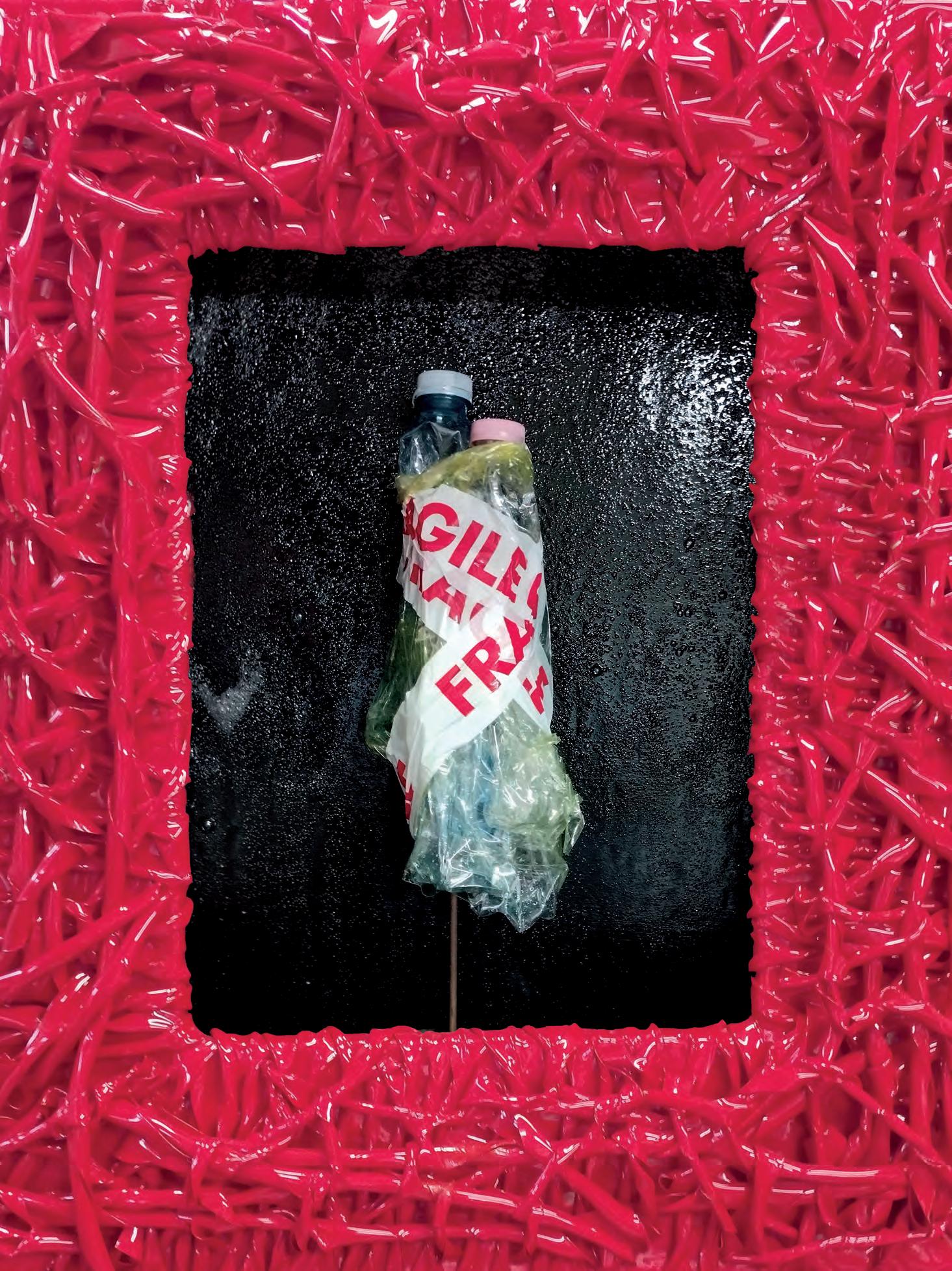
4/2025 - 6,50€









4/2025 - 6,50€
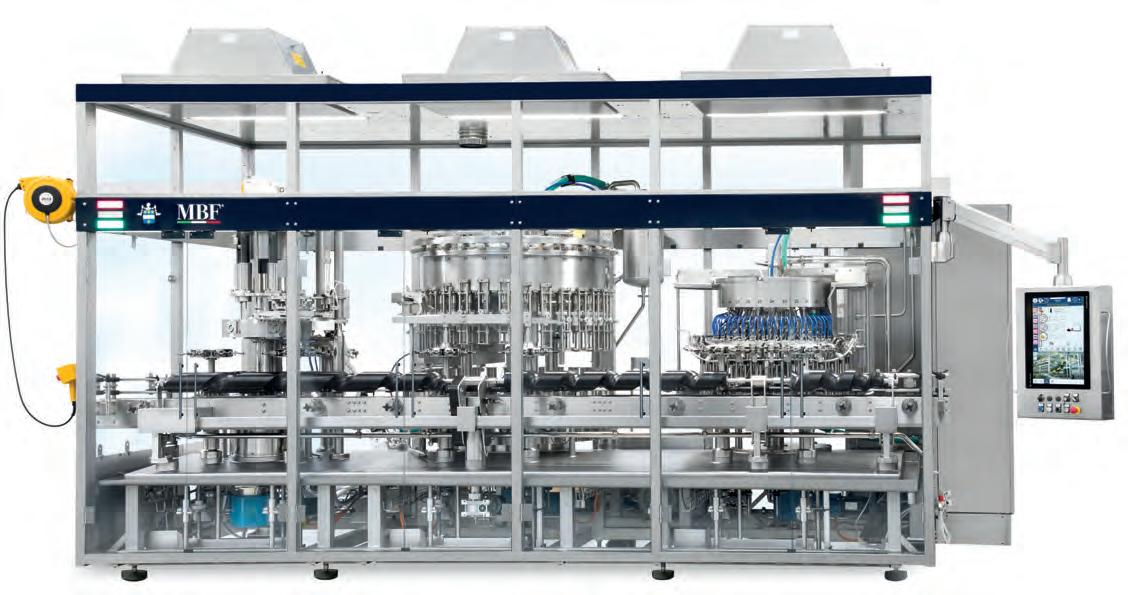

Bottling is much more than just packaging: it is a fundamental process that can impact the quality of the product. We have been well aware of this since a long way back. The passion of our large family drives us to research continuously better technologies, and to continuously improve the reliability of our solutions for bottling wine, spirits, beer and beverages. This is the strength of MBF.
Bottling is much more than just packaging: it is a fundamental process that can impact the quality of the product. We have been well aware of this since a long way back. The passion of our large family drives us to research continuously better technologies, and to continuously improve the reliability of our solutions for bottling wine, spirits, beer and beverages. This is the strength of MBF.




C’è un universo privato in ognuno di noi. E’ fatto di una materia che mescola aspirazioni, fragilità, sentimenti e intuito e rappresenta lo spazio in cui disegniamo le traiettorie del nostro futuro. La ‘scheggia’ di universo che brillava su Ipack-Ima, nel maggio scorso, ha visto passare, sotto di lei, tante storie diverse. Storie umanissime, fatte di costanza, impegno, dedizione e visione e storie ‘cibernetiche’, di macchine sempre più intelligenti e in grado di modificare ancestrali equilibri (o squilibri). Di queste storie, ce ne sono due in particolare che voglio citarvi. La prima è stata celebrata in un tempio dell’ingegno e della bellezza, il museo dell’Alfa Romeo di Arese, ed è quella della famiglia Cavanna. L’azienda, un punto di riferimento nel mondo dei sistemi di confezionamento flowpack, ha festeggiato i 65 anni dalla fondazione. L’ha fatto mettendo al centro le emozioni, da vera ‘family company’, e mostrandosi con onestà e semplicità. Protagonista, insieme al vulcanico presidente Riccardo, Alessandra Cavanna, sua sorella, a lungo al vertice del gruppo. Alessandra ha parlato della sua scelta di fare, come si usa dire, un passo di lato, per dedicarsi alla sua passione per l’arte e la recitazione. E l’ha fatto usando parole sospese tra la concretezza e il sogno: “I genitori - ha detto - hanno sogni bellissimi ma non sono necessariamente gli stessi dei bambini. E i bambini vanno lasciati volare. Come figlia ci ho messo un po’ a capirlo, ma ora posso dire che è stata la scelta giusta. E faccio i complimenti a mio fratello, che porta avanti con abilità questa sfida”. In conclusione, un efficacissimo: “Well done, bro”. Le fa eco un toccante video in cui il papà di Riccardo e Alessandra,
There is a private universe within each of us. It is made of a substance that blends aspirations, vulnerability, emotions, and intuition and it is within this space that we sketch the trajectories of our future.
The “fragment” of that universe that sparkled above Ipack-Ima last May bore witness to many different stories as it overlooked the show floor. Human stories, made of perseverance, dedication, vision, and commitment. And “cybernetic” stories too of increasingly intelligent machines, capable of transforming age-old balances (or imbalances). Among these stories, two stand out that I would like to share with you.
The first was celebrated in a temple of ingenuity and beauty - the Alfa Romeo Museum in Arese - and it is the story of the Cavanna family. A benchmark in the world of flowpack packaging systems, the company marked its 65th anniversary by placing emotion at the center, true to its identity as a family company, and doing so with
Mario Cavanna, scomparso nel 2015, dialoga ispirato con le montagne della sua Valsesia: “Voglio parlare di progetti - diceva profetico - Spero che la nostra qualità di vita non si discosti da quanto si vede qui intorno: mi riferisco al verde e al piacere di vivere in una zona magnifica, con le montagne alle spalle e il Monte Rosa che, di tanto in tanto, si nasconde”. Tante volte la sostenibilità va a braccetto con le radici. La seconda storia guarda sempre alla terra, ma da una prospettiva rara: dallo spazio. E’ la bella testimonianza che l’astronauta Paolo Nespoli (313 giorni passati nello spazio) ha portato all’evento per i 40 anni di Giflex. Nespoli ha tessuto gli elogi dell’imballaggio flessibile che, sulla Stazione spaziale internazionale, è un alleato fondamentale per potersi nutrire. Ma ha anche invitato il pubblico a non dimenticare che anche la flessibilità di pensiero è una qualità. L’ha fatto usando delle fotografie mozzafiato scattate al nostro pianeta dalla sua cupola in mezzo alle galassie. Resta una frase su tutte: “Da qui si vede benissimo: l’unico vero muro che ci protegge - ha scandito - è l’atmosfera”.
Chiudo con una cometa, passata pochi giorni fa ma che ha lasciato il segno. Ucima ha deciso di cambiare i connotati delle assemblee e ha celebrato la sua con un evento in pompa magna alla Fondazione MAST di Bologna. Tra approfondimenti di geopolitica, podcast live sul palco, animate tavole rotonde e un memorabile ‘duello’ sui numeri di mercato, l’evento si è rivelato riuscitissimo. È bello, ogni tanto, che il nostro privato universo creativo diventi un bene di tutti.
d.miserendino@kairosmediagroup.it
honesty and simplicity.
At the forefront, alongside the dynamic president Riccardo, was his sister Alessandra Cavanna, who led the group for many years. Alessandra spoke about her decision to take, as the saying goes, a step aside to devote herself to her passion for art and acting. Her words were a blend of pragmatism and poetry: “Parents have beautiful dreams, but they’re not necessarily the same as those of their children. And children must be allowed to fly. As a daughter, it took me a while to understand this, but I now know it was the right choice. And I must say well done to my brother, who is carrying this challenge forward with great skill”. A heartfelt “Well done, bro,” closed her speech, resonating with warmth and sincerity. Echoing her words was a moving video featuring their father, Mario Cavanna, who passed away in 2015. Speaking to the mountains of his beloved Valsesia, he reflected with prophetic clarity:
“I want to talk about projects. I hope that our quality of life never strays from what we see around us: the greenery, the beauty of living in such a magnificent place, with the mountains behind and Monte Rosa peeking out from time to time”.
Sustainability, as we often discover, walks hand in hand
with our roots.
The second story also starts with earth—but views it from a rare perspective: from space. This was the powerful testimony shared by astronaut Paolo Nespoli (313 days spent in space) at the event marking Giflex’s 40th anniversary. Nespoli praised flexible packaging, which plays a vital role aboard the International Space Station by ensuring food safety and practicality. But he also reminded the audience that mental flexibility is just as essential. He did so while showcasing breathtaking photos of our planet taken from the cupola of the ISS, surrounded by galaxies. One quote above all lingers: “From up here it’s crystal clear, the only real wall that protects us - he emphasized - is the atmosphere”.
I’ll end with a comet—one that recently passed by, but certainly left its mark. Ucima has decided to rewrite the rules for industry assemblies, staging its event in grand style at the MAST Foundation in Bologna. Between deep geopolitical analysis, live podcasting on stage, vibrant roundtable debates, and a memorable “duel” over market figures, the event was a resounding success. Sometimes it’s a beautiful thing when our private creative universe becomes a shared space for everyone.






Max Marra, born in 1950, a native of the Calabria region, lives and works between the city and hinterland of Milan and the rest of the world.
A multidisciplinary artist, his research focuses on the integration and linguistic contamination of drawing, painting, and sculpture, offering a lengthy, consolidated experimentation activity for analysis.
To date, he has held more than 70 solo exhibitions, participating in national and international reviews; his works have been displayed in private galleries and major public institutions. His polymaterial works and drawings are featured in private collections and museums in both Italy and abroad.
He has collaborated with ItaliaImballaggio for many years, coordinating the artists who, from month to month, “dress” the magazine.
Max Marra, classe 1950, calabrese di origine, vive e lavora tra Milano, l’hinterland e il mondo. Artista multidisciplinare, indirizza la propria ricerca verso l’integrazione e la contaminazione linguistica di disegno, pittura, scultura, offrendo all’analisi una corposa attività di sperimentazione lunga e consolidata.
A oggi ha realizzato oltre 70 personali, partecipando a rassegne nazionali e internazionali; ha esposto in gallerie private e importanti istituzioni pubbliche. È presente con opere polimateriche e disegni in collezioni private e istituzioni museali, nazionali e internazionali.
Da molti anni collabora con ItaliaImballaggio, coordinando gli artisti che, di mese in mese, “vestono” la rivista.
La parola all’artista
Ripercorrendo a memoria la felice, libera, stravagante arte del ready-made con gesti brevemente definiti, ho assemblato con banale nastro per imballaggio poche bottigliette di plastica (ma senza etichette), realizzando così una struttura che diventa archetipo a tutto tondo di una moderna archeologia “fatta ad arte”. Il pretesto del riciclo delle bottigliette dell’acqua ha generato nuovamente la felice, piacevole intuizione che attraverso il gioco libero e poetico, c’è sempre una sorpresa inaspettata, pronta a rivelare che la vita senza la poesia dell’arte è un vuoto senza emozioni. E per questo motivo, pur sapendo che l’uomo non è sapiens, dobbiamo fortemente amare la vita di tutti. Max Marra, giugno 2025
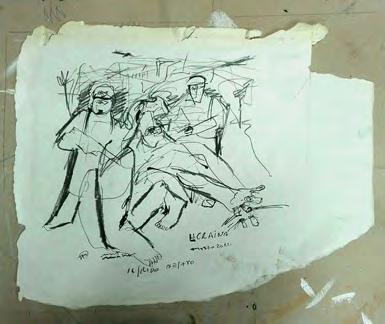
In the words of the artist
Retracing the happy, free, whimsical art of the ready-made from memory, with briefly defined gestures, I used ordinary packing tape to assemble a few unlabelled plastic bottles, thus creating a structure that is an all-around archetype of a modern, artful archaeology.
The pretext of recycling water bottles again generated the happy, pleasant insight that free and poetic play always provides, an unexpected surprise, ready to reveal that life without the poetry of art is an experience devoid of emotion. This is why - even though we know that Man is not sapiens - we must have a profound love for everyone’s life. Max Marra, June 2025
Reviews
[...] His lengthy, consistent daily efforts have
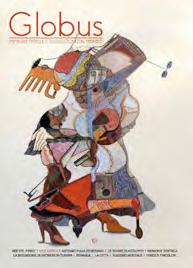
Dicono di lui
Globus cover caption, no. 18/ MMXXV, June 21, 2025 Umana res (from the album Andalusia), 2019, 160 x 130 cm on jute. Drawing by Max
[...] Grazie a un lungo e coerente quotidiano lavoro, l’artista Max Marra si è conquistato la stima e l’apprezzamento di tanti. Di lui conosco l’ormai ultra-quarantennale proposta artistica, che non esito a definire multiforme, poliedrica, spesso sorprendente, mai attardata, per la varietà di tecniche e di temi, che ha dato vita a un pluralismo progettuale e formale che trova la sintesi in un linguaggio non solo personale ma autentico. [...] Di Max Marra è nota l’intima quanto naturale vocazione alla materia, producendo opere nelle quali ha inteso trasferire il suo pensiero artistico, etico, sociale e spirituale sulla condizione umana non disgiunto da uno sguardo oscillante fra lo sdegnato e il soccorrevole, ma sempre scevro da ogni atteggiamento sentenzioso. Eppure, nei suoi cicli, inni alla materia - gli umili “scarti”, le laceranti “Pance ferite”, le poetiche “Dune d’Oriente”, i contemplativi cicli di “Cosmos”, i gestuali “Pacchetti”, la mistica di “Francesco è solo”, l’amara denuncia di “Appunti sul ponte”- si percepisce bene, ancorché inabissata tra la iuta, il catrame, la corda, il ferro, la stoffa, la cera, il carbone - l’uso di una tavolozza cromatica selezionatissima e sorvegliata, l’impronta primigenia e formativa, direi quasi aurorale, del disegno, da cui tutta l’opera di Marra trae origine.
Lo si vede negli equilibri delle composizioni polimateriche, nell’appropriazione degli spazi, nella stessa distribuzione dei colori, nelle partiture segniche organizzate come contrappunti musicali, nella dialettica tra spazi chiusi e aperti, tra pieni e vuoti [...] Domenico Piraina ( Globus n. 18/MMXXV)
earned the artist Max Marra the esteem and appreciation of many. I am familiar with his artworks spanning over 40 years, and I have no hesitation in defining them as multifaceted, many-sided, often surprising, always fresh, in terms of the variety of techniques and themes, which has given rise to a design and formal pluralism expressed through an artistic language that is not only personal but authentic.
[...] Max Marra is renowned for his intimate, natural vocation for material, producing works in which he has sought to convey his artistic, ethical, social and spiritual thoughts on the human condition from a perspective that wavers between the disdainful and the ministering, yet is never sententious. Yet, in his cycles, which are a tribute to materi-
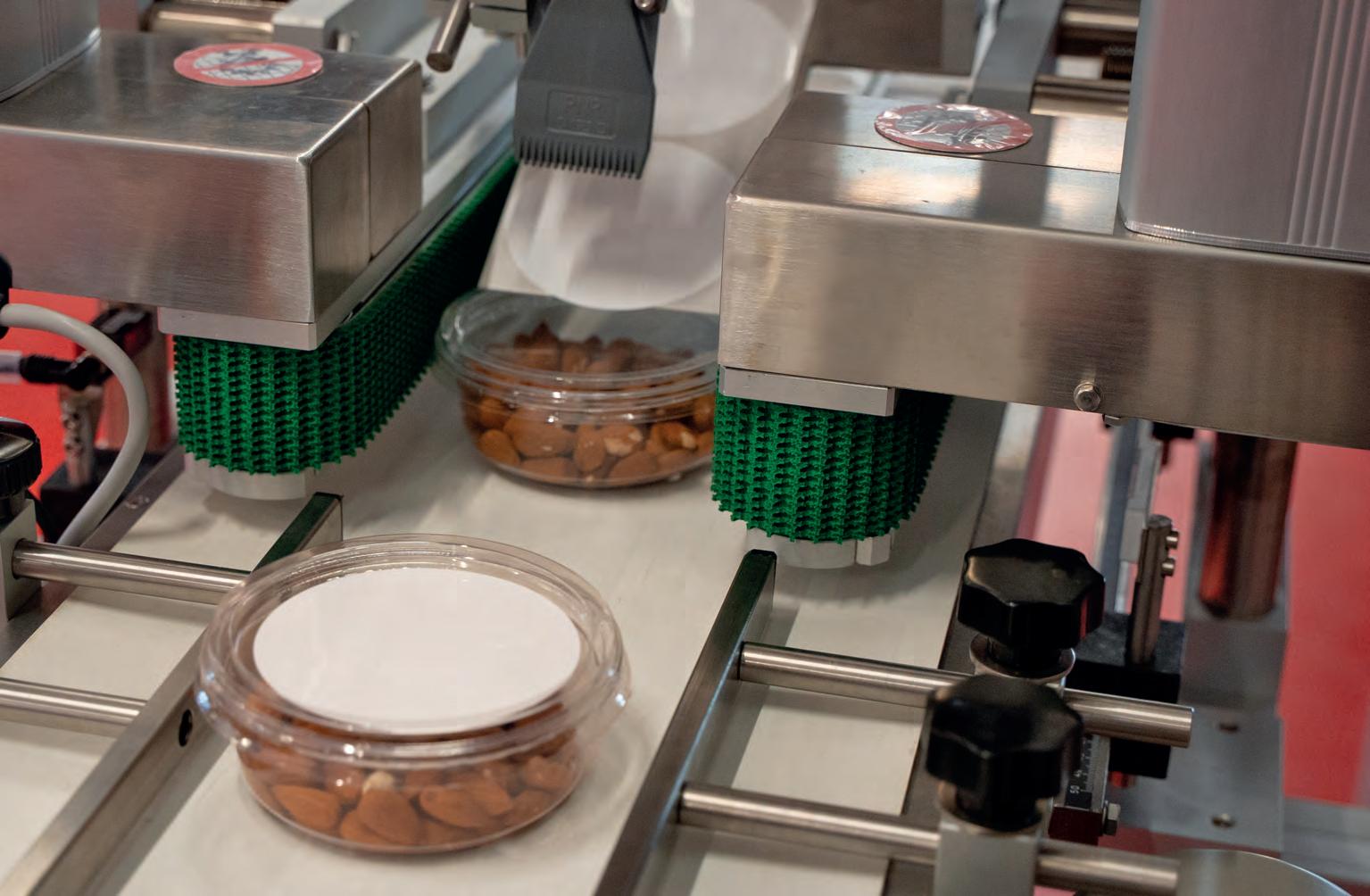
al - the humble “Scarti”, the harrowing “Pance Ferite”, the poetic “Dune d’Oriente”, the contemplative cycles of “Cosmos”, the gestural “Pacchetti”, the mysticism of “Francesco è Solo”, the bitter condemnation of “Appunti sul Ponte” - we can clearly perceive, albeit buried amid the jute, tar, rope, iron, cloth, wax and charcoal, the use of a carefully selected, guarded colour palette that is the primal, formative, almost auroral imprint of the design from which all Marra’s work originates.
This can be seen in the balances of the polymaterial compositions, in the appropriation of spaces, in the very distribution of colours, in the orchestration of signs organised as musical counterpoints, in the dialectic between closed and open spaces, between solids and voids [...] Domenico Piraina
18/MMXXV)



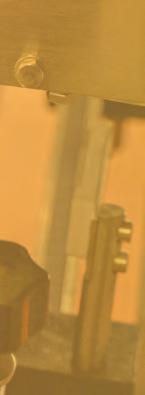





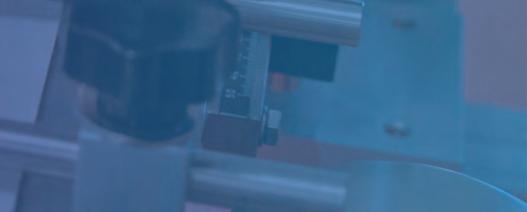





Editoriale
2 Behind the cover
Max Marra - Tu fai… io riciclo e creo EVENTS
8 Drinktec, Fachpack, Luxepack, K, Host, Cibus Tec Forum, Echoes of Beauty
POWERED BY BEST PACKAGING
14 Best Packaging 2025: i vincitori Best Packaging 2025: the winners
POST IPACK-IMA
Gian Paolo Crasta
16 Glossario da una fiera A tradeshow glossary
20 Ipack-Ima e Pharmintec 2025: un successo concreto
Ipack-Ima and Pharmintec 2025: a concrete success
FOCUS FOOD AND BEVERAGE
Barbara Iascone
26 Caffè e tè: mercato e packaging Coffee & te: market and packaging
Barbara Iascone
31 Bevande: mercato e imballaggio Beverages: market and packaging
Maria Costanza Candi
37 Le tante sfumature del buono secondo Loacker
The many nuances of goodness, according to Loacker
FOOD AND BEVERAGE - AUTOMATION
40 Schaeffler Italia - Componenti ad alta precisione per il food
High-precision components for food
42 D. C. M. - La robotica industriale di autonox Robotics
Industrial robotics from autonox Robot
44 Schneider Electric con RobopacFunzionalità plug and play per impianti sempre più su misura e sostenibili Plug and play functions for increasingly customised and sustainable systems
46 Robot delta Sipro: molti vantaggi in una singola tecnologia.
Sipro Delta Robot: many advantages in a single technology
47 Per Jaka una rete sempre più solida dove la robotica è protagonista
Driving growth in Italy: Jaka Robotics invests in training and local partnership
50 Servotecnica, 45 anni di evoluzione Servotecnica, 45 years of evolution
FOOD AND BEVERAGE - MATERIALS
52 Goglio - Imballaggio asettico per liquidi Aseptic packaging for liquids
54 Metsä Board - Reinventare la confezione da sei
Reinventing the six-pack
58 Giflor - iTap CORTO: il nuovo rubinetto più leggero e performante
iTap CORTO: the new iTap tap, lighter and more efficient
59 Ilip - FibrAware® personalizzato Customised FibrAware®
FOOD AND BEVERAGE - MACHINERY
61 ACMA CW 1400 - La nuova frontiera del confezionamento dolciario The new frontier in confectionery packaging
62 Cama - Soluzioni shelf-ready per il baby food Shelf-ready solutions for baby food
63 Imball - Soluzioni per il packaging dal 1975 Packaging solutions since 1975
64 CMI Industries - Non solo riempimento chimico
More than just chemical filling
66 Megadyne - Cinghie speciali, ingrediente “segreto” del pack alimentare Engineered belts, the “secret” ingredient for food packaging
68 MH - Dalla catena 879 BAT a USC UltimateSafetyChain From 879 BAT to USC - UltimateSafetyChain
70 Sidel - Packaging: il quinto elemento Packaging: the fifth element
72 FlexoDose Light di Volpak FlexoDose Light by Volpak
FOOD AND BEVERAGE - LABELLING
74 Etipack, l’automazione flessibile per l’etichettatura nel beverage Etipack, flexible automation for beverage labelling
74 Raddoppiare velocità di codifica o dati forniti con le soluzioni Markem-Imaje 9712 Bi-jet printer doubles coding speed or the amount of data provided
75 ALtech - Alritma: la nuova generazione ALritma: the new generation
TOPICS
77 Circular economy Ricrea, superato l’obiettivo UE 2030 EU 2030 target exceeded
Maria Costanza Candi
79 Food contact Sostenibilità e packaging a contatto con gli alimenti: un binomio possibile?
Sustainability and food contact packaging: can they go together?
84 Labelling Gipea - Etichette, l’unione fa la forza Labels: strength in unity
INTERVIEWS
Luciana Guidotti
86 Racconti di oggi: Capsulit Today’s stories: Capsulit
Maria Costanza Candi
91 Dove il processo incontra la personalizzazione: Zambelli Packaging Where process meets customisation: Zambelli Packaging
FACTS AND FIGURES
Milena Bernardi
96 Macchine packaging in accelerazione per il quarto anno
Packaging machines accelerating for the fourth consecutive year
Barbara Iascone
101 Report sullo stato dell’imballaggio Packaging status report
Barbara Iascone
104 Gli imballaggi di acciaio e alluminio Steel and aluminium packaging
Barbara Iascone
109 Gli imballaggi di legno
Wooden packaging
Direttore responsabile
Davide Miserendino
Condirettore
Luciana Guidotti
Redazione
Milena Bernardi, M. Costanza Candi, Generoso Verrusio
Traffico pubblicità
Salvatore Lavorini (salvatore.lavorini@kairosmediagroup.it)
Hanno collaborato
Barbara Iascone
Traduzioni
Ligabue Traduzioni e Interpretariati
Coordinamento artisti
Max Marra & Gianni Valentino
Progetto grafico e impaginazione
Studio Grafico Page, Vincenzo De Rosa
Stampa e confezione
Faenza Printing Industries Spa Via Vittime Civili di Guerra 35, 48018, Faenza (RA)
Numero 4/2025 Luglio/agosto 2025 anno 31
Pubblicazione iscritta al n 3 del Registro di Cancelleria del Tribunale di Modena in data 17/02/2025 Iscrizione nel Registro degli Operatori della Comunicazione n. 9673 Una copia: € 6,50 - Arretrati € 13
Periodicità
Bimestrale
Abbonamento per un anno:
Italia € 50
Rivista fondata nel 1994 da Stefano Lavorini
La riproduzione totale o parziale degli articoli e delle illustrazioni pubblicati su questa rivista è permessa previa autorizzazione della Direzione. La Direzione non assume responsabilità per le opinioni espresse dagli autori dei testi redazionali e pubblicitari
Kairos Media Group Srl Via Fossa Buracchione 84, 41126 Modena
Direttore editoriale
Davide Miserendino
Redazione/sede operativa
Via Fossa Buracchione 84, 41126, Modena T. +39 059512103, redazione@packmedia.net
Sales team
Massimo Chiereghin - m.chiereghin@kairosmediagroup.it Roberta Pagan - r.pagan@kairosmediagroup.it Nicola Saracino - n.saracino@kairosmediagroup.it Elisa Verzelloni - e.verzelloni@kairosmediagroup.it
con la collaborazione di

SOCIO EFFETTIVO ASSOCIAZIONE NAZIONALE EDITORIA DI SETTORE
3
Ai sensi del Regolamento Europeo sulla Protezione dei Dati 679/2016 (“GDPR”), del D.Lgs. 196/2013, del D.lgs. 101/2018 e delle successive modifiche e integrazioni, i trattamenti effettuati dal gruppo (U.C.I.M.A - proma-pack srl a socio unico - Kairos Media Group srl - MECS srl) saranno improntati ai principi di liceità, correttezza, trasparenza, limitazione delle finalità e della conservazione, minimizzazione dei dati, esattezza, integrità e riservatezza, nonché al principio di responsabilizzazione di cui all’art. 5 del Regolamento. Per consultare o rettificare i Vostri dati, o per opporvi alla ricezione della nostra rivista (art. 15-22 Regolamento Europeo 2016/679), potrete rivolgervi ai Titolari del trattamento, nelle società del gruppo UCIMA (U.C.I.M.A - proma-pack srl a socio unico - Kairos Media Group srl - MECS srl) scrivendo alla email del gruppo privacy@ucima.it.

/
Modular machine from 1 to 6
Delta Robots suitable for speeds up to 400 b.p.m.
Possibility to feed symmetrical or asymmetrical bottles, either in pucks or directly on the line conveyor
/
Simple human interface and historical data collection
One touch rapid change-over including bottle emptying
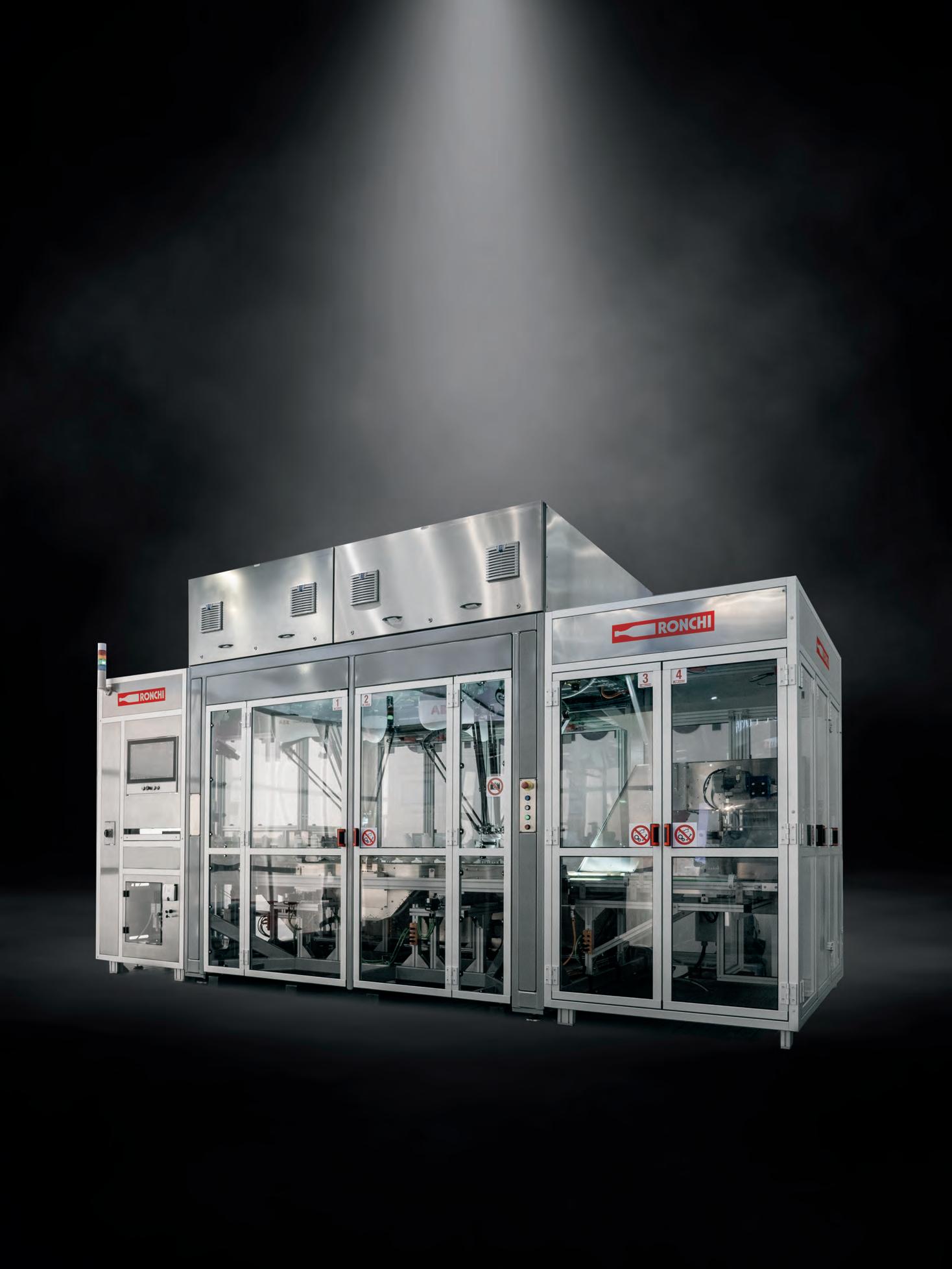
drinktec 15 - 19 settembre 2025, Monaco di Baviera (D) Organizer: Yontex

Con focus su innovazione, sostenibilità e networking, drinktec si riconferma hub di innovazione per l’industria del beverage e del liquid food mondiale. Momento irrinunciabile per i produttori di bevande analcoliche, birra, vino, spumante, bevande analcoliche gassate, succhi di frutta, alimenti liquidi, latte e prodotti lattiero-caseari liquidi, il Trade Fair Center Messe München ospita l’offerta completa di prodotti e servizi per l’industria delle bevande e degli alimenti liquidi, spaziando dalle materie prime e gli ingredienti alle tecnologie di processo, dai sistemi di riempimento e confezionamento per arrivare alla logistica, Parola chiave del programma di eventi colla-
terali alla mostra tecnologica è “futuro”, programma che si articola lungo tre filoni principali. Con “Circularity & Resource Management” si approfondirà l’uso responsabile delle risorse; “Data2Value” esplorerà il ruolo dell’intelligenza artificiale nell’industria. Il terzo tema, “Lifestyle & Health”, si focalizzerà sulle evoluzioni delle abitudini di consumo e sulle implicazioni per i produttori di bevande.
Per pianificare la visita, gli operatori possono già acquistare il biglietto di ingresso online. Grazie alla nuova versione del catalogo online è possibile personalizzare il proprio percorso e ottimizzare l’esperienza in fiera, utilizzando filtri che consentono di selezionare i padiglioni, i settori o i mercati di riferimento. Per informazioni e il supporto in lingua italiana è possibile rivolgersi a BD Expo, la rappresentanza ufficiale della fiera drinktec in Italia (sales@bd-expo.net).

Édition Spéciale Luxe Pack
Sustainable packaging solutions 1-2/7/2025, Paris (FR) www.editionspeciale-luxepack. com/en/
Propak West Africa
Packaging, processing, printing, plastics 9-11/9/2025, Lagos (NG) www.propakwestafrica.com
Drinktec Beverage & liquid food industry
- Processing, filling, packaging, marketing 15/9-19/5/2025, Munich (D) www.drinktec.com
Labelexpo Europe
Labeling industry 16-19/9/2025, Barcelona (E) www.labelexpo-europe.com
Milano Beauty Week
La settimana dedicata alla cultura della bellezza e del benessere 17-21/9/2025, Milano (I) www.milanobeautyweek.it/it/
PackPrintPlas Philippines
Printing, Plastics Machinery, Technology, Products, and Services Exhibition 18-20/9/2025, Manila (PH) packprintplasphilippines.com
FachPack
Packaging, printing & logistics 23-25/9/2025, Nürnberg (D) www.fachpack.de/en
Luxe Pack Monaco Luxury packaging 29/9-1/10/2025, Montecarlo (MC) www.luxepackmonaco.com
K 2025
Plastics & rubber 8-15/10/2025, Düsseldorf (D) www.k-online.de
Host Hospitality exhibition 17-21/10/2025, Milano Rho (I) www.host.fieramilano.it
Eurasia Packaging Istanbul
Packaging industry 22-25/10/2025, Istanbul (TR) packagingfair.com/en/
Cibus Tec Forum Food processing & packaging technology 28-29/10/2025, Parma (I) www.cibustecforum.it/it/home/ index.php
A&T Automation & Testing Nord-Est
Innovative technologies, robotics, testing and measurements 28-30/10/2025, Vicenza (I) www.aetevent.com
CPHI Frankfurt
Celebrating 35 years uniting pharma 28-30/10/2025, Frankfurt (D) www.cphi.com/europe/en/home. html
Gulfood Manufacturing Packaging & Processing 4-6/11/2025, Dubai (EAU) www.gulfoodmanufacturing.com
Ecomondo
Materials and energy recovery & sustainable development 4-7/11/2025, Rimini (I) www.ecomondo.com
Bevertech
Dedicata al settore Liquid Food & Beverage 17-20/11/2025, Milano (I)
Marca by BolognaFiere
Private label conference & exhibition 14-15/1/2026, Bologna (I) www.marca.bolognafiere.it
Fachpack
23 - 25 settembre 2025
Norimberga (D)
Attesi 1.400 espositori, distribuiti in 11 padiglioni della NürnbergMesse, alla prossima edizione di Fachpack, fiera europea dedicata all’intera filiera del confezionamento e del processo. E se l’attenzione maggiore è rivolta al packaging e agli accessori di imballaggio, non mancheranno le soluzioni per la stampa e il finishing o per l’intralogistica. Fachpack si prospetta come piattaforma di innovazione, dialogo e sviluppo sostenibile, offrendo una ampia panoramica sulle tendenze e le tecnologie. Anche il programma di eventi collaterali offrirà un prezioso impulso a un settore in transizione come quello del packaging.
Il forum PACKBOX si concentrerà su temi di ampio respiro (uso dell’intelligenza artificiale nello sviluppo e nella produzione, le strategie per l’attuazione del PPWR, i modelli di economia circolare e le tendenze del mercato internazionale) ma anche sui materiali sostenibili e gli sviluppi normativi.
Nel forum INNOVATIONBOX, gli espositori potranno presentare in modo breve e conciso i loro nuovi prodotti e le innovazioni di processo. Giunge quest’anno alla seconda edizione l’evento di networking “Women4Packaging”, con l’obiettivo di offrire alle donne occupate nel settore (siano esse espositrici o in visita) una piattaforma dove condividere conoscenze e idee. Concludono la panoramica degli eventi speciali dedicati al futuro lo Student Day e lo spazio “The “Young Innovators”. Ricordiamo infine che, in parallelo a Fachpack, si svolge Powtech Technopharm e Component (tecnologie di processo in ambito farmaceutico per la lavorazione di polveri, solidi, fluidi e liquidi).
Sigep 45° Salone Internazionale della Gelateria, Pasticceria, Panificazione Artigianali e Caffè 16-20/1/2026, Rimini (I) www.sigep.it
Pharmapack Europe
Drug delivery & packaging 21-22/1/2026, Paris (F) www.pharmapackeurope.com
ProSweets Cologne
Confectionary industry 1-4/2/2026, Cologne (D) www.prosweets.com
Propak Philippines
Packaging materials & machinery
4-6/2/2026, Pasay City (PHL) www.propakphilippines.com
Fruit Logistica
Trade fair for the fresh fruit and vegetable business
4-6/2/2026, Berlin (D) www.fruitlogistica.it
Paris Packaging Week
PCD + ADF + PLD + Packaging Premier 5-6/2/2026, Paris (F) www.parispackagingweek.com/ en/
drinktec
September 15 - 19, 2025, Munich (D)
Organizer: Yontex
With its focus on innovation, sustainability and networking, drinktec reconfirms its reputation as a innovation hub for the beverage and liquid food industry. It is expected to be again a must for producers of soft drinks, beer, wine, sparkling wine, carbonated soft drinks, fruit juices, liquid foods, milk and liquid dairy products.Scheduled to take place at the Trade Fair Center Messe München, drinktec will present a comprehensive range of products and services for the beverage and liquid food industry, ranging from raw materials and ingredients to process technologies, filling and packaging systems, and logistics. The key word of the collateral events program is “future”, which has three main themes. With “Circularity & Resource
Fachpack
23 - 25 September 2025
Nuremberg (D)
A&T Automation & Testing
Innovative technologies, robotics, testing and measurements 11-13/2/2026, Torino (I) www.aetevent.com
Solids Parma
Soluzioni per la lavorazione, lo stoccaggio, il trasporto e l’analisi dei granuli e delle polveri, dei solidi fusi.
11-12/2/2026, Parma (I) www.solids-parma.de/it/
Propak East Africa
Packaging, processing, printing, plastics 3-6/3/2026, Nairobi (KE) www.propakeastafrica.com
Management”, the fair will examine the responsible use of resources. “Data2Value” will explore the role of artificial intelligence in the industry. The third theme, “Lifestyle & Health”, will focus on changing consumption habits and the implications for beverage manufacturers.
Visitors can already purchase their entrance ticket online and start planning their visit and the new version of the online catalogue allows them to customise their itinerary, optimizing their experience at the fair.
Information and support in Italian can be obtained from BD Expo, the official representative of the drinktec fair in Italy(sales@ bd-expo.net).
Around 1,400 exhibitors are expected at the upcoming edition of Fachpack, Europe’s leading trade fair for the packaging and processing industry, taking place across 11 halls at NürnbergMesse. While packaging and packing accessories remain the main focus, the fair will also showcase a broad selection of solutions for printing, finishing, and intralogistics.
Fachpack promises to be a platform for innovation, dialogue and sustainable development, offering a comprehensive overview of industry trends and technologies. The programme of side events will inject fresh momentum into a sector in transition, such as the packaging industry.
The PACKBOX forum will focus on a wide range of topics, including the use of artificial intelligence in product development and manufacturing, strategies for implementing the Packaging and Packaging Waste Regulation (PPWR), circular economy models, and global market trends. It will also address developments in sustainable materials and evolving regulatory frameworks.
At the INNOVATIONBOX forum, exhibitors will have the opportunity to briefly present their latest products and process innovations.
This year also marks the second edition of Women4Packaging, a networking event designed to provide women in the industry (whether exhibitors or visitors) with a platform where they can share knowledge and exchange ideas. Rounding out the programme of future-focused events are Student Day and the Young Innovators area.
Finally, it’s worth noting that Fachpack will once again be held in parallel with Powtech Technopharm and Component, the international exhibition dedicated to technologies for the processing of powders, solids, and liquids in the pharmaceutical industry.
edizione 2025 (29/30 settembre - 1 ottobre) segna un nuovo capitolo per la fiera dedicata al packaging alto di gamma: l’ampliamento del Grimaldi Forum, che ospita Luxe Pack dal 2000, offre infatti l’opportunità di offrire un’esperienza immersiva diversa, cui concorre l’integrazione di circa 2000 m2 di aree esterne.
Tra le novità messe in campo dagli organizzatori, lo spazio The Col’Lab (The Collective Laboratory) ospiterà i consorzi di marchi e di produttori internazionali, che potranno mettere in comune i risultati di studi specifici su temi essenziali per il settore, utilia indicare la strada dello sviluppo.
Altra premiére sarà The Portal, riservato ad aziende che offrono tecnologie innovative, materiali all’avanguardia e servizi che promuovono la transizione verso un packaging intelligente e sostenibile. Anche la sezione Luxe Home (prodotti per la profumazione della casa) lanciata due anni e finora limitata da vincoli di spazio, è destinata a raddoppiare le dimensioni, diventando un “evento nell’evento”. Ricordiamo infine che la fiera monegasca si distingue da sempre per qualità e selettività delle proposte, per internazionalità, capacità di creare networking e innnovazione, mettendo in luce gli sviluppi del settore in fatto di tecnologie, materiali, design e concetti sostenibili capaci di soddisfare le esigenze del pack selettivo.

The 2025 edition of Luxe Pack Monaco - taking place from 29 September to 1 October - marks a new chapter for the premier trade fair dedicated to high-end packaging. Thanks to the expansion of the Grimaldi Forum, which has hosted the exhibition since 2000, this year’s edition will offer a different immersive experience, enhanced by the addition of approximately 2,000 square metres of outdoor exhibition space. Among the key innovations introduced by the organisers is The Col’Lab (The Collective Laboratory), a dedicated space that will host consortia of international brands and manufacturers. Here participants will share the results of specific studies on key sector issues, offering valuable insights to help guide future development.
Another new feature for 2025 is The Portal, an area reserved for
companies offering innovative technologies, cutting-edge materials and services that support the transition to smart and sustainable packaging. Launched two years ago and previously limited by space constraints, the Luxe Home section (dedicated to home fragrance products) is set to double in size for the 2025 edition, becoming an “event within an event”.
Finally, let’s remember that the Monaco fair has always stood out for the quality and selectivity of its proposals, its international reach, excellent networking opportunities and focus on innovation. It continues to highlight the industry’s advancements in technologies, materials, design and sustainable concepts, capable of meeting the needs of the premium packaging sector.
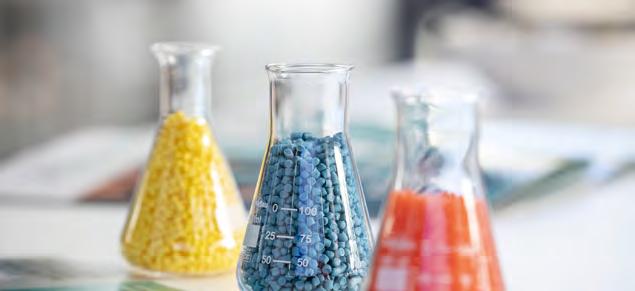
K 2025
8 - 15 ottobre 2025
Düsseldorf (D)
Organizer: Messe Düsseldorf

Con il motto “The Power of Plastics! Green - SmartResponsible“ la piattaforma mondiale dell’industria delle materie plastiche e della gomma lancia un messaggio chiaro: ribadisce il ruolo indispensabile della plastica in molti settori che contribuiscono all’innovazione e al progresso, ma riassume anche l’impegno del comparto ad agire in modo sostenibile, intelligente e responsabile nella produzione e gestione delle materie plastiche.
Oltre 177.000 metri quadrati di superficie espositiva netta nei 18 padiglioni e nell’area esterna offrono spazio all’intera catena del valore (macchinari e attrezzature, materie prime e ausiliarie, semilavorati, elementi tecnici e prodotti in plastica rinforzata), con la presen-
With the motto “The Power of Plastics! Green - Smart - Responsible”, K 2025, the global platform for the plastics and rubber industry, sends a clear message: it reaffirms the indispensable role of plastics in many sectors that contribute to innovation and progress, and also summarises the industry’s commitment to sustainable, intelligent and responsible production and management of plastic materials.
More than 177,000 square meters of net exhibition space - spread across 18 halls and the outdoor area - will host the full spectrum of the value chain, including machinery and equipment, raw and auxiliary materials, semi-finished products, technical components, and reinforced plastic items. The event will showcase tangible, forward-thinking solutions designed to address today’s most pressing challenges.
The technology fair and its side events will focus on three key themes: the circular economy, digitalisation, and social responsibility.
This thematic focus will be reflected in several events, such as the Plastics Shape the Future special event, featuring seven themed days with discussions on innovative technologies and materials, keynote speeches, a policy roundtable, a Career Day and a Start-up Pitch. Other highlights include the VDMA Forum, titled The Power of Plastics, Rubberstreet, which will showcase the innovative strength and performance of the elastomers industry, and the second edition of the Start-up Zone, bringing together emerging companies focused on developing innovative products and solutions in plastics and rubber.
Finally, let’s not forget the Science Campus, where universities, research institutes, and exhibitors will present the latest advancements in plastics research. Additional highlights include the Young Talents Lounge and the Women in Plastics networking event.
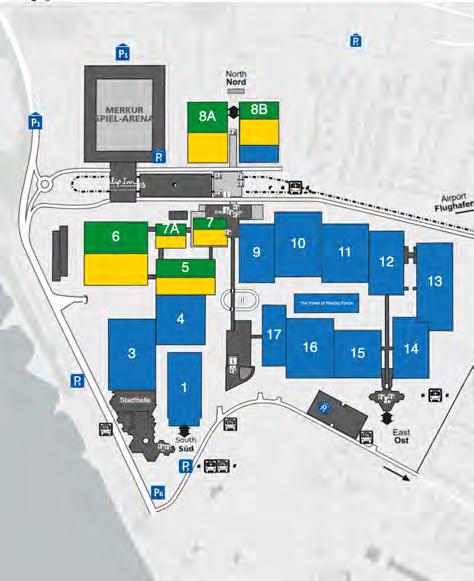
tazione di soluzioni concrete e pionieristiche per affrontare le sfide del nostro tempo Fiera tecnologica ed eventi collaterali saranno focalizzati su tre temi guida: economia circolare, digitalizzazione, responsabilità sociale. È il caso dell’evento speciale Plastics shape the Future (articolato in sette giornate a tema, con discussioni su tecnologie e materiali innovativi, discorsi programmatici, una tavola rotonda sulle politiche, una Career Day e un Start-up Pitch), del Forum VDMA intitolato “The Power of Plastics”, della Rubberstreet (vetrina della forza innovativa e delle prestazioni dell’industria degli elastomeri), per finire con la seconda edizione della Start-up Zone (che raggruppa nuovi operatori orientati allo sviluppo di prodotti e soluzioni innovative nel campo delle materie plastiche e della gomma).
Ricordiamo infine il Science Campus - dove università e istituti di ricerca, ma anche gli espositori, potranno presentare i risultati più recenti delle loro ricerche sulle materie plastiche - nonché gli eventi di networking Young Talents Lounge e Women in plastics.
Host 2025
17-21 ottobre 2025
Milano (I)
Organizer: Fiera Milano SpA
World’s leading trade fair for hospitality, out-of-home and food retail, Host 2025 is “the place to be” to preview the trends shaping the future of global hospitality, with a renewed attention to Artisan Baking and to bar and coffee world. From smart automation to AI-driven menus, and sustainability influencing choices and
Host 2025 17-21 ottobre 2025
Milano (I)
Organizer: Fiera Milano SpA
anifestazione leader mondiale per l’ospitalità, il fuoricasa e il food retail, Host 2025 è il place to be per scoprire in anteprima le tendenze che guideranno il futuro dell’hospitality globale, con una rinnovata attenzione sull’Arte Bianca e il mondo bar e caffè.
Dall’automazione intelligente ai menù guidati dall’AI, passando per la sostenibilità che influenza scelte e consumi, l’ospitalità e il fuoricasa stanno vivendo un’evoluzione senza precedenti: per offrire ai clienti esperienze sempre più multisensoriali e immersive, le tecnologie all’avanguardia si fondono con design e funzionalità per dare vita a soluzioni hi-tech ma accoglienti.
Secondo dati ExportPlanning, nel 2024 la produzione mondiale dei comparti presenti a Host 2025 è pari a 189,9 miliardi di euro e vede protagonista in termini di crescita la ristorazione professionale (+8,6% rispetto all’anno precedente). In questo contesto, l’Italia si conferma protagonista assoluta nell’export: come evidenziato da ICE - Agenzia per la promozione all’estero e l’internazionalizzazione delle imprese italiane, il nostro Paese detiene la leadership mondiale nelle macchine da caffè / vending (29,8%), la co-leadership nelle macchine per panificazione e pasticceria (28,8%) subito dopo la Cina, e un solido posizionamento anche nelle macchine per gelato e refrigerazione (10,5%).
Dai top player alle PMI d’eccellenza, gli oltre 1.700 gli espositori registrati (dei quali il 44% internazionali da 54 Paesi), secondo le previsioni incontreranno oltre 700 hosted buyer provenienti da circa 75 Paesi, altamente profilati anche con il supporto di ICE. Tra i principali settori target: distributori, rivenditori, esportatori/importatori; ristorazione, food service e fuoricasa; retail e GDO; attività ricettive; centri commerciali e location; chef, professionisti e consulenti. Host 2025 presenterà una panoramica completa dell’innovazione nel settore, coniugata con affondi verticali nei singoli comparti, organizzati per affinità di filiera: ristorazione professionale e bakery-pasta-pizza; caffè-tea, bar-macchine caffè-vending, gelato-pastry; tavola-tecnologia-arredo contract.
consumption habits, hospitality and out-of-home experiences are undergoing an unprecedented evolution: to offer customers increasingly multisensory and immersive experiences, cuttingedge technologies are merging with design and functionality to create hi-tech yet welcoming solutions. According to ExportPlanning data, in 2024 the global production of the sectors represented at Host 2025 amounts to €189.9 billion, with professional foodservice equipment leading the way (+8.6% increase over the previous year). In this context of global growth, Italy reaffirms its leading role in exports:
as highlighted by ICE - the Italian Trade Agency for the promotion and internationalisation of Italian companies - our country holds the global leadership in coffee and vending machines (29.8%), is co-leader in bakery and pastry machines (28.8%), right after China, and maintains a solid position in gelato and refrigeration machines (10.5%).
From top players to outstanding SMEs, over 1,700 exhibitors (with 44% of them coming from 54 different countries) will meet over 700 hosted buyers from around 75 countries, highly qualified also thanks to the support of ICE.
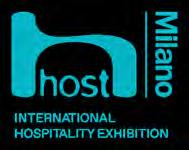
Key target sectors include: distributors, retailers, exporters/importers; restaurants, food service and out-of-home; retail and large-scale distribution; hospitality businesses; shopping centres and venues; chefs, professionals and consultants. Host 2025 will offer a comprehensive overview of innovation in the sector, alongside in-depth focus areas in specific segments, organised by supply chain affinity: professional foodservice and bakery-pastapizza; coffee-tea, bar-coffee machines-vending, gelato-pastry; tableware-technology-contract furnishing.


Cibus Tec Forum 2025
l 28 e 29 ottobre a Parma, ricerca scientifica e industria affrontano le sfide globali della filiera e il futuro del FoodTec. Cibus Tec Forum, evento biennale organizzato da Koeln Parma Exhibition (KPE) (jv tra Koelnmesse e Fiere di Parma) ha formalizzato una partnership strategica con OnFoods. Si tratta di una collaborazione sistemica importante, che lega un evento di riferimento per la tecnologia e l’innovazione nell’industria alimentare e delle bevande con il grande ecosistema italiano della ricerca alimentare. Con il payoff “Two days to reimagine Food Tec”, la mostraconvegno Cibus Tec Forum 2025 si conferma, dunque, innovativa e funzionale a stimolare un confronto su temi chiave come impiantistica avanzata, automazione e robotica, sicurezza alimentare, digitalizzazione dei processi, food packaging sostenibile, ingredienti e formulazioni innovative. Si svolge in contemporanea a Labotec, primo e unico evento in Italia a riunire ricerca, università e laboratori in un solo spazio. Cibus Tec Forum rappresenta, inoltre, una fondamentale tappa di avvicinamento a Cibus Tec 2026, in programma a Parma dal 27 al 30 ottobre 2026.

On 28-29 October in Parma, scientific and industrial research will address global supply chain challenges and the future of FoodTec.
Cibus Tec Forum – a biennial event organised by Koeln Parma Exhibition (KPE), the joint venture between Koelnmesse and Fiere di Parma – has formalised a strategic partnership with OnFoods. This important alliance connects one of the leading events in food and beverage technology and innovation with Italy’s extensive food research ecosystem.
Under the theme “Two days to Reimagine FoodTec”, Cibus Tec Forum 2025 positions itself as an innovative and effective platform for fostering dialogue on key topics such as advanced plant engineering, automation and robotics, food safety, process digitisation, sustainable food packaging, and innovative ingredients and formulations. The forum will be held in conjunction with Labotec, the first and only event in Italy to bring together research institutions, universities and laboratories under one roof.
In addition, Cibus Tec Forum serves as a key milestone in the lead-up to Cibus Tec 2026, scheduled to take place in Parma on 27-30 October 2026.

Pensando al futuro della cosmesi, l’evento Echoes of Beauty si è tenuto il 28 e 29 maggio nella sede Omas Tecnosistemi a Cerro Maggiore (MI), centro di eccellenza del Gruppo IMA.
MA Personal Care e Omas Tecnosistemi hanno aperto le porte per accogliere Echoes of Beauty, un evento internazionale pensato per mettere in relazione tutti i protagonisti del mondo cosmetico.
Per due giorni, lo stabilimento si è trasformato nel cuore pulsante della cosmetica, ospitando un ecosistema di professionisti che include brandowner, contoterzisti, formulatori, produttori di packaging e materie prime, associazioni di settore e distributori.
Il programma ha proposto dimostrazioni pratiche, talk ispirazionali e tavole rotonde partecipative, dove sono stati affrontati temi strategici per il futuro del settore: sostenibilità, evoluzione dei processi produttivi, modelli di business, innovazione negli ingredienti e nelle soluzioni di packaging. Echoes of Beauty si è così rivelata un’esperienza immersiva in un contesto industriale, pensata per stimolare la collaborazione tra i diversi attori del comparto cosmetico. I partecipanti hanno avuto l’opportunità di esplorare da vicino tecnologie di processo, confezionamento e fine linea con macchine in funzione all’interno dello stabilimento: un’opportunità concreta per osservare soluzioni all’avanguardia applicate alle reali esigenze del settore. Un viaggio trasversale attraverso le principali categorie merceologichedalla cura del corpo e dei capelli al make-up e skincare, fino a profumi e prodotti per l’igiene personale - per mettere in luce sinergie, condividere esperienze operative e affrontare insieme le sfide del domani.
Two days dedicated to shape the future of personal care: the event Echoes of Beauty was held on May 28 and 29 at Omas Tecnosistemi headquarters (Cerro Maggiore, MI).
IMA Personal Care has opened the doors of Omas Tecnosistemi (IMA Group’s center of excellence) to host Echoes of Beauty, the international event bringing together every player in the cosmetics industry.
For two full days, the plant became the vibrant heart of the cosmetics world, welcoming an ecosystem of professionals including brand owners, contract manufacturers, formulators, packaging and raw materials producers, industry associations, and distributors.
The program showcased live demonstrations, speeches, and interactive round tables addressing key strategic themes for the future of the sector: sustainability, the evolution of production processes, business models, innovation in ingredients and packaging solutions. Echoes of Beauty offered an immersive experience in a true industrial setting, designed to promote collaboration across all dimensions of the cosmetic supply chain. Alongside expert dialogue, attendees had the opportunity to explore processing, primary and secondary packaging, and end-of-line technologies up close, with live machinery in operation - a concrete opportunity to witness advanced solutions tailored to real industry needs. A cross-sector journey through the main product categories - from body and hair care to make-up and skincare, as well as perfumes and personal hygiene productswill uncover synergies, share operational experiences, and tackle tomorrow’s challenges together.
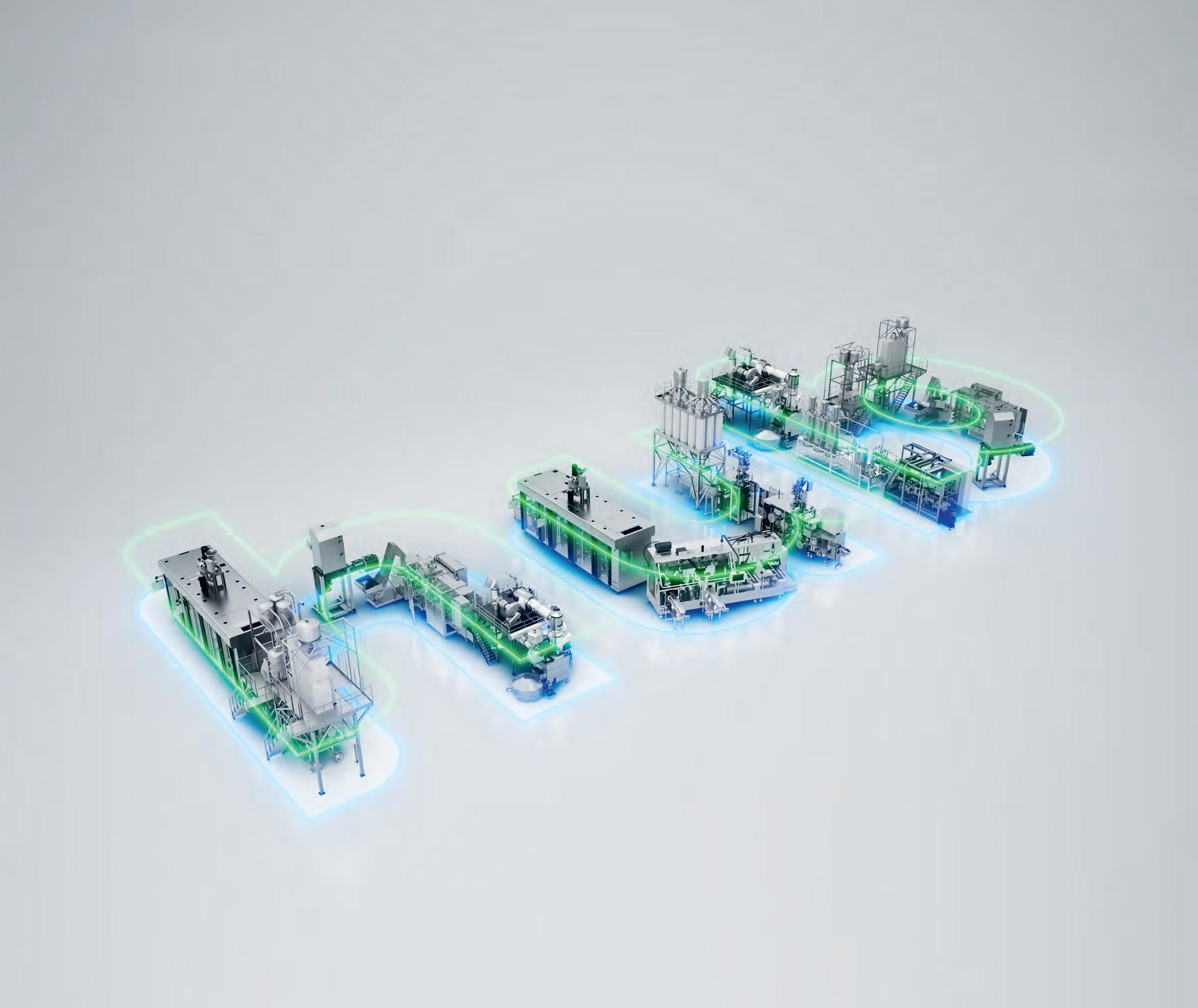

INTEGRATED TECHNOLOGIES, SUPERIOR SUSTAINABILITY
Imagine a complete turnkey processing and packaging line for your coffee. From beans reception to end-of-line solutions, each machine is interconnected in a digital ecosystem, maximising performance, production efficiency, and ensuring superior sustainability through monitored processing, reduced energy consumption, lower emissions, and with the ability to handle all compostable and recyclable packaging materials. Imagine being able to have all this from one single source. IMA Coffee Hub. Look no further.
Visit us at HOST 2025 Milan, ITALY • 17-21 October • Hall 18, Booth A24 A32 B23 B31

Chi ha vinto e perché: le immagini e i giudizi della giuria che ha decretato i “migliori” nelle sezioni Tecnologia, Quality Design e Ambiente.
Evento di richiamo durante Ipack-Ima (main sponsor dell’evento), la premiazione dei prodotti e delle aziende iscritte al contest organizzato da Istituto Italiano Imballaggio e patrocinato da Conai, ha offerto l’occasione di riflettere sullo stato dell’arte del packaging e sulle competenze tecnologiche espresse a vari livelli dai partecipanti. I vincitori di quest’anno incarnano una visione all’avanguardia che coniuga tecnologia, ecologia, funzionalità e design, in linea quindi con le principali direttrici emerse nell’analisi delle ten-
Tecnologia: i prodotti,
denze 2025, ovvero:
• sostenibilità come driver strategico (uso di materiali riciclati, compostabili e monomateriali);
• tecnologia al servizio dell’ambiente (digitalizzazione, sistemi airless, stampa diretta e automazione intelligente);
• esperienza uten te e design funzionale (packaging che semplificano l’uso, facilitano lo smaltimento e migliorano la conservazione).
• estetica e storytelling (packaging premium che combinano eleganza, identità visiva e
Technology category: products, companies and reviews
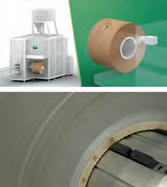

Frescosystem+, Goglio. Integrazione intelligente di materiali, macchine e dati in un ecosistema digitale unico che ottimizza i processi, riduce gli sprechi e rappresenta un passo avanti verso un’automazione sostenibile del packaging.
Frescosystem+, Goglio. An intelligent integration of materials, machinery, and data within a unified digital ecosystem that optimises processes, reduces waste, and represents a step forward in sustainable packaging automation.
Snack&Vai, Granterre e Istituto Stampa. Introduzione della saldatura a freddo su carta, una soluzione innovativa che semplifica i materiali, migliora la riciclabilità e ottimizza i consumi, stabilendo un nuovo standard sostenibile nel food packaging.
Snack&Vai, Granterre and Press Institute. Introducing cold sealing on paper marks an innovative solution that simplifies material composition, improves recyclability and reduces consumption, setting a new sustainable standard in food packaging.
The good ideas From Research to the Shelf Powered by Best Packaging Istituto Italiano Imballaggio Monthly showcase of packaging solutions to communicate, protect and distribute commonly used products.
responsabilità ambientale);
• adattabilità e scalabilità industriale (soluzioni applicabili a più settori e processi produttivi).
Il contest Best Packaging si è dunque confermato anche quest’anno come laboratorio d’idee per un packaging sostenibile, efficiente e centrato sul consumatore. Le aziende premiate dimostrano come innovazione e responsabilità ambientale possano coesistere, ridefinendo i paradigmi dell’imballaggio contemporaneo.



Smartflexpack Fesr 1054, Loacker. Sviluppo di una tecnologia di stampa diretta che elimina le etichette adesive, migliora la riciclabilità e integra digital twin e computer vision per un controllo avanzato e sostenibile del packaging.
Smartflexpack Fesr 1054, Loacker. Development of direct printing technology that eliminates the need for adhesive labels. It improves recyclability, and integrates digital twin technology and computer vision, enabling advanced and sustainable control of the packaging process.
T-Bag, Smilesys e Mustangpack. Rivoluzione dell’imballo in carta con un sistema termosaldabile, 100% naturale e riconvertito da linee industriali precedentemente impiegate per la produzione di mascherine. Il nuovo sistema riduce del 50% il consumo di materia prima e migliora l’esperienza del consumatore.
T-Bag, Smilesys and Mustangpack. A revolution in paper packaging with a heat-sealable, 100% natural system repurposed from industrial lines previously used for mask production. This innovative system reduces raw material consumption by 50% and enhances the consumer experience.

Quality Design Special Award
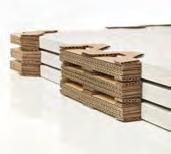
Scudo, Brafim. Creazione di un sistema protettivo 3D in cartone riciclato che garantisce massima ammortizzazione, facilità di riciclo e significativa riduzione dell’impronta di carbonio.
Scudo, Brafim. A 3D protective system made from recycled cardboard that guarantees maximum cushioning, ease of recycling, and significant reduction in the carbon footprint.
Special Environment Award
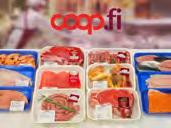
Direct, Gruppo Happy e Unicoop Firenze. È stato reinventato il vassoio drenante in XPS riciclato, monomateriale, leggero, riciclabile e privo di pad assorbente, migliorando la conservazione degli alimenti e riducendo l’impatto ambientale del 36%.
Direct, Happy Group and Unicoop Florence. A reinvention of the draining tray in recycled XPS, mono-material, lightweight, recyclable and absorbent pad-free, which improves food preservation and reduces environmental impact by 36%.
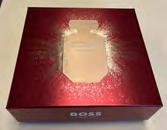
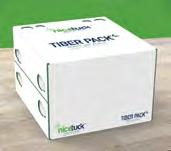
Cofanetto per cosmetici di lusso, Taghleef Industries e Plastigraf Trevigiana. Unione di estetica e sostenibilità nel lusso attraverso un laminato innovativo composto per oltre il 90% da risorse rinnovabili, ridefinendo gli standard del packaging premium.
Luxury cosmetics case, Taghleef Industries and Plastigraf Trevigiana. A blend of aesthetics and sustainability in the luxury sector, achieved through an innovative laminate made from over 90% renewable resources, redefining the standards of premium packaging.
Nicetuck, Tiberpack. Sviluppo di un sistema di incartonamento che elimina colle e adesivi, riducendo l’uso di materiali e il consumo energetico senza compromettere l’efficienza produttiva.
Nicetuck, Tiberpack. Development of a cartoning system that eliminates the need for glues and adhesives, reducing material usage and energy consumption, while maintaining high production efficiency.
Who won and why: photos and jury comments on the winners in the Technology, Quality Design and Environment categories.
A highlight of Ipack-Ima (main sponsor of the event) was the award ceremony for the products and companies taking part in the contest organised by the Istituto Italiano Imballaggio and sponsored by Conai. The event offered an opportunity to reflect on the state of the art in packaging and to recognise the technological expertise demonstrated by participants across various levels.
This year's winners embody a forward-thinking vision that combines technology, sustainability, functionality and design, therefore, in line with the guiding principles identified in the 2025 trend analysis:
• sustainability as a strategic driver (use of recycled, compostable, and mono-material solutions);
• environmentally focused technologies (digitisation, airless systems, direct printing and intelligent automation);
• user experience and functional design (packaging that simplifies use, facilitates disposal, and improves storage);
• aesthetics and storytelling (premium packaging that combines elegance, brand identity and environmental responsibility);
• industrial adaptability and scalability (solutions that can be applied to multiple industries and production processes).
Once again this year, the Best Packaging contest confirmed its role as a laboratory of ideas for sustainable, efficient and consumer-focused packaging. The award-winning companies demonstrate that innovation and environmental responsibility can go hand in hand, helping to redefine the paradigms of contemporary packaging.

Gian Paolo Crasta Direttore Generale Ucima
Raccontare una settimana intensa, come quella conclusa a IPACK-IMA e Pharmintech powered by Ipack Ima non è facile in poche righe. Ho provato dunque a farlo attraverso un glossario (non sono poche righe) nella consapevolezza che non sia comunque esaustivo.
ANNIVERSARI: tanti quelli festeggiati in fiera. Uno su tutti quello di Cavanna SpA che ha celebrato i suoi 65 anni nella iconica cornice del Museo Alfa Romeo. La narrazione della storia industriale del gruppo, trasmessa per parallelismo con quella gloriosa dell’iconico marchio di automobili, ha lasciato il posto alla storia e ai valori della famiglia che la guidano. Presenti le tre generazioni che in vari momenti si sono presentate ai tanti ospiti italiani e internazionali. Tra loro, ovviamente, il vulcanico Riccardo Cavanna, che ha testimoniato concretamente il suo impegno verso i professionisti futuri del nostro settore con una raccolta fondi per una borsa di studio presso Università Bocconi.
BEST PACKAGING: la cerimonia di premiazione del riconoscimento dell’Istituto Italiano Imballaggio si è tenuta in una sala gremita: sostenibilità, digitalizzazione, ottimizzazione di processi e tecnologie al centro delle motivazione che hanno guidato la giuria che ho avuto l’onore di presiedere.
COLLABORAZIONE: una delle parole ricorrenti della settimana. Per una rara volta non è stata una parola vuota ma l’intento di farlo e le collaborazioni già avviate sono state tangibili.
DONARE: durante le fiere, doniamo le nostre intere giornate alle aziende per cui lavoriamo, ai colleghi e ai partner, ottenendo però in cambio calore, conoscenza ed entusiasmo.
EUROPAMA: Ipack-Ima è stata la cornice che ha riunito le associazioni europee dei produttori di macchinari per il packaging che hanno approvato la costituzione della Federazione europea.
FESTE: ogni sera un’occasione per stare assieme, conoscere nuove persone e divertirsi. Perché la socialità deve essere una parte importante della nostra comunità professionale.
GIFLEX: attore essenziale della filiera dell’imballaggio, l’associazione degli imballaggi flessibili (Giflex - Gruppo Imballaggio Flessibile) ha festeggiato in fiera i suoi 40 anni. Lo ha fatto conducendo i suoi ospiti in un viaggio stimolante che ha raccontato la storia umana e professionale di uno dei geni industriali del nostro tempo, l’esperienza di un astronauta e ovviamente le tappe fondamentali dei loro primi quarant’anni.
HOTEL: la casa temporanea per tutti. Chiuderci dietro la porta della camera per l’ultima volta è uno dei rituali che decreta la fine della fiera.
INTERNAZIONALITÀ: parte essenziale del dna del nostro settore, è stata tangibilmente presente a Milano. Gli operatori internazionali hanno animato i padiglioni della fiera e la fiera ha dimostrato di essere uno degli appuntamenti ‘not to be missed’ per chi lavora nel nostro mondo.
LOUNGE: la nostra lounge è stata uno dei punti di incontro della settimana. È stato bellissimo fare la gincana tra le tante persone sempre presenti.
MACCHINARI: ma anche materiali, software e componenti. Tanti e innovativi. Una ulteriore conferma della vitalità del settore e della percezione delle fiere quale vetrina privilegiata per presentarli.
NARRAZIONE: tantissime le storie che si sono raccontate la scorsa settimana, confluite in una importante narrazione comune. L’industria del processo e del confezionamento è tra le più vitali al mondo, ricca di innovazione, competenze, aziende e persone.
ORGOGLIO: la settimana ha confermato la leadership mondiale del sistema italia del packaging. E questo non può che riempirci di orgoglio.
PIACERE: un’altra delle parole più pronunciate nei giorni scorsi. Seguiva spesso una stretta di mano preludio di una nuova, spesso interessante, conoscenza.
QUALITÀ: è stata tangibile ed evidente tutta la settimana: nella cura delle centinaia di stand presenti, negli allestimenti della manifestazione, nel livello dei contenuti - uno su tutti l’evento d’apertura ‘Visioni d’Avanguardia’ - nei professionisti incontrati.
RIVISTE: un termine ormai riduttivo per indicare le media company che raccontano la nostra industria. Tutte presenti in fiera con grande impegno. La nostra ItaliaImballaggio ha distribuito in fiera un numero ricco e interessante e con video e articoli online ci ha consentito di prendere parte ad eventi e incontrare aziende che le nostre agende non ci avrebbero consentito di vedere.
SEE YOU AT: le fiere sono un appuntamento ricorrente, spesso una tappa importante per una filiera industriale. Ipack ima e Pharminteh torneranno nel 2028 ma abbiamo già in programma appuntamenti che nei prossimi tre anni riuniranno gli stakeholders, ad iniziare da Bevertech e SIMEI.
TEAM: senza un team di professionisti appassionati e competenti non è possibile ottenere risultati. Un grazie quindi a tutte le persone che nelle aziende, nelle associazioni e nelle organizzazioni hanno reso possibile le fiere. In particolare alla squadra guidata da Simone Castelli e al mio dream team senza i quali nulla di quello che facciamo e faremo sarebbe possibile.
UCIMA: anche noi UCIMA (Confindustria) siamo stati protagonisti della settimana. Non solo con le tante aziende associate presenti ma anche con gli eventi organizzati direttamente, con i relatori che hanno contribuito alla buona riuscita di quelli ufficiali e con l’impegno profuso nei mesi scorsi per rendere la fiera un successo.
VISITATORI: in attesa dei risultati ufficiali, la folla su Corso Italia, le tante lingue parlate tra i corridoi testimonia che questa edizione ha ulteriormente confermato che la nostra fiera è un punto di riferimento internazionale a cui partecipare.
WORLD PACKAGING ORGANISATION: un’altra delle istituzioni cardine del nostro mondo WPO World Packaging Organisation. Un gruppo animato dalla passione per l’imballaggio come ha ricordato Soha Atallah durante il gala degli award, serata riuscitissima che ha chiuso la maratona fieristica.
ZUCCHERI: è la categoria di nutrienti più consumata nelle lunghe giornate di fiera. Sostegno e conforto per la stanchezza ma anche nutrimento extra per le nostre connessioni neuronali sottoposte ad un intenso lavoro.


Telling the story of an intense week, like the one that just ended at IPACK-IMA and Pharmintech powered by Ipack Ima, isn’t easy in just a few lines. So I tried to do it through a glossary (not exactly a few lines), knowing full well it’s still not exhaustive.
ANNIVERSARIES: Many were celebrated at the tradeshow. One among them, Cavanna SpA celebrated its 65th anniversary in the iconic setting of the Museo Alfa Romeo. The story of the group’s industrial journey, told in parallel with the glorious history of the iconic car brand, gave way to the story and values of the family behind it. Three generations were present and took turns greeting the many Italian and international guests. Among them, of course, the dynamic Riccardo Cavanna, who demonstrated his commitment to the future professionals of our sector with a fundraising campaign for a scholarship at Università Bocconi.
BEST PACKAGING: The awards ceremony held by the Istituto Italiano Imballaggio took place in a packed hall: sustainability, digitalization, and process and technology optimization were at the heart of the jury’s reasoning, an honor for me to chair.
COLLABORATION: One of the most frequently heard words of the week. And for once, it wasn’t just an empty term, real intent and concrete initiatives were clearly visible.
EUROPAMA: Ipack-Ima hosted the meeting of European associations of packaging machinery manufacturers, who approved the constitution of a new European Federation.
GIFLEX: A key player in the packaging supply chain, the Italian flexible packaging association, Giflex - Gruppo Imballaggio Flessibile, celebrated its 40th anniversary at the fair. It did so by taking guests on an inspiring journey that recounted the personal and professional story of one of the industrial geniuses of our time, the experience of an astronaut, and of course the key milestones of its first forty years.
GIVING: During tradeshows, we give our entire days to the companies we work for, to colleagues and partners, but in return we receive warmth, knowledge, and enthusiasm.
HOTEL: Our temporary home. Closing the hotel room door for the last time is one of those rituals that signals the end of the fair.
INTERNATIONALITY: A core part of our industry’s DNA, and it was palpably present in Milan. International professionals filled the exhibition halls, and the fair confirmed itself as a not-to-bemissed event for our industry.
LOUNGE: Our lounge was one of the key meeting points of the week. It was wonderful to weave through the constant stream of people.
MACHINERY: But also materials, software, and components. Numerous and innovative. A further confirmation of the sector’s vitality and of the fairs as a privileged showcase for presenting innovations.
MAGAZINES: A term that barely captures what media companies mean for our industry. All were present at the fair with great commitment. Our own ItaliaImballaggio distributed a rich and engaging issue, and through videos and online articles helped us attend events and meet companies that packed agendas would otherwise have kept us from.
PARTIES: Every evening was an opportunity to be together, meet new people, and have fun. Because social interaction should be an important part of our professional community.
PRIDE: The week reaffirmed the global leadership of Italy’s packaging system. And that fills us with pride.
PLEASURE: Another frequently uttered word in recent days, often following a handshake that marked the start of a new and interesting acquaintance.
QUALITY: It was evident throughout the entire week - in the care put into the hundreds of stands, the event setups, the level of content (not least the opening event, Visioni d’Avanguardia), and the professionals met along the way.
STORYTELLING: So many stories were shared last week, all part of a broader common storytelling. The processing and packaging industry is one of the most vibrant in the world, rich in innovation, skills, companies, and people.
SEE YOU AT: Trade shows are recurring appointments - often crucial stages for an industrial supply chain. Ipack-Ima and Pharmintech will return in 2028, but we already have events planned over the next three years, starting with Bevertech and SIMEI, to gather stakeholders once again.
SUGAR: The most consumed category of nutrients during the long days of the fair. A source of support and comfort for our fatigue, but also extra fuel for the neurons working at full speed.
TEAM: Without a passionate and competent team, results aren’t possible. So thanks to everyone -within companies, associations, and organizations - who made these fairs a reality. A special thanks to the team led by Simone Castelli, and to my own dream team, without whom none of what we do (and will do) would be possible.
UCIMA: We UCIMA (Confindustria) were also key players throughout the week - not only through the many member companies present, but also by organizing events, contributing speakers to official programs, and working tirelessly in the past months to make the fair a success.
WORLD PACKAGING ORGANISATION: Another cornerstone institution in our world, WPO World Packaging Organisation. A group driven by passion for packaging, as Soha Atallah reminded us during the Award gala, a wonderful evening that closed this trade show marathon.
VISITORS: While awaiting the official numbers, the crowds on Corso Italia and the many languages spoken in the halls confirm that this edition has further solidified the fair as an international must-attend event.

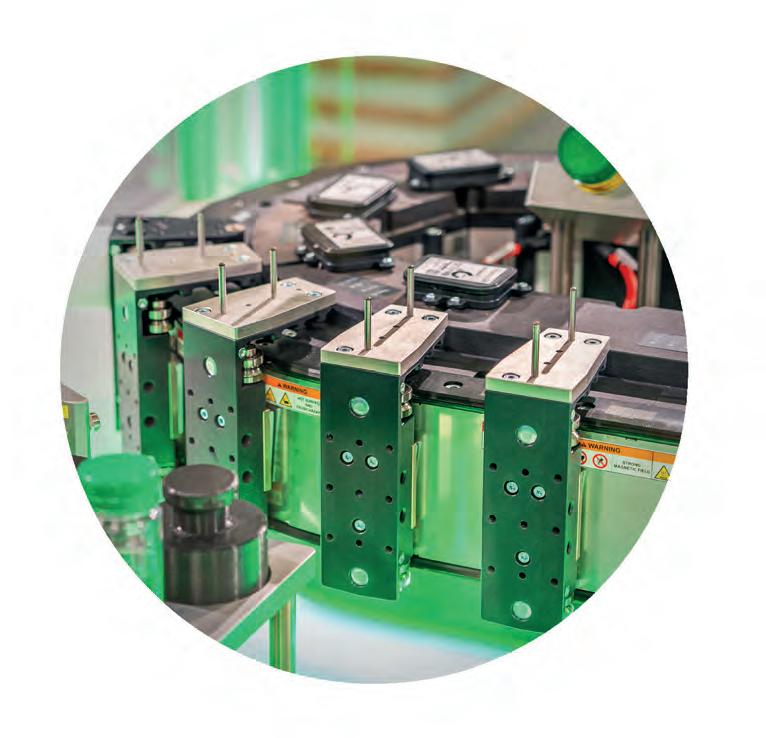
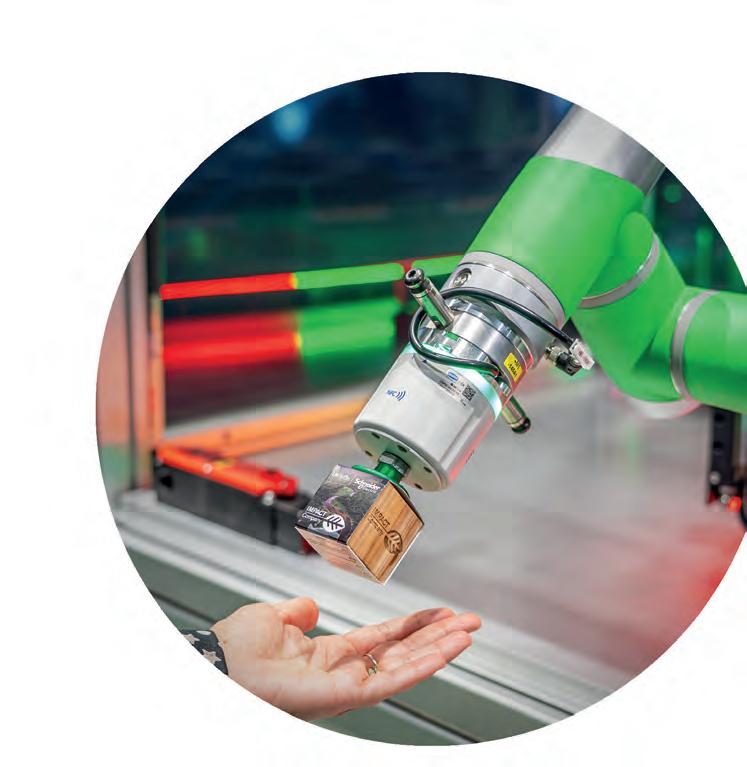

Numeri in crescita, rafforzamento del processing e forte internazionalizzazione le principali novità dei due eventi ospitati a Fiera Milano. In campo innovazione, visione globale, risultati misurabili.
Con un’edizione 2025 al di sopra delle aspettative, IPACK-IMA ha confermato il suo ruolo di manifestazione internazionale di riferimento per le tecnologie di processo, confezionamento e nuovi materiali, in ambito food e non food. La fiera ha registrato un incremento straordinario rispetto all’edizione 2022, con il raddoppio degli espositori internazionali, che hanno raggiunto le 400 aziende e il +51% di visitatori esteri, confermando IPACK-IMA come hub strategico per l’innovazione industriale con performance che hanno superato l’edizione record del 2018. L’unione strategica tra IPACK-IMA e Pharmintech si è dimostrata nuovamente vincente, valorizzando una sinergia efficace e rafforzando una collaborazione in grado di generare risultati concreti attraverso la contaminazione tra mondi industriali complementari.

I numeri di IPACK IMA 2025
Le Smart Factory al centro della scena. Tre linee complete, dedicate a flexible packaging, beverage e caffè, hanno mostrato in azione le tecnologie più avanzate sul mercato, coinvolgendo un flusso costante di professionisti attenti a ogni fase delle live run. Le smart factory hanno inoltre evidenziato un valore strategico: la collaborazione tra competitor è non solo possibile, ma apprezzata dal mercato.
Il processing in crescita. Se il packaging è il cuore storico della manifestazione, l’edizione 2025 ha visto una forte crescita del comparto processing, con la presenza di player globali dei settori alimentare, non alimentare e farmaceutico. Una sinergia che arricchisce l’offerta e riflette la crescente integrazione tra processo e confezionamento.
• 70.560 visitatori professionali (contro i 68.802 del 2018), di cui 22.579 esteri (il 32% del totale) in crescita del 22% rispetto al 2018, provenienti da oltre 100 paesi
• Oltre 1.300 espositori per IPACK-IMA, di cui 38% internazionali
• Oltre 300 espositori per Pharmintech, di cui 35% internazionali
• Più di 45 incontri tematici, animati da 150 speaker di alto profilo
IPACK-IMA 2025 in numbers
• 70,560 professional visitors (compared to 68,802 in 2018), including 22,579 international attendees (32% of the total) up 22% from 2018, from over 100 countries
• Over 1,300 exhibitors at IPACK-IMA, 38% of which were international
• Over 300 exhibitors at Pharmintech, with 35% coming from abroad
• More than 45 thematic events, featuring 150 high-profile speakers


Una fiera da vivere, non solo da visitare. In un contesto accogliente e dinamico come quello di Fiera Milano, IPACK-IMA ha permesso di coniugare business e relazione, tecnologia e visione, rendendo l’esperienza fieristica particolarmente coinvolgente. Visitatori, buyer ed espositori hanno condiviso opportunità commerciali, ma anche una cultura dell’innovazione che integra meccanica e design, digitalizzazione e intelligenza artificiale, nuovi materiali e automazione.
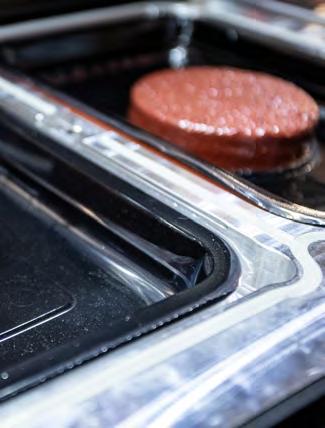
Respiro internazionale e prossimi appuntamenti. Dopo il successo del 2025, il percorso di IPACK-IMA prosegue con una visione strategica e internazionale fondata su solide partnership. Si riparte a giugno con la collaborazione con INFORMA Markets e la partecipazione a ProPak Asia, primo appuntamento verso una crescente proiezione globale. Il cammino continua nel 2026 con il lancio di Bevertech, il nuovo progetto nato dalla sinergia con UIV (Unione Italiana Vini) e in contemporanea con Simei,



pensato per anticipare le evoluzioni e le esigenze del settore liquid food & beverage. «Abbiamo superato i risultati del 2018, nostro storico benchmark - dichiara Simone Castelli, CEO Ipack Ima - ma il vero successo è la qualità delle connessioni create. La sinergia tra espositori e visitatori e, in modo ancora più significativo, tra aziende spesso concorrenti, ha generato un’esperienza ad alto impatto, dimostrando che l’innovazione condivisa moltiplica valore, efficacia e competitività».
«In un mercato che cambia rapidamente, IPACK-IMA si è dimostrata una piattaforma sicura e autorevole - osserva Valerio Soli, Presidente Ipack Ima - capace di offrire strumenti di lettura del mercato, occasioni concrete di business e una visione del futuro. Un ecosi-

stema che non solo interpreta il cambiamento, ma accelera innovazione e sviluppo per l’intera filiera».
Ricordiamo che a prossima edizione di IPACKIMA si terrà dal 29 maggio al 1° giugno 2028.
The Inno vation Alliance. IPACK-IMA e Pharmintech sono parte integrante del progetto “The Innovation Alliance”, che vede lo svolgimento in concomitanza di tre mostre sinergiche dedicate alla meccanica strumentale (Greenplast, Intralogistica Italia e Print4all) in una logica di filiera allargata. L’edizione 2025 ha accolto 108.458 operatori da 143 Paesi e 1.857 espositori (39% esteri), confermando il valore dell’approccio sinergico tra le fiere parte della filiera.
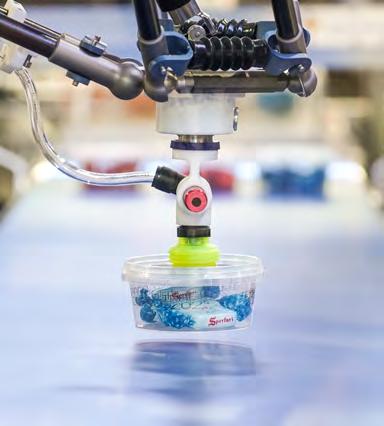
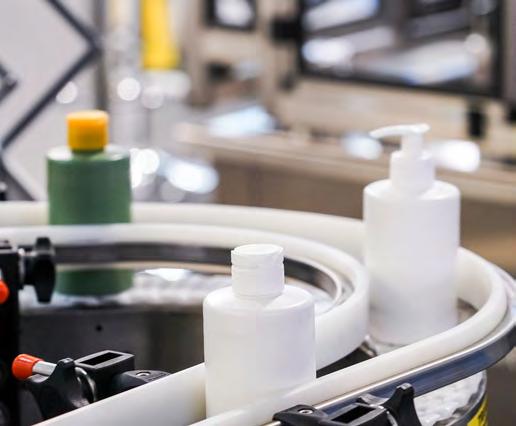

Growing numbers, strengthened processing, and strong internationalization are the main new developments of the two events hosted by Fiera Milano. On stage, innovation, global vision and measurable results.
With a 2025 edition exceeding all expectations, IPACK-IMA has confirmed its position as the leading international event for process technologies, packaging solutions, and new materials across both food and non-food sectors. The exhibition, which ended on May 30 after four dynamic days of business and networking, recorded an exceptional increase in numbers compared to its previous edition in 2022, - with international exhibitors more than doubling (over 400 companies) and a 51% increase in foreign visitors - reaffirming its role as a strategic hub for industrial innovation.
The strategic alliance between IPACK-IMA and Pharmintech has once again proven successful, enhancing an effective synergy and strengthening a collaboration capable of delivering concrete results through the integration of complementary industrial sectors.
Smart factories take centre stage. Three complete lines - focused on flexible packaging, beverages, and coffee - showcased the most advanced technologies on the market in action. A steady stream of professionals closely followed every stage, demonstrating the demand for tangible and effective solutions. The live demos highlighted a strategic value: collaboration among competitors is not only possible but also appreciated by the market.
Processing levels up. While packaging has traditionally been the core of the event, the 2025 edition saw significant growth in the processing sector, featuring global players from the food, non-food, and pharmaceutical industries. This synergy enriches the offering and reflects the increasing integration between processing and packaging.
More than an event, an experience. In a welcoming, vibrant setting like the Fiera Milano exhibition centre, IPACK-IMA successfully combined opportunities for business and networking alongside technology and vision, making the trade fair experience truly engaging. Visitors, buyers, and exhibitors shared business opportunities, but also a culture of innovation that brings together mechanics and design, digitalisation and artificial intelligence, new materials and automation.
International reach and upcoming events. After the success of 2025, the IPACK-IMA journey continues with a strategic international vision based on solid partnerships. Activities will be resuming in June with the partnership with INFORMA Markets and participation in ProPak Asia, the first step towards an expanding global presence. The next stage, in 2026, will be the launch of Bevertech, a new initiative born from synergy with UIV (Italian Wine Union) and running concurrently with Simei winemaking fair, designed to anticipate the evolutions and needs of the liquid food & beverage sector.
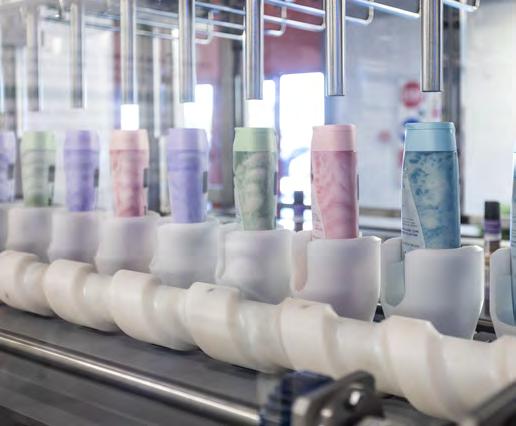
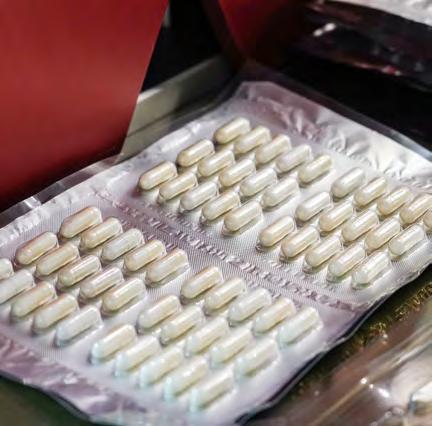
«We have outperformed the 2018 numbers, our historic benchmark, but the real success of the fair is reflected by the quality of the connections created. The synergy between exhibitors and visitors and - even more significantly - among often competing companies, has generated a high-impact experience, proving that shared innovation multiplies value, effectiveness, and competitiveness» Simone Castelli, CEO of IPACK-IMA affirms.
«In a rapidly changing market, IPACK-IMA has proven to be a reliable and reputable platform, capable of offering tools to understand the market, genuine business opportunities, and a vision of the future. An ecosystem that not only interprets change but also accelerates innovation and development along the entire supply chain» As Valerio Soli, President of Ipack-Ima, observes.
The next IPACK-IMA will be running from 29 May to 1 June 2028.
The Innovation Alliance.Once again, IPACK-IMA was part of The Innovation Alliance - the partnership that brings together four trade shows: GreenPlast, IPACK-IMA, Print4All, and Intralogistica Italia. The recently concluded edition welcomed 108,458 industry professionals from 143 countries and 1,857 exhibitors (39% international), confirming the value of the collaborative approach between the exhibitions.





Annoverati fra le bevande analcoliche, i comparti caffè, tè, tisane & infusi risultano in “buona salute”. Le dinamiche di mercato in Italia e le tipologie di confezionamento impiegate.
Barbara Iascone
Consumati sia caldi che freddi, caffè, tea, tisane e infusi risultano crescere anno dopo anno: queste bevande analcoliche sono ormai diventate un rituale giornaliero per quasi tutti gli italiani.
E se il caffè rimane tradizionalmente la bevanda più diffusa, sia i tè che le tisane e gli infusiidealmente associati a uno stile di vita sano e salutare - stanno prendendo sempre più piede.
Dinamiche di mercato, comparto per comparto
Seppur accomunati da molti elementi, questi settori merceologici presentano alcuni tratti caratteristici, pertanto vengono analizzati in maniera distinta, anche per quanto concerne il confezionamento.
Il caffè
L’Italia risulta essere uno degli attori più competenti a livello internazionale nella lavorazione e produzione di caffè che, nel nostro caso, comincia dal processo di tostatura e macinatura dei chicchi di caffè verde importato e non torrefatto.
La principale caratteristica della produzione italiana è la sapiente miscelatura di grani provenienti da aree geografiche differenti. Questo comporta che la lavorazione nostrana si riferisca solo al caffè importato, da cui derivano poi produzione, esportazioni e consumi. Nel 2023, ultimi dati al momento disponibili, sono state circa un migliaio le aziende impiegate in questo processo produttivo, con un’occupazione diretta stimata di circa 7.000 addetti, generando un fatturato che si aggira intorno ai 4,8 miliardi di euro, per il 48% derivante dalle esportazioni. (Tabella 1)
Tabella 1. Bilancio del mercato del caffè in Italia.
Table 1. Overview of the coffee market in Italy.

Consumo caffè tostato e macinato -
Consumo NON industriale - 219,41 - 249,31 NON-industrial consumption
Consumo domestico - 155,78 - 162,05 Home consumption
Consumo horeca - 63,63 - 87,26 HoReCa consumption
Fonte/Source: Banca Dati Istituto Italiano Imballaggio su dati Istat.
Produzione e consumi. In base alle prime elaborazioni relative al 2024, i dati ci mostrano un settore in leggera contrazione, -0,5% per il fatturato e -1,6% per le tonnellate prodotte. La produzione di caffè torrefatto in Italia dovrebbe ammontare intorno alle 501.000 t, di cui quasi il 60% destinato all’export. Sempre nel 2024, le esportazioni di caffè torrefatto crescono sia in termini di fatturato che di quantità: +8,8% nel primo caso e +1,4% nel secondo.
Con il 38% circa della produzione italiana destinata all’export, le tonnellate di caffè torrefatto esportato sono state 296.000, per un valore pari a circa 2,2 mld di euro. Analizzando i numeri riferiti alle esportazioni, i principali paesi di destinazione del nostro prodotto risultano come sempre, Germania Francia e Stati Uniti. In crescita anche le importazioni: nel 2024 le importazioni di caffè verde registrano un +27% per il fatturato e un +1,5% per le tonnellate. In base ai dati ISTAT, oltre il 96% delle importazioni di caffè è rappresentato dal caffè verde importato dai vari Paesi produttori e questo rappresenta il volume disponibile per la trasformazione nel nostro Paese. Più della metà delle nostre importazioni di caffè verde proviene da due soli paesi produttori: Brasile (principalmente le qualità Arabica) e Vietnam (la qualità Robusta).
Il resto delle importazioni riguarda caffè tostato, per lo più solubile e macinato in capsule, proveniente soprattutto dagli stabilimenti svizzeri del gruppo Nestlé-Nespresso. Per una lettura coerente dei dati, analizzando le quantità in peso, è necessario considerare alcuni fattori fondamentali. Prima di tutto va sottolineato che il caffè tostato e macinato pesa un 20% in meno rispetto a quello verde in grani, traducendo in numeri quindi da 371 t/000 a 296,80. In secondo luogo, di queste circa l’84% è destinato alla preparazione della bevanda, sia essa consumata in casa che fuori casa, il restante 16% è destinato all’uso industriale, vale a dire alla preparazione di prodotti
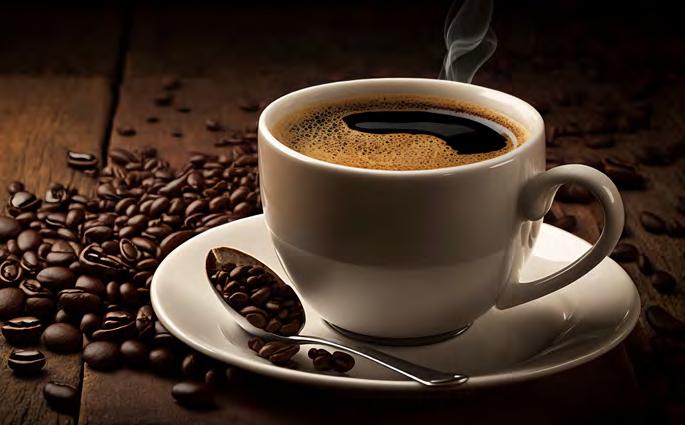

Tabella 2. Bilancio bevanda tè (valori espressi in mln litri).
Table 2. Tea beverage market balance(values in million litres).
2023 2024
Produzione 851 711 Production
Export 268 134 Export
Consumo 583 577 Consumption
Fonte/Source: Banca Dati Istituto Italiano Imballaggio su dati Istat.
Tabella 3. Bilancio tè da infusione (valori espressi in t/000).
Table 3. Infusion tea market balance (values in thousand tonnes).
2023 2024 %
Produzione 1,493 1,471 -1,5% Production Import da confezionare 3,10 3,40 9,7% Imports for packaging Disponibilità al confezionamento 7,3 8,0 9,6% Availability for packaging Export (solo di tè) 1,00 1,30 30,0% Exports (tea only Consumo Totale 9,4 10,1 7,4% Total consumption
Fonte/Source: Banca Dati Istituto Italiano Imballaggio su dati Istat
tipo gelati, yogurt, bibite, dessert, ecc. Calcoli alla mano, il caffè confezionato consumato in Italia nel 2023 risulta pari a 249,31 t/000. Alimentati dai vari canali del retail e dall’e-commerce, i consumi domestici rappresentano il 71% della quantità, mentre i consumi fuori casa, alimentati dalle vendite nell’Ho.Re.Ca., nel vending e nell’OCS, rappresentano il 29% a quantità.
A valore, il distacco fra i due settori si riduce dato che, nel fuori casa, si opera con prezzi mediamente più elevati rispetto al dettaglio. Sempre a proposito dei consumi domestici, il caffè macinato nelle varie versioni (macinato normale e macinato espresso), resta ancora la tipologia più diffusa nel mercato con il 68% di share.
In continua e costante crescita, il caffè porzionato in cialde o capsule rappresenta ad oggi circa il 20% dei volumi totali del caffè macinato. Il 7,3% del caffè consumato in Italia è rappresentato dal caffè in grani mentre il restante 4,7% è rappresentato dal caffè solubile.

Il tè e gli infusi
Il segmento del tè si suddivide in due tipologie di prodotti: da una parte abbiamo tè, infusi e tisane somministrate in bustine, dall’altra i prodotti sfusi oppure solubili preparati dal consumatore per ottenere bevande calde o fredde. Accanto alle due tipologie citate, abbiamo anche le bibite pronte, da consumarsi fredde o a temperatura ambiente.
Parlando di infusi, cominciamo con il sottolineare che in Italia sono presenti pochissime piantagioni di tè; pertanto, quando si parla di produzione nazionale ci si riferisce essenzialmente al confezionamento di tè sfuso importato. (Tabelle 2 e 3)
Produzione e consumi. Nel 2023 la produzione totale riferita a tè, infusi e tisane è stata di 20.158 tonnellate (dati ISTAT ultimi disponibili), in calo del 6% rispetto al 2022. Il settore del tè da infusione registra, nel 2024, un calo nella produzione espressa in quantità pari al -1,5%, a fronte però di andamenti positivi sia per le importazioni che per le esportazioni. Questo elemento è di fondamentale importanza in questo settore, perché la maggior parte del tè confezionato in Italia arriva dall’estero.
La produzione italiana nel 2024 dovrebbe assestarsi su circa 1.470 tonnellate, a fronte di un’importazione sfusa di circa 3.420 tonnellate, in crescita dell’11,2%. Questo dato ha portato ad aumentare del 7% la disponibilità al confezionamento in Italia. Se consideriamo

Tabella 4. Mix del packaging di caffè destinato al consumo diretto (valori % riferite alle quantità di prodotto confezionato, 2024)
Table 4. Coffee packaging mix for direct consumption (% of packaged volumes, 2024)
Poliaccoppiati Flex 84,3% Flex polylaminates
Barattoli in acciaio 8,3% Steel tins
Cialde e capsule 6% Pods and capsules
Sacchetto carta 1,0% Paper Bags
Vasetto vetro 0,3% Glass jars
Astuccio cartoncino 0,1% Cardboard boxes
Fonte/Source: Banca Dati Istituto Italiano Imballaggio su dati Istat.
poi i dati relativi alle esportazioni e alle importazioni confezionate, il consumo apparente registra un +4,7%.
A conferma della crescita del consumo apparente - che, lo ricordo, non tiene conto del movimento scorte - è l’indagine di Adnkronos “Età senza età”, dalla quale emerge che il consumo di tè, infusi e tisane negli ultimi anni è aumentato di oltre il 20% specialmente tra gli over 51. Analizzando il mercato del tè, si deve prendere in considerazione anche il segmento relativo alla bibita fredda, spesso acquistata in sostituzione di altre bibite sia piatte che carbonate o di succhi di frutta.
Il tè freddo rappresenta in Italia la bevanda più bevuta dopo la cola, con un consumo pro capite di oltre nove litri annui, uno tra i valori più alti a livello europeo.
Oltre ai tradizionali gusti fruttati, si sono affermate anche altre varianti, come il tè verde, che ha ormai raggiunto il 10% circa dei volumi totali, e il tè deteinato, quest’ultimo veicolato soprattutto sul target ragazzi.
Negli ultimi anni si è diffuso il consumo di tè misto a bevande fruttate. Secondo l’elaborazione dei dati dell’Istituto Italiano Imballaggio, nel 2024 i consumi di questa bibita si sono assestati intorno ai 577 milioni di litri, registrando un -1% legato essenzialmente al calo generalizzato nel settore bevande.
Tra i marchi principali in questo ambito abbiamo Ferrero con la linea Estathé e l’ultima nata Fustea by Nestlé.
Il confezionamento:
tipologie e settori di sbocco
Packaging del caffè
Sono circa 27.965 le tonnellate di packaging utilizzate nel 2024 per il settore caffè destinato alla preparazione della bevanda. Questo valore comprende sia la parte destinata al settore Horeca (bar e ristorazione) e quella che viene consumata in ambito domestico (compreso le capsule utilizzate sia in casa che in ufficio). (Tabella 4).
Parlando di confezionamento, è opportuno fare una distinzione tra il caffè destinato al consumo domestico e quello relativo all’Ho.Re.Ca. Le tipologie di packaging utilizzate nel confezionamento del caffè sono le seguenti:
• per l’83% il prodotto è confezionato in sac-
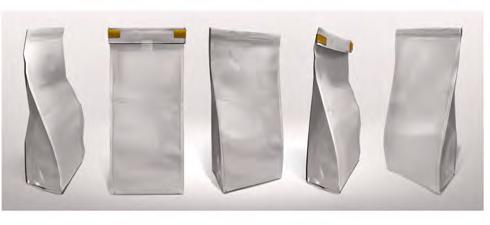
chetti poliaccoppiati flessibili con capacità tra i 250 g fino ai 3 kg, questi ultimi destinati all’horeca;
• l’8% è imputabile ai barattoli di acciaio, con capacità analoghe a quelle dei contenitori poliaccoppiati;
• il 7,6%, in crescita, è rappresentato dal caffè monoporzione confezionato in capsule di alluminio o cialde realizzate in plastica oppure in carta.
• il restante 1,4%, principalmente caffè solubile, viene confezionato in prevalenza in sacchetti di carta (1%), in vasetti di vetro (0,3%) o in astucci di cartoncino (0,1%).
Nell’ambito del caffè mono porzionato continua il dominio delle capsule rispetto alle cialde, anche se ultimamente si sta andando verso un rilancio di queste ultime in considerazione di un packaging più sostenibile.
Proprio per queste motivazioni diversi produttori più lungimiranti e sensibili alle richieste e tendenze dei consumatori, hanno cominciato a produrre capsule compostabili, più semplici da riciclare non dovendo separare l’imballaggio dal residuo di prodotto dopo l’utilizzo.
Analizzando infine i dati relativi al solo settore Bar e ristorazione, il mix del packaging si suddivide tra imballaggi flessibili poliaccoppiati (86,2%), sacco in carta (5%) e latta in acciaio (8,8%). Tutte le confezioni hanno oltre 1 kg di capacità.
Packaging di tè e infusi
Il mix del packaging relativo va distinto, a seconda che si parli del prodotto destinato all’infusione oppure se ad essere analizzato è il settore della bevanda confezionata.
Prodotti da infusione. In questo caso si parla di confezionamento in singole bustine oppure di prodotto sfuso.
Le singole bustine sono raccolte in scatole in
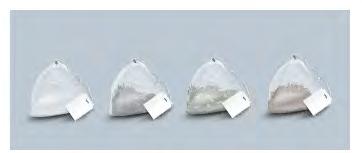

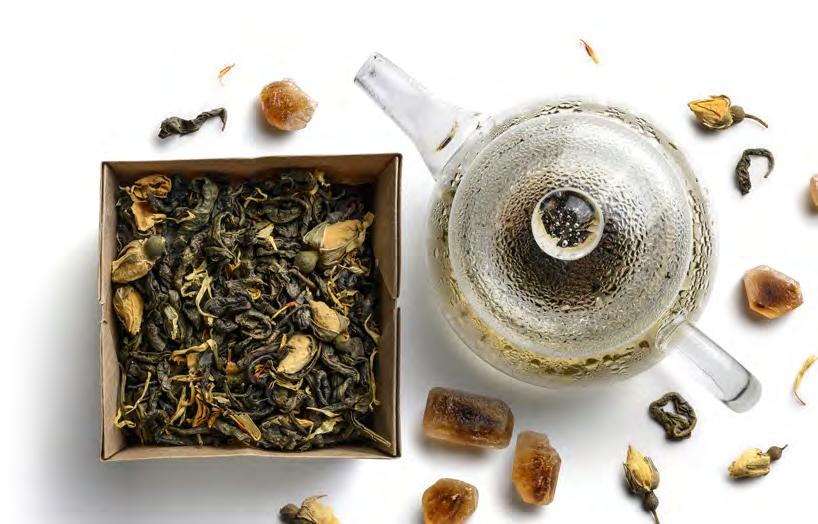


Tabella 5. Mix del packaging bevanda tè (valori % riferite alle quantità di prodotto confezionato, 2024).
Table 5. Tea beverage packaging mix
(% of packaged product volumes, 2024)
Bottiglia PET 70,7% PET bottle
Bicchierino PS 17,0% PS shot glasses
Lattina Alluminio 6,4% Aluminium can Brick 3,0% Brick
Cheerpack 2,4% Cheerpack
Bottiglia vetro 0,5% Glass bottle
Fonte/Source: Banca Dati Istituto Italiano Imballaggio su dati Istat
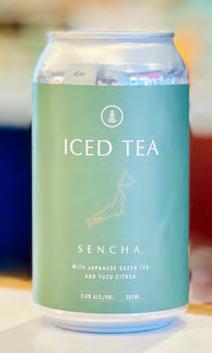
cartoncino, una media di 20 bustine da 2 gr per ogni scatola, mentre per il prodotto sfuso circa il 75% è confezionato in scatole in cartoncino e il 25%, in barattoli di acciaio.
Merita un approfondimento il discorso delle bustine da infusione. Ormai da diversi anni anche in questo settore il driver principale per il confezionamento è la sostenibilità ambientale, tanto che sono sempre di più i filtri completamente riciclabili privi di componenti in plastica. I prodotti sono per la maggior parte in carte filtro a base di cellulosa; per gli infusi più pregiati vengono spesso utilizzate anche fibre di cotone o seta, racchiusi poi in buste termosaldate che mantengono le proprietà organolettiche del prodotto e che possono essere smaltite nella carta e nell’umido. (Tabella 5).


Le bibite. Per il tè freddo come bibita pronta per essere consumata, il confezionamento si suddivide nel seguente modo:
• la bottiglia in PET risulta essere la tipologia più diffusa (70,7% del mercato), in formati che vanno dai 50 cl al litro e mezzo;
• il bicchierino in PS da 20 cl è al 17%, seguito dalla lattina in alluminio da 33 cl con il 6,4%;
• seguono il contenitore accoppiato rigido a prevalenza carta (3%) e il cheerpack (2,4%), che negli ultimi 5 anni sta pian piano erodendo quote di mercato sia al bicchierino in PS che al brick (questi ultimi due imballi hanno capacità equivalente al bicchierino in PS);
• la bottiglietta di vetro da 50 cl (0,5%) risulta in crescita, a conferma di quanto già analizzato negli anni passati.
Nel 2023 sono state circa 26.500 le tonnellate di imballaggi utilizzate per confezionare la bevanda tè.
Barbara Iascone
Istituto Italiano Imballaggio
Classified among non-alcoholic beverages, the coffee, tea, herbal tea and infusion segments are in “good health”. Market dynamics in Italy and packaging formats.
Whether enjoyed hot or cold, coffee, tea, herbal teas and infusions continue to grow in popularity year after year. These non-alcoholic beverages have become a daily ritual for nearly all Italians.
And while coffee remains the most widely consumed beverage, teas, herbal teas and infusions - often associated with a healthy and balanced lifestyle - are steadily gaining popularity.
Market dynamics by sector
Although these product categories share many common features, each has its own distinctive characteristics. For this reason, they are analysed separately, also in terms of packaging.
Coffee
Italy is recognised as one of the world’s leading players in the processing and production of coffee. In the Italian context, this begins with the roasting and grinding of imported green (unroasted) coffee beans. A defining feature of Italian coffee production is the expert blending of beans sourced from different geographical areas. As a result, domestic processing is exclusively based on imported coffee, from which production volumes, exports and consumption are derived.
According to the most recent data available, in 2023 approximately 1,000 companies operate within this industry, employing around 7,000 people directly. The industry generated a turnover of approximately €4.8 billion, with exports accounting for 48% of that figure.
Production and consumption. Preliminary estimates for 2024 indicate a slight decline in the sector, with turnover down by 0.5% and production volumes decreasing by 1.6%.
The production of roasted coffee in Italy is expected to reach approximately 501,000 tonnes, nearly 60% of which is destined for export.
Roasted coffee exports continued to grow in 2024, both in terms of value and volume: turnover was up by 8.8%, and quantities exported have increased by 1.4%.
With exports accounting for around 38% of national production, Italy exported 296,000 tonnes of roasted coffee, generating approximately €2.2 billion in turnover. Analysing the export figures, the main export destinations are, as in previous years, Germany France and the United States.
Imports are also rising. In 2024, green coffee imports are expected to increase by 27% in value and 1.5% in volume.
According to ISTAT data, over 96% of imported coffee consists of green beans sourced from various coffee-producing countries and this forms the basis for domestic processing. More than half of Italy’s green coffee imports come from just two coffee-producing countries: Brazil (mainly Arabica) and Vietnam (primarily Robusta). The remaining imports consist of roasted coffee, mainly soluble varieties and ground coffee in capsules, originating mostly from Swiss factories of the NestléNespresso group.
To ensure accurate interpretation of the data, especially when analysing quantities by weight, a few key factors must be taken into account. Firstly, roasted and ground coffee weighs approximately 20% less than green coffee beans. This means that 371,000 tonnes of imported green beans are equivalent to around 296,800 tonnes of roasted coffee. Secondly, of this roasted coffee, about 84% is used for beverage preparation, whether for home or
out-of-home consumption. The remaining 16% is used in industrial applications, such as the production of ice cream, yoghurt, soft drinks, desserts, and similar products.
Based on these calculations, the volume of packaged coffee consumed in Italy in 2023 was approximately 249,310 tonnes. Driven by a wide range of retail channels and the growth of e-commerce, domestic consumption accounts for 71% of total coffee volumes, while out-ofhome consumption, supported by Ho.Re.Ca. sales, vending machines and Office Coffee Services, accounts for the remaining 29%.
In value terms, the gap between the two segments is less pronounced, as out-of-home consumption typically commands, on average, higher prices than retail.
Focusing on domestic consumption, ground coffee in its various forms, such as standard and espresso blends, remains the most popular type, accounting for 68% of the market share.
Portioned coffee in pods or capsules continues to grow steadily, now representing around 20% of total ground coffee volumes. Coffee beans make up 7.3% of the coffee consumed in Italy, while soluble coffee accounts for the remaining 4.7%.
The tea segment can be divided into two main product categories: on one side are teas, herbal teas, and infusions in sachet form; on the other, loose-leaf or soluble products that consumers prepare themselves for hot or cold beverages. In addition to these, the market also includes ready-to-drink teas, to be consumed cold or at room temperature.
It is important to note that Italy has very few tea plantations. As such, references to domestic production primarily concern the processing and packaging of imported loose-leaf tea.
Production and consumption. In 2023, total production of teas, infusions and herbal teas amounted to 20,158 tonnes, according to the latest available ISTAT datarepresenting a 6% decrease compared to 2022.
In 2024, the sector recorded a further 1.5% decline in production volumes. However, both imports and exports showed positive growth trends. This is particularly significant, as the majority of tea packaged in Italy comes from abroad.
In 2024, Italian production is expected to reach around 1,470 tonnes, compared to approximately 3,420 tonnes of bulk tea imports, which represent an 11.2% increase. This rise in imports led to a 7% increase in the availability of packaged products in Italy. Looking at the balance between packaged exports and imports, apparent consumption has grown by 4.7%. Confirming the growth in apparent consumption - which, it should be noted, does not factor in stock variations - is the Adnkronos “Età senza età” (“Ageless Age”) survey. This survey reveals that consumption of teas, infusions and herbal teas has increased by more than 20% in recent years, particularly among individuals aged 51 and over.
When analysing the tea market, it is also important to consider the cold beverage segment, which is often chosen as an alternative to other drinks, such as still or sparkling soft drinks and fruit juices.
In Italy, iced tea ranks as the most popular cold beverage after cola, with per capita consumption exceeding more than nine litres per year, one of the highest levels in Europe.
Alongside traditional fruity flavours, other varieties have also gained a solid foothold in the market, including green tea, which now accounts for around 10% of the total volume, and decaffeinated tea, which is mainly targeted at younger consumers.
In recent years, the consumption of tea mixed with fruit-based drinks has become increasingly widespread. According to data from the Italian Packaging Institute, consumption of these beverages in 2024 reached approximately 577 million litres, marking a 1% decline, mainly attributed to the overall decline in the beverage sector.
Leading brands in this category include Ferrero, with its Estathé range, and Nestle, with its latest addition, Fustea.
In 2024, approximately 27,965 tonnes of packaging are expected to be used in the coffee sector.
This figure includes packaging for both the Ho.Re.Ca sector (hotels, cafés and restaurants) and in-home consumption (including capsules used at home and in the office).
When discussing packaging, it is important to distinguish between coffee intended for domestic consumption and coffee for the Ho.Re.Ca. sector.
The types of packaging used for coffee are as follows:
- 83% of the product is packaged in flexible polybags, with capacities ranging from 250 g to 3 kg - the larger formats primarily serving the Ho.Re.Ca sector;
- 8% is packaged in steel tins, with similar capacities to those of polybags;
- 7.6%, and steadily increasing, is single-dose packaging consisting of aluminium capsules or pods made of plastic or paper;
- the remaining 1.4%, mainly used for soluble coffee, is packaged in paper bags (1%), glass jars (0.3%) or cardboard boxes (0.1%).
In the single-dose coffee segment, capsules continue to dominate over pods. However, recent years have seen a resurgence in pod use, driven by growing interest in more sustainable packaging solutions.
For these reasons, several forward-looking manufacturers, sensitive to consumer demands and trends, have begun producing compostable capsules. These are easier to recycle as they eliminate the need to separate the packaging from the coffee grounds after use.
Lastly, focusing on the café and restaurant sector specifically, the packaging mix is divided into flexible polybags (86.2%), steel tins (8.8%) and paper bags (5%). All packages have capacities exceeding 1 kg.
The packaging mix for teas and herbal teas varies depending on whether the product is intended for infusion or belongs to the ready-to-drink beverage category.
Infusion products. For infusion products, packaging is typically in the form of individual sachets or loose-leaf formats.
Individual sachets are usually packed in cardboard boxes, with an average of 20 sachets per box, each weighing approximately 2 grams. By contrast, about 75% of loose-leaf products are packaged in cardboard boxes and 25% in steel tins.
The topic of infusion sachets deserves special attention. In recent years, environmental sustainability has become a key driver in packaging innovation within this segment. As a result, fully recyclable filters free of plastic components are becoming increasingly widespread. Most sachets are made using cellulosebased filter papers. For premium infusions, cotton or silk fibres are also used, which are then enclosed in heat-sealed pouches that help preserve the product’s organoleptic properties while allowing for easy disposal in paper and organic waste streams.
Ready-to-drink beverages. When it comes to ready-to-drink iced tea, packaging formats can be broken down as follows:
- PET bottles dominate the market with a 70.7% share, commonly available in sizes ranging from 50 cl to 1.5 litres;
- polystyrene (PS) cups in 20 cl format account for 17% of the market, followed by aluminium cans (33 cl) with a 6.4% share;
- rigid paper-based composite containers represent 3%, while cheerpacks (flexible pouches) account for 2.4%. Over the past five years, cheerpacks have gradually gained popularity, eroding market share from both PS cups and cartons, which typically have the same 20 cl capacity;
- 50 cl glass bottles currently hold a small share of 0.5%, but this format is showing growth, confirming trends identified in previous years.
In 2023, approximately 26,500 tonnes of packaging were used for tea products.
Barbara Iascone Italian Packaging Institute

Il settore del beverage italiano sta vivendo una fase di trasformazione strutturale. Analisi economica, osservazione
dei trend sociali e rilevazione dei dati ambientali saranno cruciali per tracciarne e comprenderne l’evoluzione.
Questa analisi prende in esame l’intero comparto delle bevande alcoliche e analcoliche in Italia, includendo i prodotti di origine nazionale, importati, esportati e consumati sul territorio. In particolare, per il consumo interno si considerano i volumi distribuiti attraverso i principali canali commerciali: grande distribuzione organizzata (GDO), Ho.Re.Ca., vendite online e altri canali alternativi.
Quadro generale del settore
Nel 2024 il settore beverage in Italia ha registrato una crescita a valore del +2,5%, segnalando un orientamento del consumatore verso la qualità piuttosto che verso l’incremento delle quantità consumate.
La crescita in termini di volumi fisici si è fermata a +0,5%, confermando una tendenza già in atto negli anni precedenti: maggiore selettività nei consumi, con preferenza per prodotti di fascia media e alta.
Il canale fuori casa (Ho.Re.Ca.) si è rivelato il più dinamico, con una crescita a valore del +4,5% e un incremento nei volumi pari a +0,5%. Tuttavia, si segnala una pressione crescente sui margini, dovuta all’aumento dei costi di produzione: energia, trasporti, materie prime e logistica, fattori che impattano direttamente sull’equilibrio economico delle imprese.
Andamento dei volumi
A fine 2024, il mercato delle bevande in Italia ha superato i 27,7 miliardi di litri, con un incremento modesto dello 0,5% rispetto al 2023. La produ-
zione nazionale è stata sostenuta in particolare dalla domanda interna, in crescita del +1,6%, che ha portato i volumi a oltre 24,1 miliardi di litri.
Le importazioni sono cresciute in modo significativo (+17%), ma restano comunque marginali rispetto al totale. Di contro, le esportazioni hanno registrato una lieve flessione (-0,5%) e si attestano attorno ai 5 miliardi di litri. Nota metodologica: il dato sui consumi non include i movimenti di magazzino, un fattore particolarmente significativo, soprattutto nel comparto alcolico, dove le scorte hanno un ruolo gestionale rilevante.
Segmentazione di mercato
Analcolici. Le bevande analcoliche costituiscono il 76,4% del mercato totale, trainando l’intero comparto. Nel 2024 registrano una crescita dei volumi pari al +1,2%, la produzione supera i 21,1 miliardi di litri. L’export risulta in calo del -4% e l’import si mostra in forte aumento (+43%), ma ancora su volumi assoluti limitati Nell’ambito delle bevande analcoliche, l’acqua minerale è la protagonista assoluta, con una rappresentatività pari al 79% del segmento e una crescita della produzione del +2% rispetto al 2023. L’export è salito del +3,2%, con gli USA come principale mercato estero (33% di share).
Tuttavia, la diffusione di sistemi alternativi (acqua microfiltrata, osmotizzata) nel canale
Ho.Re.Ca. rappresenta una minaccia strutturale per la categoria.
Altri sottosegmenti sono i soft drink gasati con il 12% e i succhi di frutta e bibite piatte per il restante 9%.
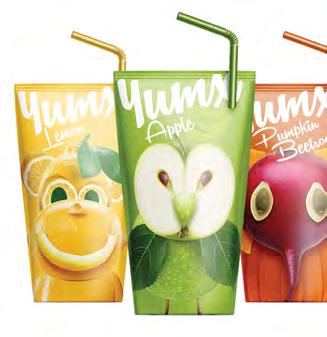


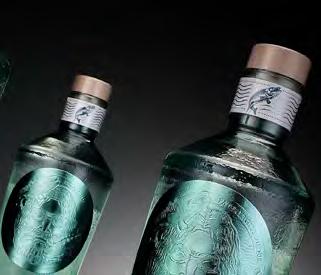
Alcolici. Le bevande alcoliche rappresentano il 23,6% del settore, ma nel 2024 hanno registrato una contrazione nella produzione del -1,7% e una riduzione della domanda interna pari al -1,4%, a fronte di una lieve crescita dell’export pari al +2%. Il segmento si compone per il 67% da vini e spumanti che registrano un produzione in calo del -3,8%; segue la birra con il 26%, la cui produzione registra un rimbalzo positivo del +3,3%. Infine abbiamo infine gli spirits con il 6,6% e il vermouth con lo 0,4%.
Da un punto di vista macroeconomico, la stagnazione interna è imputabile sia alla contrazione del potere d’acquisto reale, sia alla dematerializzazione del consumo (meno alcol tra i giovani, attenzione alla salute, etc.).
La flessione nella produzione e nei consumi di vino è da mettere in relazione ai cambiamenti demografici (invecchiamento popolazione) e culturali (riduzione del consumo di alcol tra i giovani). Il mercato della birra mostra segnali di resilienza grazie all’innovazione nel segmento craft e low-alcohol. (Tabelle 1, 2 e 3).
Il confezionamento: tipologie e settori di sbocco
Nel 2024 sono state oltre 4.000.000 le tonnellate di imballaggi primari utilizzati nel settore bevande. Nell’insieme, il 59% del confezionamento risulta essere in plastica (bottiglie), seguito da un 30,8% di confezionamento in vetro (sia rendere che perdere). La voce altri imballaggi (cheerpack, erogatori alla spina e bicchierini) rappresentano il 4,7% di share, seguita dai contenitori rigidi accoppiati a prevalenza carta con un 3,2%. Chiudono la segmentazione le lattine per bevande. (Tabella 4)
Packaging delle bevande analcoliche
Le bottiglie in plastica trovano il loro massimo impiego nell’ambito delle bevande analcoliche: nel 2024 questa tipologia ha raggiunto il 77,9% di share arrivando a superare le 380.000 tonnellate. Specialmente per il confezionamento dell’acqua minerale risulta sempre più diffuso il ricorso alle plastiche provenienti da riciclo.
In questo ambito, il confezionamento in vetro è meno diffuso: utilizzato in prevalenza dal mondo
Tabella 1. Bilancio globale del settore bevande (valori mln litri).
Table 1. Global balance of the beverage sector (values million litres).
Banca Dati Istituto Italiano Imballaggio
Tabella 2. Bilancio del settore bevande analcoliche (valori mln litri).
Table 2. Balance sheet of the non-alcoholic beverage sector (values in million litres).
della ristorazione, negli ultimi anni ha subito la concorrenza serrata dell’acqua microfiltrata sia naturale che gassata. Nel 2024 il confezionamento in vetro ha rappresentato il 15,8% del segmento.
E se i contenitori rigidi accoppiati a prevalenza carta, utilizzati in prevalenza per confezionare succhi di frutta, occupano il 2,5% del totale, le lattine sono al 2%, diffuse nell’ambito dei soft drinks. Queste due ultime tipologie di imballaggi, in anni recenti, sono state impiegate - sebbene in misura minima - per confezionare un prodotto di nicchia come l’acqua minerale “premium”.
Chiude la segmentazione la voce “Altro”. (Tabella 5)
La bottiglia in vetro continua a essere il contenitore più utilizzato con una share di mercato pari al 77,3%: simbolo di eleganza e prestigio, non viene scalfita da altre tipologie di confezionamento. Con il 13,4% segue la voce “Altro”, all’interno della quale rientro i fustini, le damigiane e gli erogatori di bevande alla spina.
I contenitori in accoppiato a prevalenza carta rappresentano il 5,5% del mix del packaging delle bevande alcoliche, sempre meno utilizzati anche da alcuni brand del vino che si stanno convertendo al vetro.
Le lattine in metallo “pesano” sulla segmentazione per il 2,8%: la birra resta il loro segmento di sbocco privilegiato, ma stanno prendendo campo anche nell’ambito dei super alcolici, in particolare nel segmento cocktail pronti da bere.
Al confezionamento in plastica rimane lo 0,9% di share. (Tabella 6)
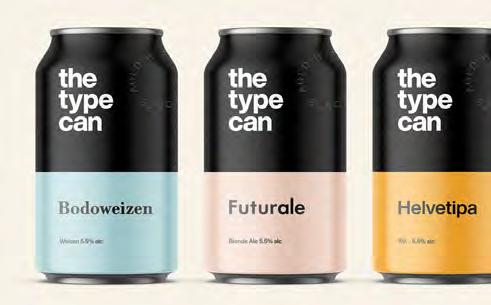
Banca Dati Istituto Italiano Imballaggio
Tabella 3. Bilancio del settore bevande alcoliche (valori mln litri).
Table 3. Balance sheet of the alcoholic beverage sector (values in million litres).
Fonte/Source: Banca Dati Istituto Italiano Imballaggio

Tabella 4. Mix del packaging nel settore bevande (valori %).
Table 4. Packaging mix in the beverage sector (% values).
2023 2024
Bottiglie vetro 30,7% 30,8% Glass bottles
Contenitori accoppiati
Mainly paper-based prev. carta 3,61% 3,24% laminated packaging
Bottiglie PET 58,74% 59,04% PET bottles
Lattine in metallo 2,12% 2,17% Metal cans
Altro (1) 4,84% 4,72% Other
(1) Cheerpack, bicchierini, distributori alla spina/ Cheerpacks, shot glasses, dispensers
Fonte/Source: Banca Dati Istituto Italiano Imballaggio
Tabella 5. Mix del packaging nel settore bevande analcoliche (valori %).
Table 5. Packaging mix in the non-alcoholic beverage sector (% values).
2023 2024
Bottiglie vetro 15,62% 15,78% Glass bottles
Contenitori accoppiati Mainly paper-based prev. carta 2,90% 2,50% laminated packaging
Bottiglie PET 77,57% 77,85% PET bottles
Lattine in metallo 1,91% 1,95% Metal cans
Altro (1) 2,00% 1,92% Other
(1) Cheerpack, bicchierini, distributori alla spina
Fonte/Source: Banca Dati Istituto Italiano Imballaggio
Tabella 6. Mix del packaging nel settore bevande alcoliche (valori %).
Table 6. Packaging mix in the beverage sector (% values).
2023 2024
Bottiglie vetro 77,01% 77,34% Glass bottles
Contenitori accoppiati Mainly paper-based prev. carta 5,79% 5,54% laminated packaging
Bottiglie PET 0,88% 0,88% PET bottles
Lattine in metallo 2,77% 2,85% Metal cans
Altro (1) 13,54% 13,39% Other
(1) Cheerpack, bicchierini, distributori alla spina/ Cheerpacks, shot glasses, dispensers
Fonte/Source: Banca Dati Istituto Italiano Imballaggio
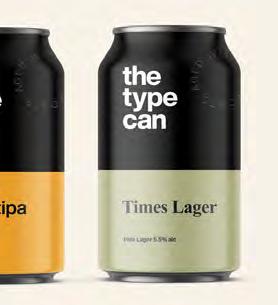

Complementi di imballaggio
L’analisi dei numeri riferiti al confezionamento delle bevande si amplia con l’inserimento dei dati relativi ad accessori nonché agli imballaggi secondari e da trasporto.
Chiusure. Le chiusure utilizzate nel comparto beverage si suddividono tra plastica, metallo (acciaio e alluminio) e sughero.
Su oltre 45.000 tonnellate di chiusure, il 52% è rappresentato da quelle in plastica (compresi i tappi sintetici per il vino), il 32% da quelle in acciaio (tappi a corona utilizzati sia per le birre che i soft drinks nonché capsule a vite impiegate nelle bottiglie in vetro dei succhi di frutta).
I tappi in sughero rappresentano il 13% di share, mentre le chiusure in alluminio il 3% (si consideri però che sono molto più leggere rispetto alle altre) e risultano sempre più diffuse anche nel settore dei soft drinks.
Accessori. La parte relativa agli accessori si compone anche delle etichette: per il 67% sono di carta - si pensi a tutto il mondo delle bevande alcoliche - e per il 33% sono di plastica, impiegate in prevalenza nel segmento bevande analcoliche.

Secondari e trasporto. Ultimo tassello nell’analisi del packaging impiegato nel settore bevande è quello relativo agli imballaggi secondari e da trasporto.
Sono circa 110.000 le tonnellate di scatole in cartoncino utilizzate nel confezionamento secondario e circa 420.000 le tonnellate di cartone ondulato impiegato per il trasporto di tutte le tipologie di bevande, dove circa l’80% del cartone ondulato in questione viene adottato da vini e spumanti.
Prospettive e tendenze 2025
Secondo i primi dati previsionali per il 2025, si consolida la tendenza a:
• formati ridotti e maneggevoli da trasportare;
• materiali sostenibili (plastica riciclata, vetro riutilizzabile);
• differenziazione estetica del packaging per rafforzare il branding.
Nel segmento premium, tuttavia, prevale ancora l’utilizzo di materiali pesanti e di pregio, a discapito della leggerezza e riciclabilità. L’alta gamma risponde a logiche diverse, dove l’estetica e il posizionamento hanno ancora la precedenza sulla sostenibilità economica o ambientale.
In conclusione
Il settore del beverage italiano si trova in una fase di trasformazione strutturale: tra crescita selettiva, razionalizzazione dei consumi e innovazione sostenibile, la competitività futura dipenderà dalla capacità di:
• presidiare mercati esteri strategici (USA, Asia);
• adattarsi alla nuova domanda interna (formati smart, salutismo);
• contenere i costi di produzione senza ridurre la qualità;
• investire in packaging intelligenti, circolari e distintivi.
L’integrazione tra analisi economica, osservazione dei trend sociali e dati ambientali sarà sempre più cruciale per anticipare le dinamiche di un settore in evoluzione.
Barbara Iascone
Istituto Italiano Imballaggio
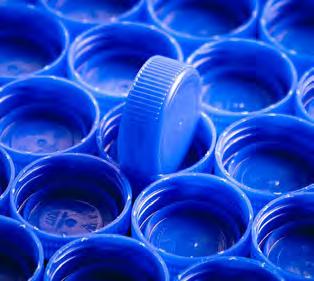
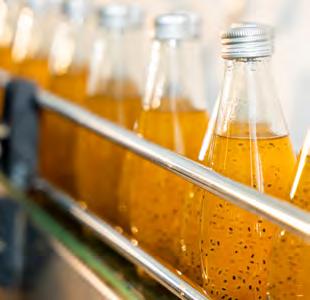
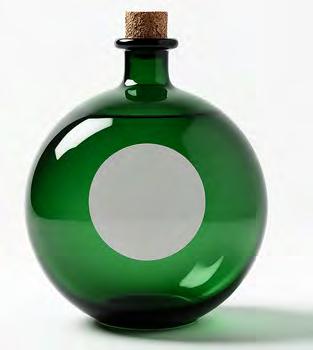
The Italian beverage sector is undergoing a phase of structural transformation. Economic indicators, social trends and environmental data will all play a crucial role in monitoring and understanding its evolution.
This analysis provides an overview of the entire alcoholic and non-alcoholic beverage industry in Italy, including products of domestic origin and those imported, exported and consumed within the country.
Particular attention is given to domestic consumption, taking into account the volumes distributed through the main sales channels: large-scale retail trade (GDO), Ho.Re.Ca., e-commerce and other alternative channels.
Sector overview
In 2024, the Italian beverage sector recorded a value growth of 2.5%, reflecting a continued shift in consumer behaviour towards quality over quantity.
The growth in terms of physical volumes remained modest at +0.5%, reinforcing a trend observed in recent years: more selective consumption patterns, with a preference for medium- to high-end products.
The out-of-home (Ho.Re.Ca.) channel was the most dynamic, showing a 4.5% increase in value and a 0.5% increase in volume. Despite this positive performance, the sector faces mounting pressure on profit margins due to rising production costs, including energy, transport, raw materials and logistics, which continue to weigh heavily on the economic sustainability of companies.
Volume trends
By the end of 2024, the Italian beverage market surpassed 27.7 billion litres, marking a modest increase of 0.5% compared to 2023. Domestic production was mainly supported by domestic demand, which rose by 1.6%, bringing total production volumes to over 24.1 billion litres.
Imports also saw a significant increase (+17%), although they continue to represent only a small portion of the total. Conversely, exports decreased slightly (-0.5%), settling at around 5 billion litres.
Methodological note: the consumption figures do not account for stock movements - a particularly relevant factor in the alcoholic beverage sector, where inventory management plays a crucial role.
Market segmentation
Non-alcoholic beverages Soft drinks account for 76.4% of the total market, driving the entire sector. In 2024, this segment is expected to see volumes grow by 1.2%, with production exceeding 21.1 billion litres. Exports decreased by 4%, while imports saw a sharp rise of 43%. However, imported volumes remain relatively low in absolute terms.
Within the non-alcoholic segment, mineral
water continues to dominate, representing 79% of the segment. Production increased by 2% compared to 2023. Exports also performed well, increasing by 3.2%, with the United States as the leading foreign market, accounting for 33% of total production.
Nevertheless, the rising adoption of alternative systems, such as microfiltered and reverse osmosis water in the Ho.Re.Ca. sector poses a structural threat to the mineral water segment.
Other key sub-segments include carbonated soft drinks, which make up 12% of the market, and fruit juices and still drinks, which account for the remaining 9%.
Alcoholic beverages Alcoholic beverages accounted for 23.6% of the overall beverage sector in 2024. However, the segment experienced a decline in production (-1.7%) and a drop in domestic demand (-1.4%), while exports showed a modest increase of 2%.
Wines and sparkling wines represent the largest share of the segment at 67%, but their production fell by 3.8%. Beer follows with a 26% share, recording a positive rebound in production of +3.3%. Spirits account for 6.6% of the segment, while vermouth represents a marginal 0.4%.
From a macroeconomic perspective, domestic stagnation can be attributed to both the decline in real purchasing power and evolving consumption habitsincluding reduced alcohol intake among younger consumers and a broader focus on health and wellness.
The decline in wine production and consumption is linked to demographic changes (ageing population) and cultural changes (reduced alcohol consumption among younger people). The beer segment has shown resilience, supported by innovation in the craft and low-alcohol beverage segments.
Packaging: types and sectors
In 2024, the Italian beverage sector used over 4 million tonnes of primary packaging. Overall, plastic packaging (bottles) accounted for the largest share, making up 59% of the total. Glass packaging (both returnable and non-returnable), followed with a 30.8% share. Other packaging formats, including cheerpacks, draught dispensers and cups, represented 4.7% of total packaging, while rigid paper-laminated containers accounted for 3.2%. Beverage cans made up the smallest share, closing the segment.
Packaging of non-alcoholic beverages
Plastic bottles are most widely used in the packaging of non-alcoholic beverages. In 2024, they accounted for 77.9% of packaging in this segment, arriving at over
380,000 tonnes. The use of recycled plastics, particularly for the packaging of mineral water, is becoming increasingly common.
Glass packaging, while less prevalent, remains primarily used in the food service industry. However, it has faced strong competition in recent years from microfiltered water, both still and sparkling. In 2024, glass packaging accounted for 15.8% of the segment.
Rigid paper-laminated containers, used predominantly for fruit juices, made up 2.5% of the total, while cans accounted for 2%, commonly used for soft drinks.
In recent years, both formats have also been used, albeit marginally, for niche products such as “premium” mineral water. The remaining packaging types are grouped under the “Other” item.
Packaging of alcoholic beverages
Glass bottles continue to be the most widely used packaging format for alcoholic beverages, holding a 77.3% market share. A symbol of elegance and prestige, glass continues to outperform alternative types of packaging in this segment. This is followed by the “Other” item, which accounts for 13.4% and includes kegs, demijohns and draught beverage dispensers.
Paper-based laminated containers account for 5.5% of the alcoholic beverage packaging mix, but their use is steadily declining, even among some wine producers, who are increasingly reverting to glass packaging.
Metal cans represent 2.8% of the segment. While beer remains their primary segment of application, they are increasingly being adopted in the premium spirits segment, particularly for ready-to-drink cocktails. Plastic packaging holds a marginal share of just 0.9%.
Packaging accessories
The analysis of the beverage packaging figures is further enriched by considering accessories, as well as secondary and transport packaging.
Closures Closures used in the beverage industry generally fall into three main types: plastic, metal (steel and aluminium) and cork.
Of the more than 45,000 tonnes of closures used: 52% are plastic, including synthetic corks used in wine bottles; steel closures account for 32% and include primarily crown caps used for beer and soft drinks, as well as screw caps commonly found on glass juice bottles; cork closures account for 13%; aluminium closures make up 3% of the total (despite
their smaller share by weight due to their lower density) and are becoming increasingly common in the soft drinks segment.
Accessories Labels represent a key component of beverage packaging accessories. Approximately 67% of labels are made of paper, widely used across the alcoholic beverage segment, while the remaining 33% are plastic, mainly used for soft drinks.
Secondary and Transport packaging
The final element in the beverage packaging analysis concerns secondary and transport packaging.
An estimated 110,000 tonnes of cardboard boxes are used for secondary packaging. For transport purposes, approximately 420,000 tonnes of corrugated cardboard are used across all beverage categories, with around 80% of this volume used specifically for wines and sparkling wines.
Outlook and Trends for 2025
Preliminary forecasts for 2025 highlight several key trends in beverage packaging: a shift towards smaller, more portable formats; growing preference for sustainable materials, such as recycled plastic and reusable glass;
• increased focus on aesthetic differentiation of packaging to enhance brand identity. In the premium segment, however, the use of heavy, high-end materials continues to dominate, often at the expense of lightness and recyclability. High-end materials respond to a different logic, where design and brand positioning remain the priority, outweighing considerations of costeffectiveness or environmental sustainability.
The Italian beverage sector is undergoing a structural transformation. Marked by selective growth, more conscious consumption and sustainable innovation, its future competitiveness will depend on the sector’s ability to:
• strengthen its presence in strategic foreign markets, such as the USA and Asia;
• adapt to shifting domestic demand, with a focus on smart, convenient and health-oriented formats;
• control production costs without compromising quality; invest in intelligent, circular and distinctive packaging solutions.
The integration of economic analysis, observation of social trends and environmental data will be increasingly crucial for anticipating the dynamics of this evolving sector.
Barbara Iascone Italian Packaging Institute
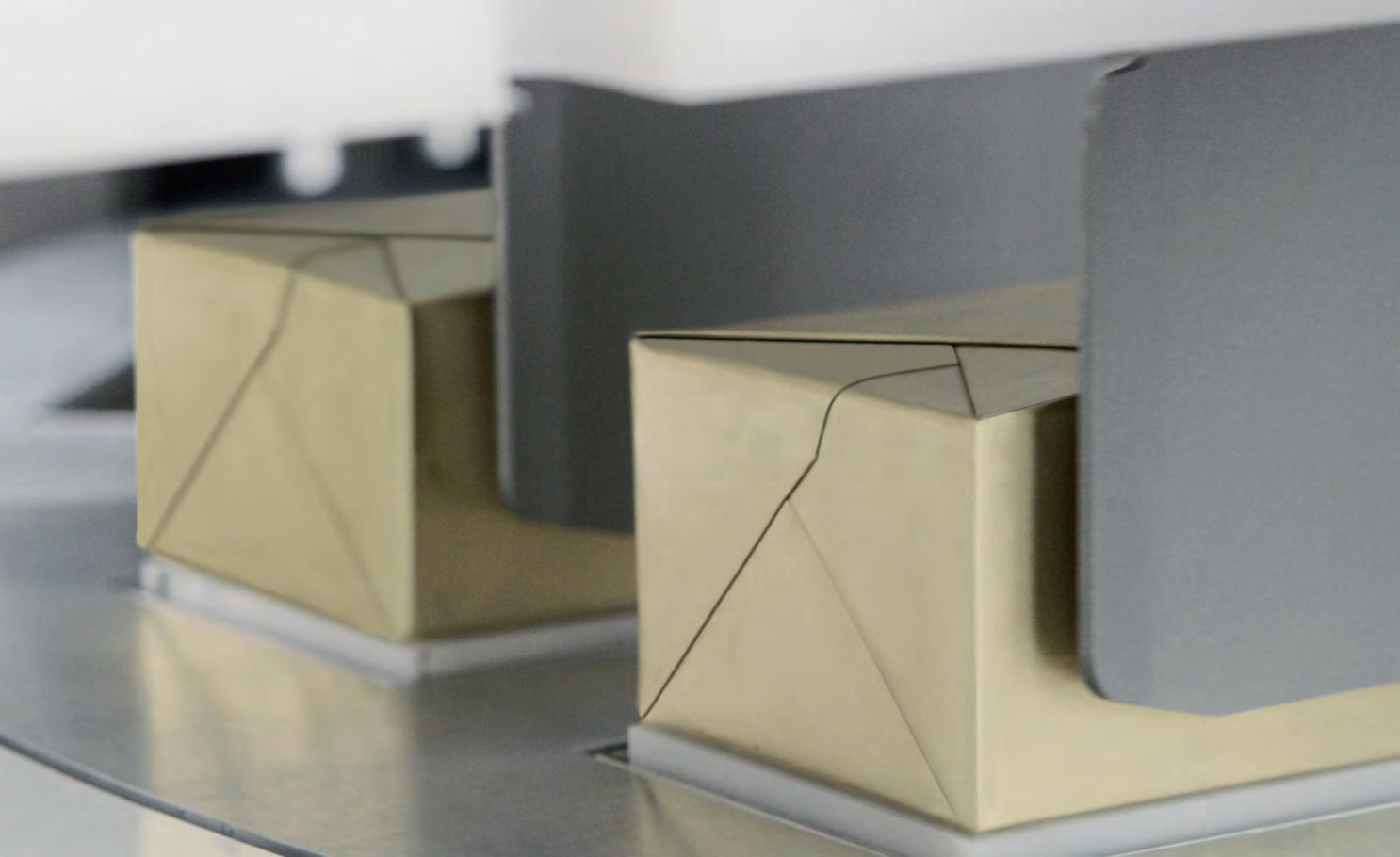




Packaging solutions for food, beverage, dairy products, and dairy alternatives.
IMA serves the international dairy and dairy alternative industries with the best platforms and machines, consistently providing tailored technologies for the packaging of cheese, butter, margarine, dressings & sauces, sweet spreads, yoghurt, desserts, UHT milk and more.
From stand-alone machines to fully-integrated solutions, our advanced technologies and expert consultancy ensure tailored support for every need, from primary to end of line packaging solutions.
Make the most.


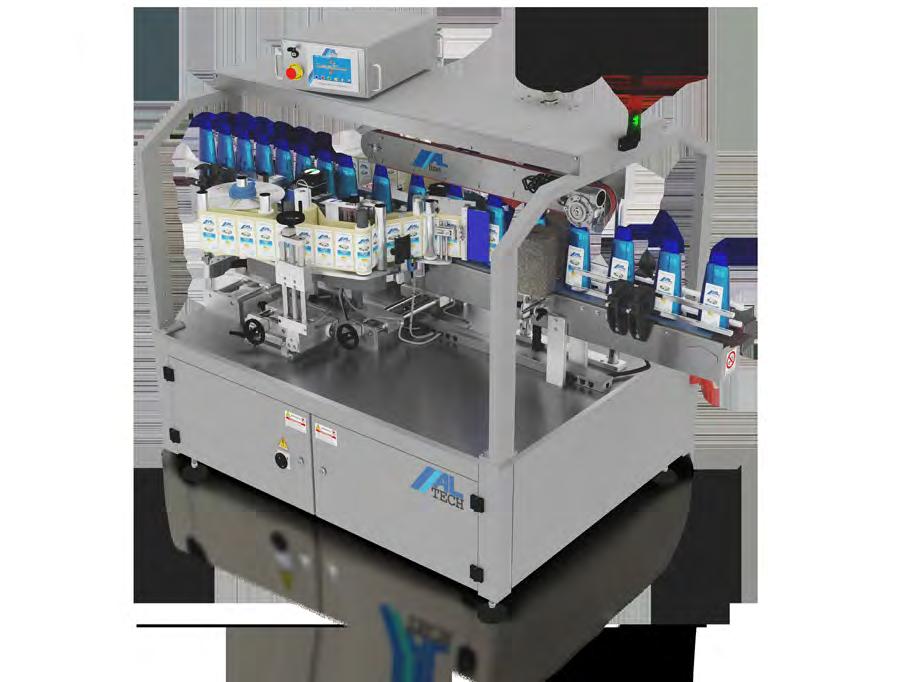
ALline E - Sistema lineare per applicazione di due etichette fronte/retro su prodotti rettangolari o ellittici.
• Gestione integrata tramite PLC, con industry 4.0, e assistenza remota.
• Interfaccia touch screen su pannello girevole, con memoria per 100 ricette di etichettatura.
• Convogliatore modulare silenzioso e sincronizzazione automatica.
• Posizionatori digitali su tutti i volantini di regolazione, con valori in ricetta consultabili da pannello comandi.
• Basamento perimetrale, con struttura di irrigidimento superiore e illuminazione interna.

Innovazione o conservazione? La direzione di queste filosofie appare opposta e inconciliabile. La prima promette prestazioni superiori, e nuove funzionalità. La seconda garantisce l’affidabilità e la praticità tipica delle soluzioni collaudate.
Noi di ALtech ci siamo impegnati affinchè innovazione e conservazione convivano nelle nostre etichettatrici. Ognuna di esse contiene le tecnologie più innovative, ma allo stesso tempo è il risultato degli affinamenti progettuali maturati grazie ai 30.000 collaudi effettuati fino ad oggi: un bagaglio tecnico che ci consente di affermare che ogni etichettatrice che offriamo non è solo all’avanguardia, ma è anche pratica, funzionale e affidabile.
Un esempio? il nostro sistema ALline E.
ALTECH Srl
Viale de Gasperi, 70 20008 Bareggio (MI) - Italy Tel. +39 02 90363464 info@altech.it www.altech.it


Dopo tre generazioni e 100 anni di storia, Loacker è una multinazionale
globale che non ha dimenticato le sue radici basate su valori espressi nella marca, nel packaging e nella qualità del prodotto. Per saperne di più, ItaliaImballaggio ha incontrato Andrea Canale, Art Director e Head of graphic Arts nel global marketing di Loacker.
el 1925, un pasticcere altoatesino, Alfons Loacker, appassionato di calcio, scelse di specializzarsi nella produzione di wafer perché rispetto ad altre specialità, era possibile gestirne la produzione tenendo liberi i week end per potersi dedicare alla sua squadra. Ed è lo spirito di squadra a creare una prima rete di vendita, quando lo stesso Alfons propose a compagni e tifosi, di fare richiesta dei suoi biscotti nei bar di Bolzano, prima sede aziendale. Nel 1958, con l’ingresso della seconda generazione, sono Armin e Christine Loacker i depositari di quello che è ormai un marchio di fabbrica: la friabilità della cialda unita al gusto inconfondibile delle creme ottenute anche grazie alla qualità della materia prima. Ed è dal bisogno di preservare queste caratteristiche che nasce l’idea di spostare l’azienda a 1000 m di altitudine, sull’altopiano del Renon, dove meno umidità favorisce la produzione di wafer dalla proverbiale friabilità, segno distintivo di un prodotto distribuito in 120 paesi nel mondo.
Parliamo di nuovi trend e in particolare dello smart packaging, capace di dialogare con consumatore e prodotto.
“Secondo la nostra visione, lo smart packaging è molto legato alle sensibilità dei singoli paesi”. Esordisce Andrea Canale “Penso all’ampio uso dei codici QR in Cina rispetto all’Europa. Uno strumento che permette la comunicazione multi-target su canali diversi: B2B al B2C. Cina, Arabia Saudita, sono solo due dei tanti mercati per cui stiamo pensando di creare cluster con packaging specifici che rispondano ai vincoli regolatori regionali. In Loacker, lavoriamo in due direzioni. Da un lato il packaging è un asset di comunicazione fondamentale: pensiamo alla N
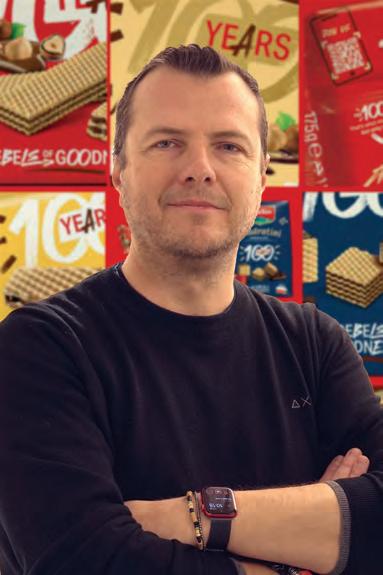
campagna legata alle “scelte buone”. Il concetto di bontà si associa agli ingredienti, al gusto e alle politiche di sostenibilità con l’obiettivo di consolidare il percorso attivato per diventare BCorp entro il 2027. In questo percorso i QR sono protagonisti anche come veicoli di informazione e tracciabilità, tema al centro dell’attenzione degli enti di certificazione. Pensiamo alla GS1, con cui stiamo collaborando per definire i termini di cosa si possa veicolare al mercato usando QR a più livelli, in modo da garantire tracciabilità sia per i buyer che per il consumatore a cui dedichiamo anche contenuti extra”.
Interattività significa quindi da una parte controllo della tracciabilità, dall’altro dialogo con il consumatore?
“Nel retro del nostro pack si trova ora la voce “scopri i nostri percorsi di sostenibilità” che porta a una landing page a tema”. Prosegue ancora Canale “Quest’anno, per celebrare i 100 anni, abbiamo inserito il claim “ribelli ma buoni” che lega il tradizionale “Loacker che bontà” a concetti etici che vanno oltre gusto e qualità. Quello che deve emergere è che per noi bontà significa un insieme di azioni che coinvolgono tutta la vita in azienda, ma è anche una bonaria presa in giro di noi altoatesini, percepiti come rigidi, ma al contempo cultori della qualità. L’obiettivo è attribuire al brand un proprio carattere legato al territorio di origine. Non sono solo logo e codici colore a definirci, ma anche i valori che veicoliamo attraverso la nostra qualità intrinseca, di cui il packaging è una componente. Partito come carta, evoluto in stagnola, ha seguito un percorso che riflette i canoni di modernità a cui aderiamo mantenendo una forte continuità con i nostri valori tradizionali. Contenuto e valori coincidono anche sul packaging dove alle informazioni nutrizionali si aggiunge una forte identità di marca. Come dice il nostro presidente, Ulrich Zuenelli, siamo alla ricerca “del perfetto equilibrio tra integrazione verticale e differenziazione orizzontale”. Verticalmente, quindi a scaffale, Loacker deve essere ben visibile anche a distanza; avvicinandosi, il cliente deve cogliere la varietà dei prodotti e l’idea che le nostre trasformazioni evolvono, mantenendo l’identità e l’orgoglio di un’azienda tradizionale, capace di andare sempre oltre le tendenze del mercato”.
Parliamo di materiali?
“Negli ultimi 15 anni, abbiamo fatto alcuni step evolutivi, che dalla carta ci hanno portati al polipropilene metallizzato, facendo poi il salto con la sgrammatura della componente plastica. Teniamo molto alle performance del packaging, perché riteniamo fondamentale non perdere assolutamente nulla delle caratteristiche organolettiche del prodotto da un lato e delle condizioni di confezionamento dall’altro. Visto anche l’impegno sulla sostenibilità, siamo partiti con la sgrammatura del 25-30% per poi approdare, tre anni fa, al monomateriale con tutte le trasformazioni tecnologiche che questo comporta. Nel 2025, a conclusione del percorso, nessuno dei nostri pack si smaltisce nell’indifferenziato.
Per il futuro, stiamo lavorando a soluzioni innovative che mantengano il patto che il fondatore, Armin Loacker, ha fatto da sempre con i consumatori. Era infatti solito dire che “siamo famosi perché siamo buoni”, il che, declinato sulla confezione, significa che sulle caratteristiche del prodotto non scendiamo a compromessi. Prima viene la ricetta, che deve riflettere in tutto e per tutto quella originale, poi la sostenibilità, di cui a nostro avviso, la soddisfazione del consumatore è una componente e il packaging un protagonista. Un approccio estensivo, che seguiamo anche sulle linee innovative come quelle legate al benessere, agli intolleranti, ai cosiddetti flexitariani, i consumatori che pur non avendo problematiche di salute scelgono la cosiddetta gamma “senza”. Si tratta di un nuovo segmento di mercato, a cui guardiamo con attenzione proponendo linee di prodotto in tutto identiche a quelle “originali”: uno dei nostri punti di forza. Pensiamo ai -30% di zucchero o agli integrali: diverse caratteristiche, identica qualità e gusto. Si tratta quindi di nuove piattaforme a cui proponiamo però tutta la qualità e la bontà Loacker.
Tornando sulle celebrazioni dei 100 anni, è fondamentale ribadire che il nostro senso della tradizione passa attraverso l’evoluzione positiva dei valori della marca, senza snaturarla ma bensì mantenendo viva l’attenzione su bontà e valori alla base della produzione, che nell’in-
sieme portano al risultato apprezzato dai consumatori. Uno dei claim più differenzianti su quello che facciamo è la totale assenza di aromi naturali o artificiali; un rigore esteso alla scelta dei materiali, come quelli con inchiostri a base di cloro, esclusi dalla nostra produzione. In sintesi, definiamo i nostri valori e li decliniamo in ogni aspetto.
Quando incide il packaging nelle scelte di marketing che guida?
“Ho un passato da converter a cui devo molto. Nelle discussioni con diverse platee di professionisti, che si tratti di tecnici o comunicatori, conoscere le problematiche produttive significa avere il polso della componente tecnica necessaria a trovare soluzioni innovative attraverso un dialogo costruttivo con le diverse professionalità. Significa anche riconoscere le complessità alla base dello sviluppo della confezione. Ecco perché il nostro è un reparto autosufficiente, che mette insieme competenze di creatività e pre-stampa. Un solo team costituito da due anime complementari, che si parlano e collaborano per sviluppare packaging innovativi che progettiamo in casa grazie a un gruppo capace di affrontare problematiche tecniche legate alla distribuzione per paese, alle saldature, alle verniciature alla creatività alla base della nostra inconfondibile brand image”.

After three generations and a century of history, Loacker has grown into a global multinational without losing sight of its roots based on values expressed in its brand, packaging and product quality. To learn more, ItaliaImballaggio spoke with Andrea Canale, Art Director and Head of Graphic Arts for Global Marketing at Loacker.
Maria Costanza Candi
In 1925, Alfons Loacker, a South Tyrolean confectioner with a passion for football, chose to specialise in wafer production because, unlike other chocolate specialities, wafers could be produced with a schedule that left weekends free, allowing him to focus on his beloved football team. It was that same team spirit that helped establish Loacker’s first sales network: Alfons encouraged his teammates and fellow fans to ask for his biscuits in the cafés of Bolzano, where the company was originally based. In 1958, with the arrival of the second generation, Armin and Christine Loacker became the custodians of what is now a hallmark of the brand: the crispness of the wafer combined with the unmistakable taste of the cream fillings, made possible by the high quality of the raw materials. Driven by the need to preserve these unique qualities, the company decided to relocate to the Renon plateau, at an
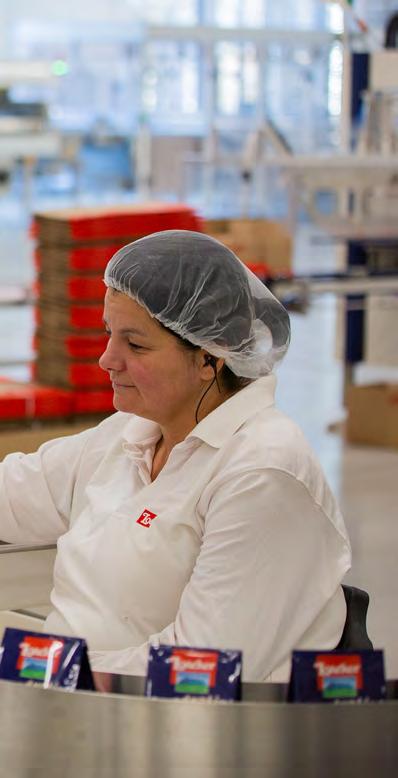
altitude of 1000 metres. The lower humidity at this elevation proved ideal for producing wafers with the legendary crispness that has become Loacker’s signature, today distributed in 120 countries worldwide.
Let’s talk about new trends, particularly smart packaging, which creates a dialogue between the consumer and the product.
“In our view, smart packaging is closely linked to the sensitivities of individual countries”, says Andrea Canale. “Just think of the widespread use of QR codes in China compared to Europe. It’s a tool that enables multi-target communication across different channels: from B2B to B2C. China and Saudi Arabia are just two examples of the many markets where Loacker is considering the development of specific packaging clusters that meet local regulatory requirements. At Loacker, we are moving in two directions. On the one hand, packaging is a strategic communication tool - take, for example, the Scelte Buone (Good Choices) campaign. Here, the concept of ‘goodness’ is linked not only to ingredients and taste but also to sustainability policies, aimed at reinforcing the company’s commitment to becoming a certified BCorp by 2027. In this journey, QR codes play a crucial role as tools for information sharing and product traceability, an area of growing importance for certification bodies. We are working with GS1 to define the framework for what can be communicated to the market through multi-level QR codes, with the goal of ensuring traceability for both buyers and consumers, while also providing additional content”.
Therefore, does interactivity mean both traceability control and dialogue with the consumer?
“Yes. On the back of our packs, we’ve added the message ‘Discover our sustainability paths’, which links to a dedicated landing page”, explains Canale. “This year, to mark our 100th anniversary, we have introduced the claim Ribelli ma buoni (Rebellious but Good), which bridges our classic slogan Loacker che bontà (Loacker, What Goodness) with ethical values that go beyond taste and quality. What we want to convey is that, for us, goodness represents a set of actions that encompass the entire life of the company. It’s also a goodhumoured nod to the stereotype of us
South Tyroleans, often seen as rigid, yet deeply committed to quality. The goal is to give the brand a personality that’s closely tied to its place of origin. It’s not just logos or colour schemes that define us, but the values we convey through our intrinsic quality, of which packaging is an integral part. It began with simple paper, evolved into tin foil, and has since followed a path shaped by the principles of modernity, while remaining firmly anchored in our traditional values. Our packaging reflects both content and values, combining a strong brand identity with nutritional information. As our president, Ulrich Zuenelli, puts it, we strive for ‘the perfect balance between vertical integration and horizontal differentiation’. Vertically, i.e. on the shelf, Loacker must be instantly recognisable, even from a distance. As customers come closer, they should be able to perceive the breadth of our product range and sense how our brand continues to evolve, all while preserving the identity and pride of a traditional company that consistently goes beyond market trends”.
What about materials?
“In the last 15 years, we have taken several key steps forward - moving from paper to metallised polypropylene, and then making another major leap by reducing the plastic component. We place great importance on the performance of the packaging, as we believe it is essential to fully preserve both the product’s organoleptic qualities and the integrity of the packaging itself. Driven by our commitment to sustainability, we began by reducing packaging weight by 25-30%. Then, three years ago, we transitioned to a mono-material solution, embracing all the technological changes that this requires. In 2025, we will have come to the end of the path, none of our packaging will be destined for mixed waste. Looking ahead, we are developing innovative solutions that honour the promise our founder, Armin Loacker, made to consumers. In fact, he often used to say, “We are famous because we are good”. When this philosophy is reflected in our packaging, it means that we are staying true to the product’s characteristics. It all starts with the recipe, which must remain faithful to the original. From there, we focus on sustainability, where, in our opinion, consumer satisfaction is a key component and packaging plays a central role. This comprehensive approach also extends to our innovative lines, such as those
dedicated to wellness, consumers with intolerances, and the growing segment of so-called ‘flexitarians’ - consumers who, despite having no dietary restrictions, actively choose ‘free-from’ products. This is a new market segment that we are monitoring closely, offering product lines that are identical in every way to the ‘original’ ones: one of our key strengths. Think of options like 30% less sugar or wholegrain: different nutritional profiles, but the same quality and taste. These represent new platforms through which we offer all the quality and goodness associated with the Loacker name.
As we celebrate our 100th anniversary, it is important to reaffirm that our sense of tradition is rooted in the positive evolution of our brand values. Rather than altering the brand, we continue to focus on goodness and integrity as the core of our production, qualities that continue to resonate with consumers. One of our most distinctive commitments is the complete absence of both natural and artificial flavourings in our products. This same level of rigour extends to the choice of our packaging materials, for example, we have eliminated the use of chlorine-based inks from our production process. In a nutshell, we define our values and bring them to life in every aspect of what we do”.
When does packaging influence your marketing decisions?
“I come from a background as a converter, and I owe a great deal to that experience. When engaging with different audiences of professionals, whether technicians or communicators, having an understanding of production issues gives you a real sense of the technical requirements needed to develop innovative solutions through constructive dialogue with the different professions. It also helps you to recognise the complexities behind the development of packaging. That’s why our department is designed to be self-sufficient, bringing together both creative and pre-press expertise. It is a single team with two complementary souls, working in constant collaboration to develop innovative packaging. Everything is designed in-house, thanks to a team equipped to handle the technical challenges related to countryspecific distribution, sealing, painting and the creative vision that defines our unmistakable brand identity”.
Schaeffler Italia a Ipack-Ima: prodotti destinati alle macchine e ai sistemi di processo, confezionamento, smistamento e trasporto in ambito alimentare.
Schaeffler Italia* ha portato a Ipack-Ima soluzioni di prodotto e servizi per l’intera catena di processo dell’industria del food, dalla lavorazione e il confezionamento degli alimenti fino al monitoraggio di intere linee di produzione: cuscinetti a sfere con anello di bloccaggio e unità di supporto in plastica, sistemi di guide profilate con lubrificazione e tenute, cilindri elettrici per ambienti rigidi e basse temperature.
Le gamme in esecuzione FD in mostra
Per un funzionamento affidabile e senza guasti, alle condizioni ambientali variabili tipiche dell’industria alimentare (resistenza agli agenti esterni, processi di pulizia, umidità, oscillazioni termiche) sono necessarie misure armonizzate reciprocamente.
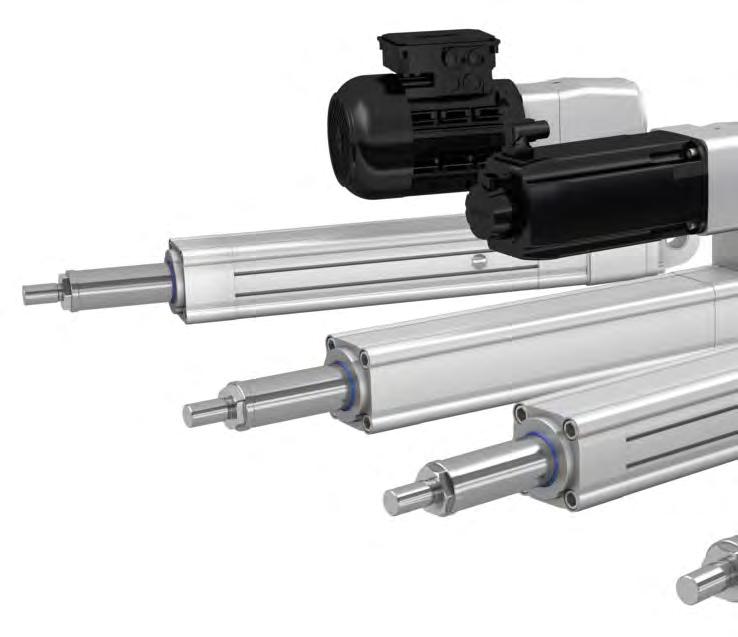
3. I cilindri elettrici CASM-100 sono dotati di motori asincroni o sincroni e, a scelta, di riduttori con ingranaggi cilindrici o cinghia dentata e flangia intermedia. Come azionamenti lineari si utilizzano viti a ricircolo di sfere e a rulli.
1. Cuscinetti a sfere con anello di bloccaggio e unità di supporto per l’industria del Food.
1. Ball bearings with locking collar and housing unit for the Food industry.
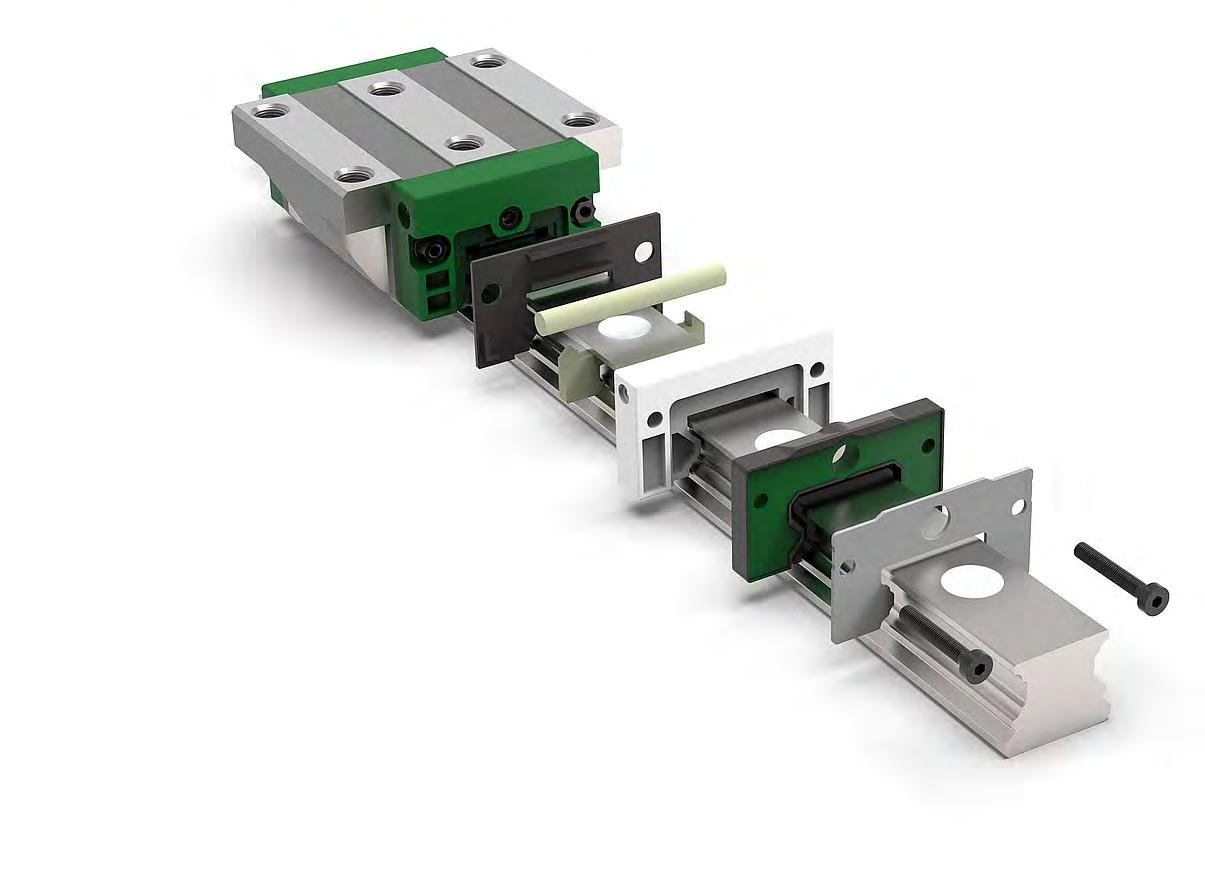
Tutti i prodotti Schaeffler ottimizzati per l’industria alimentare, dai cuscinetti a catalogo ai componenti pronti per il montaggio progettati su misura, sono dunque sviluppati tenendo in conto le specificità dell’applicazione e i vantaggi per i clienti, in particolar modo l’assenza di manutenzione, la durata d’esercizio sicura nonché la disponibilità di componenti e sistemi integrati tra loro.
Nel seguito, ne sintetizziamo le caratteristiche.


• Cuscinetti a sfere con anello di bloccaggio e unità di supporto (foto 1). Robusti e già pronti per il montaggio, sono presenti in quasi tutte le linee di produzione dell’industria alimentare. In esecuzione FD, sono basati sui cuscinetti radiali rigidi a sfere a una corona. Tutti i componenti sono realizzati in acciaio inossidabile per garantire una maggiore resistenza alla corrosione e ai liquidi. Il supporto in PBT, resistente agli agenti chimici e all’acqua calda, insieme alle calotte di protezione protegge il cuscinetto dalla contaminazione e gli alimenti dal contatto con il grasso lubrificante.
• Sistemi di guide profilate con lubrificazione e gruppo di tenuta (foto 2). Questi sistemi sono impiegati in un gran numero di movimenti lineari durante la lavorazione e il confezionamento degli alimenti. Per tutte le dimensioni della serie KUVE..B a ricircolazione a quattro ranghi di sfere, Schaeffler garantisce lubrificazione e tenute ottimizzate specifiche, grazie all’unità di lubrificazione a lungo termine KIT450, a raschiatori a doppio labbro aggiuntivi e a grasso fluido per uso alimentare. I vantaggi immediati sono costi ridotti di pulizia delle macchine, intervalli di rilubrificazione significativamente più lunghi e, in molti casi, la possibilità di passare alla lubrificazione a vita.
2. Riduzione dei costi di pulizia e manutenzione: guarnizioni e raschiatori ottimizzati e l’unità di lubrificazione a lungo termine KIT450 sui carrelli di guida del sistema di guide profilate KUVE-B di Schaeffler.
2. Reduced cleaning and maintenance costs: optimised seals and wipers and the KIT450 long-term lubrication unit on the guide rails of Schaeffler’s KUVE-B profile rail system.
e commercializza sul mercato nazionale i prodotti a marchio INA, FAG e LuK per applicazioni industriali ed automotive.

3. CASM-100 electric cylinders are fitted with asynchronous or synchronous motors and optionally with spur gears or a toothed belt and intermediate flange. Ball screws and roller screws are used as linear drives.
• Cilindri elettrici per ambienti rigidi e basse temperature (foto 3). Sono molto utilizzati nel settore del Food come attuatori e per l’azionamento di sportelli, cursori e guarnizioni.
Per soddisfare i severi requisiti igienici, Schaeffler offre anche cilindri elettrici serie CASM in versione acciaio inox.

Schaeffler Italia at Ipack-Ima: products for processing, packaging, sorting and conveying machines and systems in the food industry.
Schaeffler Italia* has brought product solutions and services for the entire process chain of the food industry to Ipack-Ima, ranging from food processing and packaging to the monitoring of entire production lines: ball bearings with locking ring and plastic bearing units, profiled rail systems with lubrication and seals, and electric cylinders for harsh environments and low temperatures.
FD configuration ranges on show Mutually harmonised measures are required for reliable and failure-free operation in the variable environmental conditions typical of the food industry (resistance to external agents, cleaning processes, humidity, temperature fluctuations). All Schaeffler products optimised for the food industry, from
Molti cilindri e attuatori non sono a diretto contatto con gli alimenti, quando ad esempio vengono utilizzati per l’indirizzamento e lo smistamento su linee di trasporto: per questi compiti, è disponibile l’ampia serie CASM-25, -32, -40, -63 e -100, mentre le serie CASM IP54S risultano particolarmente adatte per applicazioni in ambienti umidi e polverosi.
• In mostra a Ipack-Ima, Schaeffler ha proposto anche rotelle, rotelle a sfere e perni folli, disponibili in varie versioni per l’impiego in meccanismi a camme, alberi di supporto, guide lineari e sistemi di trasporto (foto 4).

catalogue bearings to customdesigned ready-to-assemble components, are therefore developed taking account of both the specifics of the application and the benefits for the customer, in particular the lack of maintenance required, safe service life, and the availability of components and systems integrated with each other. The characteristics are summarised below:
• Ball bearings with locking collar and housing unit (photo 1). Robust and ready to assemble, they can be found on almost every production line in the food industry. In FD configuration, they are based on
single-row deep groove ball bearings. All the components are made of stainless steel to ensure greater resistance to corrosion and liquids. The PBT backing is resistant to chemicals and hot water, and together with the protective caps, protects the bearing from contamination and food from contact with lubricating grease.
• Profile rail guides with lubrication and sealing assembly (photo 2). These systems are used in a large number of linear movements during food processing and packaging. For all the sizes of the four-row recirculating ball KUVE..B series, Schaeffler provides specific optimised lubrication and sealing with the KIT450 long-term lubrication unit, additional doublelip wipers and food-grade fluid grease. The immediate benefits are reduced machine cleaning costs, significantly longer relubrication intervals, and, in many cases, the
ability to switch to lifetime lubrication.
• Electric cylinders for harsh environments and low temperatures (photo 3). Widely used in the food industry as actuators and for operating doors, sliders and gaskets. To meet stringent hygiene requirements, Schaeffler also offers CASM series electric cylinders in stainless steel versions. Many cylinders and actuators do not come into direct contact with foodstuffs, when, for example, they are used for addressing and sorting on conveyor lines. For these tasks, the extensive CASM-25, -32, -40, -63 and -100 series are available, while the CASM IP54S series are particularly suitable for applications in wet and dusty environments.
- Also on display at Ipack-Ima from Schaeffler are track rollers, ball rollers and stud-type track rollers, available in various versions for use in cam mechanisms, support shafts, linear guides and conveyor systems (photo 4).
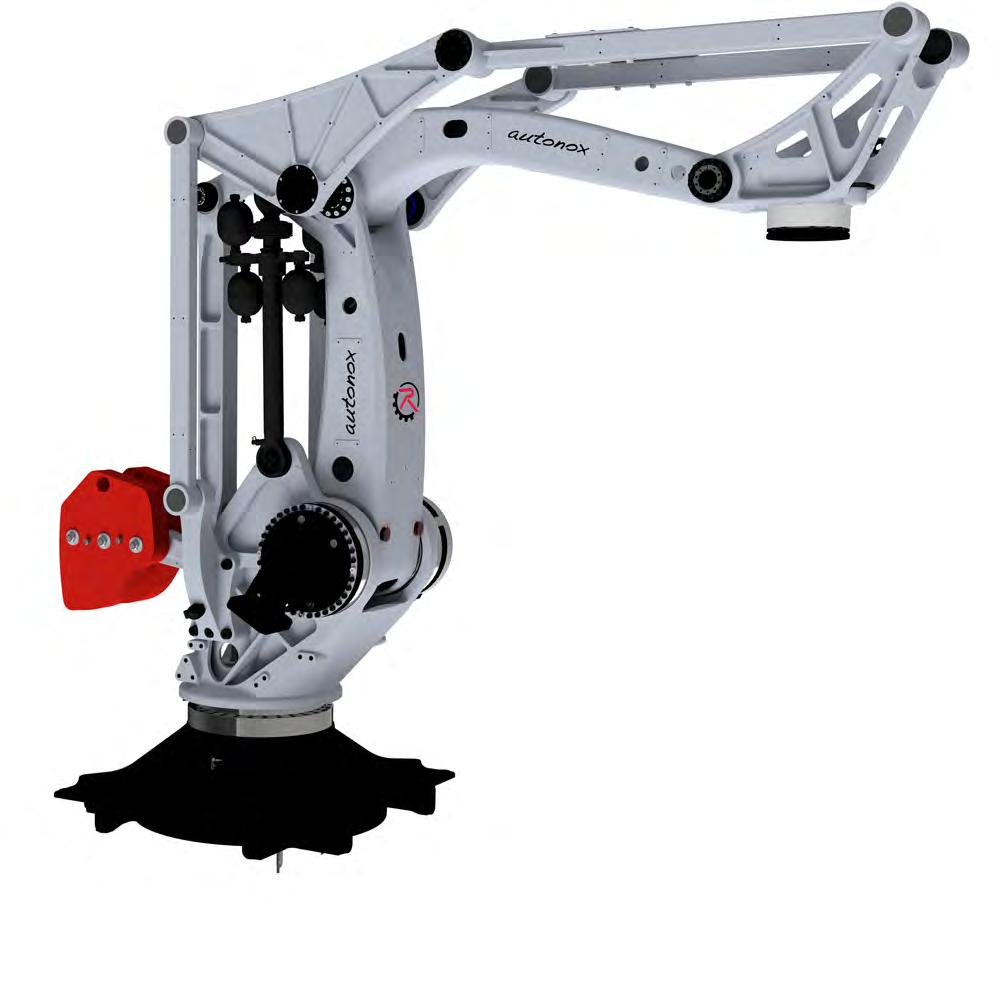
D.C.M. porta sul mercato un elemento strategico per l’evoluzione dell’industria moderna: le soluzioni robotiche a marchio autonox Robotics contribuiscono infatti a trasformare i processi produttivi, puntando a ottimizzare prestazioni, igiene e flessibilità.
el comparto alimentare, l’igiene rappresenta un vincolo imprescindibile a cui le soluzioni robotiche di autonox Robotics rispondono, aderendo ai rigorosi standard di Hygienic Design, con protezioni certificate fino al grado IP69K.
I robot progettati per il confezionamento primario sono infatti realizzati per evitare zone di accumulo di residui e detergenti, garantendo così l’integrità del prodotto finito e una manutenzione semplificata. L’attenzione alla progettazione igienica consente quindi ai robot di operare in ambienti ad alta sensibilità sanitaria, rispondendo alle esigenze di settori come caffè, cioccolato e bakery.
Versatilità e prestazioni
Proposta da D.C.M., la gamma autonox Robotics include soluzioni per ogni fase della produzione con un’ampia varietà di modelli che includono delta Robot (3, 4 o 5 assi) con aree di lavoro fino a 2.000 mm e payload fino a 50 kg, ideali per applicazioni ad alta velocità come il pick & place; duopodi con cinematiche ad alta dinamica e carichi elevati; robot scara e antropomorfi, perfetti per assemblaggi e manipolazioni su piani orizzontali o verticali.
Indipendenza dal controllore. Tutti i robot autonox sono forniti senza un controllore proprietario, lasciando massima libertà al cliente nella selezione della piattaforma di automazione preferita. Una scelta che non impone linguaggi di programmazione proprietari e permette di ridurre i costi di integrazione, semplificando anche il training del personale.
Novità anche nella palettizzazione. Tra le più recenti innovazioni di autonox Robotics, spicca il robot articolato ARTICC4-3219-850kg, pensato per la palettizzazione e la movimentazione di carichi pesanti.
Caratterizzato da una cinematica a doppio parallelogramma, il robot garantisce elevata rigidità strutturale e stabilità della flangia anche sotto sforzi significativi. Il design compatto riduce l’ingombro verticale, facilitando l’integrazione in ambienti con altezza limitata. L’asse cavo 1 consente inoltre il passaggio interno dei cavi, riducendo l’usura e semplificando la manutenzione.
Con un payload massimo di 850 kg, ARTICC43219-850kg è attualmente il robot più robusto nella sua categoria e rappresenta una svolta nelle applicazioni di fine linea che richiedono affidabilità, capacità di carico elevata e velocità operativa: risposta ideale alle necessità di palettizzazione automatica espresse dai settori alimentare, delle bevande, farmaceutico e della logistica industriale.

D.C.M. brings a strategic element for the evolution of modern industry to the market: autonox Robotics-branded robotic solutions help transform production processes, with a view to optimising performance, hygiene and flexibility.
In the food industry, hygiene is an essential requirement to which autonox Robotics’ robotic solutions are able to respond, adhering to rigorous Hygienic Design standards, with protections certified up to IP69K grade. Robots for primary packaging are designed to avoid areas of residue and detergent build-up, thus ensuring the integrity of the finished product and simplifying maintenance. Attention to hygienic design thus enables the robots to operate in highly sanitary-sensitive environments, meeting the needs of industries such as coffee, chocolate and bakery.


Proposed by D.C.M., the autonox Robotics range includes solutions for every stage of production, with a wide variety of models that include delta Robots (3, 4 or 5 axes) with working areas of up to 2,000 mm and payloads of up to 50 kg, ideal for high-speed applications such as pick & place; duopods with high-dynamic kinematics and high loads, and SCARA and anthropomorphic robots, perfect for assembly and manipulation in horizontal or vertical surfaces.
Independence from the controller. All autonox robots are supplied without a proprietary controller, giving the customer maximum freedom to select their preferred automation platform. This choice does not impose proprietary programming languages and reduces integration costs, while also simplifying staff training.
New palletising solutions. Among the latest innovations from autonox Robotics is the ARTICC4-3219850kg articulated robot, designed for palletising and handling heavy loads.
Featuring double-parallelogram kinematics, the robot offers high structural rigidity and flange stability even under significant stress. The compact design reduces height, facilitating integration in environments with limited height. Hollow Axis 1 also allows for internal cable routing, reducing wear and tear and simplifying maintenance. With a maximum payload of 850kg, ARTICC4-3219-850kg is currently the most robust robot in its class and represents a breakthrough in end-of-line applications requiring reliability, high load capacity and operational speed: an ideal answer to the automatic palletizing requirements of the food, beverage, pharmaceutical and industrial logistics sectors.
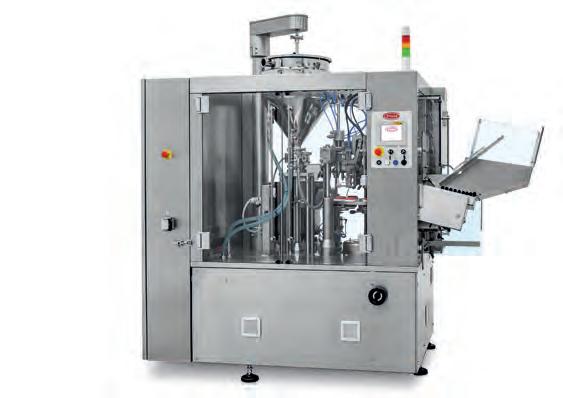
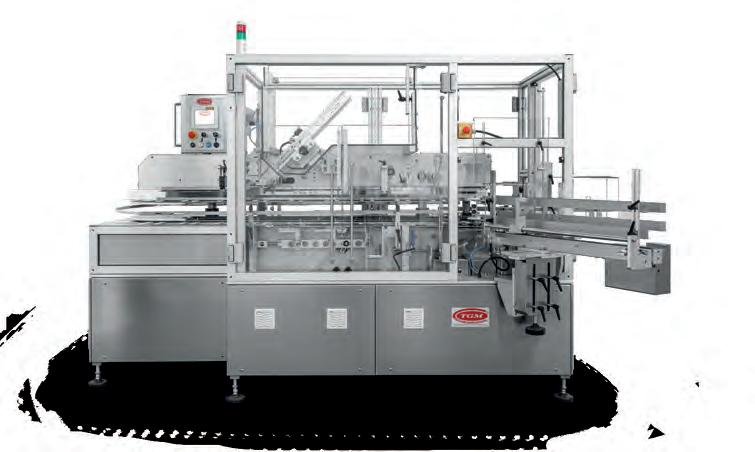
Schneider Electric con Robopac
Le soluzioni Pac Drive 3 di Schneider Electric consentono ad Aetna Group e ai suoi brand un’elevata modularità nell’allestimento di soluzioni a elevata personalizzazione, con un occhio di riguardo al risparmio energetico.
Fondamentale per tutte le società di Aetna Group, l’impegno nel controllo dell’impatto ambientale viene mantenuto attraverso buone pratiche che vanno dalla cura nella scelta e nell’ottimizzazione dei materiali fino all’attenzione ai consumi energetici degli impianti realizzati. Un percorso in cui il costante miglioramento, favorito dagli investimenti in ricerca e sviluppo, consente a tutte le società del gruppo di presidiare il mercato con soluzioni sempre più sostenibili.
Una partnership di successo
Il vero valore aggiunto degli impianti Robopac, uno dei brand di riferimento del Gruppo, consiste nella massima flessibilità in fase di costruzione, che ne consente la customizzazione su misura. L’esigenza di soddisfare al meglio le richieste dei clienti è alla base della scelta dell’impiego delle soluzioni Pac Drive 3 di Schneider Electric, tra cui i motori brushless adottati nei prodotti di punta Robopac: ne sono un esempio le macchine fardellatrici e incartonatrici combinate TC 500 della serie Prasmatic e il palettizzatore a mono-colonna Ares con manipolatori gantry ML per la formazione dello strato. Si tratta di impianti altamente flessibili e innovativi per produzioni di media e alta velocità, con prestazioni fino a 6 strati al minuto, in grado di adattarsi a tutte le esigenze del mercato Food and Beverage.
I vantaggi delle soluzioni Pac Drive 3. L’approccio plug and play abilitato da Pac Drive 3 di Schneider Electric consente a Robopac l’implementazione rapida di nuove funzionalità e l’ampliamento della gamma dei formati previsti nell’impianto anche durante le fasi avanzate di sviluppo e di collaudo. Per Robopac, il vantaggio è evidente sia nella facilità di personalizzazione, espansione e modifica dei macchinari in costruzione, sia nel rispetto dei tempi di consegna. Con l’impiego delle soluzioni Schneider Electric è infatti possi-
Specialità di Gruppo
Robopac è una realtà italiana, leader mondiale nella progettazione e costruzione di macchine e soluzioni dedicate all’imballaggio secondario e al fine linea. Così come Aetna Group, il gruppo industriale di cui è società costitutiva, e insieme agli altri brand che ne fanno parte - OCME, Sotemapack, la statunitense Top Tier e Meypack, azienda tedesca dalla consolidata tradizione manifatturieraRobopac si distingue per una visione innovativa senza compromessi nella qualità e nella personalizzazione delle macchine.
Aetna Group comprende stabilimenti produttivi negli Stati Uniti, in Germania, in Cina e in Brasile, che si aggiungono a quelli sul territorio italiano, per un totale di oltre 2200 dipendenti e un fatturato che nel 2024 ha superato i 500 milioni di euro.
Group Specialities
Robopac is an Italian company, a world leader in the design and construction of machines and solutions dedicated to secondary and end-of-line packaging, as is Aetna Group, the industrial group it belongs to. Together with the other brands that are part of it - OCME, Sotemapack, the U.S.-based Top Tier, and Meypack, a German company with a long-established manufacturing tradition - Robopac stands out for its uncompromisingly innovative vision in machine quality and customisation.
Aetna Group includes production facilities in the United States, Germany, China and Brazil, in addition to those in Italy. It has a total of more than 2,200 employees, and a turnover that exceeded 500 million euros in 2024.

bile ampliare le prestazioni degli impianti nella massima modularità, rispondendo alle richieste di cambiamenti di progetto spesso concordati con i clienti in corso d’opera. A questo si aggiunge un vantaggio in fase di sviluppo software, grazie alle librerie di robotica disponibili, che riducono drasticamente i tempi di programmazione delle operazioni di produzione.
Dal cambio formato ai nuovi materiali: massima flessibilità. I benefici che vanno a vantaggio delle aziende che scelgono le fardellatrici e i palettizzatori Robopac sono numerosi. Oltre alla flessibilità nel cambio formato, indispensabile per rispondere alla diversificazione della produzione, il mercato richiede impianti in grado di operare con diversi tipi e materiali di imballaggio. Una varietà di applicazioni che solo macchinari con componenti plug and play sono in grado di garantire.
Risparmio energetico garantito
Grazie all’elettronica applicata alla meccanica, il rispetto dell’ambiente si coniuga anche al risparmio energetico, con ricadute sul piano economico: un ulteriore punto di forza degli impianti progettati da Robopac. Grazie ai connettori DC Bus Schneider Electric, il sistema sfrutta infatti la discontinuità di velocità di andamento imposta dai diversi movimenti richiesti dalle schede di controllo delle operazioni durante il processo produttivo. In fase di decelerazione viene rimessa in circolo energia, permettendone il riutilizzo dagli altri motori per l’accelerazione in fase attiva. In questo modo, l’energia non viene dissipata sotto forma di calore, ma impiegata per un successivo movimento dell’impianto, garantendo circa il 40% di riduzione dei consumi elettrici. Un uso efficace dell’elettronica negli impianti su cui Robopac, come le altre aziende di Aetna Group, ha puntato per continuare a far evolvere il proprio business. Quello del packaging è un settore in continua trasformazione dove le soluzioni Schneider Electric sono in grado di adattarsi seguendo le esigenze dei costruttori, in accordo con un approccio dove soddisfazione del cliente e sostenibilità sono la visione comune alla base di una partnership più che ventennale tra le due aziende e destinata a continuare nel tempo.
Schneider Electric’s Pac Drive 3 solutions offer Aetna Group and its brands a high degree of modularity in installing highly customised solutions, with a focus on energy savings.
Essential for all Aetna Group companies, a commitment to controlling environmental impact is maintained through best practices ranging from careful selection and optimisation of materials to attention to the energy consumption of the systems developed. Constant improvement, aided by investment in research and development, enables all the group companies to offer the market increasingly sustainable solutions.
The real added value of the systems by Robopac, one of the Group’s flagship brands, lies in their maximum flexibility during construction, which allows them to be tailored to the customer’s needs. The need to meet customer requirements more effectively prompted the choice of Schneider Electric’s Pac Drive 3 solutions, including the brushless motors adopted in Robopac’s flagship products: examples include the Prasmatic series TC 500 combined shrink wrapping and case packing machines and the Ares singlecolumn palletizer with ML gantry manipulators for layer formation. These are highly flexible and innovative systems for medium and high-speed production, with performance of up to 6 layers per minute, capable of adapting to all the needs of the Food and Beverage market.
The advantages of Pac Drive 3 solutions. The plug and play approach enabled by Schneider Electric’s Pac Drive 3 allows Robopac to rapidly implement new functions and expand the range of formats planned in the plant even during advanced development and testing phases. For Robopac, the advantage is evident, making it easier to customise, expand and

modify the machinery being built, and also in terms of meeting delivery schedules. Schneider Electric solutions make it possible to expand the performance of systems with maximum modularity, responding to requests for design changes often agreed on with customers during construction. Added to this is an advantage at the software development stage, thanks to the robotics libraries available, which drastically reduce programming times for manufacturing operations.
From format change to new materials: maximum flexibility. There are numerous benefits for companies that choose Robopac shrinkwrappers and palletizers. In addition to flexibility for format changes, which is essential to respond to production diversification, the market demands plants able to operate with different packaging types and materials. This variety of applications can only be provided by machines with plug and play components.
Thanks to electronics applied to mechanics, respect for the environment can be combined with energy savings, and thus economic benefits: an additional strength of the systems designed by Robopac. Thanks to Schneider Electric’s DC Bus connectors, the system takes advantage of the discontinuity in speed imposed by the different movements required by the control boards of the operations during the production process. During deceleration, energy is put back into circulation, so that it can be reused by the other motors for acceleration in the active phase. In this way, energy is not dissipated in the form of heat, but used for subsequent plant movement, providing a reduction of around 40% in electrical energy consumption.
Like the other Aetna Group companies, Robopac has focused on this effective use of electronics in plants to continue developing its business. Packaging is an ever-changing sector, in which Schneider Electric solutions are able to adapt to meet the needs of manufacturers, adopting an approach in which customer satisfaction and sustainability are the shared vision that is the foundation of a partnership between the two companies stretching back over more than 20 years and destined to continue over time.
All’offerta di controlli/PLC e a una gamma completa di hardware e software per l’automazione dei macchinari - frutto di 40 di esperienza - SIPRO aggiunge un’innovativa linea di robot a geometria Delta pronti, come tutti i suoi robot, per l’integrazione con l’Industria 4.0.
Complemento ideale in tutti i settori del packaging per pick & place, assemblaggio e handling, questi Delta robot si differenziano principalmente in base ai diametri dell’area di lavoro con le versioni da 500 mm, 700 mm, 1200 mm e 1600 mm. Configurabili con 3, 4 o 5 assi i Delta permettono l’integrazione rapida ed efficace con i sistemi di visione messi a punto dalla società stessa. Tra gli ulteriori vantaggi spiccano la possibilità di customizzare le mani di presa e
l’integrazione di numerose funzioni avanzate come l’interpolazione, l’inseguimento del nastro in presa e deposito, la gestione e distribuzione dei prodotti in arrivo su più robot in linea, i raccordi di traiettoria 3D e l’esecuzione dell’interfaccia grafica su sistemi mobile Android.
Tra le novità proposte da SIPRO, il modello SIAX D5 1200 - C IP69K pensato per il mondo del food e del packaging. Dotato di cover di protezione IP69K, permette di gestire il quarto asse di rotazione e il quinto asse di tilting a cardano per tutte le applicazioni che richiedono la rotazione veloce del pezzo. Al proposito ricordiamo che Sipro ha già affrontato numerose applicazioni nell’imbottigliamento con il Robot Delta in funzione di riordinatore e orientatore.
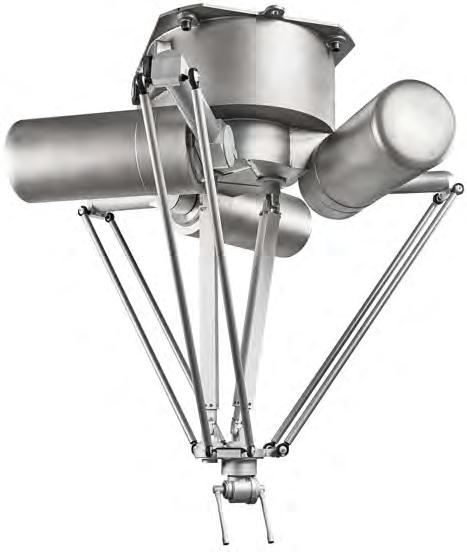
SIPRO Delta Robot: many advantages in a single technology
With 40 years of experience in the production of numerical controls and motion control solutions, SIPRO is integrating its offer of controllers/PLCs and a complete range of hardware and software for the automation of machinery, with an innovative line of ready Delta robots which, like all SIPRO robots,
are in line with Industry 4.0.
An ideal complement in all packaging sectors for pick & place, assembly and handling operations, SIPRO Delta Robots stand out mainly for the diameters of the work area with 500 mm, 700 mm, 1200 mm and 1600 mm versions. Configurable with 3, 4 or 5 axes, the Deltas allow for rapid and effective integration with SIPRO’s available vision systems. Other advantages include the possibility of
customizing the gripping hands and integrating numerous advanced functions such as interpolation, the tracking of the belt in pick-up and deposit, the management and distribution of incoming products on multiple robots in line, 3D trajectory fittings and execution of the graphical interface on Android mobile systems.
New developments in SIPRO also include the new SIAX D5 1200 - C
IP69K model designed for the world of food and packaging. Equipped with a IP69K protection cover, it allows for the management of the fourth rotation axis and of the fifth tilting cardan axis for all applications that require the rapid rotation of pieces. In this regard, we recall that Sipro has already faced numerous applications in bottling with the Delta Robot acting as an unscrambler and orientor.
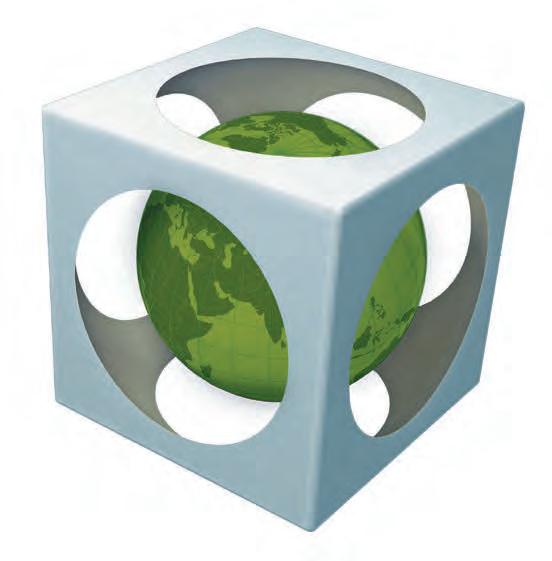



L’azienda sta spingendo su educational e storie di successo per alimentare la sua costante crescita

Continua il percorso di crescita e consolidamento sui mercati di Jaka robotics che aggiunge nuovi fondamentali tasselli alla sua strategia di espansione sul mercato italiano tra iniziative di formazione e la collaborazione con system integrator e partner per un portfolio sempre più significativo per complessità delle soluzioni e varietà di mercati. Ne parla il Country manager Italia, Giacomo Mariotti. “Con la presentazione a MECSPE del kit mobile pensato per il mondo educativo, Jaka prosegue in un percorso di consolidamento della sua rete che oltre ai system integrator, già protagonisti sul mercato, vede oggi il brand Jaka presente già nelle prime fasi di formazione dei
tecnici del futuro. Il trolley, che propone alle scuole una soluzione plug & play con JAKA MiniCobo, sistema di visione e organo di presa, è uno dei tasselli della creazione di una serie di centri di formazione aperti a clienti, prospect e ovviamente a studenti degli ultimi anni delle scuole superiori e universitari.
In una prima fase, la rete sarà costituita da distributori, service partner e servizi di assistenza post-vendita attivi tra Lombardia ed EmiliaRomagna, che verranno dotati di show room e spazi di formazione.
Con la presentazione del progetto a A&T di Vicenza a Ottobre, contiamo di aprire nuove prospettive al centro-nord, un mercato sempre più dinamico e promettente per l’automazione”.
Casi di successo da nord a sud
Una serie di case history presentate alle principali fiere di settore del primo semestre 2025, Mecspe, SPS Italia e Ipack-Ima raccontano di un percorso di crescita fondato sull’innovazione, tema su cui Mariotti prosegue:
“Le fiere sono un importante momento di sintesi per Jaka, che ha presentato al mercato una serie di casi applicativi dove la nostra tecnologia ha fatto la differenza per automatizzare processi tediosi e gravosi per l’operatore, risolvere problemi di spazio grazie alla compattezza delle nostre soluzioni, introdurre flessibilità ed efficienza in processi lunghi e gravosi per l’operatore, che si tratti di confezionamento, fine linea o saldatura, per settori che spaziano dal food alla nutraceutica”.
“La prima case riguarda ESCA” continua Mariotti “family company dolciaria con sede in Sardegna che è in procinto di automatizzare la linea di confezionamento dei suoi savoiardi gluten free grazie a una soluzione Jaka proposta dall’emiliana Tecnoeffe. I biscotti vengono prelevati da un primo cobot dotato di end effector, che grazie all’effetto Bernoulli che non entra in contatto con l’alimento, depositandolo nella scatola. Un secondo cobot inserisce poi uno strato di velina tra un savoiardo e l’altro, componendo il vassoio e collocandolo all’interno della confezione che, infine, entra nell’area di confezionamento e chiusura in atmosfera modificata”.
Dal food si passa al nutraceutico con AFT system, protagonista della realizzazione di una linea di automazione per l’inscatolamento attraverso due mini cobot da 1 kg sincronizzati.
“Il primo cobot preleva il tubetto dal nastro trasportatore, inserendolo all’interno dell’astuccio” racconta Mariotti “il secondo lo colloca nella scatola. Automazione in spazi ridotti, velocità e basso consumo sono i plus del progetto. Il doppio cobot permette di ottimizzare il consumo medio a 150 watt, la metà di un asciugacapelli domestico. L’architettura prevede infatti motori in condivisione tra più giunti, riducendo del 50% il fabbisogno di energia grazie a progettazione, a componenti di alta gamma e all’abilitazione 4.0 e 5.0 per il monitoraggio real time”.
Guardando, al fine linea, un mercato in crescita per Jaka, la protagonista è UNITED SYMBOL, con una linea di confezionamento astucci per il settore residenziale.
“Le scatole in cartone americano vengono inviate alla cella di pallettizzazione, dotata di add-on pallettizing di Jaka con robot da 20 kg in modalità wireless”. racconta Mariotti “La cella lavora su una doppia baia dove il cobot opera un handling a presa multipla di astucci in formati diversi che vengono poi inseriti nelle scatole formate dall’operatore. “
The company is leveraging training programs and customer success stories to fuel its growth strategy.
JAKA Robotics continues its growth and consolidation in the market, strengthening its expansion strategy in Italy with key initiatives such as training programs and collaborations with system integrators and partnersall contributing to an increasingly sophisticated portfolio of advanced solutions.
Giacomo Mariotti, JAKA’s Country Manager for Italy, tells us:
“With the launch of its new portable Education Kit at MECSPE, JAKA is further expanding its footprint in the automation landscape. In addition to working with system integrators - already key players in the market - the company has set its focus on training the next generation of technicians and robotics experts. The kit, designed as a plug-and-play solution for educational use, includes a JAKA MiniCobo, vision system, and gripper, all mounted on a mobile
trolley. It marks a step towards building a network of training centres for both existing and prospective customers, as well as high school and university students.
In the initial phase, the network will include distributors, service partners, and after-sales providers based between Lombardy and Emilia-Romagna. These partners will feature showrooms and dedicated training areas showcasing the Education Kit, among other solutions. With the upcoming presentation of the project at A&T Vicenza in October 2025, we aim to expand our reach across northern Italy-an increasingly dynamic and promising region for automation”.
Successful cases from North to South
A series of case studies presented at key industry trade fairs in the
Chiude la carrellata CMA, Integratore e service partner dell’area napoletana, che ha realizzato una linea di formatura scatole in un contesto con vari cambi formato.
“Il fermo macchina medio di 45 minuti è stato risolto con una soluzione di formatura scatole con cobot Jaka Zu12, che permette elevate velocità in spazi ristretti e con cambi formato veloci che garantiscono ampia flessibilità, grazie alla creazione di magazzini diversi per i diversi formati. Con lo stesso organo di presa, il robot cambia in automatico il formato in base alla ricetta contribuendo a un sistema estremamente performante e flessibile. Con tempi ciclo bassi, la cella può rimanere aperta, mentre con tempi ciclo fino a 8 scatole al minuto, si possono aggiungere laser scanner e dispositivi di sicurezza. Ad aggiungere flessibilità, la possibilità di movimentare la soluzione con un trans-pallet, per un re-deployement rapido ai limiti del plug and play grazie anche alla connessione alla rete elettrica da 200 volt e la flessibile gestione degli apparati”.


first half of 2025-including MECSPE, SPS Italia, and IPACK-IMA-highlight a growth path driven by innovation.
On this topic, Mariotti explains:
“Trade fairs are a key opportunity for JAKA to showcase real-world applications where our technology has made a tangible difference: automating tedious or heavy manual processes, solving space constraints with compact solutions, and bringing flexibility and efficiency to packaging, end-of-line, and welding processes across sectors from food to nutraceuticals.
One such example comes from ESCA “ Mariotti continues “a family-run confectionery business in Sardinia, which automated its packaging line for gluten-free ladyfingers using a JAKA solution implemented by Emilia-based integrator Tecnoeffe. The first
effect end effector, gently lifts the biscuits without contact and places them in boxes. A second cobot then inserts a layer of tissue between each ladyfinger, arranges them in a tray, and places the tray into a pack, which is subsequently sealed under modified atmosphere conditions”.
Switching from food to nutraceuticals, another success story involves AFT, which built a boxing automation line using two synchronized 1 kg JAKA MiniCobos.
“The first cobot picks up the tube from the conveyor belt and places it into a carton,” Mariotti explains.
“The second cobot then positions the carton in a box. The system is optimized for tight spaces, high speed, and energy efficiency.
Together, the two cobots consume an average of just 150 watts-about half the power of a typical hairdryer.

high-performance components, and Industry 4.0/5.0 readiness for real-time monitoring cut energy consumption by 50%”.
Looking at the end-of-line automation-a growing market for JAKA-the standout case involves UNITED SYMBOL with a carton packaging line for the residential sector.
“American-style cardboard boxes are conveyed to a palletizing cell featuring JAKA’s palletizing add-on and a 20 kg cobot operating in wireless mode,” says Mariotti. “The cell handles two pallet bays, where the cobot performs multi-grip handling of various box formats before placing them into cartons pre-formed by an operator”.
Finally, in southern Italy, CMA - an integrator and service partner based near Naples-has built a flexible
requiring frequent format changes.
“Where average machine downtime previously reached 45 minutes, JAKA’s Zu12 cobot now enables high-speed operation in compact spaces with fast format switching,” Mariotti notes. “The same gripper can automatically adapt to different formats based on digital instructions, creating different stacks for various packaging types. With low cycle times, the cell can safely remain open; at higher speeds-up to 8 boxes per minutelaser scanners and safety systems can be added. Flexibility is further enhanced by the mobile design: the entire solution can be moved with a pallet jack and redeployed quickly thanks to a 200-volt mains connection and adaptable equipment”.








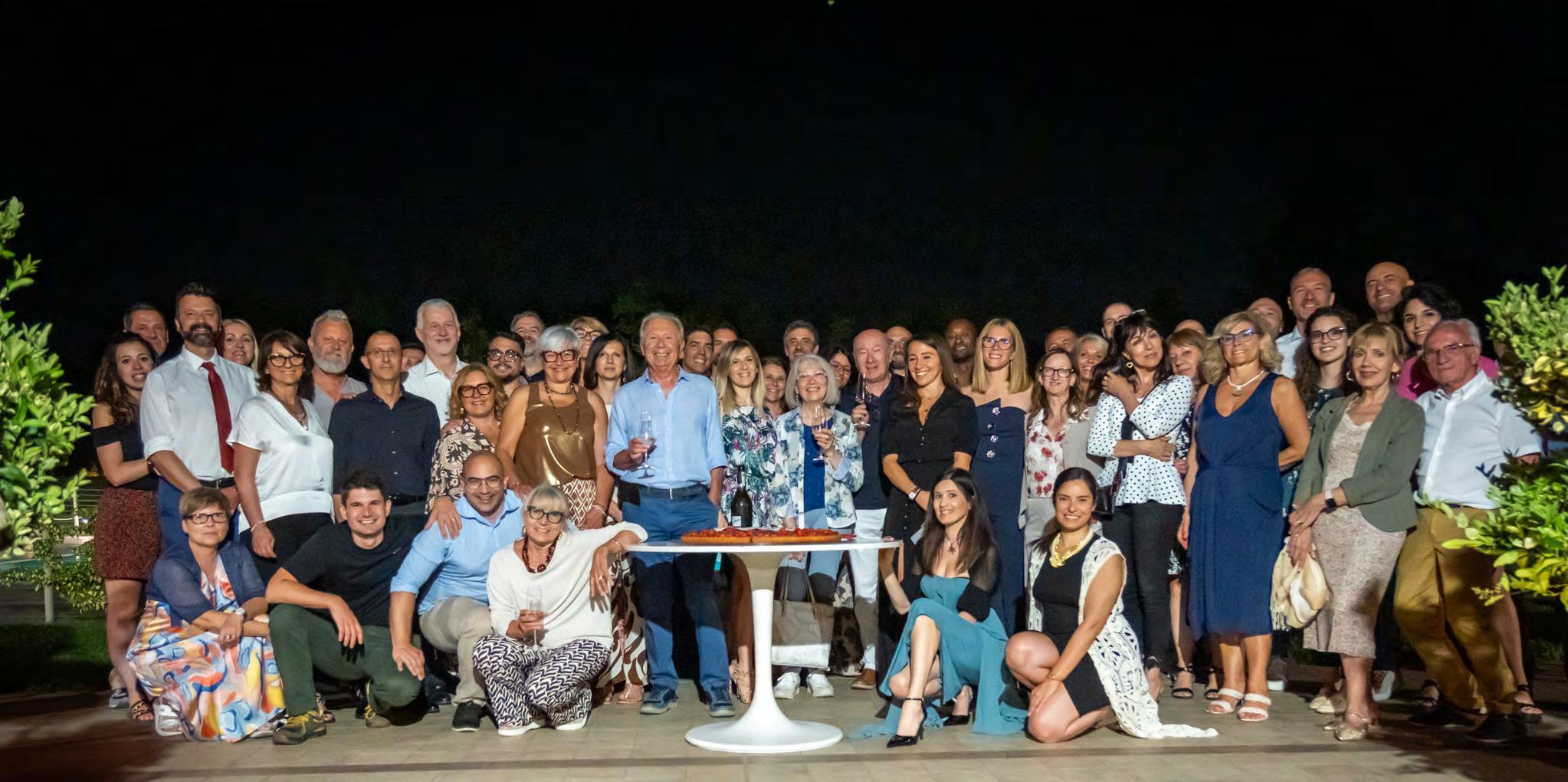
L’azienda festeggia un importante traguardo e con i suoi slip ring innovativi e affidabili conquista il settore packaging
Valori e obiettivi. Sono due parole che Servotecnica ha scelto per sottolineare l’importanza di un traguardo raggiunto nel 2025, quello dei 45 anni di età. L’azienda, nata nel 1980 con il ruolo di distributore nel settore motion control, ha saputo interpretare i tempi e ha sviluppato, negli anni, i propri prodotti con l’obiettivo di fornire soluzioni perfettamente integrabili tra loro. Oggi Servotecnica progetta e realizza slip ring compatti e resistenti, perfetti per applicazioni nei settori packaging, industriale, medicale, robotico ed elettronico, disponibili in migliaia di configurazioni standard o ‘su misura’.
Questo importante lavoro è supportato da un gruppo affiatato di oltre 50 persone. Il gruppo dirigente ha dimostrato, negli anni, di tenere in alta considerazione l’importanza della formazione delle nuove leve e l’investimento sul capitale umano.
Collaborazioni di successo
A SPS Italia Servotecnica ha presentato le sue ultime novità, tra cui i prodotti in esposizione, i Micromotori Serie Atom, una tecnologia coreless per applicazioni che mette al centro compattezza, potenza, affidabilità e precisione e un Giunto Robotico con motore brushless integrato, encoder assoluto, riduttore a gioco zero e albero cavo, per la massima fluidità, precisione e versatilità.
A illustrarci le soluzioni più importanti per il settore packaging è stato Alessandro Gomarasca,
Marketing & Product Manager. “I nostri slip ring - spiega - ci consentono di intercettare diverse tipologie di clienti nel mondo dell’imballaggio e garantiscono grande compatibilità con altri costruttori di automazione. Tra i nostri progetti recenti più importanti, segnalo la collaborazione con Rockwell Automation, un lavoro durato quasi tre anni, che ci ha visti coinvolti come unici produttori di slip ring nei loro nuovi sistemi ArmorKinetix™”. “Molto importante anche il lavoro svolto con AMK, che ha lanciato un nuovo sistema di drive e di motori a cavo ibrido, che semplifica la costruzione della macchina dal momento che non c’è più il ‘cabinet’ e tutto viene installato a bordo macchina, con una notevole risparmio sia in fase di installazione che di collaudo”.
Le sfide di oggi e del futuro
Gomarasca ci ha anche aiutato a individuare i principali trend del momento nel settore packaging. “Una delle richieste più comuni è quella di aumentare la velocità della produzione. L’altra caratteristica più ricercata è la flessibilità: in questo senso aver reso la macchina interamente controllabile elettronicamente rappresenta un grosso vantaggio, dal momento che non sono più necessarie registrazioni meccaniche di guide o altre componenti interessate nel cambio formato”.
‘Dulcis in fundo’ il tema della sostenibilità (ESG), che Servotecnica ha sempre tenuto in grande considerazione nonostante la sua attività sia a ridotto impatto. “Abbiamo fatto un percorso con SQS, ente di certificazione svizzero con il quale abbiamo conseguito la ISO 14001.
Inoltre, abbiamo già digitalizzato da tempo tutti i nostri processi”. L’ennesima conferma che, forti di 45 anni di storia alle spalle, in Servotecnica abbiano bene in mente sfide e opportunità del futuro.

The company celebrates an important milestone, conquering the packaging industry with its innovative and reliable slip rings
Values and goals. These are the two words Servotecnica has chosen to highlight the importance of a milestone reached in 2025: 45 years in business. Founded in 1980 as a distributor in the motion control industry, the company has been able to keep pace with the times and has developed its products over the years with the aim of providing solutions that can be perfectly integrated with each other. Today Servotecnica designs and manufactures compact and durable slip rings, perfect for applications in the packaging, industrial, medical, robotic and electronic sectors, and available in thousands of standard or ‘custom’ configurations.
This important effort is supported by a close-knit group of more than 50 people. Over the years, the management team has demonstrated its high regard for training new recruits and investing in human capital.
collaborations
At SPS Italia, Servotecnica showcased its latest products, which included the Atom Series Micromotors, a coreless technology for applications that focuses on compactness, power, reliability and precision, and a Robotic Joint with integrated brushless motor, absolute encoder, zero-backlash gearbox and hollow shaft for maximum smoothness, precision and versatility.
Marketing & Product Manager Alessandro Gomarasca outlined the most important solutions for the packaging industry. “Our slip rings”, he explains, “allow us to capture different types of customers in the packaging world and ensure great compatibility with other automation manufacturers. Among our most important recent projects, I would like to highlight our collaboration with Rockwell Automation, lasting almost three years, in which we were the only slip ring manufacturers in their new ArmorKinetix™ systems”.
“Also very important is the work carried out with AMK, which launched a new hybrid drive and cable motor system that simplifies machine construction since there is no longer a ‘cabinet’ and everything is installed on board the machine, resulting in significant savings in both installation and testing”.
Current and future challenges Gomarasca also helped us identify the main trends of the moment in the packaging industry. “One of the most common requests is to increase production speed. The other most sought-after feature is flexibility: in this sense, having made the machine fully electronically controllable is a major advantage, since mechanical adjustments of guides or other components involved in the format change are no longer necessary”.
Last but not least is the issue of sustainability (ESG), which Servotecnica has always held in high regard despite the low impact of its operations. “We went through a process with the Swiss certification body SQS to obtain ISO 14001. In addition, we have long since digitalised all our processes”. This is further confirmation that, with 45 years of history behind them, Servotecnica is well aware of the challenges and opportunities of the future.


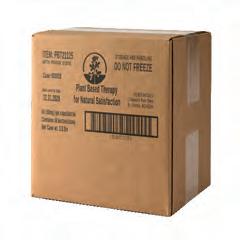

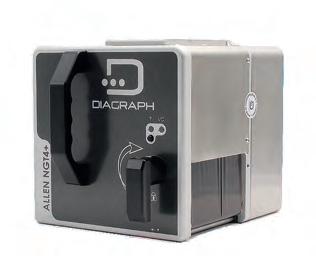
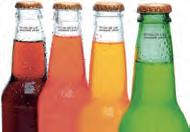
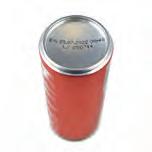



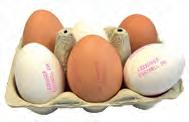
Goglio
Innovativo e sostenibile, Fres-co Aseptic System® è il cuore dell’offerta Goglio in fatto di confezionamento asettico di alimenti liquidi e pompabili.
Fres-co Aseptic System® integra confezioni sterili con bocchello e linee di confezionamento automatizzate ed è in grado di preservare la freschezza e garantire nel tempo la conservazione dei prodotti confezionati. Per il mercato del liquid food, Goglio propone un’ampia gamma di soluzioni di confezionamento asettico: bag-in-box da 3 a 20 litri, sacchi da 220 litri fino ai big-bag da 1.500 litri, realizzati in ambienti a contaminazione controllata e sterilizzati a raggi gamma. Si tratta di imballaggi impiegati per confezionare prodotti alimentari liquidi e pompabili, come succhi e concentrati di frutta, conserve di pomodoro e di altri vegetali, latticini e altri preparati, e in generale tutti i prodotti che richiedono shelf-life prolungata a temperatura ambiente, senza necessità di refrigerazione e senza l’aggiunta di conservanti o altri additivi.
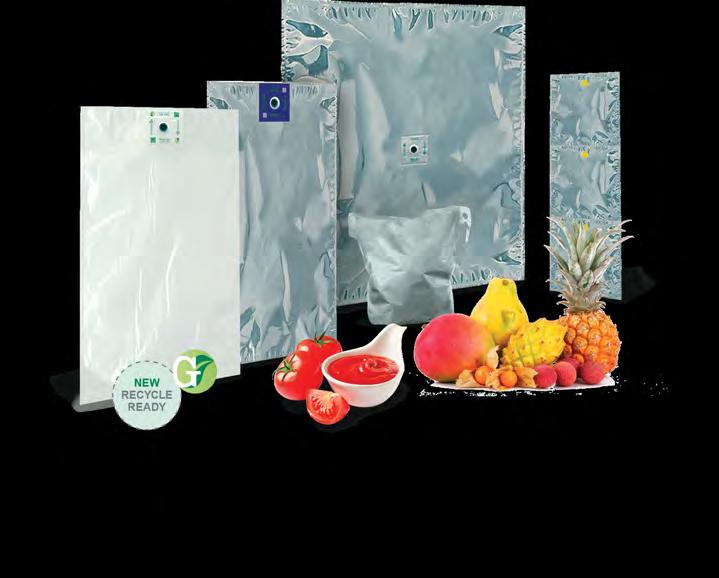
Un brand vicino al cliente ovunque nel mondo Fondata nel 1850 a Rho, in provincia di Milano, Goglio è oggi una realtà internazionale di riferimento nel settore del packaging flessibile, grazie a un approccio integrato che combina linee di confezionamento, laminati flessibili alta barriera, accessori plastici e servizi avanzati.
Grazie a nove stabilimenti produttivi e sei sedi commerciali e di assistenza in Europa, America e Asia, Goglio garantisce un supporto completo ai propri clienti, dalla progettazione alla messa in opera di sistemi di confezionamento e di imballaggio flessibile.
Tra i plus di Goglio, spiccano la capacità di anticipare le tendenze del settore, la scelta di materiali innovativi, la digitalizzazione e una forte attenzione all’ambiente. Goglio continua quindi ad evolversi come partner affidabile per l’industria del confezionamento di liquidi, combinando efficienza, qualità e sostenibilità per fornire risposte efficaci ai clienti più esigenti.
Materiali funzionali
In fatto di materiali, la proposta di Goglio si distingue per l’uso di laminati multistrato ad alta barriera e monomateriali “recycle ready” compatibili con i moderni sistemi di riciclo e per la personalizzazione con stampa di codici QR progressivi per la tracciabilità completa della filiera. Sul fronte delle linee di confezionamento, il sistema GNova (parte del brand Fres-co System®) consente il riempimento di buste preformate in asettico, hot-fill o ambiente, in un range di volumi compreso tra i 500 millilitri e i 10 litri.

Integrando le logiche di Industria 4.0, le linee GNova sono caratterizzate da un assetto modulare e supportano i servizi avanzati offerti dalla piattaforma IIoT Goglio MIND.
La proposta Goglio per il confezionamento di prodotti liquidi include, inoltre, la nuova linea G18 W, una riempitrice automatica verticale (VFFS) per formati bag-in-box: una soluzione altamente efficiente e vantaggiosa dal punto di vista economico per elevati volumi di produzione.
Innovative and sustainable, the Fres-co Aseptic System® is the cornerstone of Goglio’s aseptic packaging solutions for liquid and pumpable foods.
Fres-co Aseptic System® combines sterile spouted packs with automated packaging lines, preserving product freshness and ensuring long-term shelf stability. For the liquid food industry, Goglio offers a wide range of aseptic packaging solutions, including bag-in-boxes from 3 to 20 litres, 220-litre bags and large-format big-bags up to 1,500 litres. All packaging is produced in contamination-controlled environments and sterilised using gamma rays. These solutions are ideal for liquid and pumpable food products such as fruit juices and concentrates, tomato-based and vegetable preserves, dairy products and other food preparations. They are specifically designed for
products that require an extended shelf life at room temperature, without the need for refrigeration or the use of preservatives and additives.
Functional materials and related lines
Goglio’s offering stands out for its use of high-barrier multilayer laminates and “recycle-ready” monomaterials that are compatible with modern recycling systems. It also offers advanced customisation with progressive QR code printing for complete traceability of the supply chain.
On the packaging side, the GNova system (part of the Fres-co System® brand) enables aseptic, hot-fill or ambient filling of pre-
A global brand close to its customers
Founded in 1850 in Rho, near Milan, Goglio is today a global leader in the flexible packaging sector. Its integrated approach combines complete packaging lines, high-barrier flexible laminates, plastic accessories and advanced services.
With nine production facilities and six sales and six offices across Europe, America and Asia, Goglio offers comprehensive support to its customers - from design to implementation - for flexible packing and packaging systems.
Goglio’s strengths lie in its ability to anticipate industry trends, its use of innovative materials, its commitment to digitalisation, and its strong focus on environmental sustainability. Goglio continues to evolve as a reliable partner in the liquid packaging industry, delivering efficient, high-quality and sustainable solutions to meet the needs of the most demanding customers.
formed pouches in volumes ranging from 500 millilitres to 10 litres.
In line with Industry 4.0 principles, the GNova lines feature a modular design and support the advanced services offered by the Goglio MIND IIoT platform.
Goglio’s offering for the packaging
of liquid products also includes the new G18 W line, a vertical form-fillseal (VFFS) automatic filler for bag-in-box formats. This solution is highly efficient, cost-effective and suitable for high production volumes.

Metsä Board
Nell’imballaggio l’innovazione può assumere forme e dimensioni diverse. Per un piccolo birrificio situato nella Finlandia meridionale, ad esempio, ha preso la forma di un motore di automobile, che non vede l’ora di dar prova di sé: un risultato ottenuto grazie a Metsä Board.

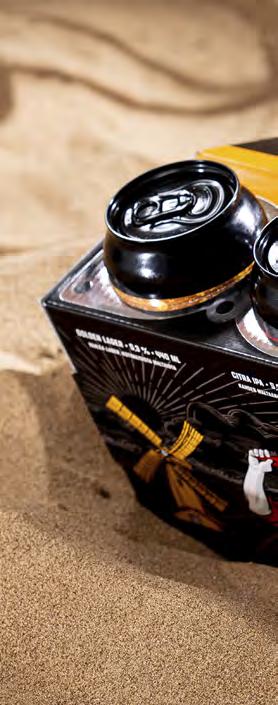
Testo a cura di Sami Anteroinen;
Photos
Miika Kainu
Olutmylly è un birrificio a conduzione familiare, nato nel 2018. Situato a Forssa, Finlandia, è focalizzato sulle birre artigianali, con capacità e know how per produrne 1.000 litri al giorno. Dopo un importante rebranding nel 2020, è consapevole di ciò che serve per avere successo in un mercato molto competitivo: non basta infatti avere un prodotto di prima qualità, bisogna anche dargli anche un’ottima visibilità a scaffale. Grazie alla collaborazione instaurata con il team visionario di Metsä Board il risultato è stato a dir poco straordinario.
«Ora, la confezione studiata per la degustazione delle nostre birre è la più bella tra i multipack in circolazione» afferma una sorridente Anne Silmälä, AD di Olutmylly.
L’idea di base è stata di presentare sei birre diverse della selezione Olutmylly, mettendo contemporaneamente più in risalto l’identità del marchio.
«Il design di Metsä Board offre un’esperienza visiva e funzionale completa» afferma Silmälä, ammettendo di essere rimasta “sbalordita” dall’idea. «L’aspetto della confezione è davvero unico e siamo molto felici che abbia soddisfatto in pieno le nostre aspettative più ambiziose». Anche secondo il mastro birraio Mikko Silmälä il progetto è stato un vero successo dall’inizio alla fine. «Le lattine risaltano come i pistoni di un motore e la selezione di birre è squisita» dichiara con soddisfazione.
Insomma, stando anche alle dichiarazioni del Graphic Packaging Designer Marko Leiviskä di Metsä Board «la collaborazione è stata un “matrimonio perfetto”. Partendo dall’idea iniziale
espressa a dicembre 2024, siamo riusciti a procedere molto rapidamente» afferma, attribuendo al piccolo birrificio il merito di essere stato molto reattivo e collaborativo: «le aziende di piccole dimensioni riescono a essere più flessibili in merito alle soluzioni di imballaggio e sono disposte a osare di più col design. E questo è stato anche il nostro caso».
Accelerazioni
Il progetto originale della confezione ideato da Leiviskä si ispirava al design del motore di un’auto, a forma di V, con spazio per sei bevande: una confezione perfetta per accendere i proverbiali motori degli appassionati di auto.
«Ho sentito che il design avrebbe avuto un forte impatto sulle persone a cui piace mettere a punto le auto e farsi ogni tanto un bicchiere. Solo in un secondo tempo - spiega - ho scoperto che Olutmylly aveva già alcuni clienti nel mondo degli sport motoristici e ho avuto la sensazione che tutto questo fosse un segno del destino» sorride Leiviskä. «In pratica, siamo riusciti a realizzare un prodotto davvero particolare per un pubblico molto speciale».
Per certo si tratta di un pubblico a cui piace gustare anche bevande ghiacciate. E, proprio a partire da questa considerazione, il progettista ha riservato uno spazio per integrare elementi eutettici refrigeranti nel design dell’imballaggio.
Essendo poi interamente realizzata in cartone, la confezione da sei è facile da trasportare, riciclare o anche da riutilizzare «dato che basta sostituire le lattine vuote con altre nuove».
Mikko Silmälä, il mastro birraio, sottolinea al proposito che il packaging, oltre al visual d’im-
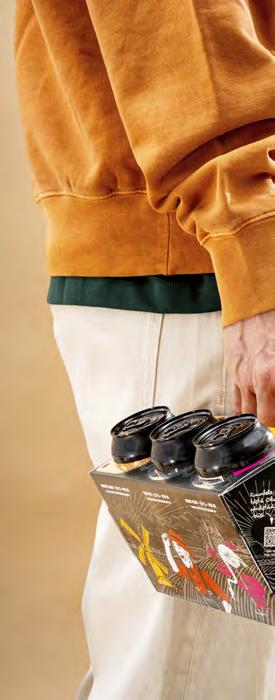
Specifiche della confezione. Realizzata in cartone ondulato (E-flute) utilizzando MetsäBoard Prime WKL 125 g/m2, 26 lb 1000 ft2 come rivestimento superiore e MetsäBoard Natural WKL Bright 120 g/m2, 25 lb/1000 ft2 come fluting e rivestimento interno.
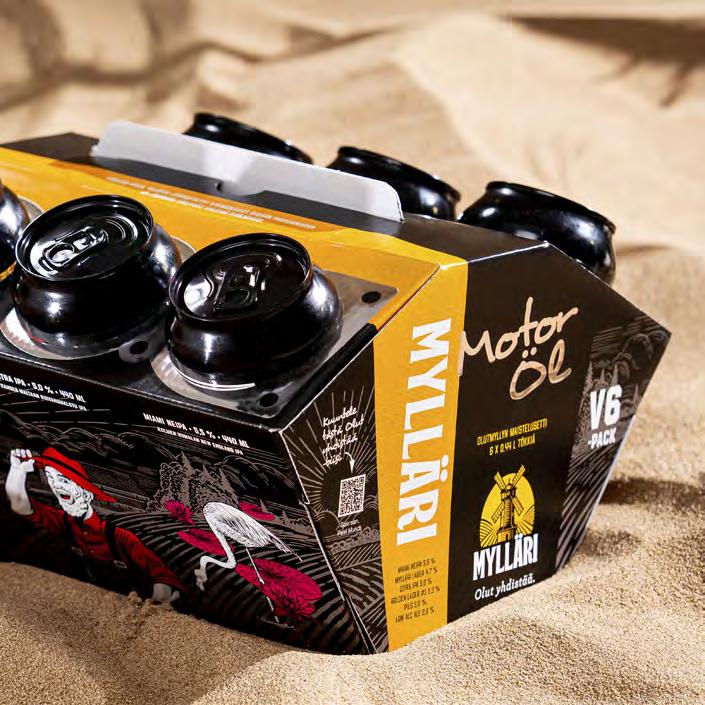
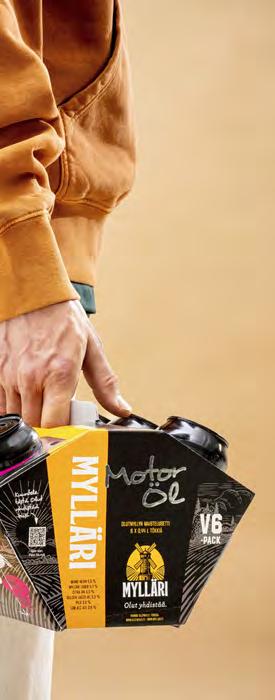
Key package specs.
Package is made of corrugated board (e-flute) using MetsäBoard Prime
WKL 125 g/m2, 26 lbs 1,000 ft2 as top liner and MetsäBoard
Natural WKL Bright 120 g/m2, 25 lbs/1,000 ft2 as fluting and inner liner.
patto e perfetto, è una soluzione pratica e solida dal punto di vista tecnico. «Ci siamo messi tutti al lavoro di buona lena e tutti hanno dato il massimo» afferma, ripensando agli sforzi di ricerca e sviluppo.
Impegno totale del team
Sotto la guida di Leiviskä, altri membri del team di progettazione Metsä Board hanno fornito un contributo significativo: Iiro Numminen ha elaborato i progetti strutturali e Joni Myyryläinen ha eseguito i test di pressione e resistenza. «Tutto ciò che facciamo è frutto di un lavoro di squadra» afferma Leiviskä, che mette in campo 30 anni di esperienza in comunicazioni di marketing. «Il team che si occupa della progettazione dell’imballaggio condivide sempre una visione d’insieme, concentrando l’attenzione sul concetto stesso di imballaggio, di cui valutiamo sempre la fattibilità complessiva: come sarà l’esperienza dell’utente, quali sono i problemi principali dal punto di vista della funzionalità e del design, quali i problemi logistici da affrontare».
Il lancio ufficiale in primavera
Dopo aver inviato alcune confezioni da degustazione di birra a un gruppo scelto di clienti, il lancio ufficiale del prodotto è avvenuto a maggio 2025. Come afferma Anne Silmälä «La nostra nuova confezione ha suscitato molto interesse nel settore, e abbiamo ricevuto grandi apprezzamenti anche per il design della confezione da sei». D’altronde, per sopravvivere in un mercato altamente competitivo, è imprescindibile differenziare il proprio prodotto.
«Sugli scaffali dei supermercati ci sono bevande di qualsiasi forma, dimensione, colore e stile. Per distinguersi serve un approccio visivo davvero innovativo» sostiene l’AD.
Concorda con lei Marko Leiviskä: oggi le soluzio-
Metsä Board a Fachpack 2025 Azienda leader in Europa nella produzione di cartoncini in fibra vergine e parte del Gruppo Metsä, Metsä Board presenterà i suoi cartoncini leggeri premium e i servizi completi in fiera a Norimberga (Pad4A, Stand 116) dal 23 al 25 settembre. Per l’occasione, saranno fornite informazioni sull’investimento di 60 milioni di euro che Metsä Board sta attualmente realizzando presso lo stabilimento di Simpele dove, a ottobre, entrerà in funzione una nuova linea di patinatura all’avanguardia. L’ammodernamento porterà significativi vantaggi in termini di qualità di stampa, consentendo di realizzare imballaggi ad alte prestazioni e di sicuro impatto sugli scaffali di negozi e farmacie. Inoltre, si prevede che, sempre a Simpele, l’utilizzo di energia priva di combustibili fossili in produzione aumenterà dall’89% al 98% entro la fine del 2025, a supporto degli obiettivi di riduzione dell’impatto ambientale.
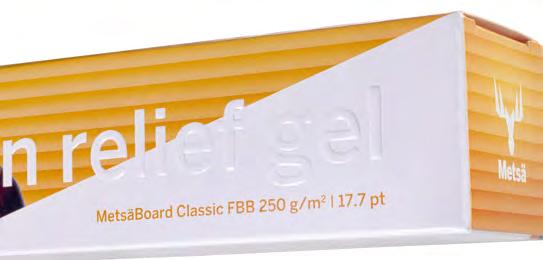
ni di imballaggio possono essere determinanti per rafforzare il marchio, creare consapevolezza e fidelizzare i clienti. «Quando un prodotto si discosta in modo positivo dalla norma, le vendite aumentano. Inoltre, un imballaggio accattivante e che non passa inosservato concorre anche a posizionare il prodotto in una fascia di prezzo più elevata» afferma. «Fuori, c’è ancora un grande potenziale da sfruttare».
Co-creazione di livello superiore ad Äänekoski
Metsä Board gestisce un Excellence Centre all’avanguardia ad Äänekoski, Finlandia, per accelerare l’innovazione del cartone e dell’imballaggio.
Presso l’Excellence Centre, il team di progettazione degli imballaggi si impegna a migliorare la sostenibilità ottimizzando il design, i materiali e la riciclabilità degli imballaggi. Un altro obiettivo fondamentale è affrettare il lancio dei prodotti accelerando la prototipazione e i test.
Inoltre, il team di progettazione dell’imballaggio è sempre alla ricerca di modi per aumentare l’efficienza produttiva, concentrandosi al contempo su un design che sia davvero accattivante per i consumatori.
Ilkka Harju, Packaging Services Director di Metsä Board, afferma che “l’ingrediente segreto” dell’Excellence Centre è la co-creazione. «Lavorando a stretto contatto con il cliente, possiamo trovare le soluzioni di imballaggio migliori. La collaborazione con Olutmylly ne è un ottimo esempio».
Metsä Board
Packaging innovation can take many shapes and sizes. For a small South Finland brewery, innovation took the form of a motorbike engine, raring to go: a result achieved thanks to Metsä Board.
Olutmylly is a family brewery founded in 2018. Focussed on domestic craft beers, it is operating in Forssa (Finland), with capacity and expertise to brew 1,000 litres of beer per day. With a major rebranding in 2020, the brewery is acutely aware of what it takes to make it in a very competitive market - not only do you need a top-notch product, you also have to “make it pop” in the store. Fortunately, Olutmylly was able to connect with the visionary graphic packaging team at Metsä Board. The result: nothing short of extraordinary.
«Our new beer tasting package is the coolest six-pack around» grins Anne Silmälä, the Managing Director of Olutmylly. The core idea of the package is to showcase six different beers from the Olutmylly selection, while taking brand identity to another level.
“The Metsä Board design delivers the total visual and functional experience,” Silmälä says, while admitting to having been “blown away” by the idea.
“The vision for the package was unique, and we’re just so happy that the execution meets the high expectations that were set.”
Brewmaster Mikko Silmälä remarks that the project was a real winner, from start to finish. “The cans pop like pistons in an engine, and the beer selection is exquisite,” he muses.
Graphic Packaging Designer Marko Leiviskä from Metsä Board says the collaboration was a “match made in heaven”.
“Starting with the initial idea in December 2024, we were able to proceed very fast,” Leiviskä says, crediting the small brewery for being quick on their feet.
“Smaller companies can be more flexible with packaging solutions and willing to stand out more when it comes to design. This was certainly the case here,” he looks back.
Leiviskä’s original package design was that of a motorbike engine, shaped like a V, with room for six beverages. This was definitely the ultimate six-pack to start the proverbial engines of motorheads, Leiviskä thought.
“I felt that the design would resonate very strongly with people who like to tune-up cars and enjoy a drink every now and then,” he says.
“Then I found out that Olutmylly already had customers in the motor sports community - and all of this started to feel like it was meant to be,” Leiviskä laughs. “We were able to make a really specific product for a really specific crowd,” he says. That’s certainly a crowd that likes their drinks ice-cold, too. In recognition of this, Leiviskä made room for cooler packs to be integrated into the design. In addition, the sixpack is easy to carry and recycle - being 100 per cent paperboard. “It’s easy to reuse as well, since you can simply replace the cans you drink with new ones.”
Mikko Silmälä notes that the package is not only a visual homerun - it’s also a technically rock-solid, practical solution.
“We really got a good momentum going, with everybody bringing their best to the table,” he looks back at the R&D effort.
Total team effort
With Leiviskä at the wheel, other members of the Metsä Board design team also contributed: Iiro Numminen drew up structural designs, and Joni Myyryläinen performed pressure and strength tests.
“Everything we do is a team effort,” Leiviskä says.
The packaging design team is also always looking at the bigger picture: the focus is on the packaging concept itself.
“We always evaluate the concept’s over-all viability - what the user experience is going to be like, what issues are key from the functionality and design perspective, what logistical concerns have to be addressed,” lists Leiviskä, who has almost 30 years of marketing communications experience.
Spring launch
Anne Silmälä reports that some beer tasting packages have been shipped to selected customers, with the official product launch in May 2025.
“The beer tasting package has raised a lot of interest in the fieldand the design of the six-pack is frequently praised, too,” Silmälä says.
According to the Managing Director, differentiating your product is a “lifeor-death issue” in a highly competitive market.
“Looking at the supermarket shelf, there’s beverages of all shapes, sizes, colours and styles. It really takes a ground-breaking visual approach to stand out,” she believes.
Marko Leiviskä agrees: packaging solutions today can go a long away to boosting the brand and creating customers’ awareness and loyalty.
“Sales go up when the product breaks from the norm in a positive way. Eye-catching, memorable packaging also supports a higher price position,” he says.
“There’s still plenty of potential out there for us to tap into.”
Next-level co-creation at Äänekoski Metsä Board runs a state-of-the-art Excellence Centre in Äänekoski in Finland, to accelerate paperboard and packaging innovation. At the Excellence Centre, the packaging design team strives to improve sustainability by optimising packaging design, materials and recyclability. Another key aim is to accelerate product launches through faster prototyping and testing.
Furthermore, the packaging design team is always looking for ways to boost production efficiency, while zeroing in on packaging design that really appeals to consumers.
Metsä Board’s Packaging Services Director Ilkka Harju says that the Excellence Centre’s “secret sauce” is co-creation.
“By collaborating closely with the customer, we can discover the best packaging solutions. The Olutmylly collaboration is a great example of this,” Harju says.
Metsä Board at FACHPACK 2025
Metsä Board, a leading European producer of fresh fibre paperboards and part of Metsä Group, will present its premium lightweight paperboards and 360 Services at FACHPACK 2025, on 23-25 September in Nuremberg, Germany (Hall 4A, Stand 116).
Visitors to the stand can learn about Metsä Board’s ongoing EUR 60 million investment at the Simpele mill, where a new state-of-the-art coating line is set to start up in October 2025. This upgrade will bring significant benefits in print quality, enabling high-performance packaging that stands out on store and pharmacy shelves. In addition, the use of fossil-free energy in production at the Simpele mill is expected to rise to 98% from 89% by the end of 2025, supporting Metsä Board’s 2030 fossil-free targets.
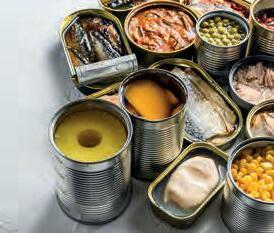


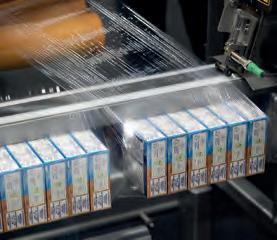
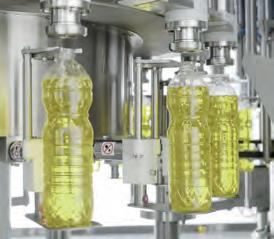
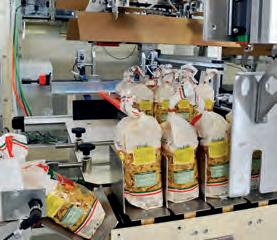
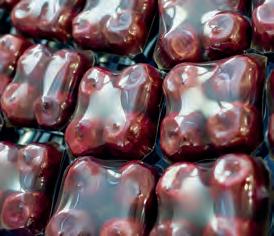
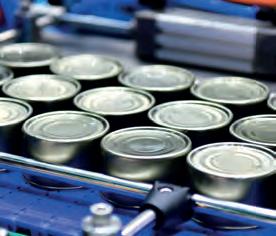
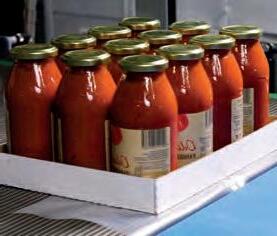

Ridurre l’impatto ambientale senza rinunciare a qualità e funzionalità con le soluzioni iTap
CORTO, il nuovo rubinetto per imballaggi flessibili firmato iTap è una soluzione che incarna la filosofia aziendale, da sempre orientata all’innovazione responsabile fin dalla sua fondazione nel 2014.
Qualità 100% Made in Italy per il food and beverage
Il nuovo prodotto iTap introduce sul mercato una nuova generazione di rubinetti in plastica per tutte le categorie di imballaggio flessibile, con l’obiettivo di garantire un’erogazione pratica, sicura e durevole per una vasta gamma di liquidi. Dai succhi di frutta ai detergenti, dai prodotti per la cura della persona fino ai liquidi alimentari, i rubinetti iTap offrono da sempre un’esperienza d’uso intuitiva e affidabile. Ogni rubinetto viene progettato, prodotto e assemblato nello stabilimento italiano di iTap dotato delle certificazioni BRCGS e ISO14001. Un approccio che assicura i più elevati standard di eccellenza e la massima sicurezza alimentare.
Un’integrazione strategica per un’ampia gamma di soluzioni
Nel 2023, iTap è entrata a far parte di Giflor Closure Technologies, azienda italiana leader nella produzione di chiusure in plastica stampate a iniezione. Grazie a questa sinergia, iTap ha ampliato la propria presenza nei mercati alimentare,
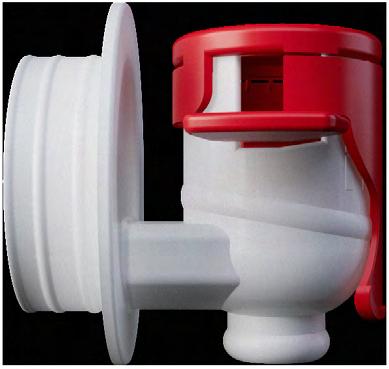
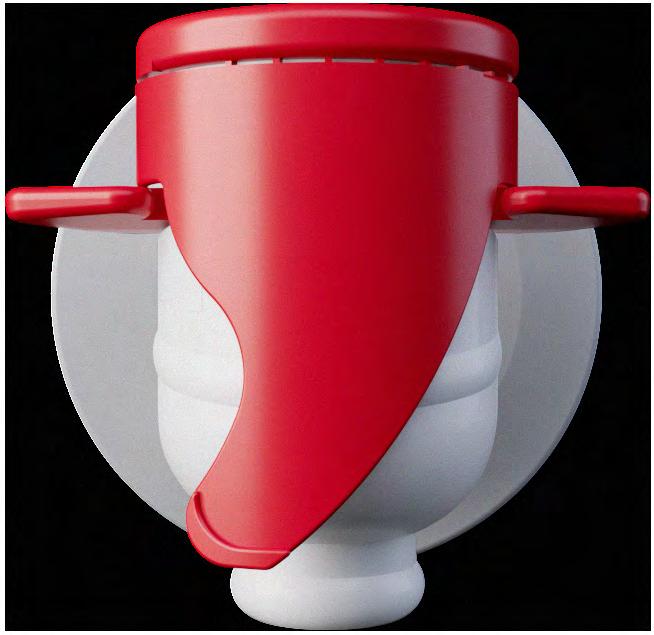
cosmetico e del pet care, rafforzando ulteriormente la propria vocazione verso una sempre maggiore un’eco-responsabilità.
Nel corso degli anni, iTap ha sviluppato una gamma versatile di prodotti, che include l’iconico iTap CLASSIC e l’innovativo iTap SOLO, quest’ultimo pienamente conforme alla Direttiva SUP (SingleUse Plastics) dell’Unione Europea. Si tratta di rubinetti che garantiscono prestazioni affidabili per un’ampia varietà di applicazioni, con particolare attenzione a durata, sicurezza e sostenibilità.
CORTO: tra design e sostenibilità
In un contesto certificato e compliant ai più elevati standard internazionali è nato CORTO, un rubinetto evoluto che unisce design compatto a una forte attenzione alla sostenibilità.
Progettato per aiutare produttori di packaging e brand ad affrontare i futuri requisiti del PPWR, CORTO consente una riduzione de contenuto in plastica del 22% e una diminuzione del 60% dell’aria residua all’interno dell’imballaggio, due fattori che contribuiscono a prolungare la shelf life del prodotto e a limitarne l’ossidazione. Il tutto senza rinunciare alla proverbiale ermeticità e resistenza che contraddistinguono l’intera gamma iTap.
Con CORTO, iTap conferma il proprio ruolo di pioniere nelle soluzioni di chiusura per imballaggi flessibili: un prodotto che guarda al futuro e aiuta l’industria a rispondere alle nuove esigenze in termini di sostenibilità ambientale e di conformità normativa.
Reducing environmental impact without compromising on quality and functionality with the iTap solutions
CORTO, the new tap for flexible packaging from iTap is a solution that perfectly embodies the company’s philosophy of responsible innovation embodied since its foundation in 2014.
100% Made in Italy for food and beverage
The new iTap solution introduced a new generation of plastic taps for all categories of flexible packaging to ensure practical, safe, and long-lasting dispensing for a wide variety of liquids. From fruit juices to household cleaners, from personal care products to foodgrade liquids, iTap taps have always provided an intuitive and reliable user experience. Each tap is designed, manufactured, and assembled at iTap’s facility in Italy which is a BRCGS and ISO14001 certified environment. This approach guarantees the highest standards of excellence and maximum food safety.
A strategic integration to ensure e wide range of products
In 2023, iTap became part of Giflor Closure Technologies, an Italian company that leads the market in producing injection-moulded plastic closures. This synergy has allowed iTap to expand its presence in the food, cosmetic, and pet care markets, strengthening its commitment to eco-responsibility. Over the years, iTap has developed a versatile product range, including the iconic iTap CLASSIC and the innovative iTap SOLO, fully compliant with the EU Single-Use Plastics (SUP) Directive. These taps offer proven performance for a wide variety of applications, with a focus on durability, safety, and sustainability.
CORTO: between design and sustainability
CORTO was born in a certified and compliant to international standards environment to deliver an advanced tap that combines a compact design with a strong focus on sustainability. Designed to help packaging manufacturers and brands address the upcoming PPWR requirements, CORTO enables a 22% reduction in plastic used and a 60% decrease in residual air inside the packaging— factors that help extend product shelf life and limit oxidation. All this while maintaining the renowned airtightness and durability of the iTap product range.
With CORTO, iTap reaffirms its role as a pioneer in closure solutions for flexible packaging. This product looks to the future and helps the industry meet evolving environmental and regulatory expectations.


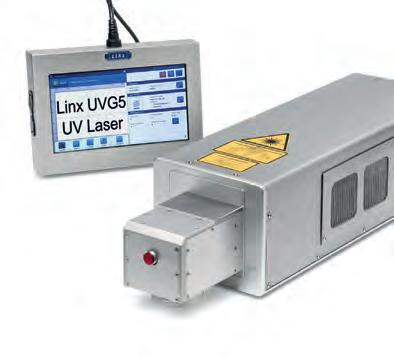
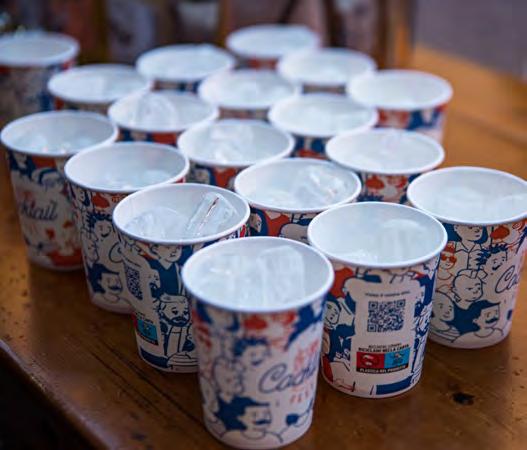

Da ILIP una nuova soluzione doppia barriera per il take away di bevande -anche alcoliche - servite con ghiaccio.
La linea FibrAware® Personalizzato di ILIP si arricchisce di una nuova proposta per il mondo del take away e del consumo on-the-go: bicchieri in cartoncino con doppia barriera PE, ideali per contenere bevande fredde con ghiaccio e alcoliche come granite, aperitivi e cocktail. Progettati per rispondere alle esigenze del mercato e agli stili di vita più contemporanei, questi bicchieri sono perfetti per l’asporto, garantendo resistenza, sicurezza e un’eccellente resa grafica. Disponibili in tre formati (300 ml, 445 ml e 530 ml), possono essere completati da un coperchio in carta o PS.
La possibilità di realizzare stampe in quadricromia sull’intera superficie, fa di FibrAware® Personalizzato un potente strumento di comunicazione visiva per i brand, senza dimenticare la sostenibilità. Dopo l’uso, infatti, i bicchieri possono essere smaltiti nella raccolta differenziata della carta.
» Sicurezza alimentare in qualsiasi forma!
Customised FibrAware® ILIP presents a new double-barrier solution for take-away beverages, including alcoholic drinks, served with ice.
Expanding its Customised FibrAware® range, ILIP presents an innovative option for take-away and on-the-go consumption: cardboard cups with a double PE barrier, ideal for containing ice-cold beverages - both non-alcoholic and alcoholic - such as slushies, aperitifs and cocktails.
Designed to meet the needs of modern consumers and lifestyles, these cups offer outstanding strength, safety and visual appeal, making them a perfect choice for take-away applications. Available in three sizes (300 ml, 445 ml and 530 ml), the cups can be paired with either paper or polystyrene lids. Thanks to four-colour printing on the entire surface, Customised FibrAware® cups are a powerful tool for brand visibility and communication, while also being environmentally friendly. In fact, after use, they can be disposed of in paper recycling.

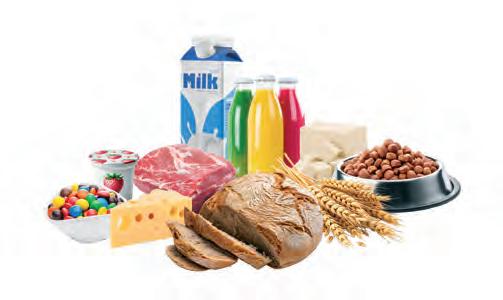

Trovate la vostra soluzione!
Preparati ad affrontare corpi estranei ed errori di peso dei prodotti.
Lo sapevi che un richiamo alimentare su quattro è causato dalla contaminazione di corpi estranei? Le nostre soluzioni sono progettate per tenere al sicuro da contaminazioni, e non solo, il tuo marchio, i tuoi prodotti e i tuoi consumatori. Dalla pesatura degli ingredienti, alla verifica delle ricette e delle quantità di riempimento, fino all’ispezione dell’imballaggio finale. Siamo qui per te: per la sicurezza alimentare in qualsiasi forma!
ACMA CW 1400
Con una capacità fino a 1.400
pezzi al minuto, la soluzione ACMA definisce un nuovo standard per produttività, qualità e sostenibilità.
Interamente progettata e realizzata in Italia da ACMA, azienda del gruppo Coesia e storica realtà del packaging Made in Italy, l’avvolgitrice ad alta velocità CW 1400 unisce precisione e innovazione in una soluzione pensata per accompagnare l’evoluzione del settore dolciario, con un occhio sempre attento all’eccellenza.
Studiata per rivoluzionare il confezionamento di cioccolatini e caramelle, la CW 1400 si distingue per le performance elevate e la cura con cui tratta il prodotto. Il sistema a tre teste di incarto a movimento continuo permette infatti di preservare l’integrità anche alle velocità più elevate, garantendo confezioni impeccabili.
Versatile, digitalizzata, flessibile e...
La CW 1400 è in grado di gestire prodotti a base piana o sferici, con stili di incarto doppio fiocco, doppio fiocco protetto e bunch, offrendo massi-
ma flessibilità a produttori di ogni scala. Progettata per semplicità d’uso e manutenzione rapida, presenta un design a sbalzo che rende accessibili tutte le aree per ispezioni e interventi tecnici. La struttura modulare e la funzione “No Product - No Wrapping” riducono i tempi di fermo e lo spreco di materiale, anche in condizioni di produzione intensiva.
Altro punto di forza è l’integrazione digitale: la macchina è predisposta per il monitoraggio delle prestazioni in tempo reale e include funzionalità di manutenzione predittiva basate su intelligenza artificiale. Tra le opzioni disponibili, anche un sistema di visione per l’ispezione qualità e un modulo con quarto rullo per lo scarto selettivo, in grado di garantire il controllo qualità del 100% della produzione.
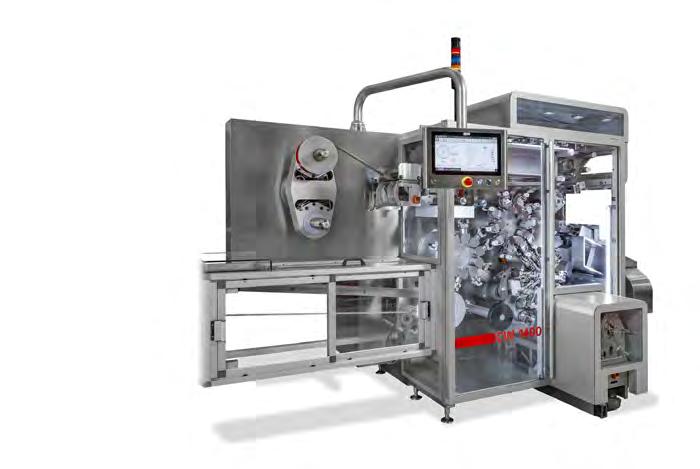
compatta con tramoggia e disco. Per i prodotti a base piana, il sistema LCF (trave di alimentazione a basso contatto) con nastri temporizzatori e giunto mobile assicura allineamento e flusso costante.
... sostenibile
Per quanto riguarda l’alimentazione, la CW 1400 si adatta a diverse configurazioni: per i prodotti sferici è disponibile il sistema VL (robotico, per il picking da vassoio) o, in alternativa, una soluzione

With a capacity of up to 1,400 pieces per minute, ACMA’s solution sets a new standard in productivity, quality, and sustainability.
Entirely designed and manufactured in Italy by ACMA - a Coesia company and historic name in Italian packaging - the high-speed CW 1400 wrapping machine blends precision and innovation to support the confectionery industry’s evolution, with a constant eye on excellence.
Specifically engineered for wrapping chocolates and candies, CW 1400 stands out for its outstanding performance and gentle product
handling. Its continuous-motion triple-head wrapping system maintains product integrity even at the highest speeds, ensuring flawless packages.
Versatile, digitalized, flexible and... CW 1400 handles both flat-based and spherical products, supporting double twist, protected double twist, and bunch wrapping styles. This offers maximum flexibility to producers of all sizes. Designed for
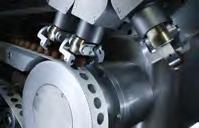
Anche la sostenibilità è al centro del progetto CW 1400. La macchina è infatti compatibile con packaging monomateriale e a base carta, permettendo ai produttori di rispondere alle esigenze ambientali senza rinunciare alla qualità.

ease of use and fast maintenance, the machine features a cantilevered structure for full access to all areas for inspection and service. Its modular design and “No ProductNo Wrapping” function help minimize downtime and material waste, even during high-intensity production. Another key strength is digital integration: the machine is equipped for real-time performance monitoring and includes AI-based predictive maintenance features. Available options also include a vision system for quality inspection and a fourth roller with selective ejection, ensuring 100% quality control of the output.
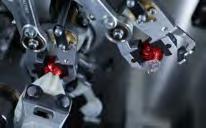
As for feeding systems, CW 1400 is adaptable to different configurations: for spherical products, either the VL robotic tray-picking system or a compact hopper-and-disk solution is available. For flat-based products, the LCF (Low Contact Feeding) system with timing belts and a mobile joint ensures consistent alignment and flow.
... sustainable
Sustainability is also a core focus of the CW 1400 project. The machine is compatible with paper-based and mono-material films, allowing producers to meet environmental goals without compromising quality.

Un progetto internazionale valorizza l’eccellenza di Cama, fornitore di macchine e linee per il confezionamento secondario e terziario.

Il progetto promosso dalla multinazionale statunitense Kraft Heinz, proprietaria del marchio Plasmon, ha interessato diverse fasi della produzione di purea di frutta e snack a base di carne o vegetali, realizzati dello storico stabilimento di Latina: dalla selezione di materie prime di origine italiana al 100%, ai processi di cottura e riempimento, dove si è passati dal tradizionale sistema termico al riempimento asettico. Un cambiamento che ha avuto un impatto significativo sulle linee produttive, portando vantaggi in termini di efficienza energetica, tema critico e strategico per le aziende manifatturiere.
Il progetto è un esempio virtuoso di massima collaborazione tra cliente e fornitore, in cui Cama ha messo a disposizione il proprio knowhow a supporto del processo: dalla progettazione delle scatole shelf-ready, alla scelta dei materiali, con piena soddisfazione del cliente. «Singoli pouch di diversi formati, da 85 a 220 grammi, vengono confezionati verticalmente in scatole da quattro a sei unità, che svolgono
anche la funzione di vassoio per la vendita delle singole confezioni» spiega Sergio Cornago, Sales Manager di Cama.
«Le scatole possono essere confezionate in un contenitore più grande che svolga sia la funzione di espositore per il punto vendita che quella di imballaggio terziario per il trasporto su pallet. Il cliente formula una richiesta al nostro team di System Engineering, che
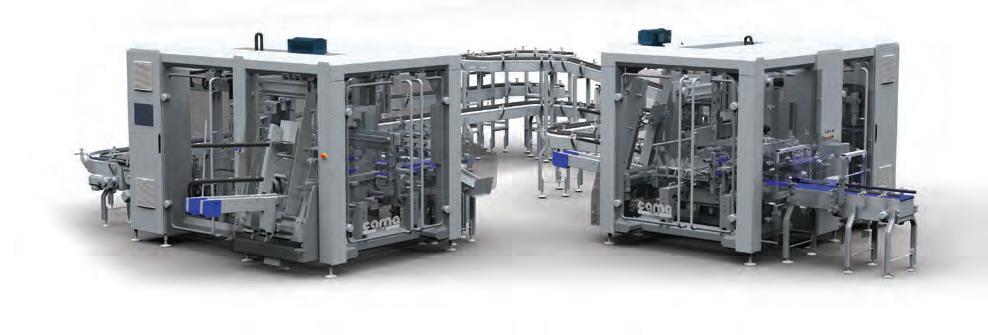
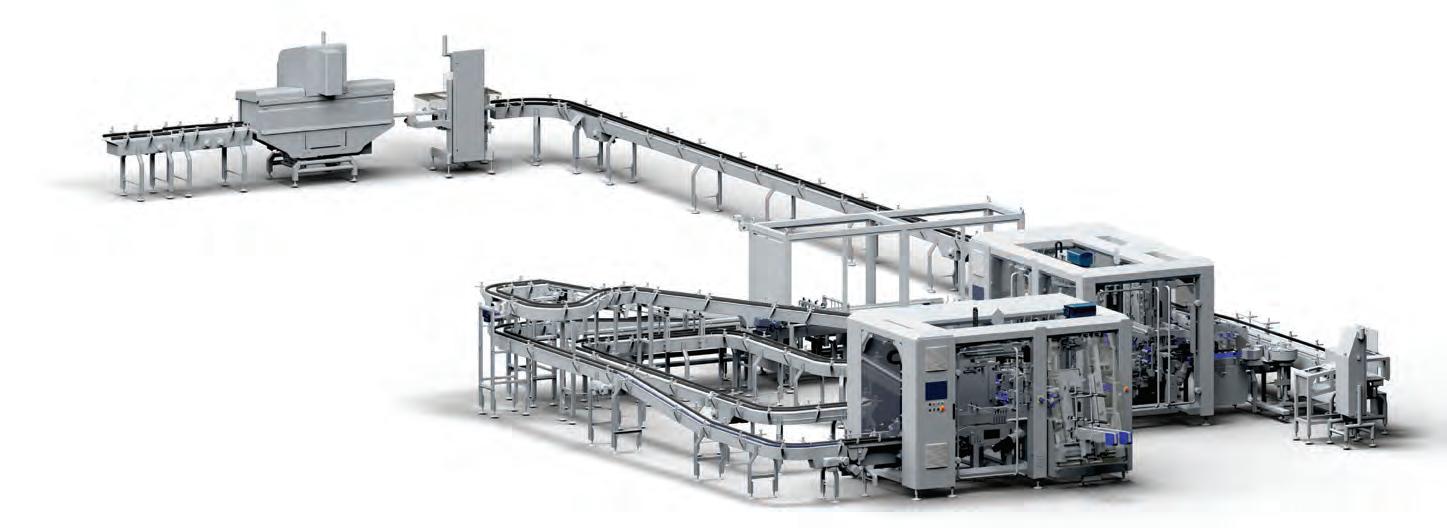
An international project highlights the excellent quality of Cama, a supplier of secondary and tertiary packaging machines.
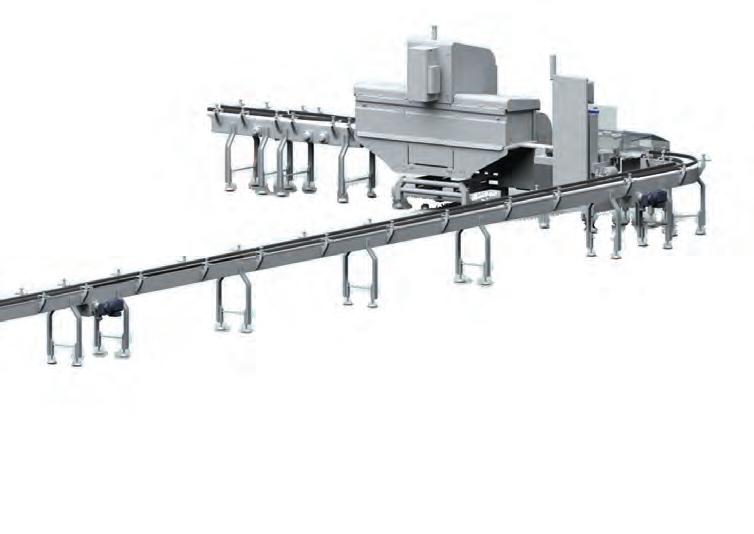
The project by the U.S. multinational Kraft, owner of the Plasmon brand, covered various steps of the fruit purée and meat and vegetable snack production chain in the brand’s Latina plant, from the selection of 100% Italian raw materials to the cooking and filling processes, with a shift from the traditional thermal system to aseptic filling. This change has had a significant impact on the production lines, bringing advantages on the energy efficiency front, which today is both critical and strategic for manufacturing companies.
The project is a positive example of maximum cooperation between client and supplier, in which Cama has provided its know-how to support the entire process, from the design of shelf-ready boxes to selecting the material, with the full satisfaction of the customer.
“Single pouches of different formats - from 85 grams to 220 grams - are packed vertically in boxes of 4 - 6 units, which can also be used as trays for the sale of loose pouches”, explains Cama Sales Manager Sergio Cornago.
“In turn, cases can be packed in a larger box, which can also be used both as a display unit for stores and as tertiary packaging for transport on pallets. When a client submits a request, our System Engineering team develops a design able to meets the requirements of their project and compatible with the machines that will process the packaging”.
The in-house development of packaging solutions and a wide range of Side Loading and Top Loading machine types for the creation of highly creative packaging solutions are two of the advantages that allow Cama to excel on the packaging machine manufacturing scene.
sviluppa una soluzione progettuale capace di soddisfare le esigenze del progetto, risultando compatibile con le macchine che gestiranno il confezionamento».
Lo sviluppo interno delle soluzioni di packaging e un’ampia gamma di macchine - Side Loading e Top Loading - per la realizzazione di soluzioni di confezionamento altamente creative sono due tra i plus di Cama nel panorama dei costruttori di macchine per imballaggio.
Fondata nel 1975, Imball celebra nel 50 anni di attività, confermandosi tra i protagonisti nella progettazione e produzione di macchine per il confezionamento cartotecnico primario, secondario e di fine linea.
L’azienda ha sviluppato negli anni cambi formato semplici e automatici, puntando su flessibilità, compattezza e automazione. Le sue soluzioni sono ideali anche per chi lavora in spazi ridotti, senza rinunciare a prestazioni elevate.
Imball offre una gamma completa di macchine, dalla formatura alla chiusura delle confezioni, con particolare attenzione alle esigenze del settore food & beverage.
Cinquant’anni di esperienza e visione rendono Imball un partner solido e affidabile, capace di affrontare le sfide dell’industria moderna.

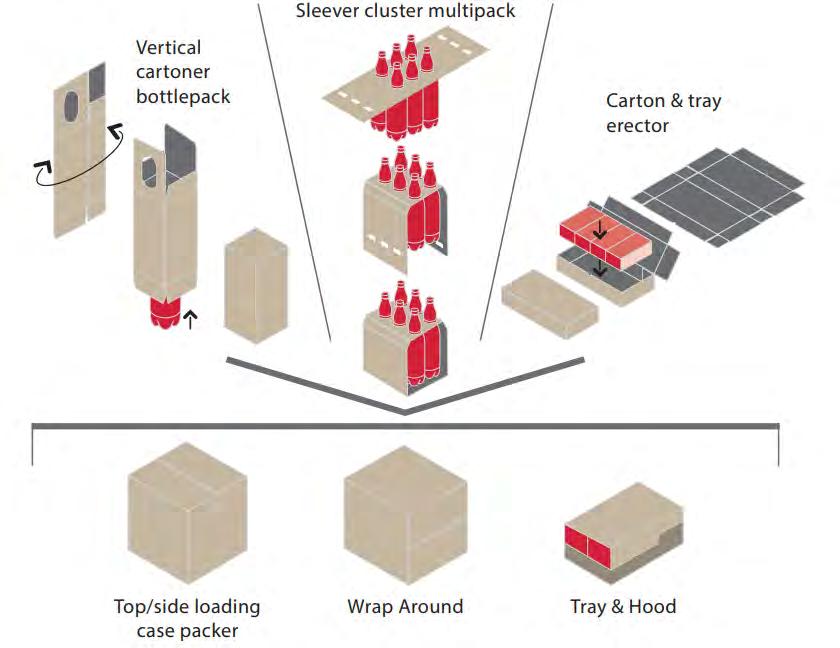

Founded in 1975, Imball is celebrating 50 years in business, confirming its position as one of the leading players in the design and production of primary, secondary and end-of-line packaging machines.
Over the years, the company has developed simple and automatic format changes, focusing on flexibility, compactness and automation. Its solutions are also ideal for those working in small spaces, without sacrificing high performance.
Imball offers a comprehensive range of machines, from forming to package closing, with a focus on the needs of the food & beverage sector.
Fifty years of experience and vision make Imball a solid, reliable partner, able to rise to the challenges of modern industry.

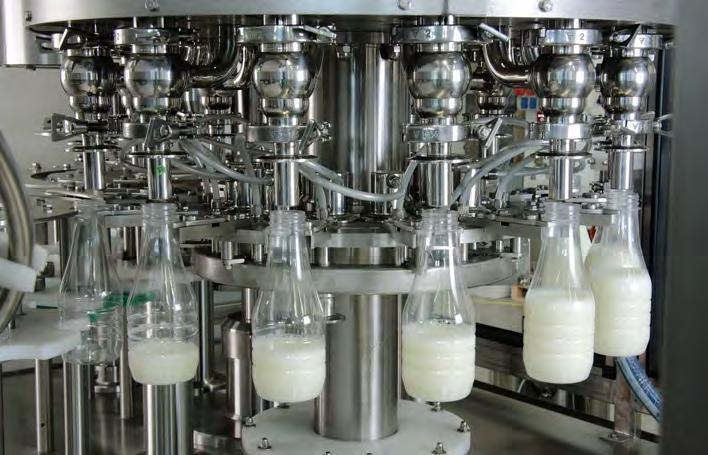
Focus sul food and beverage tra mercati esteri, sostenibilità e importanti partnership tecnologiche
resente in numerosi mercati esteri tra bacino del mediterraneo, medio oriente, sud America e Australia, CMI industries offre ai propri clienti una efficiente copertura dei mercati esteri sia per il suo core business che per i segmenti in cui è attiva, che oltre al riempimento chimico, al parafarmaceutico e al cosmetico, includono anche il food and beverage.
In vista della prossima partecipazione a Fachpack, dove è prevista l’esposizione di due macchine, una riempitrice per prodotti corrosivi e una tappatrice monotesta, il CEO Davide Comoli, fa il punto sulla capacità dell’azienda di presidiare con successo i mercati esteri. Protagonisti, i punti di forza che spaziano dalla versatilità, alla capacità di offrire soluzioni tailor made, dalla velocità alla precisione, due plus che rendono l’azienda una scelta vincente rispetto all’offerta dei concorrenti.
“Velocità e precisione sono essenziali nel nostro mercato” sottolinea Davide Comoli, CEO di CMI “un elemento che ci rende competitivi rispetto ai concorrenti di Turchia e Cina. Siamo presenti anche nel mercato africano sia nel bacino del mediterraneo e Maghreb sia in centrafrica oltre alla presenza in Sud Africa e all’apertura verso il

Medio Oriente. Abbiamo infatti una nuova rappresentanza a Dubai dove pensiamo di partecipare ad alcune delle principali fiere di settore come Gulfood e Saudi Food Show. Quanto al continente americano, ci stiamo affacciando con un nuovo agente in Messico, con l’obiettivo di aprire a nuovi mercati nell’area”.
Versatilità e sostenibilità per il F&B
La forza di CMI Industries è il risultato di tecnologie di successo per mercati molto diversi tra cui il food and beverage, dove spicca in particolare la competenza nella gestione di prodotti e formati estremamente variabili imposta dal settore chimico.
“Siamo in grado di gestire qualunque tipo di prodotto” sottolinea ancora Davide Comoli “cremoso, viscoso, liquido, con uno spin off alimentare nel mercato delle creme spalmabili, marmellate e miele e nel beverage, in cui operiamo con partner specializzati.”
Un punto di forza di CMI è infatti la capacità di fornire linee complete chiavi in mano, grazie a una rete di partner specializzati che permettono all’azienda di seguire il cliente in ogni fase del
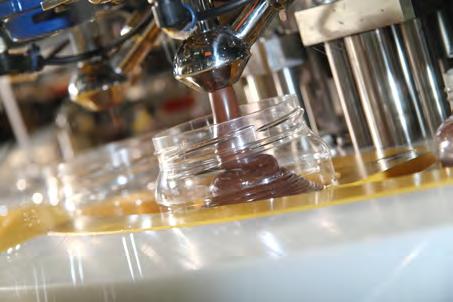
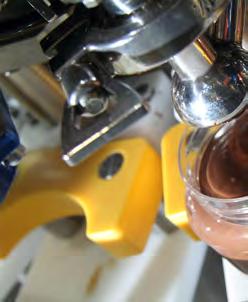
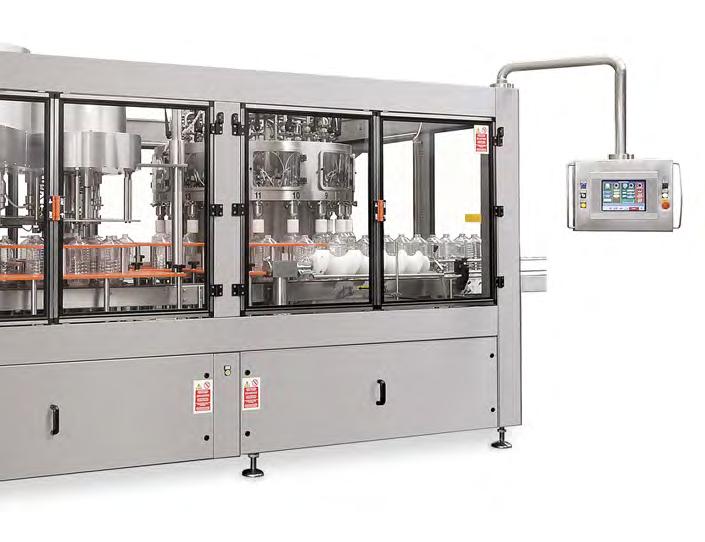
percorso, dalla stesura del layout all’acquisto di macchinari per l’integrazione della linea fino a FAT e SAT con montaggio e testing svolti prima in azienda e poi presso il cliente.
L’ecosistema di fornitura è inoltre pensato per abbattere drasticamente costi ed emissioni, grazie a una filiera corta fatta di partnership legate al territorio. Un elemento di sostenibilità che si somma ad altri, come sottolinea Davide Comoli che conclude:
“Le macchine CMI sono oggi per la maggior parte equipaggiate con sistemi elettronici avanzati. Per alcune di queste tipologie, ci avvaliamo della solida collaborazione con Bosch Rexroth, i cui componenti permettono una gestione precisa e flessibile delle funzioni macchina direttamente da pannello. Un esempio è la possibilità di impostare e salvare differenti profili di tappatura, ma le applicazioni sono molteplici: dalla regolazione automatica dei parametri di processo, al monitoraggio continuo delle performance operative, fino alla manutenzione predittiva. Queste soluzioni non si limitano alla diagnostica, ma sono parte integrante della strategia di sostenibilità dell’azienda. L’approccio ESG è infatti un driver fondamentale per CMI, che punta su dati misurabili lungo tutta la filiera per sviluppare tecnologie sempre più efficienti ed ecofriendly. Un esempio concreto è rappresentato dai nostri sistemi di lavaggio, progettati per ridurre drasticamente i tempi e il consumo di acqua in una fase chiave del processo produttivo: la sanificazione dell’impianto.”


CMI Industries
Focus on the food and beverage industry: foreign markets, sustainability and important technological partnerships
Present in numerous foreign markets in the Mediterranean basin, the Middle East, South America and Australia, CMI industries offers its customers efficient coverage of foreign markets for both its core business and the segments it is active in, which in addition to chemical filling, para-pharmaceuticals and cosmetics, also include food and beverage.
Ahead of the company’s upcoming participation in Fachpack, where it will be showcasing two machines, a filling machine for corrosive products and a single-head capping machine, CEO Davide Comoli takes stock of the company’s ability to be successful on foreign markets. The company’s strengths range from versatility to the ability to offer custom solutions, as well as speed and precision, making it a winning choice compared to its competitors.
“Speed and accuracy are essential in our market”, explains Davide Comoli, CEO of CMI, “and give us an edge over our competitors in Turkey and China. We are also present in the African market both in the Mediterranean basin and the Maghreb basin, as well as in Central Africa and in South Africa, and we are expanding towards the Middle East, with a new representation in Dubai, where we plan to take part in some of the major trade shows in the sector, such as Gulfood and the Saudi Food Show. As for the American continent, we are breaking ground with a new agent in Mexico, and are aiming to open up to new markets in the area”.
The strength of CMI Industries is the result of successful technologies for very different markets, with particular expertise in handling highly variable products and formats imposed by the chemical industry.
“We are able to handle any type of product”, Davide Comoli continues, “including creamy, viscous and
liquid products, with a spin-off in the market for spreadable creams, jams and honey, and in the beverage sector, where we operate with specialised partners”.
This is one of CMI’s strengths: the ability to provide complete turnkey lines, thanks to a network of specialised partners that allow the company to follow the customer every step of the way, from the drafting of the layout to the purchase of machinery for line integration, as well as FAT and SAT, with assembly and testing carried out first in the company and then at the customer’s site.
The supply ecosystem is also designed to drastically cut costs and emissions, thanks to a short supply chain made up of partnerships linked to the local area. This is a further element of sustainability, as Davide Comoli points out. He concludes by explaining that:
“CMI machines today are mostly equipped with advanced electronic systems. For some of these types, we make use of our strong partnership with Bosch Rexroth, whose components enable precise and flexible management of machine functions directly from the panel. The ability to set and save different capping profiles is just one example of many applications: from automatic adjustment of process parameters to continuous monitoring of operational performance, and predictive maintenance.
These solutions are not limited to diagnostics, and are an integral part of the company’s sustainability strategy. The ESG approach is a key driver for CMI, which relies on measurable data throughout the supply chain to develop increasingly efficient and ecofriendly technologies. A specific example of this is our washing systems, which are designed to drastically reduce time and water consumption at a key stage of the production process: plant sanitisation”.
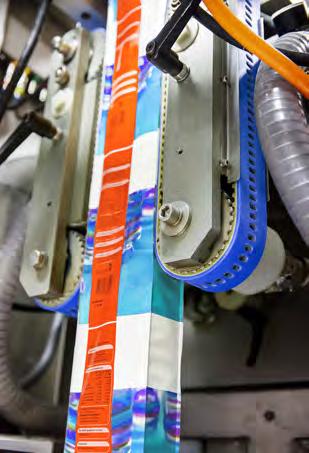
Cinghie speciali
Nell’industria dell’imballaggio alimentare, l’efficienza
è la chiave per soddisfare le esigenze di produzione senza compromettere la qualità. Le cinghie sincrone “Pull
Down” Megadyne offrono al riguardo numerosi vantaggi
Le macchine per l’imballaggio verticale (VFFS) rappresentano il cuore pulsante del settore, assicurando un processo rapido e affidabile grazie al ruolo svolto dalle cinghie sincrone “Pull Down” di Megadyne. Si tratta di cinghie speciali che rivestono un ruolo cruciale nelle VFFS, utilizzate per il riempimento, la sigillatura e l’imbustamento in vari settori industriali, dal chimico all’alimentare. In questo mercato in particolare, l’impacchettamento di prodotti come dolci, patatine, tè, caffè, biscotti e pasta rappresenta una funzione fondamentale.
Tecnologia all’avanguardia per prestazioni superiori. L’avanzamento uniforme dell’imballaggio è un requisito fondamentale per le macchine per l’imballaggio verticale (VFFS). Per ottenere risultati ottimali, nella maggior parte dei casi, vengono impiegate due cinghie sincrone “Pull Down” di Megadyne, posizionate una di fronte all’altra su un tubo metallico. Tra il tubo e le cinghie viene avvolto un film di plastica, carta o alluminio. Il moto di avanzamento delle cinghie sposta verticalmente la pellicola, creando una busta che viene successivamente riempita e sigillata. I fori di aspirazione o le scanalature, spesso presenti sul il lato del rivestimento della cinghia, garantiscono una perfetta adesione del materiale tramite il vuoto.

«L’elemento distintivo delle cinghie sincrone “Pull Down” di Megadyne è rappresentato dalla loro capacità ineguagliabile di mantenere una velocità costante e un vuoto continuo tra le cinghie e la pellicola di imballaggio, garantendo un avanzamento preciso ed efficiente. La vasta gamma di cinghie speciali di Megadyne comprende modelli in gomma o poliuretano, per adattarsi alle diverse esigenze del confezionamento alimentare. Inoltre, le loro coperture continue e uniformi, progettate per un’elevata resistenza all’abrasione offrono un’altrettanto elevata resistenza all’usura, assicurando una durata della cinghia maggiore» . Roberto Ala, Industry Segment Manager of Packaging di Megadyne
Vantaggi tangibili in produzione. Le cinghie Megadyne offrono numerosi vantaggi. Tra questi, usura uniforme per prestazioni costanti; coperture con prestazioni continue e durature che assicurano un attrito costante e prolungano la resistenza della cinghia; alta resistenza all’abrasione per una maggiore durata nel tempo. Inoltre, la lavorazione di fori, scanalature e profili con tolleranze ridotte offrono performance ottimali in fase di produzione.
Tra i più recenti casi di successo, spicca la soluzione di un problema di perdita di attrito grazie a un nastro speciale con un rivestimento innovativo, capace di garantire un attrito costante e una presa ottimale su diversi tipi di film. Una soluzione che ne ha triplicato la durata migliorando in modo significativo l’efficienza operativa.
scarica il case study completo di Megadyne.
Explore the full Megadyne case study.
Disponibilità in tempo reale
Le cinghie ingegnerizzate di Megadyne sono disponibili a magazzino garantendo tempi di consegna ridotti che includono confezionamento e spedizione rapidi all’arrivo dell’ordine.
Megadyne’s engineered belts are available from stock, guaranteeing short delivery times that include rapid packing and shipping upon arrival of the order.
In the food packaging industry, efficiency is key to meeting production needs without compromising quality. In this field, the Megadyne’s “Pull Down” synchronous belts provide many advantages.
Vertical Form Fill Seal (VFFS) machines are the beating heart of this sector, ensuring a fast and reliable process. At the core of these machines are Megadyne’s “Pull Down” synchronous belts. Megadyne’s engineered belts play a crucial role in VFFS machines, used for filling, sealing, and bagging in various industrial sectors, from chemicals to food. In the food industry, they are essential for packaging products such as sweets, crisps, tea, coffee, biscuits, and pasta.
Cutting-edge technology for superior performance. In VFFS machines, it is crucial to ensure even advancement of the packaging material. To achieve optimal results, two of Megadyne’s “Pull Down” synchronous belts are often used, placed opposite each other on a metal tube. A plastic, paper, or aluminium film is wrapped around the tube and the belts. The motion of the belts advances the film vertically, creating a bag that is then filled and sealed. The toothed belts often have a counterbore or are provided with longitudinal grooves on the coating side in order to be able to suction and guide the packaging with a vacuum.
Tangible benefits for your production. Megadyne belts offer numerous advantages, including uniform wear for consistent performance, long-lasting coatings that ensure constant friction and extend the belt’s durability, and high abrasion resistance for extended service life. Additionally, the processing of holes, grooves, and profiles with reduced tolerances provides optimal performance for your production.
Real time availability. Megadyne’s engineered belts are now available from stock, meaning reduced delivery times. The new line can be quickly packaged and shipped as soon as we receive an order. Moreover, Megadyne offers customised VFFS products to meet specific requirements.
A recent case study shows advantages in case of friction loss challenges. Megadyne addressed the customer’s problem by introducing a specialty belt with an advanced cover material that transformed its operations by delivering consistent friction and enhanced grip across different film types. The innovative approach resulted in a lifespan of three times longer than the customer’s previous solution, significantly enhancing overall efficiency.
«The distinctive feature of Megadyne’s “Pull Down” synchronous belts is their unparalleled ability to maintain a constant speed and continuous vacuum between the belts and the packaging film, ensuring precise and efficient movement. Megadyne’s wide range of engineered belts includes rubber and polyurethane models, to suit the various needs of food packaging.In addition, their continuous and uniform coatings, designed for high abrasion resistance, also offer high wear resistance, ensuring a longer belt lifespan». Roberto Ala, Industry Segment Manager of Packaging at Megadyne

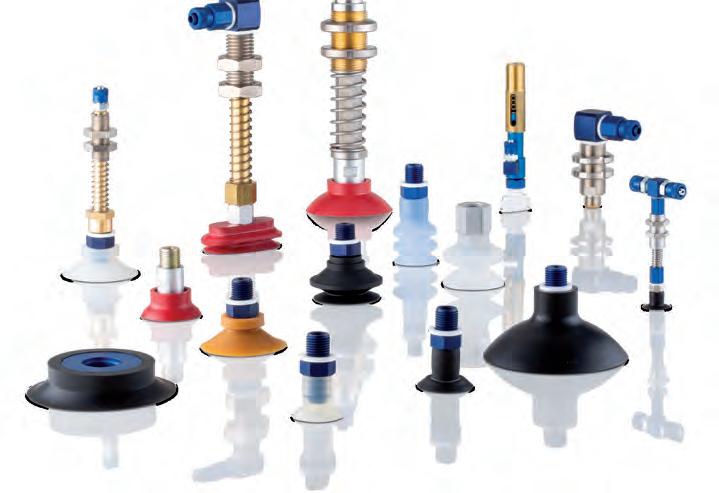

















Modello molto diffuso nel settore dell’automazione e della movimentazione industriale, la catena 879 BAT di MH
Material Handling evolve in una versione migliorata per velocità, affidabilità e sicurezza anche sulle linee esistenti.
Robusta, versatile e instancabile, la catena 879 BAT si è affermata fin dagli anni ’80 come riferimento affidabile per innumerevoli linee di trasporto in settori diversi, tra cui l’alimentare. Nel corso degli anni, MH Material Handling ha declinato il modello in numerose versioni che nel tempo hanno soddisfatto le esigenze di impianti complessi operativi anche nelle condizioni più difficili, portando all’evoluzione tecnica anche una soluzione consolidata come la 879 BAT.
Migliorare un prodotto di successo
Con l’esperienza maturata in quasi 40 anni di utilizzo quotidiano e grazie ai continui confronti con i tecnici sul campo, MH si è posta l’obiettivo di migliorare ulteriormente un prodotto di successo. Da questa nuova sfida è nato il pro-

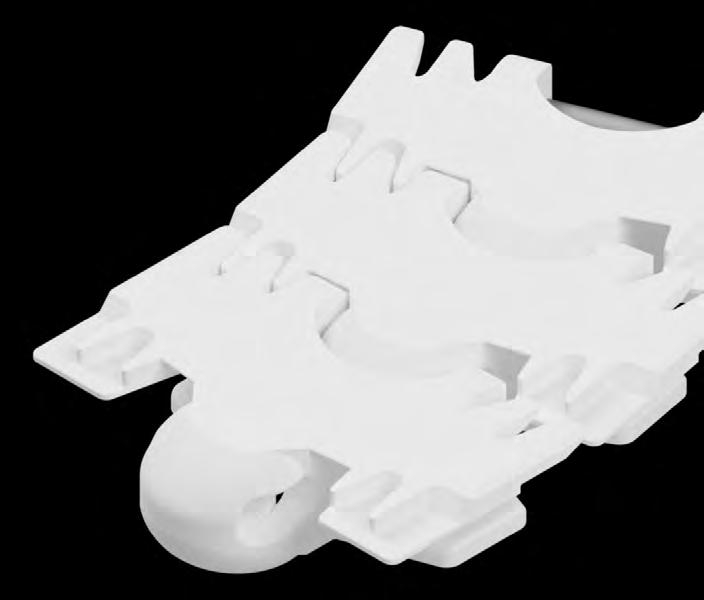
getto USC -UltimateSafetyChain, sviluppato in collaborazione con Ammeraal Beltech con uno scopo: unire la solidità della catena BAT alla sicurezza della tecnologia Safety Finger di Ammeraal. Il risultato è una catena completamente nuova, ma pienamente retrocompatibile con le attuali linee basate sulla 879. Con la nuova soluzione, infatti, non serve intervenire sull’impianto, ma è sufficiente procedere alla sostituzione di catena e pignoni.
Revamping: un salto di qualità. USC nasce per semplificare il revamping delle linee esistenti e portare un vero salto di qualità in termini di maggiore velocità di esercizio, riduzione della rumorosità, aumento di stabilità e sicurezza senza rinunciare alla flessibilità. Tra i vantaggi spicca anche il mantenimento del traino tangenziale, un elemento che MH ha preservato poiché più adatto alla gestione dei sistemi di accumulo LIFO, come il BAT Buffer di sua produzione.
Le soluzioni MH Material Handling nascono per risolvere problemi concreti di impianti reali, rispondendo così alle esigenze produttive di oggi. Nonostante l’ampia affermazione sul mercato della catena 879 BAT, utilizzata e conosciuta dagli operatori da decenni, la USC ne rappresenta la versione evoluta, più performante e pronta per le nuove sfide produttive del presente e del futuro.
USC diventa quindi protagonista di una nuova fase per tutte le aziende che cercano una catena moderna, affidabile, facile da installare e pensata per durare.


A popular model in the automation and industrial handling sector, the 879 BAT chain from MH Material Handling has now evolved, offering improved speed, reliability and safety even on existing lines.
Robust, versatile and tireless, the BAT 879 chain has been a trusted solution since the 1980s for numerous conveyor lines across various industries, including the food sector. Over the years, MH Material Handling has developed numerous versions of this model to meet the demands of increasingly complex systems operating in the most challenging conditions. This has led to the technical evolution of what was already a well-established and proven solution, such as the 879 BAT.
Improving a successful product
Building on nearly 40 years of daily use and continuous feedback from field technicians, MH set out to further improve an already successful product. This new challenge led to the development of the USC -UltimateSafetyChain project, created
in collaboration with Ammeraal Beltech. The objective was clear: to combine the strength of the BAT chain with the safety features of Ammeraal’s Safety Finger technology. The result is an entirely new chain that remains fully backward compatible with existing 879-based systems. Thanks to this innovative solution, there is no need to modify the system, but simply replace the chain and sprockets.
Revamping: a quantum leap. The USC was developed to simplify the revamping of existing lines, delivering a true quantum leap in performance: higher operating speeds, reduced noise levels, enhanced stability and greater safety - all without compromising flexibility. One of the key advantages is the retention of tangential drive, a feature MH preserved as it is better suited for handling LIFO storage
systems, such as its own BAT Buffer. MH Material Handling solutions are designed to address real challenges in real plants, meeting the demands of today’s production environments.
While the 879 BAT chain has long been trusted and widely adopted by operators across the industry, the USC represents its natural evolutionoffering superior performance and ready to tackle the production challenges of today and tomorrow. USC thus marks the beginning of a new chapter for companies seeking a modern, reliable chain that is easy to install and built to last.

Become


Sidel

In attesa di drinktec, Sidel anticipa un’esclusiva mondiale che verrà svelata in fiera a Monaco di Baviera, promettendo prestazioni di livello superiore in fatto di confezionamento, riempimento e sostenibilità.
Adrinktec 2025, Sidel sarà fonte di ispirazione per gli utilizzatori dei suoi sistemi nel padroneggiare le performance di produzione attraverso innovazione, competenza e partnership.
Come dichiara Pietro Cassani, Presidente e CEO di Sidel: «Il futuro del settore del packaging risiede nella capacità di controllare le prestazioni totali della linea. Per raggiungere questo obiettivo, collaboriamo con i produttori di alimenti e bevande per essere all’avanguardia nel packaging sostenibile, aumentare la produttività e massimizzare il rendimento lungo l’intero ciclo di vita delle loro linee».

Dal 15 al 19 settembre presso il Centro Fieristico di Monaco di Baviera (Hall A6, Stand 361), Sidel lancia dunque una nuova, rivoluzionaria tecnologia.
I visitatori saranno quindi guidati attraverso un tour interattivo per sperimentare un percorso ottimizzato all’interno di una linea di confezionamento. Lungo il percorso, avranno l’opportunità di vedere e toccare con mano le tecnologie più recenti messe a punto da Sidel, studiate per raggiungere un nuovo livello di prestazioni e sostenibilità, a partire dai materiali del packaging - tra cui soluzioni in PET 100% riciclato - fino agli standard elevati di efficienza della linea nonché alle prestazioni in relazione a produzione e confezionamento,
Anticipating drinktec 2025, Sidel is set to preview a world exclusive innovation that will be unveiled at the trade fair in Munich, promising superior performance in packaging, filling and sustainability.
At drinktec 2025, Sidel will inspire manufacturers to master production performance through innovation, expertise and partnership.
«The future of the packaging industry is the ability to master the total line performance. To achieve this, Sidel partners with food and beverage manufacturers to lead the way in sustainable packaging, to
elevate productivity, and to maximise performance for the lifetime of their lines» said Pietro Cassani, President & CEO, Sidel.
From September 15-19 at the Munich Trade Fair Centre (Hall A6, Booth 361) Sidel will launch its era-defining new technology.
Sidel visitors will be guided through an interactive tour to experience an optimised packaging line journey.
migliorate lungo l’intero ciclo di vita e fino ad ora considerate irraggiungibili.
«Ci stiamo spingendo oltre i limiti, ottenendo di più con meno: uno dei principi chiave alla base delle nostre ultime innovazioni di linea» aggiunge Cassani.
L’elemento rivoluzionario
Ispirandosi ai quattro elementi della natura, ovvero alle quattro fonti di energia e creazione, Sidel è quindi pronta a introdurre un rivoluzionario “quinto elemento” studiato espressamente per l’industria del packaging: presentato in fiera, garantisce un nuovo livello di prestazioni, dove anche l’impossibile diventa possibile, con un cambio di paradigma in termini di leggerezza, efficienza, semplicità... e molto altro.
Lo stand Sidel sarà facilmente identificabile grazie alla presenza di un monolite arancione e di una forma angolata: un marchio distintivo (riprodotto anche accanto al logo dell’azienda), che rappresenta l’”angolo delle prestazioni”, un approccio lungimirante al miglioramento delle prestazioni dei clienti, fondato su una ricca esperienza nel settore delle soluzioni per il food & beverage.
Along the way, they’ll have the chance to see and touch Sidel’s latest technology to unlock a new level of performance and sustainability, starting from the package’s materials including 100% recycled PET solutions, to a new level in line efficiency, discovering levels of production & packaging performance previously thought of as unachievable across the lifecycle.
«We’re pushing boundaries and achieving more with less - one of the key principles behind our latest line innovations» adds Cassani.
The groundbreaking element Picturing nature’s four elements, or four sources of power and creation,
Sidel is set to introduce a groundbreaking ”fifth element” for the packaging industry. To be unveiled at the show, this new element empowers a new level of performance, where even the impossible becomes possible, with a paradigm shift in lightweighting, efficiency, ease …and more! Sidel’s stand will be easily identifiable as it features an orange-coloured monolith and angled shape. This signature mark next to the company’s logo represents the “angle of performance”, a forward-looking approach to improving performance for customers, grounded in a rich history of food & beverage solution expertise.

Esiste una geometria precisa nel sistema solare e ogni elemento interagisce in maniera perfetta con gli altri. Ispirandosi ai pianeti, PRATI costruisce le proprie macchine affinché ogni modello possa funzionare in armonia con l’ambiente e… “girare all’infinito”!

Metti PRATI al centro e raggiungi un’altra dimensione tra le infinite possibilità di varnishing, digital foiling, die-cutting, numbering, 100% quality inspection, rewinding&stacking…
PRATI, tutto un altro pianeta nella nobilitazione e finitura post stampa di etichette e packaging: oro a freddo, digital doming, fustellatura, sfridatura, ispezione, sovrastampa, taglio, ribobinatura, stacking e sheeting, per essere sempre un passo avanti nel futuro nei settori food&bevarage, wine&spirits, cosmetico, farmaceutico, chimico, logistica, promozionale e brand protection.
PRATI srl Via Deruta, 2 48018 Faenza (Ra) - Italy +39 0546 633 811 info@praticompany.com
www.praticompany.com


PRATI USA LLC 4101 McEwen - Suite 368 Dallas, TX 75244 - USA +1 913 908 8607 fhasselberg@praticompany.com
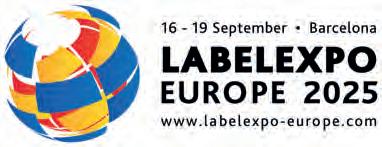
La nuova generazione di pouch rovesciato: un packaging intelligente, sostenibile ed efficace.

Nel mondo in continua evoluzione del packaging flessibile, Volpak - azienda del gruppo Coesia - porta sul mercato
FlexoDose Light. Si tratta di un nuovo formato di pouch rovesciato, che unisce una forte presenza a scaffale, massima facilità d’uso e piena riciclabilità in una soluzione pronta a rispondere in contemporanea alle esigenze di consumatori e produttori.
Progettato con un profilo a cuneo, FlexoDose Light offre un’ampia visibilità frontale, trasformando il packaging in un potente strumento di comunicazione a scaffale. Il design rovesciato ed ergonomico garantisce un’erogazione facile, un flusso controllato e uno svuotamento pulito fino all’ultima goccia, migliorando l’esperienza d’uso e riducendo gli sprechi.
Una soluzione per tanti mercati
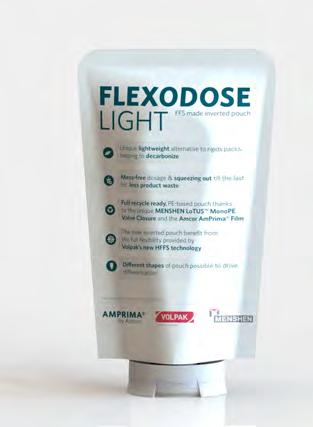
FlexoDose Light è una soluzione versatile, adatta a un’ampia gamma di applicazioni. Nell’alimentare è ideale per salse, condimenti, latticini e topping. Nel personal care risponde alle esigenze di prodotti come shampoo, gel, creme e lozioni. Nell’home care propone un formato efficace per detergenti, prodotti per la pulizia e ricariche. In tutti questi ambiti, il pouch diventa la confezione perfetta in termini di praticità, igiene, portabilità e sostenibilità, assecondando le necessità dei consumatori. I dati di mercato confermano un interesse crescente verso soluzioni come FlexoDose Light. Il segmento dei pouch rovesciati è infatti in rapida espansione, con previsioni di crescita annua (CAGR) del 7,7% fino al 2033. Grazie alla combinazione di ergonomia, impatto visivo e sostenibilità il formato sta guadagnando terreno in categorie come i condimenti alimentari e le ricariche per la cura della casa. In Nord
America, Europa e nei principali mercati asiatici, la domanda è in costante crescita, mentre i brand cercano soluzioni di packaging che uniscano estetica e funzionalità.
Versatilità su linee produttive diverse. Dal punto di vista produttivo, FlexoDose Light è pienamente compatibile con le piattaforme HFFS delle serie SI e SP di Volpak, garantendo un’integrazione fluida nelle linee esistenti. Una versatilità che consente ai produttori di adottare rapidamente il nuovo formato, senza importanti investimenti o modifiche agli impianti e mantenendo quindi alti livelli di efficienza e qualità costante del prodotto.
La sostenibilità è al cuore del concetto FlexoDose Light. Il pouch è realizzato in monomateriale polietilene (PE), completamente riciclabile. Questa struttura è conforme ai più recenti orientamenti normativi e alle tendenze globali in materia di green packaging, aiutando i brand a ridurre l’impatto ambientale senza compromettere le performance in fase di stoccaggio, utilizzo e trasporto. Rispetto al packaging rigido, le soluzioni flessibili consentono un uso inferiore di materie prime e una riduzione delle emissioni di CO₂ lungo tutta la filiera. Con FlexoDose Light, Volpak conferma quindi ancora una volta il proprio impegno verso soluzioni di packaging innovative e responsabili, in linea con le esigenze di un mercato in continua trasformazione. Il risultato è un formato moderno che valorizza la presenza a scaffale, soddisfa il consumatore e contribuisce concretamente agli obiettivi dell’economia circolare, generando valore reale per brand e consumatori.

The smart leap forward for inverted pouch packaging: a smart, sustainable and effective solution.
In the ever-evolving world of flexible packaging, Volpak - part of the Coesia Group - brings a compelling innovation to the table: FlexoDose Light. This new inverted pouch format merges bold shelf presence, effortless usability, and full recyclability into a single, futureready solution tailored to both consumers and manufacturers.
Designed with a wedge-shaped silhouette, FlexoDose Light offers excellent front-facing visibility, transforming the pouch into a powerful on-shelf communication tool. Its ergonomic inverted design ensures easy dispensing, a

controlled flow, and clean emptying down to the last drop, enhancing the overall consumer experience and minimizing product waste.
One solution for many markets FlexoDose Light is a versatile solution suitable for a broad range of applications. In the food industry, it’s ideal for sauces, condiments, dairy products, and toppings. In the personal care sector, it meets the needs of shampoos, gels, creams, and lotions. In home care, it offers an effective format for detergents, cleaners, and refills. In each of these markets, the pouch responds to growing expectations for convenience, hygiene, portability, and environmental responsibility.
As a matter of fact, market data reflects a growing appetite for solutions like FlexoDose Light. The inverted pouch segment is expanding rapidly, with forecasts suggesting a CAGR of 7.7% through 2033. In categories such as food condiments and home care refills, this format is gaining traction for its combination of ergonomic handling, visual impact, and sustainability.
Across North America, Europe, and key markets in Asia, demand is accelerating as brands seek packaging that offers both form and function.
Built for versatility across production lines. From a manufacturing perspective, FlexoDose Light is fully compatible with Volpak’s SI and SP series HFFS platforms, ensuring a smooth integration into existing production lines. This enables producers to quickly adopt the new format without the need for extensive investment or system reengineering, maintaining high efficiency and consistent product quality.
ESG as a leading actor
Sustainability is at the core of the FlexoDose Light concept. The pouch is made of a fully recyclable mono-material polyethylene (PE) structure. This design aligns with evolving regulatory frameworks and global trends in eco-conscious packaging, helping brands reduce environmental impact while maintaining high performance in storage, use, and transport.
Compared to rigid packaging, this flexible solution reduces raw material usage and lowers CO2 emissions across the value chain. With FlexoDose Light, Volpak once again affirms its commitment to innovative, responsible packaging solutions that meet the demands of a dynamic market. The result is a modern pouch format that delivers on shelf presence, user satisfaction, and circular economy goalsdriving real value for brands and end users alike.
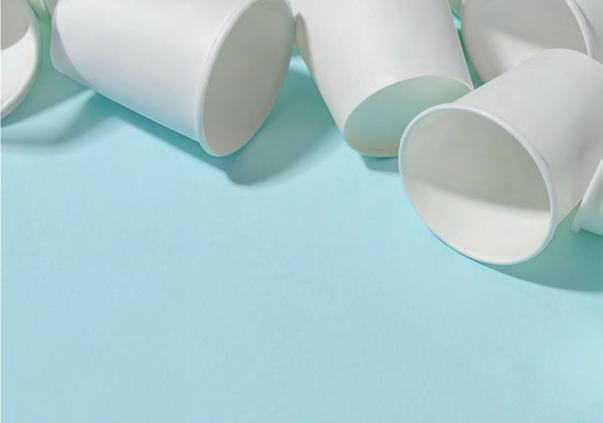

Da ILIP una nuova soluzione doppia barriera per il take away di bevande, anche alcoliche, servite con ghiaccio.
La linea FibrAware® Personalizzato di ILIP si arricchisce di una nuova proposta per il mondo del take away e del consumo on-the-go: bicchieri in cartoncino con doppia barriera PE, ideali per contenere bevande fredde con ghiaccio e alcoliche come granite, aperitivi e cocktail.

Progettati per rispondere alle esigenze del mercato e agli stili di vita più contemporanei, questi bicchieri sono perfetti per l’asporto, garantendo resistenza, sicurezza e un’eccellente resa grafica. Disponibili in tre formati (300 ml, 445 ml e 530 ml), possono essere completati da un coperchio in carta o PS.
La possibilità di realizzare stampe in quadricromia sull’intera superficie, fa di FibrAware® Personalizzato un potente strumento di comunicazione visiva per i brand, senza dimenticare la sostenibilità. Dopo l’uso, infatti, i bicchieri possono essere smaltiti nella raccolta differenziata della carta.

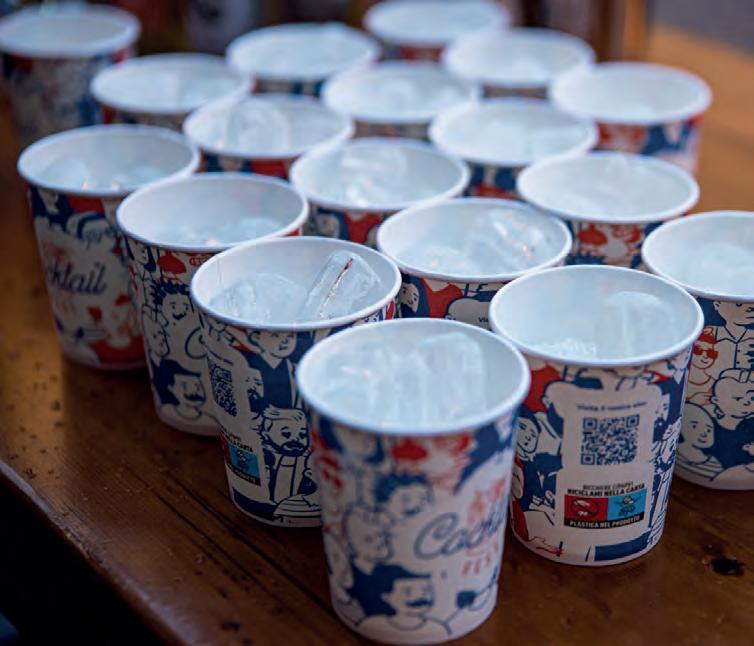
An effective labelling system is key to product quality, traceability and presentation. To meet the needs of modern manufacturers, Etipack offers two complete and modular automatic solutions for accurately labelling a wide range of containers for liquid foods and beverages: System 5 and System 1.
The first solution is designed for front-back application and an optional guarantee seal on elliptical, quadrangular or cylindrical containers of up to 380 mm in height. System 5 consists of modules that can be configured to apply, where required, a label from the cap to the neck of the bottle, with a sealing function, and subsequently, thanks to two opposing labellers, a front and a back label. End rollers ensure optimal adhesion.
The second solution, System 1, is designed for cylindrical and truncated-cone containers of up to 200 mm high. The modular structure allows the application of wrapping, semiwrapping or shaped labels with seal. The configuration can also be customised to apply labels facing towards the cap or a logo, ensuring precise application.
Both Systems, 1 and 5, also enable the integration of print groups to include batch and production date marking. They also allow for the flexible and accurate handling of any processing difficulties typical of cylindrical products, including defects such as air bubbles, and the labelling of multiple formats.
The new 9712 bi-jet printer developed by Markem-Imaje® (a subsidiary of Dover Corporation) makes it possible to double coding speed or the amount of data provided. This continuous inkjet (CIJ) printer is designed for manufacturers who need to print particularly large codes (including 2D codes) or include significant amounts of information on each product. The 9712 model makes it possible to code with one machine what would normally require two, freeing up resources for other business priorities, halving initial capital expenditure (CAPEX) and reducing operational expenditure (OPEX), while delivering codes of continually high quality.
The properties of the 9712’s dual-jet printhead ensure both twice as fast coding and the ability to print twice the amount of data as well as compact print capacity. These qualities ensure a significant improvement in production line performance and codes of consistently excellent quality. Finally, the use of a single machine reduces the systems, equipment and components involved in processing by 50%, resulting in a reduction in maintenance required.
Un sistema di etichettatura efficace è essenziale per garantire qualità, tracciabilità e presentazione del prodotto. Per rispondere alle esigenze dei produttori moderni, Etipack propone due soluzioni automatiche complete e modulari per etichettare con precisione una vasta gamma di contenitori per i liquid foods and beverage: Sistema 5 e Sistema 1. La prima soluzione è progettata per l’applicazione fronte-retro e opzionalmente, sigillo di garanzia su contenitori di forma ellittica, quadrangolare o cilindrica fino a 380 mm di altezza. Sistema 5 è composto da moduli configurabili per eseguire, dove previsto, l’applicazione di un’etichetta dal tappo al collo della bottiglia con funzione di sigillo e successivamente, grazie a due etichettatrici contrapposte, un’etichetta anteriore e una posteriore. Rulli finali garantiscono un’adesione ottimale. La seconda soluzione, Sistema 1, è invece pensata per contenitori cilindrici e troncoconici fino a 200 mm di altezza. La struttura modulare permette l’applicazione di etichette avvolgenti,

semi-avvolgenti o sagomate con sigillo. La configurazione può essere customizzata anche per applicare etichette orientate rispetto al tappo o a un logo, garantendo un’applicazione precisa. Entrambi i Sistemi, 1 e 5, permettono inoltre di integrare gruppi stampa per includere marcatura lotto e data di produzione. Consentono altresì di gestire con massima flessibilità e accuratezza eventuali difficoltà di lavorazione tipiche di prodotti cilindrici, quali ad esempio, difetti come bolle di aria e l’etichettatura di più formati.
Raddoppiare velocità di codifica o dati forniti con le soluzioni Markem-Imaje

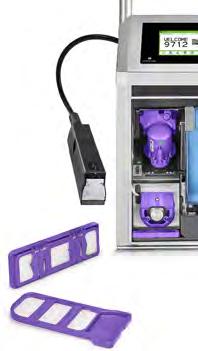
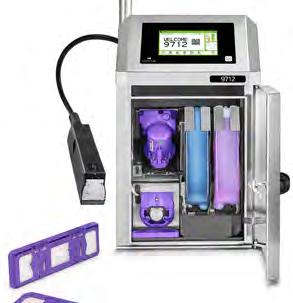
La nuova stampante bi-jet 9712 permette ai produttori performance elevate per grandi codici con una singola macchina Markem-Imaje®, controllata da Dover Corporation presenta il codificatore a doppio getto 9712, una stampante a getto d’inchiostro continuo (CIJ) ideata per i produttori che hanno bisogno di stampare codici particolarmente grandi (compresi i codici 2D) o di includere quantità significative
di informazioni su ogni prodotto. Il modello 9712 consente di codificare con una sola macchina ciò che normalmente ne richiede due, dimezzando così la spesa iniziale di capitale (CAPEX) e riducendo al minimo i costi operativi correnti (OPEX), pur fornendo sempre codici di alta qualità.
Le proprietà della testa di stampa a doppio getto della 9712, possono offrire sia una codifica due volte più veloce che la stampa del doppio della quantità di dati e la capacità di stampa compatta. Qualità che garantiscono un miglioramento significativo delle prestazioni della linea di produzione e codici di qualità sempre eccellente. Una sola 9712 può quindi svolgere il lavoro di due stampanti CIJ standard, liberando risorse per le altre priorità aziendali. L’utilizzo di una sola macchina, infine, riduce del 50% apparati, attrezzature e componenti coinvolti nella lavorazione, permettendo la conseguente riduzione delle attività di manutenzione.
ALritma è una macchina etichettatrice che accompagna la storia di ALtech da oltre vent’anni: con più di 20.000 unità installate nel mondo, è riconosciuta per affidabilità e versatilità.
A Ipack Ima 2025 ne è stata svelata la quarta generazione, completamente riprogettata per offrire maggiore flessibilità e modularità, senza rinunciare a precisione e affidabilità.
Come sottolinea Paolo Salvini, CEO di ALtech, «il nome è lo stesso, ma i contenuti sono completamente nuovi: ALritma si
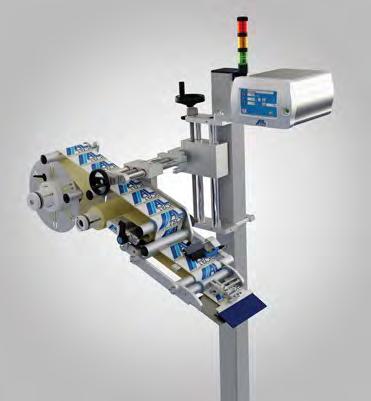
conferma una soluzione modulare, in grado di rispondere alle esigenze sempre più specifiche e dinamiche dell’industria moderna».
Le novità introdotte. Entrando nello specifico, della nuova ALritma spiccano la modularità evoluta, che consente l’aggiunta di componenti anche dopo l’installazione e la struttura flessibile con moduli orientabili, adattabile a linee di confezionamento in spazi ridotti. Ne ricordiamo poi l’applicabilità universale, programmabile per memorizzare i parametri di etichettatura di formati diversi nonché l’adattabilità a numerosi settori industriali (alimentare, cosmetico, farmaceutico, chimico).
Il riscontro positivo da parte dei visitatori dello stand ALtech in fiera e l’interesse dimostrato ha confermato l’attualità e il valore delle soluzioni proposte: un successo reso possibile dal lavoro svolto con dedizione e professionalità da un team aziendale coeso e competente.
ALritma is a labeling machine that has been part of ALtech’s history for over twenty years. With more than 20,000 units installed worldwide, it is known for its reliability and versatility. At Ipack Ima 2025, the fourth generation of the model was revealed, completely redesigned to offer greater flexibility and modularity, while maintaining the brand’s renowned precision and reliability. As CEO Paolo Salvini noted: «The name is the same, but the contents are entirely new: the new ALritma confirms itself as a modular solution, capable of meeting the increasingly specific and dynamic needs of modern industry».
Key innovations. Specifically, the key characteristics of the new ALritma are its advanced modularity, allowing components to be added even after installation, and the flexible structure with adjustable modules, adaptable to packaging lines with limited space. Other important features are its universal applicability, programmable to store labeling parameters for different formats, and its suitability for numerous industrial sectors (food, cosmetics, pharmaceuticals, and chemicals). The positive feedback from the public (the ALtech stand at Ipack-Ima welcomed a large number of visitors) and the interest shown confirmed the relevance and value of the solutions presented: this success is the result of the dedicated efforts and professional skills of a close-knit, competent corporate team.

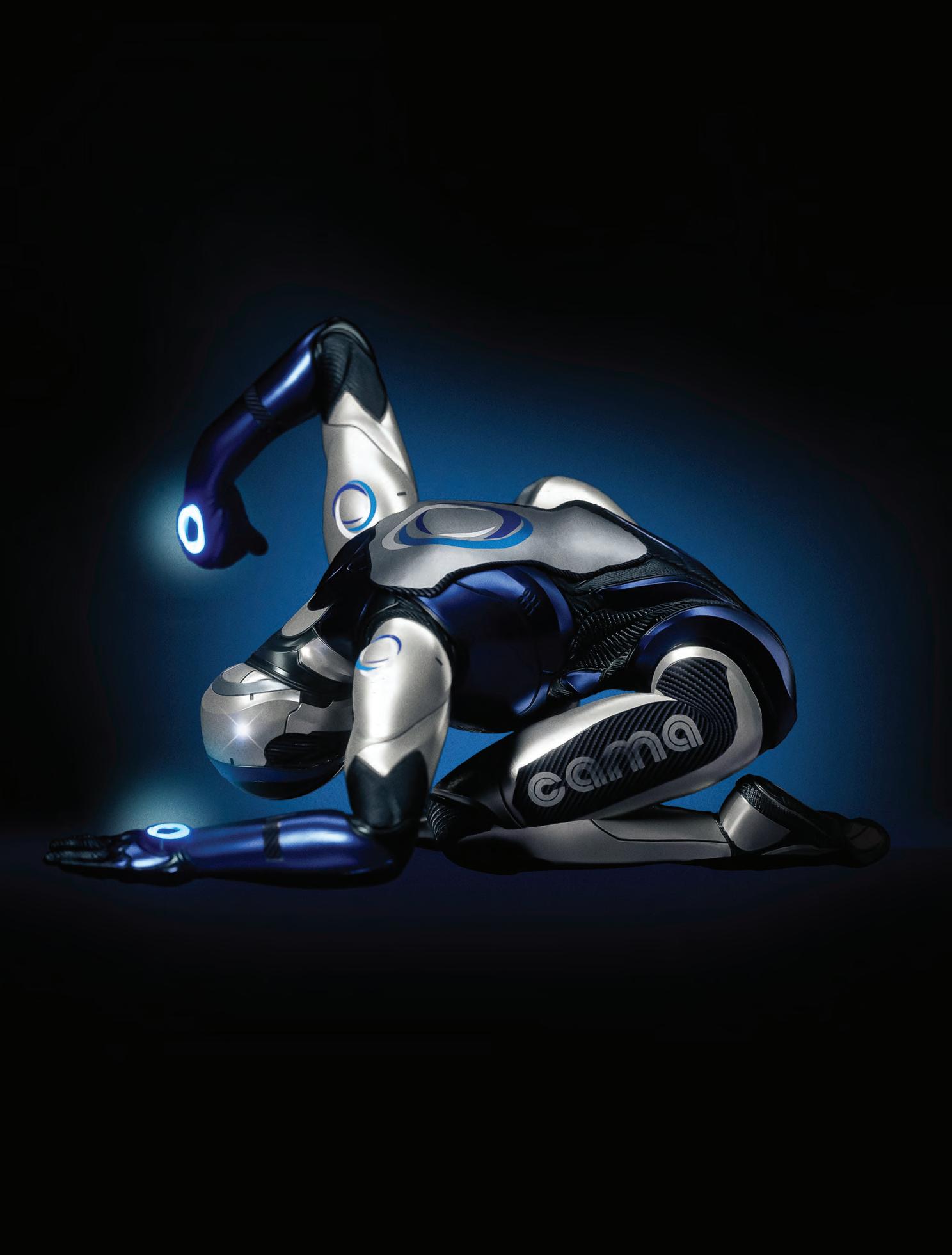


Il Consorzio Nazionale per il riciclo e il recupero
degli imballaggi in acciaio ha presentato a Made in Steel 2025 i dati ufficiali che fissano a 435mila le tonnellate di acciaio riciclate nel 2024.
Nel corso della più importante manifestazione del Sud Europa dedicata alla filiera dell’acciaio, il rapporto RICREA conferma l’Italia come eccellenza nell’economia circolare degli imballaggi in acciaio, seguendo il trend positivo di un settore che esprime risultati ben superiori agli obiettivi europei.
Numeri superiori alle attese
Nel 2024 sono state avviate a riciclo 435.539 t di imballaggi in acciaio, registrando un tasso di riciclo dell’86,4% dell’immesso al consumo. Un risultato che supera di oltre 6 punti percentuali l’obiettivo dell’80% fissato dall’Unione Europea per il 2030, dimostrando la solidità del sistema di raccolta differenziata
nazionale e l’efficacia delle politiche di economia circolare implementate attraverso il Sistema CONAI.
La circolarità permanente dell’acciaio. L’acciaio è un materiale che può essere riciclato all’infinito senza perdere le proprie qualità intrinseche. Da contenitore a rifiuto, fino a nuova materia prima, può rinascere sempre sotto nuove forme: binari ferroviari, tombini, arredi urbani come, ad esempio, le innovative panchine Steelosa interamente realizzate in acciaio riciclato. Caratteristiche uniche, che rendono l’acciaio il materiale più riciclato in Europa, facilmente differenziabile e completamente recuperabile nel ciclo produttivo.
At Made in Steel 2025, the National Consortium for the Recycling and Recovery of Steel Packaging presented the official figures: 435,000 tonnes of steel recycled in 2024.
During the most important event in Southern Europe dedicated to the steel supply chain, the RICREA report confirms the high-profile role played by Italy in the circular economy of steel packaging, following the positive trend of a sector that is performing well above European targets.
Numbers exceeding expectations
In 2024, 435,539 tonnes of steel packaging was sent for recycling, registering a recycling rate of 86.4% of the packaging released for
consumption. This result is more than 6 percentage points above the 80 per cent target set by the European Union for 2030, demonstrating the solidity of the national separate waste collection system and the efficacy of the circular economy policies implemented through the CONAI System.
The permanent circularity of steel. Steel is a material that can be recycled indefinitely without losing its intrinsic qualities. From container to waste to new raw material, it can

Impatto ambientale ed economico. Secondo i dati preconsuntivi sviluppati su elaborazioni LCC Conai, nel 2024 il riciclo degli imballaggi in acciaio ha generato impatti significativi su ambiente ed economia, con 435.539 t riciclate che hanno permesso di risparmiare 2,7 TWh di energia primaria, evitando l’utilizzo di 495.000 t di materia prima e prevenendo la dispersione di 868.000 t di CO2 equivalente
Un futuro sempre più virtuoso. Secondo Domenico Rinaldini, Presidente di RICREA, i risultati del 2024 hanno confermato l’efficacia del modello e il ruolo strategico del Consorzio nel guidare la transizione verso l’economia circolare. «Il sistema che abbiamo costruito - ha dichiarato Rinaldini - coinvolge l’intera filiera, dai cittadini che differenziano correttamente agli operatori della raccolta, fino alle acciaierie dove l’acciaio rinasce in infinite forme. I risultati superano già oggi gli obiettivi europei del 2030, confermando l’Italia come protagonista di rilievo nell’economia circolare dell’acciaio e dimostrando che la transizione verso un modello di sviluppo sostenibile non sia solo possibile, ma già realtà».
always be reused in new ways: railway tracks, manhole covers, street furniture such as, for example, the innovative Steelosa benches made entirely from recycled steel. These unique characteristics make steel the most widely recycled material in Europe, because it is easily sorted and fully recoverable in the production cycle. Environmental and economic impact According to preliminary data developed based on LCC Conai calculations, in 2024 the recycling of steel packaging generated significant environmental and economic impacts. The recycling of 435,539 tonnes enabled a saving of 2.7 TWh of primary energy, avoiding the use of 495,000 tonnes of raw material and preventing the dispersion of 868,000 tonnes of CO2 equivalent.
An increasingly virtuous future. According to Domenico Rinaldini, President of RICREA, the 2024 results confirmed the efficacy of the model and the strategic role of the Consortium in driving the transition towards a circular economy. «The system we have built - said Rinaldini - involves the entire supply chain, from users who separate their waste correctly to the refuse collection operators, as well as the steel mills where the steel is reused in endless ways. The results have already exceeded the European 2030 targets, confirming Italy’s role as a major player in the steel circular economy and demonstrating that the transition to a sustainable development model is not only possible, but already a reality»
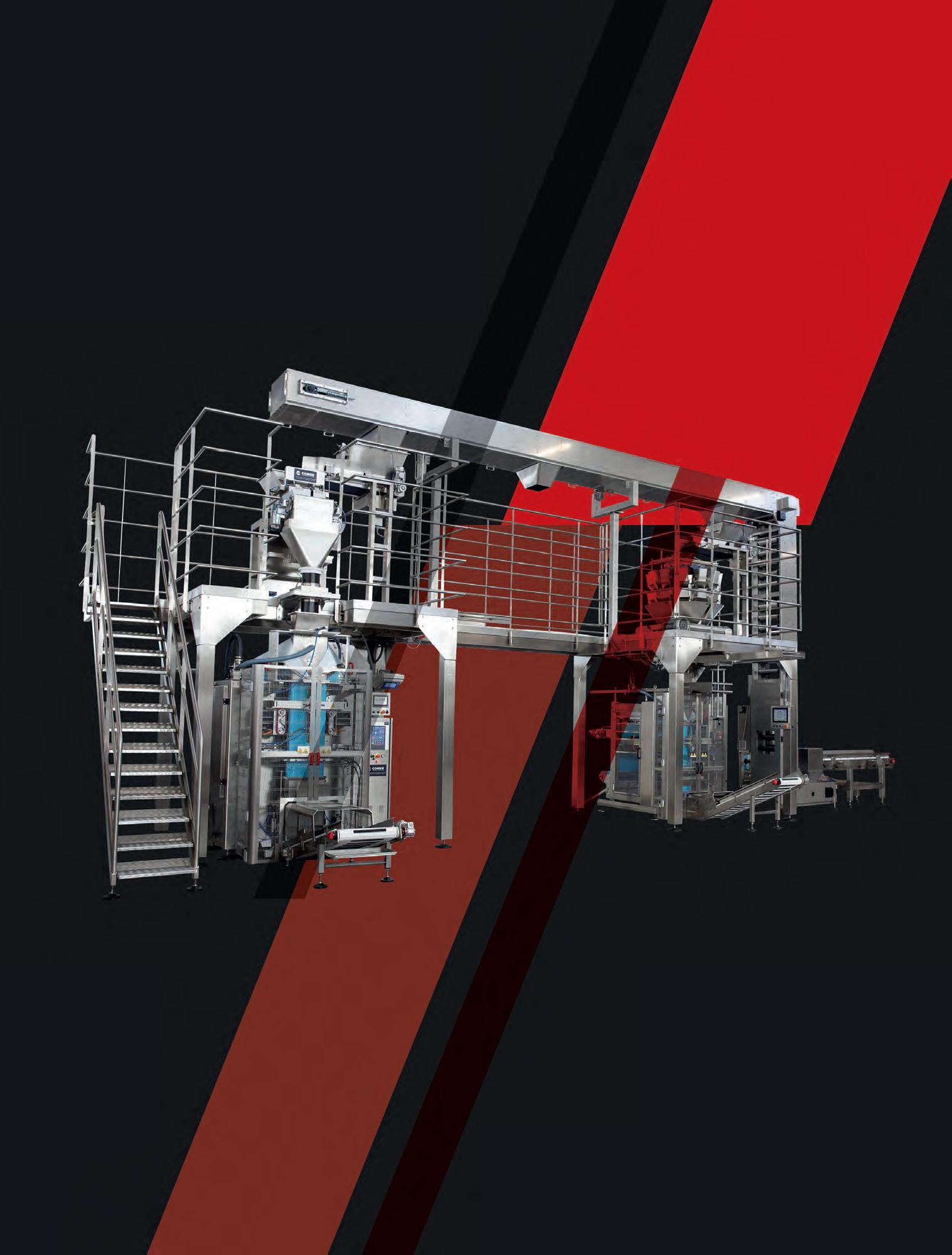
comek.it
OTTIMIZZA I TEMPI E I COSTI DI GESTIONE CON LE SOLUZIONI INTEGRATE COMEK
Dalla progettazione all’installazione, siamo al tuo fianco per rendere più efficiente la gestione della tua linea di confezionamento.
Maggior coordinamento operativo, processi più semplici e assistenza completa, per la massima resa e qualità del packaging.
VI ASPETTIAMO:
• PROD&PACK | Stand F75 Padiglione 6 @Lione | 18-20 novembre 2025


Tra normativa, innovazione tecnologica e ricerca scientifica, la comunità del food contact in convegno a Baveno
Sostenibilità e packaging sono parole chiave del mondo dell’imballaggio. Due temi che hanno visto un’evoluzione del proprio ruolo nel corso degli anni, dove sicurezza alimentare, spreco e attenzione all’ambiente hanno visto una transizione non sempre complementare, evidenziando una tendenza alla radicalizzazione delle componenti green che tende a semplificare un tema estremamente complesso. Ed è proprio di questa complessità che ha discusso la comunità professionale di AIBO FCE - associazione italiana business operator food contact expert - che si è riunita a Baveno, sul Lago Maggiore per l’assemblea annuale. Un momento di aggiornamento tecnico di alto profilo proposto da Packaging Meeting di cui parla il presidente, Ciro Sinagra, Senior Advisor R&D di Laminazione Sottile Group, che con ItaliaImballaggio fa il punto sul settore e sull’associazione, auspicando una relazione sempre più forte tra ricerca e impresa.
Un evento importante e molto partecipato, ci racconta dell’associazione e degli obiettivi della vostra comunità professionale?
“Il XIII convegno nazionale food contact expert mostra una Aibo in forte crescita”, esordisce Sinagra. “Le 36 persone riunite in origine sono oggi 288 soci attivi, professionisti e consulenti che lavorano nelle aziende attive nel mercato del packaging, alla costante ricerca di con-
sulenza su un tema centrale per la salute, la qualità del cibo, lo spreco alimentare e quindi la sostenibilità. Il convegno vede la partecipazione di 170 esperti, che hanno affrontato temi che spaziano dalle normative nazionali ed europee ai nuovi materiali innovativi, dal riciclo alla necessità di trovare un punto di raccordo tra sostenibilità e regolamentazione. Se guardiamo al PPWR e al food contact, infatti, troviamo due rette parallele che non sempre si avvicinano, per quanto assolutamente necessario. Pensiamo alla centralità di monouso, riuso e riciclato, temi green spesso in conflitto con la necessità di proteggere l’alimento e con esso la salute del consumatore”.
Il food contact è strategico, per la complessità del tema e le sfide che impone. Quali sono le prospettive del settore?
“Ogni persona consuma mediamente 700 kg di cibo all’anno, utilizzando a vario titolo 150 metri quadrati di imballaggi, l’equivalente di un campo da volley. Si tratta di superfici a contatto con gli alimenti che impongono un costante monitoraggio sulla migrazione tra packaging e cibo. Un aspetto che richiede attenzione alle normative e il consolidamento, quando non ampliamento, delle professionalità, chiamate a occuparsi di conformità con le normative, sicurezza alimentare e qualità: il ruolo di AIBO. I nostri soci spaziano dai produttori di materiali all’industria alimentare, dai tossicologi ai con-

sulenti di cui le aziende hanno bisogno per la piena compliance alla normativa nazionale ed europea. La nostra è un’associazione ricca e molto partecipata, con competenze avanzate espresse da persone che in azienda svolgono un ruolo strategico per la food safety, la shelf life e la sostenibilità. Quest’ultima in particolare, vede nel riciclo un tema centrale per l’ambiente, dove però l’impatto della sicurezza alimentare su salute e benessere dei consumatori deve prevalere. Giusto quindi dare una seconda vita al packaging, ma mantenendo al centro la sicurezza. Interessante notare che l’associazione sta vivendo una costante rigenerazione dovuta all’ingresso di giovani professionalità, che entrano in associazione mettendo in campo un ricambio generazionale che stiamo favorendo come associazione e come professionisti di lungo corso del settore”.
Il PPWR spinge per una crescente presenza di riciclato, con una serie di problematiche ancora in via di risoluzione tra macchinabilità e sicurezza alimentare: che evoluzioni vede?
“Se pensiamo ai materiali riciclati, test specifici hanno dimostrato come la plastica vergine abbia un impatto neutro sulla genetica umana, cosa che non avviene con le soluzioni riciclate, su cui sono stati talvolta rilevati impatti mutageni. Un tema che condividiamo con il settore sanitario e farmaceutico. Il food packaging ha infatti delle implicazioni sulla sicurezza alimentare che devono prevalere rispetto alla sostenibilità, aprendo così a una riflessione sulla necessità di riequilibrare il ruolo di riciclo e riuso e in generale delle soluzioni sostenibili. In sintesi, serve, riciclare ma in sicurezza”.
Il controllo di filiera del riciclo ha un impatto in questo processo?
“Il riciclo delle plastiche, specialmente close loop, è a mio avviso un’utopia. È scientificamente dimostrato che dopo alcuni processi di riciclo, la plastica modifichi le sue caratteristiche fisiche e meccaniche, il peso molecolare, trasformando di fatto le sue caratteristiche meccaniche. Non sarà quindi possibile agire in tempi brevi nelle logiche di close loop per cui dal riciclo di una vaschetta ne derivi una nuova, processo possibile solo con alcuni prodotti e in filiere che riescono a mettere in campo delle strategie specifiche. Un esempio è il PET, pienamente riciclabile se il contenuto lo permette. Una bottiglia d’acqua può quindi tornare ad essere tale, processo impossibile se ha contenuto un prodotto chimico.
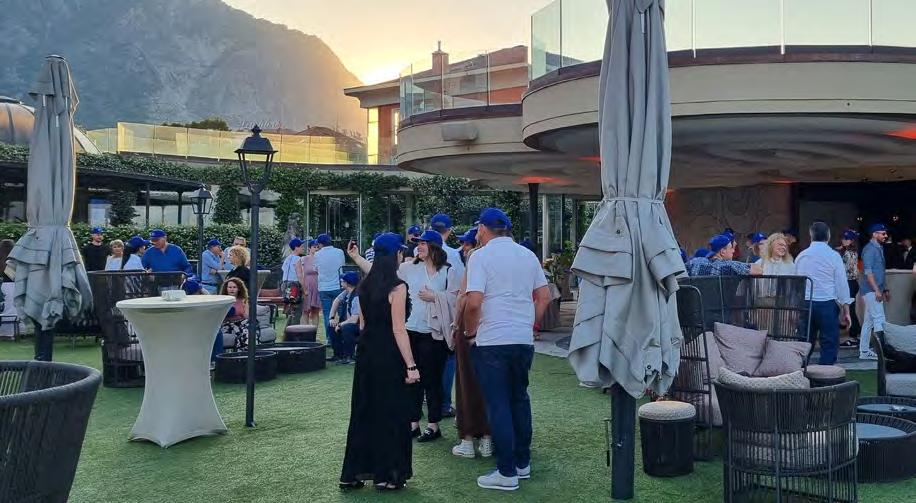
Un altro esempio virtuoso nella filiera del close loop sono invece l’acciaio e l’Alluminio. Se pensiamo alle lattine in alluminio, infatti, il 75% del prodotto è di origine riciclata. In questo contesto il close loop è quindi realtà perché raccolta e filiera sono in grado di garantire la qualità del prodotto finito. I metalli, a differenza dei polimeri, non perdono le loro caratteristiche chimico-fisiche e meccaniche perché appartengono all’universo della chimica inorganica. Nel mondo della chimica organica invece è difficile immaginare un close loop, mentre è possibile pensare a un processo di riciclo che porti alla produzione di materia prima seconda, con destinazioni diverse da quelle di origine. Pensiamo ai campi da calcio, oppure alle chiusure in edilizia, dove la plastica riciclata può svolgere un ruolo importante, proseguendo il suo percorso funzionale anche dopo diverse fasi di riciclo. Sono queste le applicazioni con cui è possibile dare una seconda vita ai materiali polimerici misti non separati o al packaging flessibile, costituito da più strati di materiali difficili da separare”.
Quali sono le soluzioni tecniche oggi disponibili per rispondere alle richieste della normativa?
“La soluzione risiede nel riciclo chimico, che riporta il materiale alla singola molecola e permette di produrre una materia prima seconda rinnovata e perfettamente sicura, ancorché riciclata. Questo è sicuramente uno dei temi dirimenti del convegno, che guarda alla produzione di packaging privi di sostanze pericolose. Va sottolineato che con lo sviluppo tecnico e le nuove conoscenze, assenti negli anni ’60 quando la plastica divenne protagonista del mercato, è oggi possibile rilevare quantità infinitesimali, nell’ordine di parti per miliardo. La tendenza alla sostenibilità vista in chiave quasi ideologica si inserisce in un contesto dove l’Europa incide per il 4% sull’inquinamento globale, pur imponendo normative molto strin-
genti che rappresentano una contraddizione evidente. Vengono infatti promulgate leggi che ne fanno la paladina mondiale della sostenibilità, tema etico fondamentale per le presenti e future generazioni, anche se si ignora che le fonti di inquinamento sono svariate e spesso non adeguatamente monitorate su scala globale”.
Quindi cosa pensa dell’iper-regolamentazione messa in campo dall’Unione Europea? “Abbiamo superato un periodo dove la speculazione ideologica ha prevalso, con scelte non sempre ragionevoli. Serve infatti conciliare la sostenibilità ambientale con quella economica e sociale che includono la competitività delle imprese e la salute dei cittadini. Questo non deve avvenire eludendo la sostenibilità, ma guidando l’azione con solidi processi di ricerca scientifica, la sola in grado di trovare soluzioni innovative che vadano oltre la ripetitività delle consuetudini. Servono quindi R&D e pensiero laterale libero da estremizzazioni, alzando le aspettative verso l’innovazione: la chiave che darà nuovi materiali, meno impattanti, nuovi coating, che solo il processo di R&D può fare emergere o scoprire. Sono infatti convinto che serva guardare alla natura, fonte inesauribile di soluzioni innovative anche nel packaging dei propri prodotti, come ad esempio, la frutta. Ma una cosa è certa, se vogliamo la sostenibilità domani, dobbiamo fare scelte innovative oggi”.

Sustainability and packaging are key words in the packaging world. The two have seen an evolution in their roles over the years, with food safety, waste and attention to the environment undergoing a transition that is not always complementary, highlighting a tendency to radicalise the green components that tends to simplify an extremely complex issue. It is precisely this complexity that was discussed by the professional community of AIBO FCE - the Italian business association of food contact experts - who met in Baveno, on Lake Maggiore, for their annual meeting. A high-profile technical update was proposed by Packaging Meeting and discussed by its president, Ciro Sinagra, Senior R&D Advisor of Laminazione Sottile Group, who with ItaliaImballaggio takes stock of the sector and the association,
Prossimi appuntamenti:
Regulations, technological innovation and scientific research: the food contact community at a conference in Baveno
expressing a hope for an increasingly strong relationship between research and business.
This is an important and wellattended event. Tell us about the association and the goals of your professional community?
“The 13th national food contact expert conference evidences a strongly growing AIBO,” Sinagra began. “The original 36 participants have now risen to 288 active members, professionals and consultants working in companies operating in the packaging market, constantly seeking advice on a question of key importance for health, food quality, food waste and thus sustainability. The conference saw the participation of 170 experts, who addressed topics ranging from national and European regulations to new innovative materials, as well as recycling to reconcile sustainability with regulation. If we look at the PPWR and food contact packaging, we can see that the two often run parallel and do not always coincide, as it is absolutely necessary for them to do. Think of the key importance of single-use packaging, reuse and recycling, environmental questions that often conflict with the need to protect the food and therefore consumer health”.
International Conference on Food Contact Compliance: XII edizione
Baveno 30 settembre, 1-2 ottobre
Info: formazione@packagingmeeting.it
Upcoming events:
International Conference on Food Contact Compliance: 12th edition
Baveno, 30 September, 1-2 October
Info: formazione@packagingmeeting.it
Food contact is strategic because of the complexity of the issue and the challenges it presents. What are the prospects for the sector?
“Each of us consumes an average of 700 kg of food per year, using, in various ways, 150 square metres of packaging, the equivalent of a volleyball court. These are food contact surfaces that require constant monitoring of the migration between packaging and food. This requires attention to regulations and the consolidation, or even better the expansion, of the professional figures called upon to deal with regulatory compliance, food safety and quality: this is where AIBO comes in. Our members range from materials manufacturers to the food industry, as well as toxicologists and the consultants companies need for full compliance with national and European regulations. Ours is a highly participative association with a rich member base, boasting advanced skills possessed by people in the company who play a strategic role in food safety, shelf life and sustainability. As regards sustainability, recycling is certainly a key environmental issue; however, the impact of food safety on consumer health and wellbeing must prevail. So, while it is right to give packaging a second life, safety remains paramount. It is interesting to note that there is constant turnover in the association, with the entry of young professionals able to bring about a generational change that we are keen to foster as an association and as long-established professionals in the sector”.
The PPWR is pushing for an increasing presence of recycled materials, with a number of issues still to be resolved regarding machinability and food safety: what developments do you envisage?
“If we think of recycled materials, specific tests have shown that virgin plastic has a neutral impact on human genetics, which is not the case with recycled solutions, on which mutagenic impacts have sometimes been found. This is a question we share with the health and pharmaceutical sector: food packaging has food safety implications that must take precedence over sustainability, thus opening up a reflection on the need to rebalance the role of recycling and reuse and sustainable solutions in general. In short, yes to recycling, but safely first”.
Does the recycling supply chain control have an impact on this process?
“The recycling of plastics, especially closed-loop recycling, is something of a pipe dream, in my opinion. It has been scientifically proven that certain recycling processes cause a change in the physical and mechanical characteristics and molecular weight of plastics. So, it won’t be possible in the immediate future to work on the closed loop process so that a tray can be recycled into a new one; this type of process is only possible with certain products and in supply chains that are able to deploy specific strategies. One example is PET, which is fully recyclable if the content allows it: a bottle containing water can be recycled into a new one, while this is impossible if the bottle has contained a chemical. Other virtuous examples in the closed-loop supply chain are steel and aluminium. Aluminium cans, for instance, are of 75% recycled origin. So here, the closed loop is a reality; it’s feasible because the collection
system and the supply chain are able to guarantee the quality of the finished product. Unlike polymers, metals do not lose their chemicalphysical and mechanical properties because they belong to the universe of inorganic chemistry. In the world of organic chemistry, on the other hand, it is difficult to imagine a closed loop, while it is possible to envisage a recycling process leading to the production of a second raw material, with destinations other than the original destination. Think of football pitches, or of closures in the construction industry, where recycled plastic can play an important role, continuing its functional path even after several recycling phases. It is with these applications that it is possible to give a second life to non-separated mixed polymer materials or flexible packaging consisting of several layers of materials that are difficult to separate”.
What technical solutions are available today to meet the regulatory requirements?
“The solution lies in chemical recycling, which brings the material back to the single molecule and makes it possible to produce a renewed and perfectly safe second raw material, even if it is recycled. This is certainly one of the key themes of the conference, which looks at the production of packaging free from hazardous substances. It should be emphasised that with the technical advances and new knowledge we did not have in the 1960s when plastics became a market player, it is now possible to detect infinitesimal quantities, in the order of parts per billion. The trend towards sustainability envisioned in an almost ideological sense is set in a context where Europe accounts for 4% of global pollution, while imposing very stringent regulations that represent a glaring contradiction: while laws are enacted in Europe to champion sustainability more than anywhere
else in the world, prompted by its fundamental ethical importance for present and future generations, the fact that the sources of pollution are varied and often inadequately monitored on a global scale is often ignored”.
So, what do you think of the over-regulation on the part of the European Union?
“We have come through a period where ideological speculation prevailed, with choices that were not always reasonable. We must reconcile environmental sustainability with economic and social sustainability, which includes business competitiveness and citizens’ health. This must be done not by circumventing sustainability, but by guiding actions with solid scientific research processes: this is the only way to find innovative solutions that go beyond the repetitiveness of our habits. Therefore, R&D and lateral thinking are required, without taking things to extremes, raising expectations regarding innovation, because this
is destined to be the key to less impactful materials and new coatings that only the R&D process can discover and bring to light. I am convinced that we must look to nature, which is an inexhaustible source of innovative solutions, even for the packaging of products such as fruit. One thing is sure, however: if we want sustainability tomorrow, we have to make innovative choices today”.




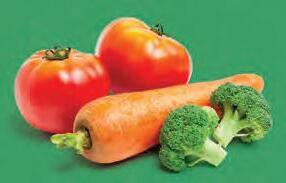



La frutta e verdura è raccolta all’apice della maturità, in piena stagione. Passano appena 6 ore dalla raccolta alla messa in conserva, così da preservarne le vitamine ed i minerali. www.verimec.it • www.massilly.com • verimec@massilly.com


Gipea, in Puglia il convegno annuale: al centro geopolitica, PPWR e il delicato tema dell’aumento del contributo ambientale Conai
Idazi e le tensioni geopolitiche, il PPWR, la revisione del contributo ambientale Conai: i grandi temi, al congresso annuale Gipea, non sono certo mancati. I produttori di etichette autoadesive si sono riuniti per due giorni di networking e aggiornamento professionale nella bellissima cornice dell’Hotel Torre Cintola di Monopoli. Accarezzati dal vento caldo che soffiava sulla Puglia, imprenditori e tecnici specializzati di tutta la filiera hanno approfondito le principali sfide del momento ed esplorato le nuove opportunità offerte dall’innovazione tecnologica e dall’intelligenza artificiale.
A fare gli onori di casa sono stati il presidente di Assografici Carlo Montedoro (“Ci impegniamo a lavorare a fianco di Gipea per trovare le migliori soluzioni per i problemi del settore delle etichette autoadesive”, ha detto) e il presidente di Gipea Stefano Salvemini: “Di fronte agli scenari di grande incertezza nei quali ci troviamo a operare - ha affermato -, dobbiamo saperci reinventare, costruire strategie di reazione e coltivare la nostra resilienza”.
Tra i momenti che più hanno coinvolto la platea c’è stato sicuramente l’approfondimento dedicato al CAC, il contributo ambientale Conai. Come
noto, infatti, Conai ha recentemente rivisto le modalità di calcolo per la procedura forfettaria del contributo ambientale sulle etichette. In sintesi - spiega Gipea - ha previsto un forfait diverso sul fatturato relativo ad ogni materiale (carta, plastica e alluminio), correlato al rispettivo CAC in procedura ordinaria, con la conseguenza che il forfait sul fatturato relativo all’immesso in commercio di etichette autoadesive in plastica si incrementerà a regime (2026) fino a quasi 20 volte rispetto al 2024. Il segretario Gipea e vicedirettore di Assografici Italo Vailati ha riepilogato ai presenti il fondamentale ruolo del Conai e del sistema consortile in Italia. Il consigliere Gipea Alberto Ghiotto ha ricordato perché, fin dai primi anni duemila, è stata prevista la procedura forfettaria che, quando adottata, consente ai produttori di etichette di assolvere ‘alla fonte’ al CAC, anziché riversarlo in fattura sugli utilizzatori, come avviene ordinariamente per tutti gli altri imballaggi. Il vicepresidente Gipea Gianni Olivieri ha spiegato come, date le nuove procedure di calcolo, la soluzione forfettaria non sia più sostenibile per le aziende produttrici di etichette (il contributo arriva a pesare per il 2% sul loro fatturato, quando in media le aziende del settore hanno risultati di marginalità del 4%) e
Gipea


come quindi Gipea e Assografici abbiano interloquito con il Conai per segnalare tale situazione e per chiederne una revisione. Un confronto che ha dato ottimi risultati: il Cda di Conai, infatti, ha ratificato uno ‘sconto’ sul forfait 2025 ed è stato riaperto un tavolo di lavoro per ridefinire le regole dal 2026 in avanti. “Gipea e Assografici ringraziano il Conai per la sensibilità dimostrata a un problema reale denunciato dai consorziati e per essersi aperti al dialogo - spiega il Gruppo - Ora l’impegno associativo si riverserà sul tavolo di lavoro per il quale Gipea chiede la massima collaborazione da parte delle aziende associate”.
Ampio spazio, durante il convegno di Monopoli, è stato dato anche alla fotografia del settore fornita dai numeri. Vito Giurazza, membro del board FINAT, ha illustrato l’andamento del mercato europeo: “Dopo il crollo del mercato del 2023, legato prevalentemente ai temi del Covid e del superstocking, oggi siamo tornati a un livello new normal, ma con un mix profondamente diverso. L’Italia, negli ultimi tre anni, è però passata dal rappresentare l’11% del mercato europeo, al 13%”.
Gipea, annual conference in Puglia: focus on geopolitics, the PPWR and the sensitive issue of increasing the Conai environmental contribution
Tariffs and geopolitical tensions, the PPWR, the review of Conai’s environmental contribution: there was no shortage of big issues to discuss at Gipea’s annual congress. Self-adhesive label manufacturers gathered for two days of networking and professional development in the beautiful setting of the Torre Cintola Hotel in Monopoli. Caressed by the warm wind blowing over the Puglia region, entrepreneurs and technical specialists from across the supply chain delved into the main challenges of the moment and explored the new opportunities offered by technological innovation and artificial intelligence.
Doing the honours were Assografici President Carlo Montedoro (“We are committed to working with Gipea to find the best solutions for the problems of the self-adhesive label industry”, he said) and Gipea President Stefano Salvemini: “Given the scenarios of great uncertainty we find ourselves operating in”, he said, “we need to know how to reinvent ourselves, build coping strategies and cultivate our resilience”.
Molto seguita anche l’analisi degli sviluppi legislativi europei in materia di competitività, sostenibilità e imballaggi a cura di Francesca Stevens, segretario generale di Europen. “Chiediamo di avere regolamentazioni che si basino su dati scientifici, e che tengano conto della necessità di tornare a essere competitivi sui mercati internazionali. Ricordando che non può esserci competitività senza un mercato unico europeo”. Inevitabile, infine, un riferimento al complesso momento geopolitico. Se Carlo Amenta, professore associato di Scienze economiche, aziendali e statistiche dell’Università degli studi di Palermo, ha approfondito la direzione delineata dall’UE per aumentare la competitività delle imprese, Giada Messetti, sinologa e autrice di programmi televisivi e radiofonici, si è concentrata sul ruolo della Cina nello scenario internazionale: “La Cina sa che avere la leadership tecnologica oggi significa avere la leadership mondiale e si sta muovendo in questa direzione. La politica imprevedibile di Trump sta aiutando la Cina a presentarsi come un partner coerente e affidabile”.
Among the moments that engaged the audience most was undoubtedly the in-depth discussion devoted to CAC, the Conai environmental contribution. It is widely known that Conai has recently reviewed the calculation methods for the flat-rate procedure for the environmental contribution on labels. In short, Gipea explains, it has provided for a different flat rate on turnover for each material (paper, plastic and aluminium), correlated with the respective CAC in the ordinary procedure, with the result that when fully implemented (2026), the flat rate on turnover related to the placing on the market of selfadhesive plastic labels will increase by almost 20 times compared to 2024. Gipea secretary and Assografici deputy director Italo Vailati provided the audience with a summary of the fundamental role of Conai and the consortium system in Italy. Gipea board member Alberto Ghiotto recalled the reasons for the adoption since the early 2000s of the flat-rate procedure, which allows label manufacturers to pay the CAC obligation ‘at source’, rather than
passing it on to users in the invoice, as is the normal practice for all other packaging. Gipea vice-president Gianni Olivieri explained that, given the new calculation procedures, the flat-rate solution is no longer sustainable for label companies (the contribution can amount to 2% of their turnover, when on average companies in the sector have margins of 4%) and that Gipea and Assografici have therefore been in talks with Conai to point out this situation and to ask for a review. These talks have yielded excellent results: the Conai Board of Directors ratified a ‘discount’ on the 2025 flat rate and a working group was re-established to redefine the rules from 2026 onwards. “Gipea and Assografici would like to thank Conai for its sensitivity to a real problem reported by the consortium members and for being open to dialogue”, the group explains. “Now the association’s efforts will be focused on the working group, for which Gipea asks for maximum cooperation from member companies”.
Ample time during the Monopoli conference was also devoted to the snapshot of the industry provided by the figures. FINAT board member Vito Giurazza explained the European market trend: “After the market crash of 2023, mainly related to COVID-19 and overstocking, today we are back
to a new normal, but with a profoundly different mix. However, in the last three years, Italy has gone from accounting for 11% of the European market up to 13%”. The audience also showed great interest in the analysis, by Francesca Stevens, secretary general of Europen, of legislative developments regarding competitiveness, sustainability and packaging. “We are calling for regulations that are based on scientific data, and that take into account the need to become competitive again in international markets, remembering that there can be no competitiveness without a single European market”. Lastly, an inevitable reference to the complex geopolitical situation. Carlo Amenta, associate professor of economic, business and statistical sciences at the University of Palermo looked into the direction outlined by the EU to boost business competitiveness, while Giada Messetti, a sinologist who makes television and radio programs, focused on China’s role in the international scenario: “China knows that having technological leadership today means having world leadership, and is moving in this direction. Trump’s unpredictable policies are helping China to present itself as a consistent and reliable partner”.
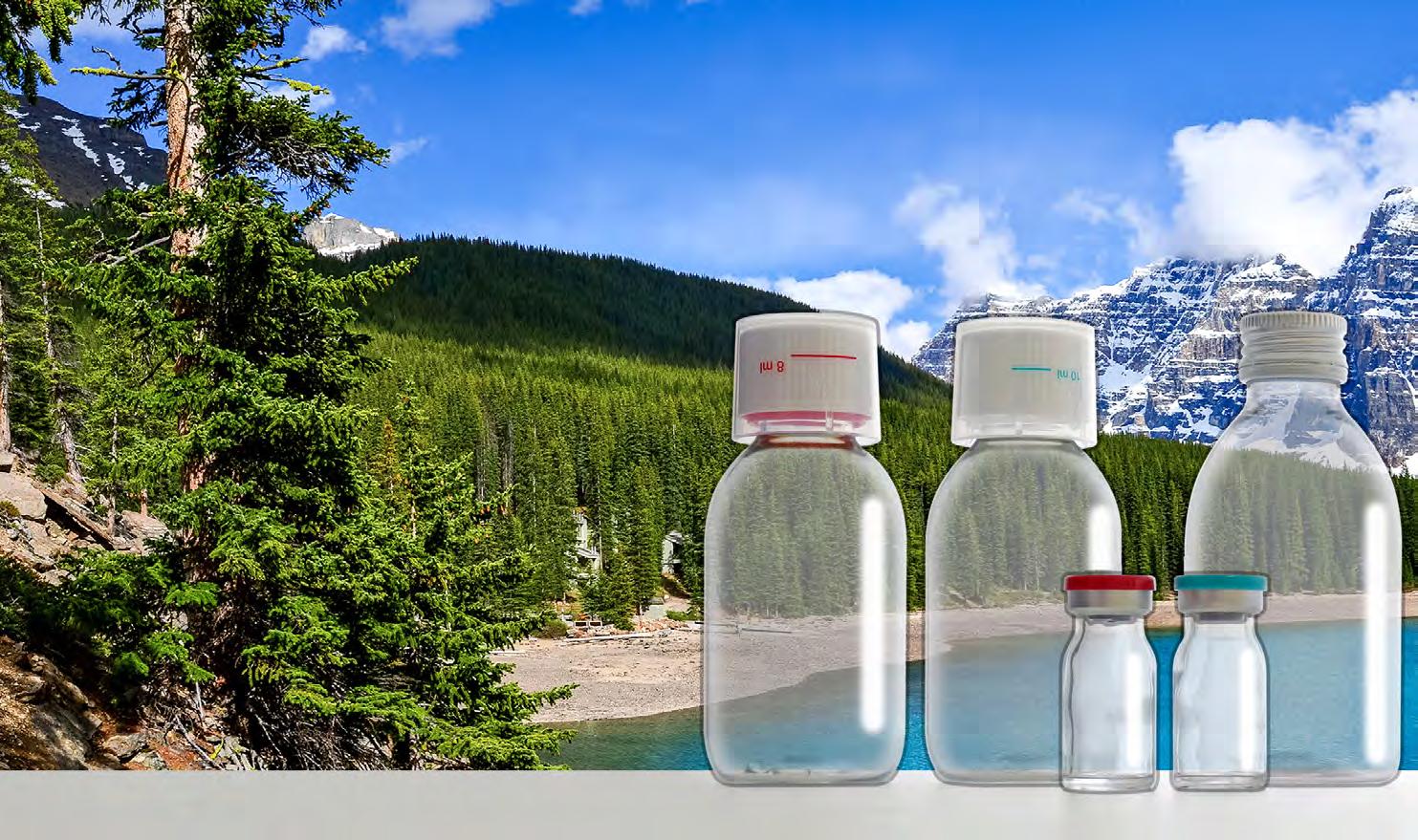
Un racconto lungo e bello, quello di Capsulit, fatto di ricerca e innovazione nella produzione di sistemi di chiusura all’insegna della sicurezza. Con focus sul mercato farmaceutico e nutraceutico, ma con qualche significativa incursione nel cosmetico e nel food, mantiene alta la reputazione di orgogliosa “azienda familiare”, capace di guardare al di là dei confini nazionali.
Nel 1949, tre amici decisero di avviare un’attività industriale a Milano per la produzione di sistemi di chiusura per il settore farmaceutico; dopo il trasferimento delle attività produttive nel 1964, la società si stabilì definitivamente nel 1993 a Roncello (MB), sede attuale dell’azienda.
Capsulit si è via via specializzata nella produzione di chiusure in alluminio e plastica, in particolare di capsule per iniettabili, capsule pilfer proof e child proof, misurini e cucchiaini dosatori e capsule per monodose.
Nel 1974 è stata fondata Capsulit Iberica a Polinyà, nei pressi di Barcellona, che distribuisce su tutto il territorio spagnolo i prodotti di Capsulit, ma anche di altri produttori di packaging.
Nel 2019, l’acquisizione della società Giglioli Fabrizio - ora Capsulit Giglioli, con sede in provincia di Modena - ha consentito a Capsulit di ampliare e completare la gamma di packaging, fornendo flaconi monodose e multidose, fiale e pilloliere in PET da abbinare alle sue chiusure, avviando così la propria espansione anche nel settore nutraceutico.
Un fatturato 2024 di 41 milioni di euro (per il 60% derivato dall’export), più di 100 addetti dislocati tra gli stabilimenti di Roncello (MB), Rovereto s/Secchia (MO) e Polinyà (Barcellona), investimenti mirati al miglioramento continuo, il più importante dei quali rappresentato dall’attuale ampliamento della sede produttiva lombarda, che consentirà di fare ulteriori investimenti in tecnologia, oltre che a ottimizzare la produzione.
Questi, in estrema sintesi, i numeri e i fatti che segnano il presente di Capsulit, rimarcandone la posizione di prestigio guadagnata sia sul mercato estero sia interno da cui, negli anni, è stata premiata per qualità delle proposte, capacità di ascolto e flessibilità.
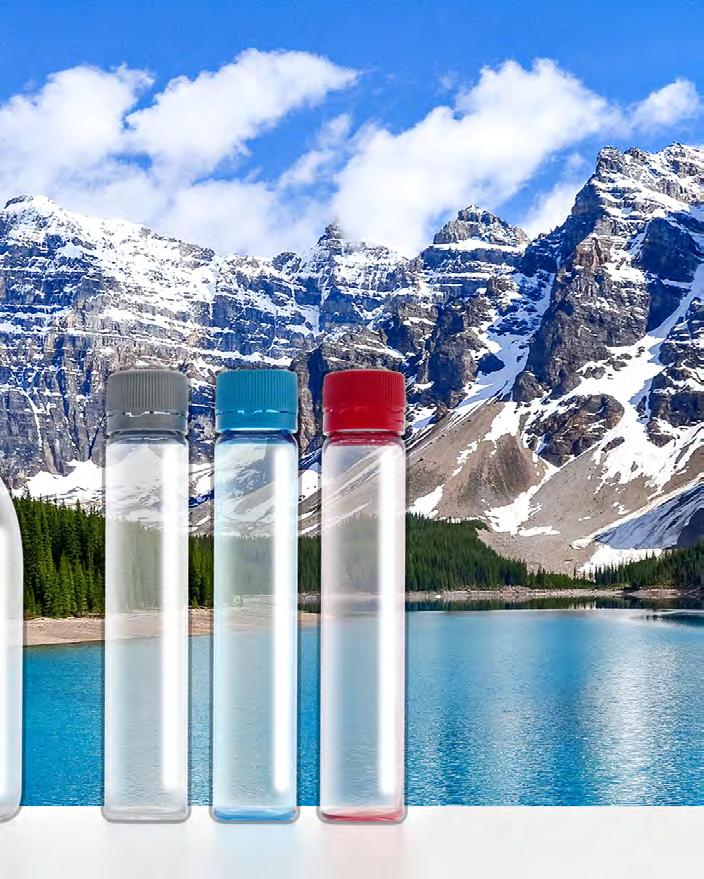
La parola a...
Insieme al vanto di aver raggiunto un invidiabile traguardo temporale, l’Export Director, Alessandro Vavalà, il Sales Director Gianluca Rossi, nonché Elisa Rizzardi, Sustainability Manager, possono descrivere al meglio caratteristiche e potenzialità di un’azienda solida, proiettata nel futuro. Lasciamo quindi a loro la parola.
«Anzitutto - esordisce proprio la giovane Elisa - Capsulit è un’azienda familiare e questo è un aspetto che fa la differenza, dato che ci permette di essere molto flessibili in un mercato dove strutture, spesso “pachidermiche”, forniscono risposte molto lente, a scapito del servizio».
Tutto in casa e certificato. «Siamo un’eccezione tra i fornitori di packaging per il farma, è vero, ma - interviene Vavalà - non è che avere dimensioni ridotte rispetto ai concorrenti significhi essere meno strutturati: noi facciamo tutto al nostro interno, a partire dalla progettazione delle chiusure e dei contenitori, fino alla gestione delle spedizioni. Questo ci consente di esercitare il pieno controllo su ogni fase della lavorazione, di cui documentiamo in dettaglio ogni aspetto, garantendo tutti gli standard qualitativi conformi alle richieste dell’industria farmaceutica».

Flessibilità e tempi di risposta. Capsulit è dunque un esempio concreto di quella tradizione che fa delle “family company” di medie dimensioni un tassello fondamentale del tessuto imprenditoriale italiano.
«Noi, per così dire, “ci mettiamo ancora la faccia” dato che i nostri clienti continuano ad avere degli interlocutori ben definiti dal punto di vista manageriale» riprende Vavalà «e questo è un plus, perché significa poter stabilire con il mercato dei rapporti improntati alla concretezza e alla stabilità».
Queste dichiarazioni sono avvalorate dalle certificazioni ISO ottenute nel corso degli anni «per la qualità (ISO 15378 e ISO 9001), la sicurezza (ISO 45001) e l’ambiente (ISO 14001), nonché per i dispositivi medici (ISO 13485 e MDR 2017-745) e dalla medaglia d’argento Ecovadis per la sostenibilità» precisa Rizzardi. Il Sales Director, Gianluca Rossi, sottolinea un altro aspetto determinante del passato e del presente della società: «Abbiamo iniziato a produrre capsule in alluminio per sciroppi, avviando in un secondo tempo la produzione di chiusure in plastica, per arrivare alle capsule in alluminio e plastica specifiche per i farmaci iniettabili. Si è trattato di un’integrazione progressiva che ci ha consentito di affermarci su scala globale come uno dei pochi produttori in grado di fornire questa doppia tecnologia, coadiuvata dagli investimenti in sistemi di assemblaggio automatizzati di ultima generazione». Rossi riferisce anche dell’ulteriore ampliamento di gamma, ottenuto con l’acquisizione nel 2019 della Giglioli «frutto di un piano di investimento che, durante il periodo della pandemia, ha giocoforza subito qualche rallentamento: oggi, tuttavia, anche quella realtà si è ampiamente consolidata e le prospettive sono buone. Nel plant di Modena abbiamo investito in linee e macchine a iniezione/stiro/soffiaggio dedicate alla produzione di flaconi monodose, multidose, fiale e pilloliere. Anche in questo ambito, riusciamo quindi a evadere le richieste di importanti produttori, oltre a competere alla pari con aziende ben più grandi di noi».
«Lavoriamo tanto con multinazionali in tutte le parti del mondo - riprende Rossi - quanto con aziende medio/piccole o addirittura laboratori, che si rivolgono a noi, perché siamo disposti ad ascoltarli e a fornire sempre i servizi richiesti. E, nel caso i nostri interlocutori siano aziende familiari, molto vale la visione comune del fare impresa e il reciproco apprezzamento».
Conta dunque ancora molto l’esperienza e la qualità del rapporto creato nel tempo, basato su alcuni presupposti fondamentali: la disponibilità e la capacità di ascolto, nonché l’affidabilità dei tempi di reazione alle richieste, che deriva dal poter contare su una struttura snella, flessibile e competente.
Un’area di eccellenza, in divenire. Obiettivo 2025 di Capsulit è terminare a fine anno l’ampliamento della sede produttiva lombarda: un nuovo capannone di circa 5.000 m2 collegato alla struttura esistente, progettati per diventare un unico corpo.
«Nel nuovo stabilimento sposteremo il reparto assemblaggio - precisa Elisa Rizzardi - insieme ad alcuni uffici e alla mensa, così da poter ottimizzare la produzione, ma anche migliorare la qualità della vita lavorativa dei dipendenti. Nello stabilimento già esistente, invece, verranno ampliati il reparto plastica e l’attrezzeria. A fronte della crescita progressiva del business di questi ultimi anni, la mancanza di spazio ci rendeva più difficile aggiungere nuovi macchinari, ma ora, con la nuova disposizione, potremo portare avanti ulteriori piani di sviluppo».
Capsulit boasts a long, impressive track record of research and innovation in the production of safety closures. With a main focus on the pharmaceutical and nutraceutical markets, but with some significant forays into cosmetics and food, it maintains an excellent reputation as a proud “family business” able to look beyond national borders.
Luciana Guidotti*
In 1949, three friends decided to start a business in Milan for the production of closures; after an initial transfer of operations in 1964, the company settled in 1993 in Roncello (MB), the company’s current home.
After abandoning the initial production of capsuling machines, Capsulit has gradually specialized in the production of aluminium and plastic closures for the pharmaceutical industry, particularly caps for injectables, pilfer proof and child proof caps, measuring cups and measuring spoons, and caps for single-dose solutions.
1974 saw the foundation of Capsulit Iberica in Polinyà, near Barcelona, which distributes Capsulit’s products, as well as those of other packaging manufacturers, throughout Spain.
In 2019, the acquisition of the former Giglioli Fabrizio - now Capsulit Giglioli, based in the province of Modena - enabled the company to expand and complete its packaging range, supplying single-dose and multidose bottles, vials and pill bottles in PET to match the closures, thus initiating expansion into the nutraceutical sector.
A 2024 turnover of 41 million euros (60 percent of which from exports), more than 100 employees located between the plants in Roncello (MB), Rovereto s/Secchia (MO) and Polinyà (Barcelona), and investments aimed at continuous improvement, the most important of which is represented by the current expansion of the Lombardy production site, which will allow for further investments in technology, as well as optimising production.
In a nutshell, these figures and developments illustrate the current situation of Capsulit, highlighting the prestigious position it has earned on both foreign and domestic markets, which, over the years, have appreciated the quality of its proposals, ability to listen, and flexibility.
Let’s hear from...
In addition to their pride in the enviable longevity of the company, export director Alessandro Vavalà, sales director Gianluca Rossi, and sustainability manager Elisa Rizzardi are the best people to describe the characteristics and potential of a solid, future-oriented company, so let’s hear from them.
“First of all”, begins the young Elisa, “Capsulit is a family business, and this makes all the difference, because it allows us to be very flexible in a market where structures, which are often outdated and cumbersome, provide very slow responses, to the detriment of service”.
Everything in-house and certified.
“It’s true that we are an exception among suppliers of packaging for the pharmaceutical sector”, Vavalà says, “but being smaller than our competitors doesn’t mean we are less structured: we do everything in-house, from the design of closures and containers to handling shipments. This gives us full control over every stage of processing, every aspect of which we document in detail, ensuring all quality standards that meet the requirements of the pharmaceutical industry”.
These statements are corroborated by ISO certifications obtained over the years “for quality (ISO 15378 and ISO 9001), safety (ISO 45001) and environment (ISO 14001), as well as for medical devices (ISO 13485 and MDR 2017-745) and the Ecovadis silver medal for sustainability”, Rizzardi points out. Sales director Gianluca Rossi mentions another crucial aspect of the company’s past and present: “We started producing aluminium caps for syrups, and went on to producing plastic injection moulding closures, and finally started producing aluminium and plastic caps specifically for injectable drugs. This gradual integration has enabled us to establish ourselves on a global scale as one of the few manufacturers able to offer this dual technology, aided by investments in state-of-the-art automated assembly systems”. Rossi also mentions further range expansion achieved with the acquisition in 2019 of Giglioli, “the result of an investment plan that during the pandemic unavoidably slowed down to an extent: today, however, this has also largely been consolidated, and the prospects are good. At the Modena plant, we have invested in injection/stretch/blow moulding lines and machines for the production of single-dose, multi-dose bottles, vials and pill bottles. In this area we are thus also able to respond to the requests of major manufacturers, as well as compete on an equal footing with companies much larger than our own”.
Flexibility and response time. Capsulit is an example of the tradition that makes medium-sized “family companies” a key part of the Italian business fabric.
“We still ‘put ourselves out there’, so to speak, in the sense that our customers continue to know who they’re talking to, from a managerial point of view”, Vavalà explains, “and this is a plus, because it allows us to establish strong, stable relationships with the market”.
“We work with both multinational corporations in all parts of the world”, Rossi continues, “and small/ medium-sized companies or even workshops, who come to us because we are willing to listen to them and always provide the services they require. And, when we’re dealing with other family businesses, it helps to have a shared common vision of doing business and mutual appreciation”. So experience and the quality of the relationship created over time, based on a number of fundamental aspects, still counts a lot: the willingness and ability to listen, as well as reliable times for reacting to requests, which comes from being able to count on a lean, flexible and competent structure.
An area of excellence, evolving all the time. Capsulit’s 2025 goal is to complete the expansion of the production facility in Lombardy by the end of the year: a new warehouse of about 5,000 m2 connected to the existing facility, designed to become a single unit.
NOTE
“We’ll be moving the assembly department to the new plant”, explains Elisa Rizzardi, “along with some offices and the canteen, so that we can not only optimise production, but also improve the quality of working life for employees. In the existing plant, the plastic department and tooling shop will be expanded. With the gradual growth of the business in recent years, the lack of space made it more difficult for us to add new machinery, but now, with the new layout, we will be able to pursue further development plans”.
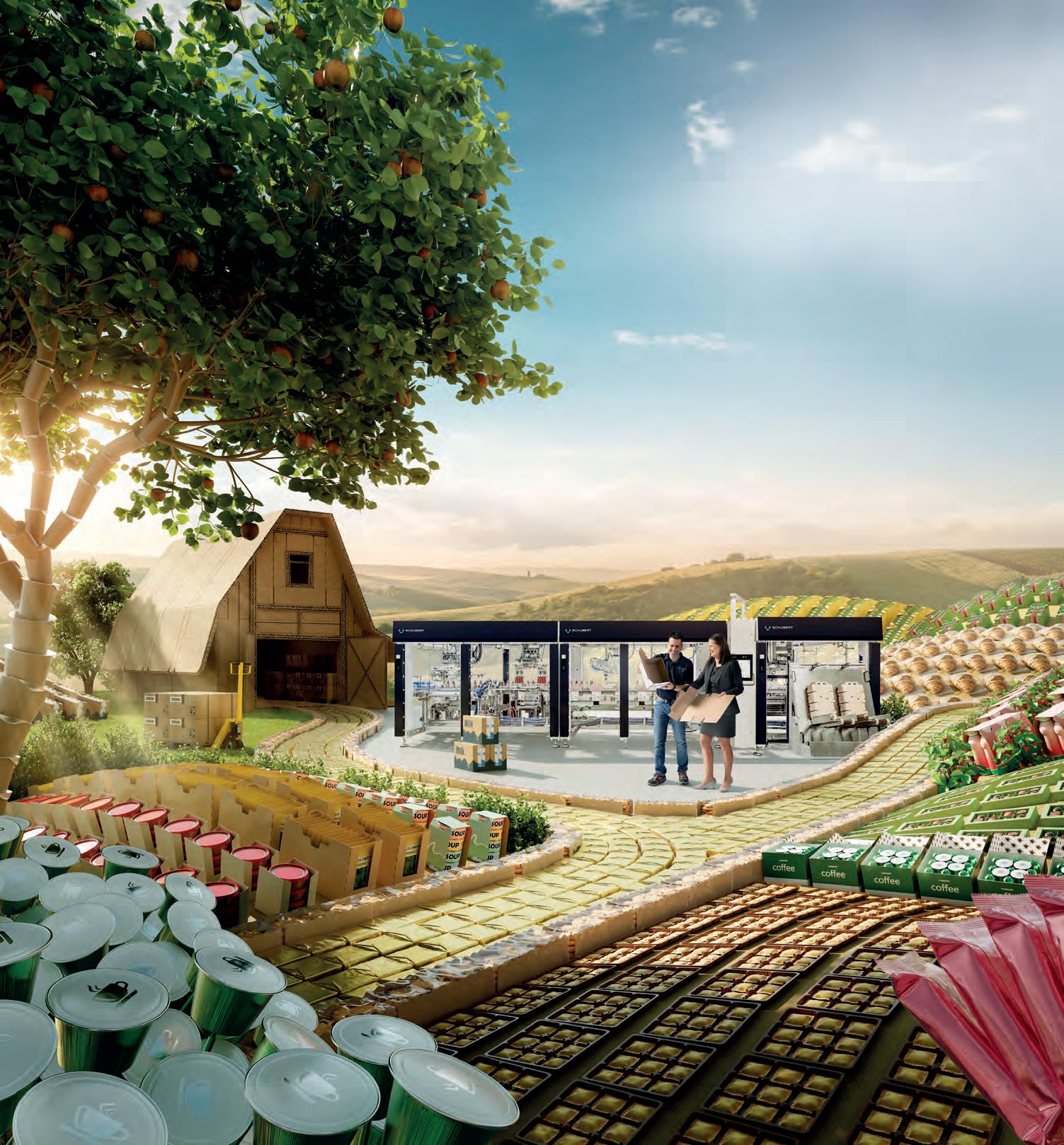
A PERDITA D‘OCCHIO: CONFEZIONAMENTO DI ALIMENTI DI OGNI SORTA. REALIZZATO AL MEGLIO CON SCHUBERT.

Essere flessibili va bene, essere veloci e flessibili è meglio. Le macchine confezionatrici della Schubert dimostrano come si fa. Il controllo intelligente e la robotica precisa sostituiscono la meccanica complicata garantendo la massima flessibilità in tutti i processi di confezionamento. Di conseguenza l‘80% dei gruppi industriali leader di FMCG (fast-moving consumer goods) si affidano a noi e al confezionamento perfetto con consumi minimi. Proprio come vuole la nostra Mission Blue. Creiamo situazioni win-win: per il pianeta e per voi. www.schubert.group/en/food.html
Marcel, Ingegnere Meccanico
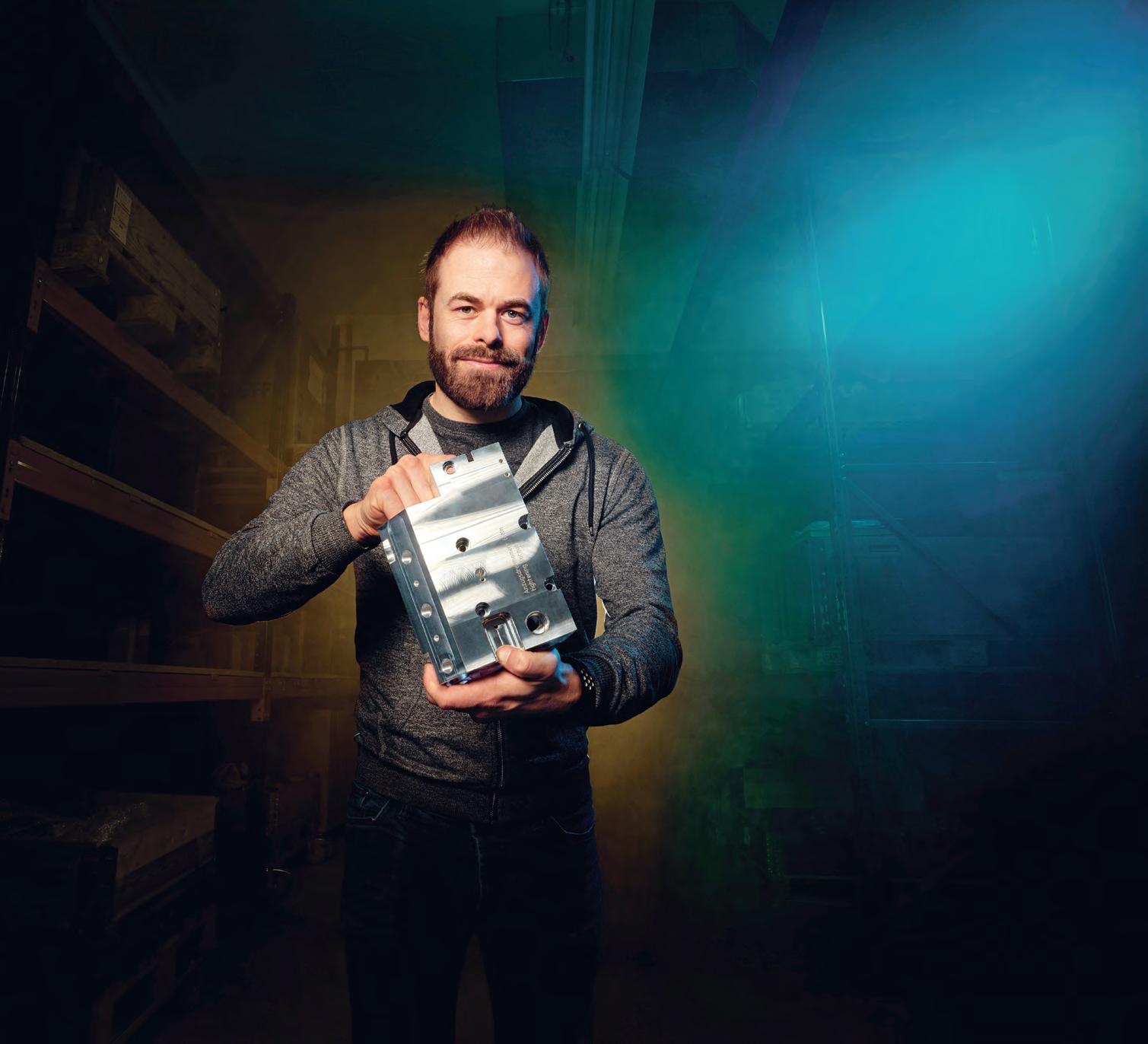

Alpha, fusore polivalente ad alte prestazioni.
È il momento della generazione Alpha. Pensare in modo nuovo, puntare su ciò che è collaudato. Perché abbiamo un obiettivo: il vostro successo. Capacità di fusione elevata e affidabilità, componenti durevoli, dimensioni compatte, eccellente sicurezza sul lavoro. Affinché possiate affrontare il futuro in tutta sicurezza.
Scoprite di più su Alpha.

Il brand, punto di riferimento internazionale nella progettazione e costruzione di macchine per il confezionamento, si rinnova grazie alla guida del nuovo amministratore Unico Andrea Alessandrini.
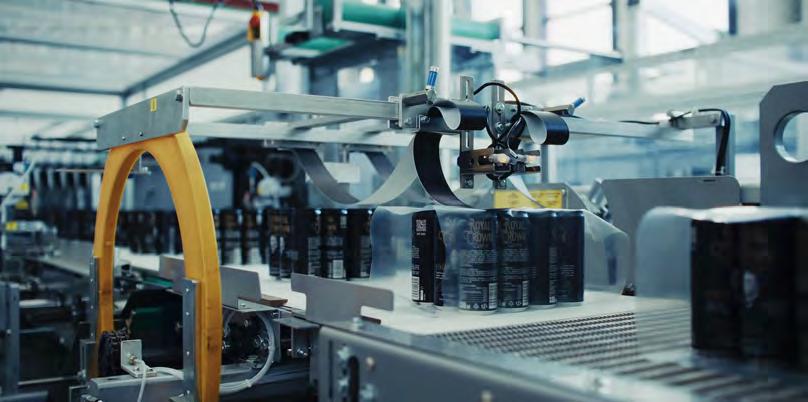
Da oltre 55 anni Zambelli offre soluzioni su misura per settori ad alta complessità come food & beverage, caffè, pet food, household & personal care e industriale, affiancando i clienti con un approccio sartoriale e altamente personalizzato che abbraccia l’intero processo: dalla progettazione al supporto tecnico continuo fino a un post-vendita evoluto, il tutto su scala globale.
La rete di Zambelli, presente in 60 paesi e con oltre 2500 macchine installate, è costituita da partnership solide, basate su rapporti di fiducia fondati sulla capacità di offrire ai clienti efficienza operativa e innovazione costante. Andrea Alessandrini racconta le ultime novità in casa Zambelli, evidenziando come l’innovazione non si limiti soltanto agli aspetti tecnologici.
“L’azienda sta vivendo una significativa evoluzione organizzativa, frutto dell’inserimento di nuove competenze manageriali. Questo processo ha rafforzato le già solide capacità interne, integrandole con funzioni strategiche che puntano a consolidare ulteriormente la visibilità e l’autorevolezza del brand Zambelli sul mercato internazionale”.

Il marchio Zambelli rappresenta un brand storico del mercato del packaging. Con quali macchine siete presenti sul mercato?
«Il portfolio di Zambelli Packaging nasce da una solida esperienza industriale avviata alla fine degli anni ’60” osserva Andrea Alessandrini “Oggi offre un’ampia gamma di soluzioni progettate per rispondere alle esigenze delle aziende di beni di largo consumo di tutto il mondo, che mirano a ottimizzare i propri processi di packaging coniugando efficienza, flessibilità e qualità.
La nostra gamma comprende fardellatrici a basso consumo energetico, incartonatrici a moto continuo per confezionamento in cartone wrap-around o su vassoio e a moto intermittente per scatole in cartone wrap-around o americano (RSC) e astucciatrici sia orizzontali che verticali”. Prosegue ancora Alessandrini “Offriamo inoltre soluzioni COMBI per confezioni in wrap-around, vassoio alto o vassoio combinato con film, sistemi robotizzati pick & place e linee complete chiavi in mano, pensate per garantire massima efficienza e flessibilità nei diversi contesti produttivi».
Un brand consolidato e riconosciuto, importanti novità per etica d’impresa e organizzazione. Ci racconta la sua visione? «Credo fortemente nell’importanza di costruire relazioni basate sulla fiducia” racconta Alessandrini” ogni progetto Zambelli è pensato per integrarsi perfettamente con il processo produttivo del cliente, offrendo flessibilità e supporto tecnico costante. Con il mio ingresso in azienda nel 2024 abbiamo avviato un processo di rinnovamento strategico che ha avuto inizio con il restyling del logo e del visual, simbolo di una nuova fase di crescita orientata all’internazionalizzazione, alla sostenibilità e all’innovazione. Le nostre soluzioni tecnologiche si basano infatti su quattro pilastri fondamentali: efficienza e risparmio energetico, aggiornamento costante e qualità, assistenza globale e soluzioni tailor made. Abbiamo rilevato un’azienda con oltre 50 anni di storia, un brand affermato nel packaging a cui serviva una spinta in termini organizzativi e di gestione del processo. Zambelli era già un punto di riferimento per qualità e affidabilità delle soluzioni. Oggi, accanto alle fardellatrici, l’azienda offre anche linee complete, integrate e chiavi in mano, pronte a rispondere alle esigenze più complesse del packaging.
L’ingresso del nuovo management ha dato una forte spinta all’R&D e alle attività di internazionalizzazione, che vedono oggi Zambelli tornare protagonista nelle principali fiere di settore con la partecipazione a Pack Expo Las Vegas 2025, Drinktec Monaco 2025 e Interpack, nel 2026. Puntiamo infatti a rafforzare la presenza nei mercati chiave e in fiera presenteremo soluzioni complete per il fine linea, con focus su modularità e robotizzazione. Vogliamo creare nuove relazioni per avvicinarci a clienti e prospect, presentandosi come un partner affidabile per chi cerca qualità, innovazione e sostenibilità».
Ha citato i pilastri di un nuovo corso che garantisce continuità pur guardando al futuro di Zambelli: può darci maggiori dettagli?
«Partnership e fiducia sono le nostre parole chiave” prosegue Andrea Alessandrini “e si legano ad un brand da tempo riconosciuto sul mercato per la sua affidabilità e per la capacità di progettare macchine e soluzioni robuste, durevoli ed efficienti, realizzate grazie alla collaborazione con una rete di partner altamente qualificati.
Analizzando nel dettaglio i pilastri su cui si fonda l’evoluzione del brand Zambelli, emerge un forte orientamento verso l’efficienza e il risparmio energetico con tecnologie di efficientamento capaci di performance superiori alla media del settore. Un esempio concreto sono i tunnel di termo-retrazione Zambelli, più efficienti rispetto alla media di mercato grazie all’impiego di sistemi avanzati per la riduzione della dispersione termica.
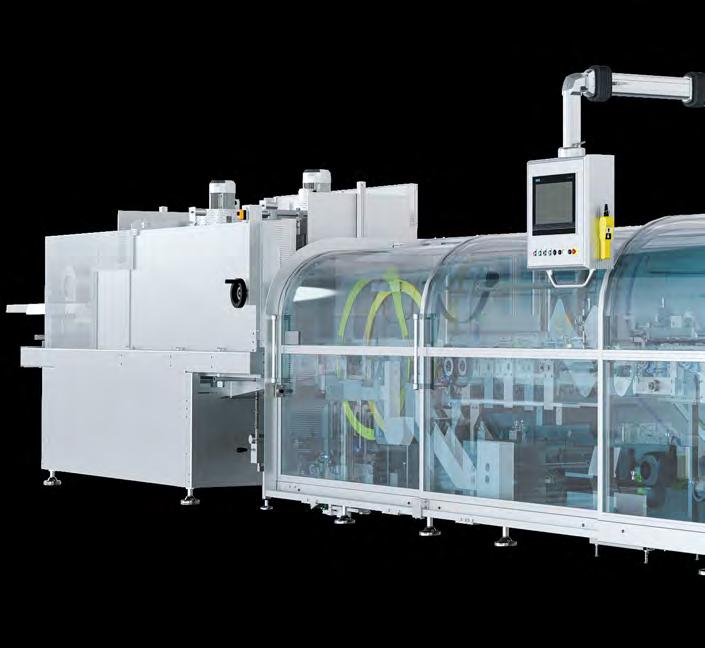
servomotori, la connettività in ottica Industria 4.0, e il controllo da remoto ed il livello di sicurezza CAT3/PLD. Si tratta di plus tecnologici che assicurano prestazioni elevate, in grado di seguire le evoluzioni del mercato, facendo di Zambelli un punto di riferimento anche in chiave futura.
La nostra forza risiede da sempre nella capacità di offrire soluzioni su misura, seguendo ogni fase del processo: dal design alla progettazione, dallo sviluppo fino all’installazione di macchine personalizzate in base alle specifiche esigenze produttive del cliente. Un approccio modulare e scalabile che garantisce massima integrazione e adattabilità.
Fondamentale è anche la capillarità dell’assistenza su scala globale pronta a rispondere 24/7, con attività di manutenzione costante, servizio di ricambistica, assistenza remota e supporto diretto, grazie anche alle sedi dislocate nel mondo in mercati strategici”.
La sostenibilità è un tema cardine per il mercato del packaging a cui Zambelli aggiunge il concetto di modello human-centric. «Sono convinto che innovazione, personalizzazione e sostenibilità rappresentino il vero valore aggiunto di Zambelli” osserva ancora Alessandrini “quello che ne fa un partner tecnologico solido, competente e proiettato verso il futuro. È vero, il mercato del packaging è sempre più orientato a soluzioni sostenibili, connesse e versatili. Noi rispondiamo con una visione industriale in cui l’automazione non è solo efficienza, ma anche intelligenza progettuale al servizio dell’utente. È in questo contesto che si inserisce la filosofia alla base della ‘Human-Centric Company’, che guida le scelte di Zambelli Packaging, mettendo le persone al centro dei percorsi di innovazione, dalla progettazione alla produzione fino all’assistenza al cliente.

Un’azienda human centric mira a costruire rapporti basati sulla fiducia e sull’attenzione al valore delle persone, siano esse clienti o collaboratori. In questa direzione, Zambelli sta introducendo le stesse iniziative di welfare già sviluppate con successo in altri progetti del gruppo, come l’asilo nido aziendale, la palestra interna e la mensa, con l’obiettivo di creare un ambiente di lavoro sempre più attento al benessere e alla qualità della vita.
Una filosofia estesa al cliente, a cui forniamo linee affidabili, continuità di servizio e attenzione nel tempo. L’approccio human centric si esprime anche nel design ergonomico delle macchine, con fardellatrici totalmente ispezionabili che permettono un facile accesso e piena sicurezza all’operatore.
Crediamo profondamente nell’incontro tra impresa e mondo accademico, per questo abbiamo avviato una collaborazione strutturata con l’Alma Mater Studiorum - Università di Bologna, coinvolgendo sia il Dipartimento di Ingegneria sia l’area della Comunicazione. Recentemente abbiamo iniziato un percorso in cui accoglieremo in Zambelli sempre più studenti dedicati a progetti di innovazione e sviluppo.
Per noi, aprirci alle nuove generazioni significa non solo offrire opportunità concrete di crescita professionale, ma anche portare in azienda entusiasmo, curiosità e visioni nuove, elementi fondamentali per affrontare il futuro con energia e consapevolezza.
Sostenibilità è centralità del fattore umano emergono infine anche nella continuità organizzativa garantita in Zambelli, dove la straordinaria competenza del personale, dal fondatore, alla seconda generazione, alle persone in azienda è stata valorizzata e messa a sistema, fondendo passione per il proprio mestiere a nuove competenze manageriali proiettate al futuro»
An international benchmark in the design and construction of packaging machinery, the brand has been renewed under the leadership of new Sole Director Andrea Alessandrini...
For more than 55 years, Zambelli has been offering custom solutions for highly complex sectors such as food & beverage, coffee, pet food, household & personal care, and industry, supporting customers with a highly customised, bespoke approach that encompasses the entire process: from design to ongoing technical support and advanced after-sales, all on a global scale.
The Zambelli network, present in 60 countries and with more than 2500 machines installed, is made up of solid partnerships based on relationships of trust and able to offer customers efficient operations and constant innovation.
Andrea Alessandrini tells us about the latest innovations at Zambelli, highlighting how innovation is not just limited to technological aspects.
“The company is undergoing significant organisational development, resulting from the new managerial skills brought on board. This process has strengthened our already solid in-house capabilities, complementing them with strategic functions that aim to further consolidate the visibility and authority of the Zambelli brand on the international market”.
Zambelli is a long-established name in the packaging world. Tell us about your machines on the market.
“Zambelli Packaging’s portfolio stems from a solid industrial experience that started in the late 1960s,” Andrea Alessandrini explains. “Today it offers a wide range of solutions designed to meet the needs of FMCG companies around the world, which seek to optimise their packaging processes by combining efficiency, flexibility and quality.
Our range includes energy-efficient shrinkwrappers, continuous motion case packers for wrap-around or tray cartons and intermittent motion case packers for wraparound or American (RSC) cartons, and both horizontal and vertical cartoners”. Alessandrini goes on to say that “We also offer COMBI solutions for wrap-around, high tray or combined tray with film, robotised pick & place systems and complete turnkey lines, designed for maximum efficiency and flexibility in different production situations”.
Dove incontrare Zambelli Packaging nel 2025
Pack Expo Las Vegas 2025, 29 settembre - 1 ottobre
South Hall Upper SU-27061
Drinktec Monaco 2025 15 - 19 settembre
Pad. C1 - Stand 213
Where to find Zambelli Packaging in 2025
Pack Expo Las Vegas 2025, 29 September - 1 October
South Hall Upper SU-27061
Drinktec Munich 2025, 15 - 19 September Hall C1 - Stand 213
An established, renowned brand, bringing important innovations in business ethics and organisation. Can you explain your vision for us? “I strongly believe in the importance of building relationships based on trust,” says Alessandrini. “Every Zambelli project is designed to integrate seamlessly with the customer’s production process, offering flexibility and constant technical support. When I joined the company in 2024, we embarked on a strategic renewal process that began with the restyling of the logo and visuals, symbolising a new phase of growth oriented towards internationalisation, sustainability and innovation. Our technological solutions are based on four fundamental pillars: efficiency and energy saving, constant updating and quality, global support, and custom solutions. We took over a company with over 50 years of history, an established brand in packaging that needed a boost in terms of organisation and process management. Zambelli was already a benchmark for reliable, quality solutions. Today, alongside shrinkwrappers, the company also offers complete, integrated, turnkey lines designed to meet the most complex packaging requirements. The new management has given a significant boost to R&D and internationalisation, which have brought Zambelli back to the forefront at major industry trade fairs, and we will be taking part in Pack Expo Las Vegas 2025, Drinktec Munich 2025 and Interpack, in 2026. Our aim is to strengthen our presence in key markets and at the upcoming trade shows we will be presenting complete end-of-line solutions, with a focus on modularity and robotisation. We are seeking to create new relationships to engage more closely with existing and prospective customers, presenting ourselves as a reliable partner for those in search of quality, innovation and sustainability”.
You mentioned the pillars of a new approach able to guarantee continuity while looking to the future of Zambelli: can you give us more details?
“Partnership and trust are our keywords,” continues Andrea Alessandrini, “and they are linked to a brand that has long been recognised on the market for its reliability and ability to design robust, durable and efficient machines and solutions, thanks to the collaboration with a network of highly qualified partners.
If we look in detail at the pillars the evolution of the Zambelli brand is based on, what emerges is a strong orientation towards efficiency and energy saving, with energy efficiency technologies capable of outperforming the industry average.
A case in point are Zambelli’s heat shrink tunnels, which are more efficient than the market average thanks to the use of advanced systems to reduce heat loss.
In terms of technological upgrades and quality, the company offers impressive solutions such as rapid format change automation with servomotors, Industry 4.0 connectivity, and remote control and CAT3/PLD security level. These technologies ensure high performance, able to keep pace with market developments, so Zambelli is set to remain a benchmark going forward.
Our strength has always been our ability to offer tailor-made solutions, following every step of the process: from design and engineering to development and installation of machines customised to the customer’s specific production requirements. This modular, scalable approach guarantees maximum integration and adaptability.
Also of fundamental importance is the vast assistance network on a global scale, ready to respond 24/7, with constant maintenance activities, spare parts service, remote assistance and direct support, also thanks to offices located worldwide in strategic markets”.
Sustainability is a key issue for the packaging market, to which Zambelli adds the concept of a human-centric model.
“I am convinced that innovation, customisation and sustainability represent Zambelli’s true added value,” Alessandrini continues, “what makes it a solid, competent and forward-looking technological partner. The packaging market is in effect increasingly oriented towards sustainable, connected and versatile solutions. We respond with an industrial vision in which automation means not only efficiency, but also design intelligence at the service of the user. It is in this context that the philosophy behind the ‘HumanCentric Company’, which guides Zambelli Packaging’s choices, is brought on board, putting people at the centre of innovation pathways, from design to production, as well as customer service.
A human-centric company aims to build relationships based on trust and focused on the value of people, whether they are customers or employees. With this in mind, Zambelli is introducing the same welfare initiatives that have already been successfully developed in other group projects, such as in-company childcare, the in-house gym and the canteen, with the aim of creating a working environment that is increasingly focused on well-being and quality of life.
This philosophy also extends to the customer, to whom we provide reliable lines, continuity of service and attention over time. The human-centric approach is also evident in the ergonomic design of the machines, with fully inspectable shrinkwrappers that offer easy access and complete safety for the operator.
We firmly believe in engagement between the worlds of business and academia, and we have embarked on a structured collaboration with the Alma Mater StudiorumUniversity of Bologna, involving both the Department of Engineering and the area of Communication. We have recently started a journey in which we will be welcoming more and more students into Zambelli to work on innovation and development projects. For us, opening up to the new generations means not only offering concrete opportunities for professional growth, but also bringing enthusiasm, curiosity and new visions into the company, which are fundamental elements for facing the future with energy and awareness.
Finally, sustainability and the central importance of the human factor also emerge in the organisational continuity guaranteed at Zambelli, where the extraordinary expertise of the staff, the founder, the second generation and the people in the company has been enhanced and systematised, combining a passion for their craft with new managerial skills geared towards the future”.
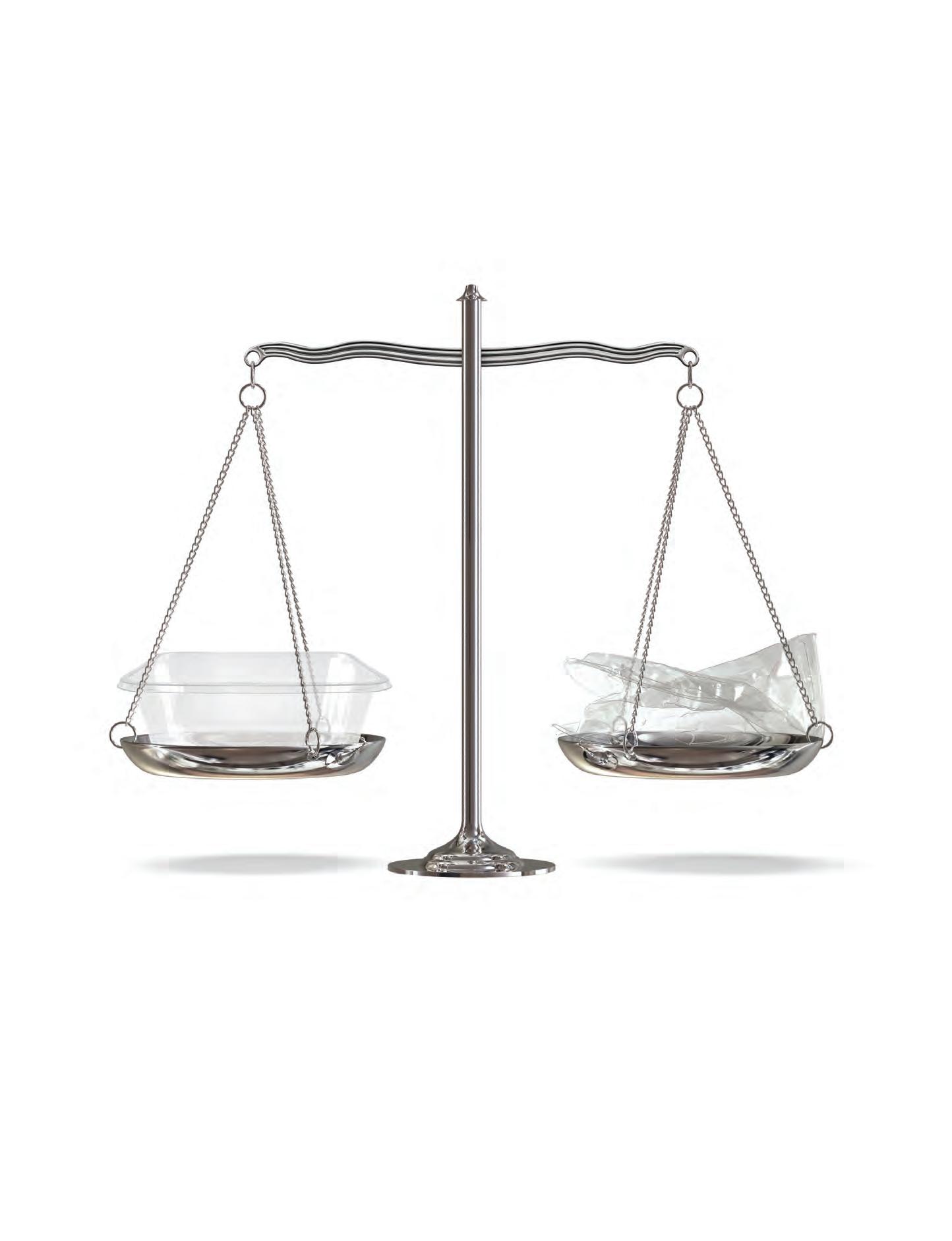

I costruttori italiani di macchine per il confezionamento e l’imballaggio continuano a inanellare successi anno su anno: +9% nel 2024 rispetto al 2023 che a sua volta aveva riportato un +8%. L’export rimane fattore trainante e decisivo per il giro d’affari (+10%), ma sviluppa dinamiche positive anche il mercato interno (+5,2%).
N1. Quadro generale del settore
on si arresta la corsa dei costruttori italiani di macchine per il confezionamento e l’imballaggio che anche nel 2024 raggiungono un nuovo traguardo storico dimostrando grande forza competitiva a livello globale. Ancora una volta è stato l’export a dare l’impulso maggiore alla crescita arrivando a pesare per il 79.4% del fatturato totale, attestandosi a circa 8 miliardi: un balzo del 10%. Una crescita di tutto rispetto è stata conseguita anche sul mercato interno dove il settore ha generato oltre 2 miliardi di euro (+5,2%) con un’incidenza del 20,6% sulle vendite totali. Complessivamente il giro d’affari ha superato i 10 miliardi contro i 9,2 registrati nel 2023 (+9%).
I dati sono stati resi noti dal Centro Studi Mecs -
Ucima nella 13^ Indagine Statistica Nazionale, che ogni anno fotografa l’andamento del comparto composto da 619 aziende e 40.503 addetti cresciuti di 2.300 unità (+6%).
Andamento dell’export nelle diverse aree geografiche
Con 700 milioni di euro in più rispetto al 2023, l’export cresce vistosamente anche nel 2024 generando ben 7,989 miliardi di euro. Resta immutato il podio delle aree geografiche, tutte sostanzialmente in crescita. Con 2,9 miliardi di ricavi (2,7 nel 2023) l’Unione Europea si conferma la principale area di destinazione delle macchine made in Italy e assorbe il 35,8% dell’intero export. Segue l’Asia con 1,6 miliardi di euro
TABELLA e GRAFICO 1.1 - Indicatori fondamentali di settore, 2024
Valori migliaia di euro
pari al 20% del totale delle performance internazionali del settore. Il terzo gradino viene conquistato dal Nord America, con 1,3 miliardi. Seguono Europa Extra-UE (768 milioni di euro), Sud America (730 milioni di euro), Africa e Oceania rispettivamente a 573 e 122 milioni di euro. Le vendite sul mercato italiano sono invece rimaste sostanzialmente stabili (+0,2%) a 1,9 miliardi di euro, un’incidenza del 22,6% sul giro d’affari totale.
I risultati rinnovano la leadership della tecnologia italiana sul panorama globale riuscita a superare l’inasprimento delle incertezze geopolitiche e commerciali. Grazie alla capillarità della rete di subfornitura nazionale, che consente di mantenere la competitività di prezzo e tecnologica, prospettivamente il settore sarà in grado di prosperare non soltanto nelle destinazioni continentali europee, ma anche di competere nei mercati più lontani e in quelli dove saranno presenti restrizioni e barriere commerciali.
I principali Paesi esportatori
Con una quota del 22,4% l’Italia si posiziona al secondo posto, subito dopo la Germania (24,8%), nella classifica dei 10 maggiori Paesi esportatori di macchine per il packaging. Sul terzo gradino troviamo la Cina con l’11,6%, seguita dagli Stati Uniti con il 4,5%, circa a pari merito con i paesi Bassi (4,4%). Francia Spagna, Svizzera, Giappone e Canada seguono con quote minori rispettivamente del 3,5%, 2,7%, 3,1%, 3% e 1,6%.
Il food mantiene la sua leadership
Tra i settori forniti, rimangono al primo posto le vendite di macchinari nel settore food che incidono per il 31% (3.120 milioni di euro contro i 2.856 milioni del 2023) sul fatturato totale, in aumento del 9.2%, seguite dal beverage (incidenza del 25,1%) con 2.523 milioni, in rialzo del 4,5% sull’anno precedente. Seguono il settore tissue, tabacco e altri settori con 1.923 milioni di euro (+12,2%) e il comparto farmaceutico a 1.744 milioni di euro (+16,8%). Il cosmetico scende invece del 4,1% a quota 389,8 milioni di euro, mentre il chimico chiude in condizioni di stabilità a 359,4 milioni di euro (-0,1%).
Fatturato per tipologia produttiva
La famiglia delle macchine per il packaging primario resta preponderante con il 53% della distribuzione del fatturato (+10,1%), seguita dal segmento del fine linea, labelling e attrezzature ausiliarie (27,1% sul giro d’affari) e dal packaging secondario (+6.6% rispetto al 2023) che assorbe il rimanente 19,9%. La categoria che prevale è quella delle macchine Macchine FormatriciRiempitrici - Chiuditrici (FFS) e Termoformatrici che con un valore di 2,24 miliardi (l’80,7% realizzato all’estero) in aumento del 10,2%.
Le aspettative per il 2025
Guardando all’anno in corso, le aziende del settore si mantengono prudentemente ottimiste. Secondo l’indagine del Centro Studi MecsUcima, il 37,5% delle imprese prevede una crescita del proprio fatturato nel 2025, mentre il 45,8% si attende una stabilità dei volumi. A pesare sulle prospettive future sono soprattutto i fattori di instabilità internazionale, l’evoluzione dei costi energetici e le politiche industriali a livel- 13a Indagine Statistica Nazionale - 2024
Attrezzature ausiliarie
Labelling Fine
Packaging
0,000,050,100,150,20
lo europeo. Resta comunque forte la fiducia nella capacità del settore di innovare e consolidare la propria posizione sui mercati globali.
“Grandi risultati, ma incertezze e freni agli investimenti preoccupano” “Abbiamo raggiunto un nuovo, storico traguardo - dichiara Riccardo Cavanna, Presidente di Ucima -. Il superamento dei 10 miliardi di euro dimostra ancora una volta la forza del nostro settore. La nostra rete capillare, anche nei mercati più lontani, e la catena
del valore ci premiano. L’export continua a trainare, grazie a tecnologie affidabili, competitive e flessibili. Ma non possiamo trascurare le criticità che si affacciano all’orizzonte: guerre, dazi, instabilità energetica, incertezza sugli equilibri geopolitici e una mancanza di politiche industriali chiare. Tutti fattori che potrebbero frenare nuovi investimenti e la competitività delle nostre imprese. È fondamentale che si continui a credere nel manifatturiero italiano e che si garantisca un quadro normativo stabile e favorevole alla crescita”.
Italian manufacturers of packaging and wrapping machinery continue to rack up year-on-year successes: +9% in 2024 compared to 2023, which in turn had reported +8%. Exports remain the driving and decisive factor for turnover (+10%), but the situation is also evolving positively on the domestic market (+5.2%).
There is no stopping the rapid progress of Italian packaging and wrapping machine manufacturers, which also reached a new historic milestone in 2024, demonstrating strong competitiveness globally.
Once again, it was exports that were the major driver for growth, coming in at 79.4% of total turnover, accounting for about 8 billion: a jump of 10%. Respectable growth was also achieved on the domestic market, where the sector generated more than €2 billion (+5.2%), accounting for 20.6% of total sales. Overall, turnover exceeded 10 billion, up from 9.2 billion recorded in 2023 (+9%).
The data were released by the Mecs - Ucima Study Centre in the 13th National Statistical Survey, which provides an annual snapshot of the performance of the industry, consisting of 619 companies and 40,503 employees, up 2,300 (+6%).
Export performance in the various geographical areas
With €700 million more than in 2023, exports also recorded significant growth in 2024, generating an impressive €7.989 billion.
The podium of the geographical areas, all of which recorded rises, remains unchanged. With 2.9 billion in revenues (2.7 in 2023), the European Union remains the main destination area for Italian-made machinery, absorbing 35.8% of all
exports. This is followed by Asia, with 1.6 billion, 20% of the industry’s total international performance. In third place is North America, with 1.3 billion. The top three are followed by non-EU Europe (€768 million), South America (€730 million), Africa and Oceania, standing at €573 and 122 million respectively.
Sales on the Italian market, on the other hand, remained largely stable (+0.2%) at €1.9 billion, a 22.6% share of total sales.
These results show that Italian technology maintains its leadership position on the global landscape, and has succeeded in overcoming increasing geopolitical and trade uncertainties. Thanks to the reach of the large domestic subcontracting network, which makes it possible to remain competitive in terms of price and technology, the sector is expected to be able not only to thrive in continental Europe, but also to compete in markets further afield and in those where restrictions and trade barriers will be present.
Major exporting countries
With a 22.4% share, Italy places second, just behind Germany (24.8%), in the ranking of the 10 largest countries exporting packaging machinery. In third place is China, with 11.6%, followed by the United States with 4.5%, just ahead of the Netherlands (4.4%).
France, Spain, Switzerland, Japan and Canada follow, with smaller shares of 3.5%, 2.7%, 3.1%, 3% and 1.6% respectively.
The Food sector maintains its leadership Among the sectors supplied, sales of machinery in the food sector remain in first place, accounting for 31% (€3,120 million, compared to 2,856 million in 2023) of total sales, up 9.2%, followed by beverage (25.1% incidence) with 2,523 million, up 4.5% on the previous year. This is followed by the tissue, tobacco and other sectors with €1,923 million (+12.2%) and pharmaceuticals, standing at €1,744 million (+16.8%).
Cosmetics, on the other hand, dropped 4.1% to 389.8 million, while chemicals closed at a steady 359.4 million (-0.1%).
The primary packaging machinery family remains at the top of the list, with 53% of the turnover (+10.1%), followed by the end-of-line, labelling and ancillary equipment segment (27.1% on turnover) and secondary packaging (+6.6% over 2023), which absorbs the remaining 19.9%. The top category is Forming-Filling-Sealing Machines (FFS) and Thermoforming Machines with a value of 2.24 billion (80.7% made abroad), up 10.2%.
Focussing on the current year, companies in the industry remain cautiously optimistic. According to the survey conducted by the Mecs - Ucima Research Centre, 37.5% of businesses forecast a growth in turnover for 2025, while 45.8% expect sales to remain stable. Factors such as international instability, changing energy costs, and industrial policies across Europe are weighing on future prospects. However, confidence in the industry’s ability to innovate and consolidate its position on global markets remains high.
“The results are positive, but uncertainties and reduced investment momentum are causing concern”
“We have reached a new, historic milestone” - declared Ucima chair Riccardo Cavanna. Breaking the €10 billion record provides further confirmation of the strength of our industry. Our extensive network, which reaches even the most far-off markets, and the value chain are key assets. Exports continue to grow, driven by reliable, competitive and flexible technologies. But we cannot ignore the critical issues that are looming on the horizon, such as wars, customs duties, unstable energy prices, uncertain geopolitical balances, and a lack of clear industrial policies. All these factors could slow down new investments and curb the competitiveness of our companies. It is vital that we continue to put faith in Italian manufacturing and that a stable regulatory framework that fosters growth is guaranteed”.
Barbara Iascone Italian Packaging Institute






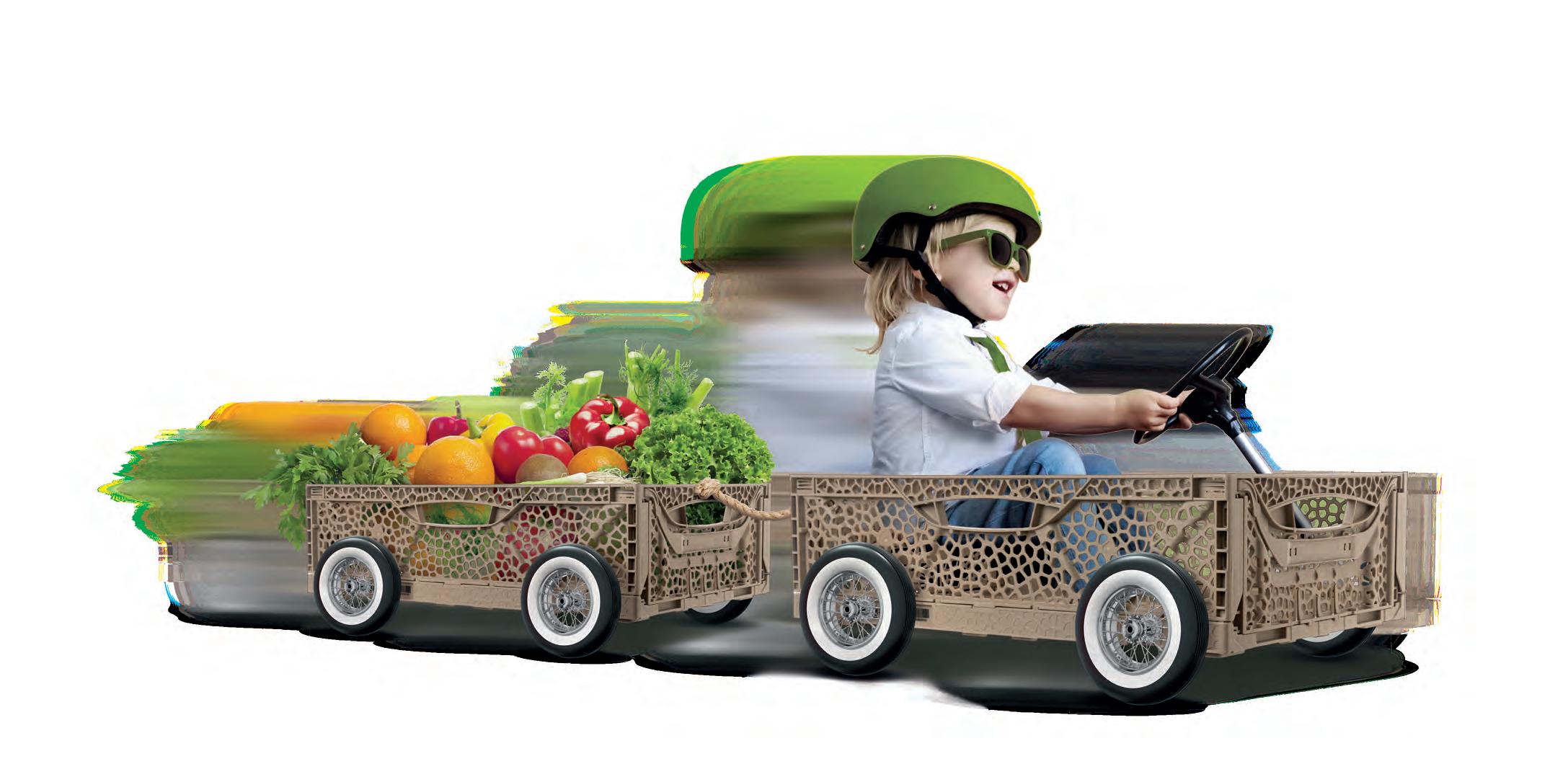

Osservatorio quadrimestrale della filiera imballaggio: situazione aggiornata a giugno 2025. Quadro economico generale, analisi dell’attività manifatturiera e conseguente evoluzione del settore imballaggi.
Barbara Iascone
I dati dell’industria manifatturiera
In questa sede si sintetizza l’andamento dei comparti dell’industria manifatturiera dove più intenso è il consumo di imballaggi, suddivisi nelle macroaree food e non food.
Come ormai ampiamente riconosciuto, il settore del packaging è strettamente connesso all’andamento dell’industria manifatturiera, in particolare per le filiere alimentari, bevande, largo consumo, farmaceutico e cosmetico.
Di seguito un breve panorama dell’andamento dei settori maggiormente correlati al mondo dell’imballaggio.
Il settore Alimenti e bevande conferma un 2024 che chiude in positivo al +1,2%. Da evidenziare un’accelerazione nelle ultime rilevazioni (+1,8% nel trimestre settembre-novembre), sulla scia di una graduale risalita del reddito disponibile delle famiglie, dopo la fase inflativa più acuta.
Il settore alimentare da solo è cresciuto dell’1,8%, trainato dalle esportazioni che hanno raggiunto livelli record (+7,5%), sfiorando i 70 miliardi di euro.
I consumi interni hanno mostrato una ripresa dei volumi, soprattutto per alcuni prodotti, e una crescita della spesa dello 0,9%.
Per quanto riguarda il settore delle bevande, il quadro è complesso: i volumi registrano un +0,5%, che si traducono in un +2,5% in termini di fatturato.
Il settore Cosmetico si conferma in buona salute, con l’associazione confindustriale Cosmetica Italia che prevede una crescita intorno al +10% nel 2024. Questo incremento è trainato da un importante aumento delle esportazioni, che dovrebbero superare il 15% nel 2024, mentre il mercato interno contribuirà positivamente, sebbene in misura minore, con una crescita stimata intorno al +6% rispetto al 2023.
Quadro economico generale: una sintesi
I dati definitivi relativi al 2024 mostrano il PIL italiano in crescita del +0,7% (inferiore rispetto a Francia e Spagna; la Germania, colpita dalla crisi economica, ha registrato una contrazione).
In base alle valutazioni ISTAT, tale rescita è stata determinata principalmente dalla domanda estera, a differenza della domanda interna, che ha avuto un impatto negativo.
L’occupazione chiude con un +1,3% e si assesta al 62,7%, con un incremento di 282.000 unità occupate. Questo aumento, maggiore rispetto alla crescita del PIL, potrebbe suggerire una minore produttività dei nuovi occupati o una sottostima della crescita del PIL stesso.
Confermato anche il calo della produzione industriale, -3,5% rispetto all’anno precedente: uno dei peggiori tra i principali paesi dell’Unione Europea.
L’andamento negativo è stato generalizzato, interessando tutti i settori, ad eccezione di alimentari, bevande e tabacco. I cali più marcati hanno riguardato il tessile e la metallurgia.
L’inflazione nel 2024 si attesta al +1,3%.
A chiusura di anno, i dati elaborati da Prometeia mostrano un calo di fatturato a prezzi costanti pari al -2,5%, mentre il calo della produzione si assesta sul -2,2%. I comparti manifatturieri hanno registrato andamenti differenziati: quelli maggiormente legati ai mercati esteri hanno performato meglio.
Anche il Farmaceutico e il settore del Largo consumo mostrano andamenti positivi: +6,9% per il primo e +4,9% per il secondo.
Nell’area dei prodotti intermedi, solo la metallurgia evidenzia una crescita del fatturato deflazionato (+3,3%), trainata dai metalli non ferrosi. Complessivamente stabile la performance degli “intermedi chimici” e dei “prodotti e materiali da costruzione” che, nelle ultime rilevazioni, hanno anzi registrato un recupero di fatturato, legato a comparti come cemento e calcestruzzo, più direttamente attivati dalle opere pubbliche.
General economic framework: an overview
The final figures for 2024 show a 0.7% rise in Italian GDP (lower than France and Spain; Germany’s GDP contracted as a result of the economic crisis).
According to ISTAT assessments, this increase was mainly driven by foreign demand; domestic demand, in contrast, had a negative impact.
Employment rose by 1.3% to 62.7%, an increase of 282,000 units. This increase is higher than GDP growth; this could suggest lower productivity on the part of the newly employed, or that GDP growth has been underestimated.
Also confirmed was the drop in industrial production, down 3.5% year-on-year: one of the worst among the major EU countries. The negative trend was observed across all sectors except food, beverages and tobacco. The sharpest drops were in textiles and metallurgy.
Inflation in 2024 rose by 1.3%.
At the end of the year, the figures compiled by Prometeia show a 2.5% drop in turnover at constant prices, while production fell by 2.2%. There was a difference in performance across manufacturing sectors, with those most closely linked to foreign markets performing better.
Le prime analisi relative all’anno 2024 (al momento dell’analisi i dati sono ancora preconsuntivi, Ndr.) mostrano un settore in ripresa.
La produzione di imballaggi espressa in tonnellate dovrebbe chiudere con una crescita dell’1,9%, portando la produzione a superare i 17,4 miliardi di tonnellate.
I dati indicano una ripresa sia del mercato interno che del mercato estero: le esportazioni crescono dell’1,7%, arrivando a raggiungere le 2.700 tonnellate circa , mentre le importazioni continuano a crescere a un ritmo più frizzante (+ 6,7%) e superando le 2.900 tonnellate.
Il saldo commerciale rimane negativo e continua a crescere a favore delle importazioni.
Nel 2024, le tonnellate di imballaggi importati superano di 266.000 tonnellate quelle esportate, raddoppiando rispetto all’anno precedente. A livello europeo, paesi come la Polonia, la Turchia e anche la Slovenia continuano a evolversi in modo costante nella produzione di imballaggi.
I materiali da imballaggio
Entrando nel dettaglio dei materiali, si evince che la crescita della produzione è stata sostenuta dall’andamento di ogni tipologia di imballaggio.
La performance cumulata è invece negativa per i “prodotti in metallo”, che chiudono con un -3,3%, e gli “Altri intermedi” (-1,7%), in ulteriore peggioramento in coda d’anno.
Gli andamenti più negativi si registrano nel settore moda (-8,5%), elettronica (-7,3%). Poco brillanti anche i prodotti durevoli per la casa, mobili e soprattutto elettrodomestici, dove le dinamiche di rallentamento della domanda si intrecciano con situazioni di crisi ormai strutturali.
Gli imballaggi in carta e cartone registrano una crescita della produzione pari al +2,1%; il cartone ondulato da solo è al +2,2%.
La produzione di imballaggi flessibili da converter rivela una tendenza positiva del +3%; risultano in crescita anche gli imballaggi di plastica (+2,5%).
Trend positivo anche per gli imballaggi metallici: l’alluminio registra un +4,8% nella produzione espressa in tonnellate (l’andamento è guidato in particolar modo dal settore cosmetico).
Nell’ambito dei metalli, anche gli imballaggi in acciaio dovrebbero chiudere il 2024 con un segno positivo, +1,4%, guidato dall’andamento positivo del settore alimentare confezionato (ovvero conserve sia vegetali che animali).
Gli imballaggi in legno crescono del +5% rispetto al 2023, con i pallet che da soli rappresentano il 76% del comparto e crescono del 4%.
Bilancio del settore packaging in Italia. Stime 2024. Fatturato in milioni di euro. Balance of the packaging sector in Italy. 2024 estimate. Turnover in milion euros.
Addetti numero (stima)
(estimate) Aziende numero (stima)
(1) I dati potrebbero essere oggetto di rettifiche / Data could be subject to corrections Fonte/Source: Elaborazione dati Imballaggio in cifre ed. 2024
Four-monthly observatory of the packaging chain: situation at June 2025. General economic framework, analysis of manufacturing activity and consequent evolution of the packaging sector. .
Barbara Iascone
Here we summarise the trends in the manufacturing industry sectors where packaging consumption is most intense, divided into food and non-food macro-areas.
As is now widely recognised, the packaging sector is closely linked to the performance of the manufacturing industry, in particular in the food, beverage, FMCG, pharmaceutical and cosmetics sectors.
Below is a brief overview of the trends in the sectors most closely related to the world of packaging.
The Food and Beverage sector confirmed a positive result for 2024, closing at +1.2%. An acceleration in the latest data collected (+1.8% in the SeptemberNovember quarter) should be noted, in the wake of a gradual rise in the disposable income of households, following the most acute inflationary phase.
The food sector alone grew by 1.8%, driven by exports, which reached record levels (+7.5%), close to €70 billion.
Domestic consumption showed a recovery in volumes, especially for some products, and a 0.9% rise in spending.
For the beverage sector, the situation is complex: volumes registered a rise of 0.5%, corresponding to +2.5% in terms of turnover.
The Cosmetics sector remains vigorous, with the Confindustria association Cosmetica Italia forecasting growth of around 10% in 2024. This increase is driven by a major rise in exports, which are expected to exceed 15% in 2024, while the domestic market will also make a positive, albeit smaller, contribution, with an estimated growth rate of 6% compared to 2023.
The Pharmaceutical and FMCG sectors also showed positive trends: +6.9% for the former and +4.9% for the latter.
With regard to intermediate products, only metallurgy showed deflated turnover growth (+3.3%), driven by non-ferrous metals. Overall, the performance of ‘chemical intermediates’ and ‘construction products and materials’ remained stable, and in the latest surveys, actually recorded a recovery in turnover, linked to sectors such as cement and concrete, which are more directly activated by public works.
On the other hand, cumulative performance was negative for ‘Metal products’, which closed with a drop of 3.3%, and ‘Other intermediates’ (-1.7%), which deteriorated further at the end of the year.
The most negative trends were recorded in the fashion (-8.5%) and electronics (-7.3%) sectors. Performance was also lacklustre for
durable household products, furniture and above all household appliances, where the dynamics of slowing demand are intertwined with crisis situations that have become structural.
The packaging sector
Initial analyses for the year 2024 (at the time of the analysis, the data are still preliminary, editor’s note) point to a recovering sector.
Packaging production, expressed in tonnes, is expected to close with a rise of 1.9%, bringing production to over 17.4 billion tonnes.
The figures indicate a recovery in both the domestic and foreign markets: exports are up 1.7%, reaching around 2,700 tonnes, while imports continue to grow at a brisker pace (+ 6.7%) and exceed 2,900 tonnes.
The trade balance remains negative and continues to grow in favour of imports.
In 2024, imported packaging exceeded exported packaging by 266,000 tonnes, doubling compared to the previous year. At European level, countries such as Poland, Turkey and also Slovenia continue to evolve steadily in packaging production.
Packaging materials
If we look in detail at materials, we can see that the increase in production was supported by the performance of all types of packaging.
Paper and cardboard packaging recorded an increase in production of 2.1%; corrugated cardboard alone rose by 2.2%.
The production of flexible packaging by converters shows a positive trend of +3%; plastic packaging is also growing (+2.5%).
The trend was also positive for metal packaging: aluminium recorded a 4.8% increase in production in tonnes, with the trend driven by the cosmetics sector in particular. Regarding metals, steel packaging is also expected to close 2024 up 1.4%, driven by the positive trend in the packaged food sector (i.e. canned products of both vegetable and animal origin).
Wood packaging was up 5% compared to 2023, with pallets alone accounting for 76% of the sector and rising by 4%.
Glass, on the other hand, is expected to confirm the negative trend recorded in 2023. Also for 2024, the performance of the most widely used sectors will affect not only production, with exports closing the year with a drop of 7%, compared to a 3% rise in imports.
The negative trend in the alcoholic beverage sector, with its high use of glass for packaging, inevitably affected the trend.
The overall turnover of the packaging sector is expected to remain substantially stable in 2024: the preliminary figures show a 0.2% increase to just over €35.8 billion.
The definitive calculations for the 2024 final balance are being prepared and will be confirmed in the coming months with the release of Packaging in Figures.
Il vetro dovrebbe invece confermare una tendenza negativa già registrata nel 2023. Anche per il 2024, l’andamento dei settori di maggior utilizzo andrà a influire sulla produzione, ma non solo; le esportazioni chiudono con un -7% a fronte di un +3% delle importazioni. Da sottolineare l’andamento negativo del settore bevande alcoliche, ad alto utilizzo di vetro per quanto riguarda il confezionamento, che inevitabilmente influisce sul trend.
Il fatturato complessivo del settore imballaggi
dovrebbe rimanere sostanzialmente stabile nel 2024: i dati a preconsuntivo ci mostrano infatti un +0,2%, arrivando a superare di poco i 35,8 miliardi di euro.
Le elaborazioni definitive per il consuntivo 2024 sono in fase di elaborazione e saranno confermate nei prossimi mesi con l’uscita di Imballaggio in cifre.
Barbara Iascone
Istituto Italiano Imballaggio
Asset indispensabili del confezionamento fin dal 1800, nel tempo gli imballaggi metallici si sono re-inventati, ampliando funzionalità e destinazioni d’uso. Dimensioni e caratteristiche del mercato italiano (dati di consuntivo 2024), con la suddivisione per tipologie.
Barbara Iascone

Gli imballaggi metallici sono contenitori realizzati principalmente in acciaio o alluminio.
Apprezzati per la loro robustezza, resistenza e capacità di protezione, oggi sono usati per confezionare un’ampia gamma di prodotti: alimenti, bevande, cosmetici, chimici, farmaci e vernici.
Tra i primi imballaggi utilizzati nella storia, quelli in acciaio compaiono nel 1810: l’imprenditore inglese Peter Durand ottiene infatti il primo brevetto per una “conserva in lattina di ferro stagnato” (acciaio ricoperto di stagno), ispirato alle ricerche francesi sulla conservazione e al trasporto degli alimenti, migliorando significativamente l’approvvigionamento in ambito militare e navale.
Nel 1886 nasce invece il processo che rende possibile la produzione industriale dell’alluminio da bauxite con un notevole abbattimento
dei costi, dando inizio all’era dell’alluminio moderno. Da qui la realizzazione dei contenitori, sul mercato tra il 1910 e 1920, per il confezionamento dei prodotti cosmetici e farmaceutici. In questa analisi prenderemo in esame i dati relativi al preconsuntivo 2024 in attesa dell’uscita della pubblicazione di Imballaggio in cifre ed. 2025 che mostrerà i dati consuntivi.
Imballaggi metallici: la situazione in Italia
Nel 2024, gli imballaggi in acciaio hanno pesato per il 70,4% sulla produzione nazionale di imballaggi in metallo (espresso in tonnellate), e per il 33% sul fatturato (espresso in euro). La rappresentatività degli imballaggi in alluminio è stata, rispettivamente su produzione e fatturato, del 20,6% e del 67% (Tabelle 1 e 2).
La disparità tra i dati espressi può essere attribuita al fatto che, a fronte di una maggiore dif-
Tabella 1. Il mercato degli imballaggi metallici in Italia (valori in t/000 e mln euro), anno 2024.
Table 1. The metal packaging market in Italy (values in t/000 and mln euros).
Fatturato mln €
apparente 578,3
Fonte/Source: Elaborazioni dati Imballaggio in cifre.
549,9 2,9% Apparent use
Tabella 2. La suddivisione tra imballaggi di acciaio e alluminio (valori %), anno 2024.
Table 2. Breakdown of steel and aluminium packaging (% values), 2024.
Acciaio/Steel Alluminio/Aluminium
Fatturato 33,0% 67,0% Turnover
Produzione 79,4% 20,6% Production
Fonte/Source: Elaborazioni dati Imballaggio in cifre.

fusione dell’acciaio soprattutto in ambito alimentare, il costo più elevato dell’alluminio riesce a generare fatturati più consistenti. Il settore nella sua globalità chiude il 2024 con un parziale recupero delle perdite registrate nei due anni precedenti, andando a registrare un fatturato in crescita del 4% e una produzione tendenzialmente al +2%, con circa 794.200 tonnellate di imballaggi metallici. Come vedremo nel dettaglio, a influire sulla variazione sono stati da una parte il settore alimentare e dall’altra quello cosmetico.
Anche il commercio estero mostra tendenze positive: +18,3% per l’import e +4,8% per l’export. Sono state importate circa 95.000 tonnellate, con un trend in continua crescita e in linea con l’andamento generale del settore packaging, mentre le esportazioni si assestano sulle 339.300 tonnellate (i valori del commercio estero sono desunti da dati ISTAT a 12 mesi).
Gli imballaggi di acciaio: tipologie e mercato
Secondo la classificazione utilizzata in “Imballaggio in Cifre”, gli imballaggi in acciaio si suddividono in due macro categorie: imballaggi leggeri in banda stagnata e fusti in lamiera sottile.
Banda stagnata. La categoria prevede tre tipologie di confezionamento: open top, general line, chiusure.
Gli imballaggi open top sono utilizzati confezionare prodotti alimentari come pomodori pelati, conserve vegetali, prodotti ittici...
Gli imballaggi general line sono impiegati per i prodotti chimici come pitture e vernici, solventi etc, o per confezionare olio alimentare nelle cosiddette latte. Troviamo anche le bombolette aerosol, utilizzate in ambito food e non food. Infine, le chiusure sono rappresentante dai tappi corona e dalle capsule twist-off.
Fusti. Sono realizzati con lamierino di acciaio senza rivestimento di stagno, ma protetto da un’adeguata verniciatura sia interna che esterna. Hanno capacità variabile tra 50 litri e 300 litri, con netta prevalenza di quelli con capacità 200 litri. Con forme cilindriche o tronco-coniche, i fusti possono essere utilizzati in ambito alimentare (per la movimentazione dei pomodori dalla raccolta alla lavorazione o per il confezionamento dell’olio per uso industriale) o non alimentare (come per il petrolio e carburanti). (Tabella 3)
Il mercato in Italia. Nel 2024 le tonnellate di imballaggi prodotte in Italia dovrebbero essersi assestate intorno alle 630.900, con una crescita prevista dell’1,4%.
Positivo anche l’andamento del commercio estero dove le importazioni, seppur sempre
Il riciclo degli imballaggi metallici
Il “fine vita” degli imballaggi viene affidato essenzialmente al riciclo e, grazie al lavoro incessante dei consorzi di filiera del Sistema Conai, la percentuale di imballaggi avviati al riciclo cresce di anno in anno.
Per quanto riguarda gli imballaggi in acciaio, a occuparsi di questa fase è il consorzio RICREA; in base agli ultimi dati resi noti, nel 2024 ammontano a 487.548 t/000 gli imballaggi avviati a riciclo, vale a dire l’87,8% dell’immesso al consumo, con risultati che superano gli obiettivi di legge stabiliti al 2030.
Il consorzio che si occupa del riciclo e recupero degli imballaggi in alluminio è il CIAL, e in base alle loro ultime elaborazioni, nel 2024 la percentuale di imballaggi in alluminio avviati al riciclo è del 68,2% che, tradotta in peso, significa 62.400 t. Anche in questo caso sono già stati superati gli obiettivi stabiliti al 2030.
Recycling of metal packaging
The end-of-life of packaging is primarily managed through recycling. Thanks to the ongoing efforts of the CONAI supply chain consortia, the percentage of packaging sent for recycling continues to grow year by year.
In the case of steel packaging, the RICREA consortium is responsible for overseeing this phase. According to the latest data, 487,548 tonnes of packaging will be recycled in 2024, representing 87.8% of the steel packaging placed on the market, which exceeds the legal targets set for 2030.
The recycling and recovery of aluminium packaging are handled by CIAL. Their most recent figures indicate that, in 2024, 68.2% of aluminium packaging was recycled, which amounts to 62,400 tonnes in weight. This, too, exceeds the targets set for 2030.
Tabella 3. Imballaggi leggeri (banda stagnata): ripartizione dell’utilizzo apparente per settori.
Table 3. Lightweight tinplate packaging: breakdown of apparent use by sector.
2023 2024
Open Top 64,7% 62,0% Open top
Olio alimentare 4,2% 4,2% Edible oil
General line* 9,5% 12,7% General line*
Bombolette 10,1% 10,0% Spray cans
Chiusure 11,6% 11,1% Closures
* Prodotti chimici e scatole fantasia/Chemical products and fancy boxes
Fonte/Source: Banca dati Istituto Italiano Imballaggio
molto basse, crescono del 19% (73.300 t), e l’export sale del +2,3% (275.300 t).
• Gli imballaggi leggeri in banda stagnata - ovvero open top, chiusure e parte degli imballaggi general line (quelli di dimensioni più piccole) - influenzano in modo consistente l’andamento di tutto il comparto, in quanto da soli ne rap-
Tabella 4. Contenitori in alluminio: ripartizione dell'utilizzo apparente per settori.
Table 4. Aluminium containers: breakdown of apparent use by sector.
Bevande Food Cosmesi-Farma
Altro Fonte/Source:
presentano oltre l’85%.
Nel 2024 la produzione cresce del 3% arrivando a 538 t/000. Le esportazioni, che costituiscono più dell’84% dell’export globale di imballaggi in acciaio, si stabilizzano a 242.200 tonnellate (+1,8%). Le importazioni chiudono con un +23% (66.600 t), ma rimangono esigue rispetto al consumo apparente,
Gli imballaggi leggeri in banda stagnata si suddividono per il 62% in open top che, pur perdendo qualche punto percentuale rispetto al 2023, confermano l’influenza del settore alimentare sul comparto. Il general line nella sua totalità rappresenta il 26,9%, in crescita, e le chiusure stanno all’11,1%.
• L’area dei fusti in acciaio nel 2024 ha espresso una produzione pari a 93.000 tonnellate, -8% rispetto al 2023. In calo le importazioni (-11%) ma si registra una crescita pari al +6% per quanto riguarda le esportazioni.
I fusti in acciaio sono utilizzati per il 72% circa nel settore chimico petrolifero e per il restante 28% vengono impiegati nella movimentazione di sementi, pomodori, o per il trasporto di prodotti destinati all’industria.
Gli imballaggi di alluminio: tipologie e mercato
Si tratta di contenitori vari per food e non-food. Tra i più diffusi troviamo lattine per bevande, scatolette per conserve alimentari, vaschette, tubetti.
Bombolette aerosol e flaconi sono impiegati principalmente nel settore cosmetico. Rientrano nella categoria “imballaggi di alluminio” anche il foglio sottile e le chiusure (capsule a vite ed easy open). (Tabella 4)

alluminio, escluso il foglio utilizzato per l’accoppiamento nei flessibili da converter, ha raggiunto le 163.300 t (+4,8% rispetto all’anno precedente).
Tutti positivi gli andamenti delle differenti tipologie di imballaggi.
Per quanto riguarda il commercio estero sia le esportazioni che le importazioni (+15%) risultano in crescita e hanno sostenuto la produzione: in particolare l’export al +17% sul 2023 ha ovviato al calo del 5% registrato sul mercato.
In relazione alla produzione di imballaggi di alluminio vuoti, nel 2024 il 30,6% è rappresentato dai contenitori, cui segue con il 23% la voce “altro” (foglio sottile per chiusura yogurt, tubetti, capsule, rivestimento chiusure vino). Le vaschette per alimenti rappresentano il 17,3% della produzione, in crescita rispetto all’anno precedente soprattutto grazie allo sviluppo del take away e del convenience food. Le chiusure registrano una share di mercato del 16,1%, a seguire la voce foglio sottile con il 13%.
In base alle elaborazioni derivanti dalla Banca






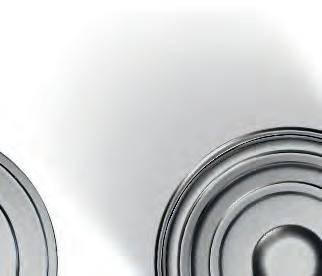
Il mercato in Italia. L’alluminio utilizzato per la produzione degli imballaggi comprende il can








Dati dell’Istituto Italiano Imballaggio, dove vengono analizzati gli andamenti dei mix del packaging di un centinaio di comparti utilizzatori di packaging, i contenitori in alluminio sono stati caratterizzati dalla seguente segmentazione: 63,3% lattine per bevande; 18,1% contenitori per uso farmaceutico e cosmetico; 17,8% scatolette per conserve alimentari; 0,8% voce “altro”.
Barbara Iascone
Istituto
Italiano Imballaggio

A staple of the packaging world since the 19th century, metal packaging has continuously re-invented itself, expanding its applications and enhancing its functionality. Size and characteristics of the Italian market as of 2024 (final data), broken down by packaging type.
Metal packaging refers to containers made mainly of steel or aluminium. Valued for their strength durability and protective properties, these materials are used to package a wide range of products, including food and beverages, cosmetics, chemicals, pharmaceuticals and paints.
Steel was one of the first packaging materials to be used in history, making its debut in 1810 when English entrepreneur Peter Durand was granted the first patent for a “tin-plated iron can” (tin-coated steel). Drawing inspiration from French research into food preservation and transport, his innovation significantly improved the supply systems for the military and navy.
In 1886, however, the development of a new process made it possible to produce aluminium from bauxite on an industrial scale at significantly lower costs, ushering in the era of modern aluminium. This led to the widespread production of aluminium containers, which entered the market between 1910 and 1920, primarily for cosmetic and pharmaceutical packaging.
This analysis presents the preliminary figures for 2024, ahead of the publication of the 2025 edition of Packaging in Figures, which will include the final figures.
Metal packaging: the situation in Italy
In 2024, steel packaging accounted for 70.4% of domestic metal packaging production (expressed in tonnes), and 33% of total industry turnover (expressed in euros). Aluminium packaging represented 20.6% of production and generated 67% of total turnover (Tables 1 and 2). This disparity can be attributed to the fact that, while steel is more widely used, especially in the food industry, the higher cost of aluminium contributes to significantly higher revenues.
Overall, the sector closed 2024 with a partial recovery of the losses
recorded in the previous two years, recording a 4% increase in turnover and a 2% increase in production, with approximately 794,200 tonnes of metal packaging produced. As we will see in more detail, the changes were primarily driven by two key sectors: food and cosmetics.
Foreign trade also showed positive trends, with imports up by 18.3% and exports increasing by 4.8%.
Approximately 95,000 tonnes of metal packaging were imported, reflecting a consistent upward trend in line with the broader packaging sector, while exports reached 339,300 tonnes (foreign trade values are based on 12-month ISTAT data).
Steel packaging: types and market According to the classification adopted in Packaging in Figures, steel packaging is categorised into two main groups: lightweight tinplate containers and thin sheet metal drums.
Tinplate. This category includes three types of packaging: open top, general line, and closures. Open-top packaging is used for food products such as peeled tomatoes, vegetable preserves, tuna, and similar products.
General line packaging is intended for chemical products such as paints, varnishes, and solvents, as well as for edible oils, typically packaged in metal tins. This category also includes canisters used in both the food and non-food sectors. Lastly, closures include crown caps and twist-off caps.
Drums. These are made of uncoated sheet steel, protected instead by suitable internal and external coatings. Drums typically range in capacity from 50 to 300 litres, with 200-litre drums being by far the most common. Available in both cylindrical and truncated cone shapes, they are used for a variety of applications. In the food sector, they are used for transporting tomatoes
from harvest to processing, or for packaging oil intended for industrial use. In the non-food sector, they are used for oil, fuel and other similar products (Table 3).
The market in Italy. In 2024, packaging production in Italy is expected to reach approximately 630,900 tonnes, marking a 1.4% increase over the previous year. Foreign trade also showed a positive trend: imports, though still relatively low, rose by 19% (73,300 tonnes), while exports rose by 2.3% (275,300 tonnes).
• Light tinplate packaging - which includes open-top containers, closures and part of the general line packaging (particularly smaller formats) - continues to dominate the sector, accounting for more than 85% of total production.
In 2024, production grew by 3%, reaching 538,000 tonnes. Exports, which account for more than 84% of global steel packaging exports, remained stable at 242,200 tonnes, an increase of 1.8%. Imports rose by 23% (66,600 tonnes), but still remain limited in comparison to apparent consumption.
Within the lightweight tinplate segment, open-top containers make up 62%. Although this figure reflects a slight decline from 2023, it underscores the influence of the food sector on the segment. General line packaging accounts for 26.9%, showing upward movement, and closures stand at 11.1%.
- Steel drum production in 2024 amounted to 93,000 tonnes, an 8% decrease compared to 2023. Imports fell by 11%, whereas exports increased by 6%.
About 72% of steel drums are used in the petrochemical sector, with the remaining 28% are used in transporting seeds, tomatoes, and other industrial goods.
Aluminium packaging: types and market
Aluminium packaging includes a
wide range of containers used for both food and non-food applications. Among the most common are beverage cans, tins for canned food, and tubs.
Aerosol cans and bottles are mainly used in the cosmetics industry. The category also includes thin foil and closures, such as screw caps and easy-open lids (Table 4).
The market in Italy. Aluminium used in packaging production includes various formats such as can stock for beverage cans, foil stock for thin sheets and capsules, can body stock for food containers, and slugs used to produce aerosol cans. The alloys used for these applications are numerous and vary depending on the production types and end uses.
In 2024, Italian production of aluminium packaging, excluding foil used for lamination by flexible packaging converters, reached 163,300 tonnes (a 4.8% increase over the previous year).
All packaging categories recorded positive growth.
As for foreign trade, both exports and imports (+15%) are growing and have supported production. In particular, exports increased by 17% compared to 2023, helping offset a 5% decrease in the market
Looking specifically at the production of empty aluminium packaging in 2024, containers accounted for 30.6%. This was followed by the “other” category at 23%, which includes thin foil for yoghurt lids, tubes, capsules, and wine closures. Food trays accounted for 17.3% of production, up from the previous year, mainly attributable to the growing demand for take-away and convenience foods. Closures made up 16.1% of the market share, while thin foil accounted for 13%.
According to data compiled by the Italian Packaging Institute, which analysed packaging mix trends across one hundred or so user industries, aluminium containers were segmented as follows: beverage cans accounted for 63.3%, followed by pharmaceutical and cosmetic containers at 18.1%, tins for preserved food at 17.8% and “other” at 0.8%.
Barbara Iascone Italian Packaging Institute


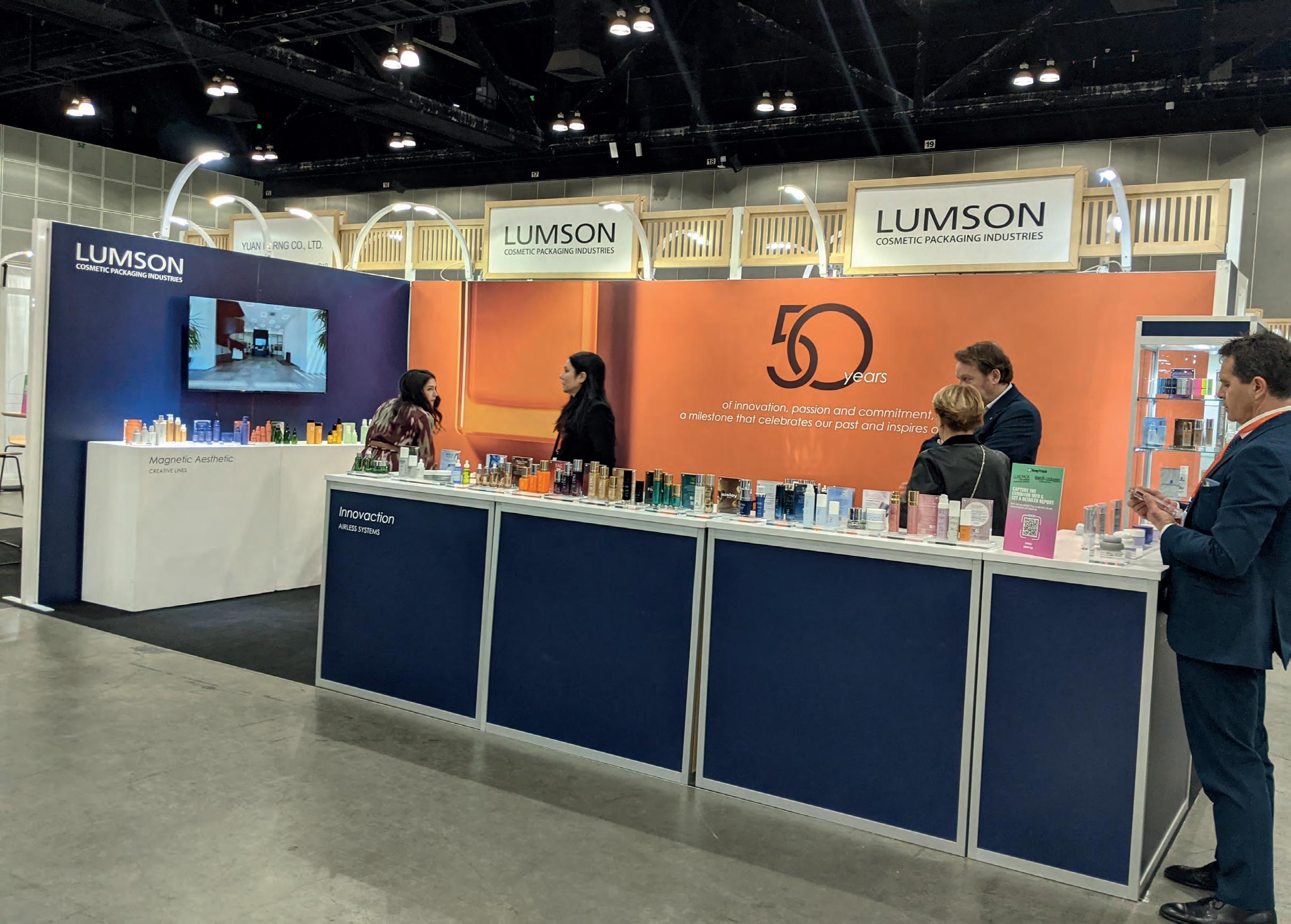
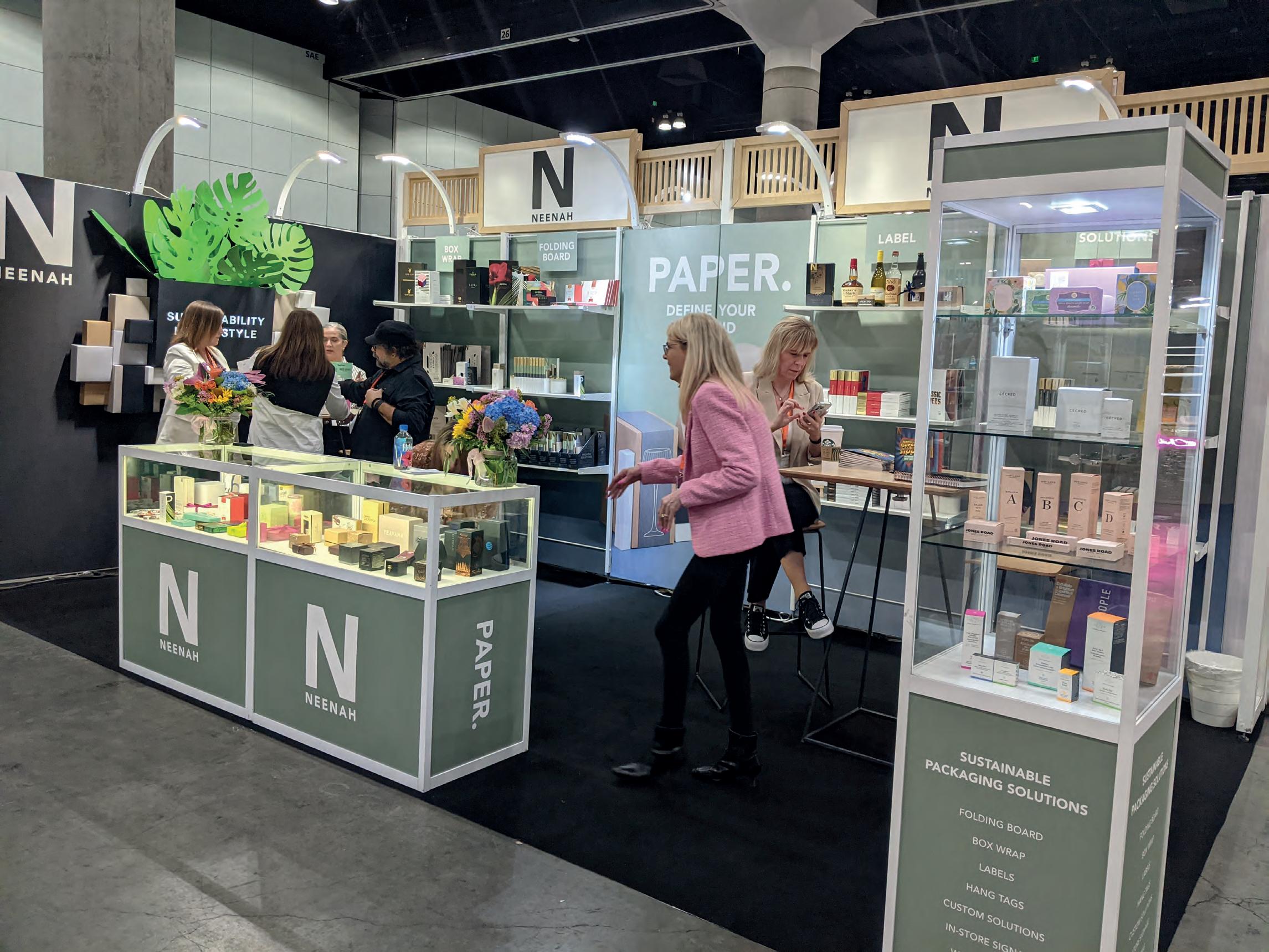
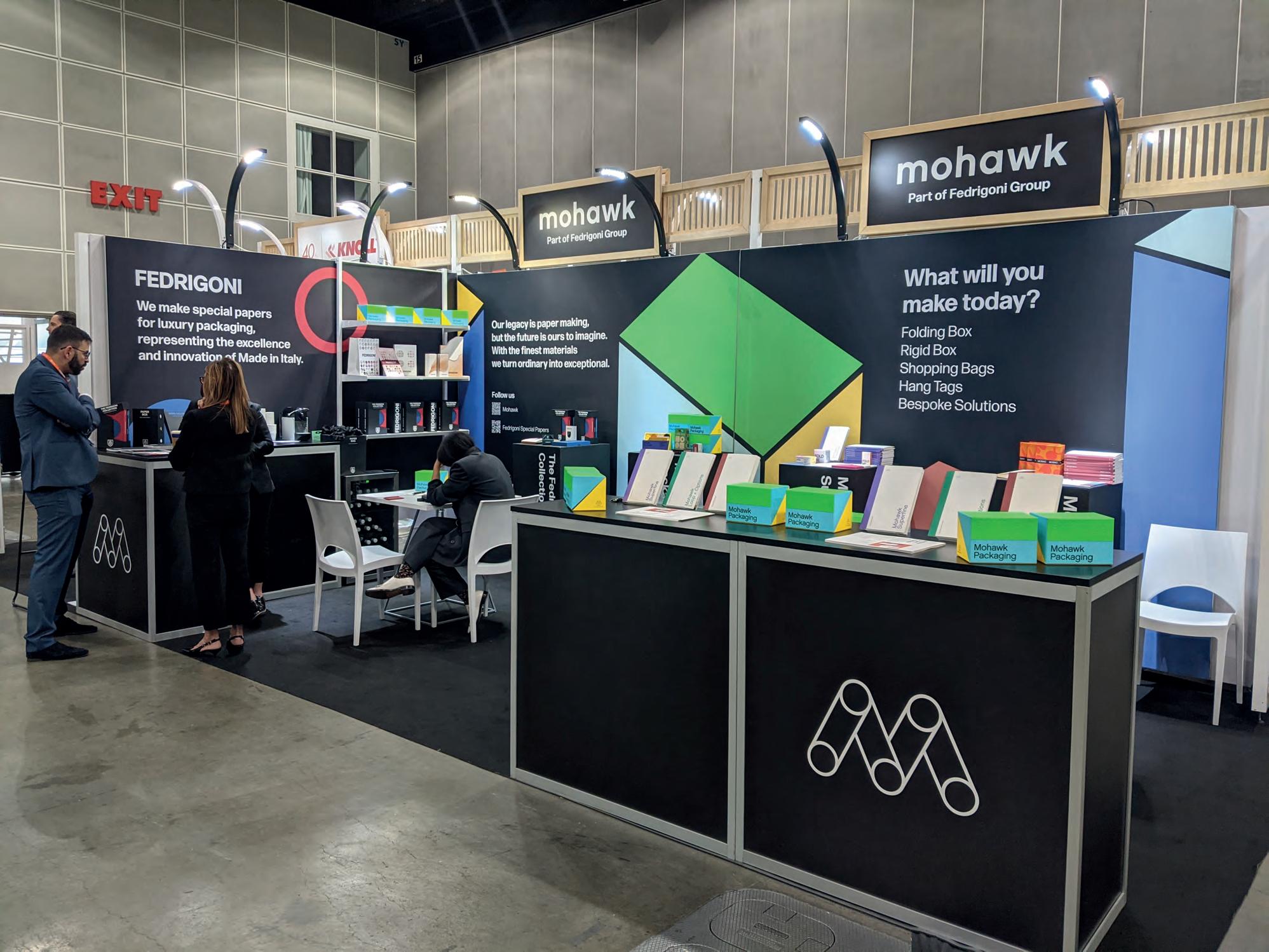

Soluzioni espositive chiavi in mano. Strutture su misura. Servizio completo, dall’idea alla realizzazione.
Stai organizzando il tuo prossimo evento negli Stati Uniti? Costruiamolo insieme. Contattaci per un preventivo.
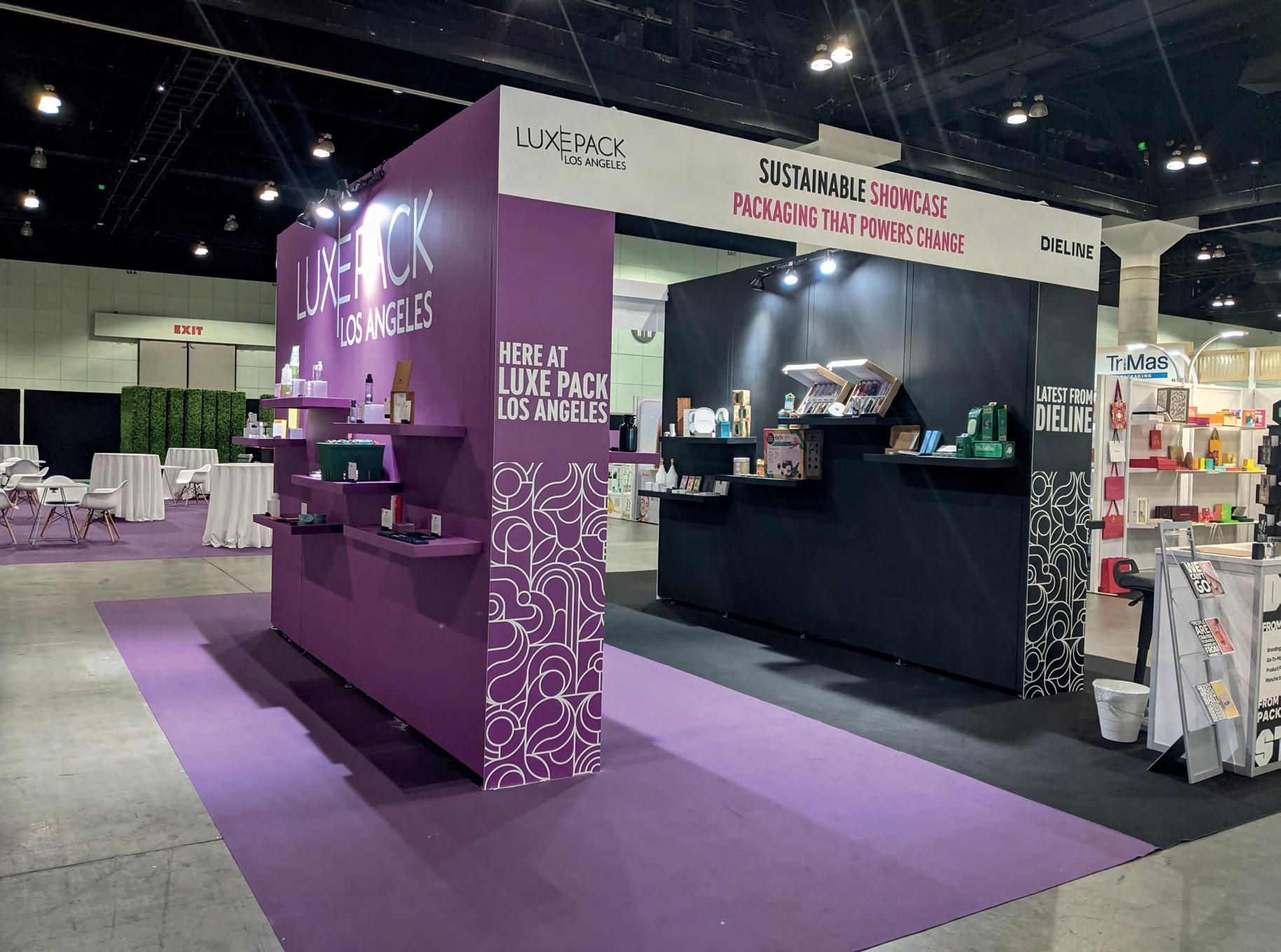



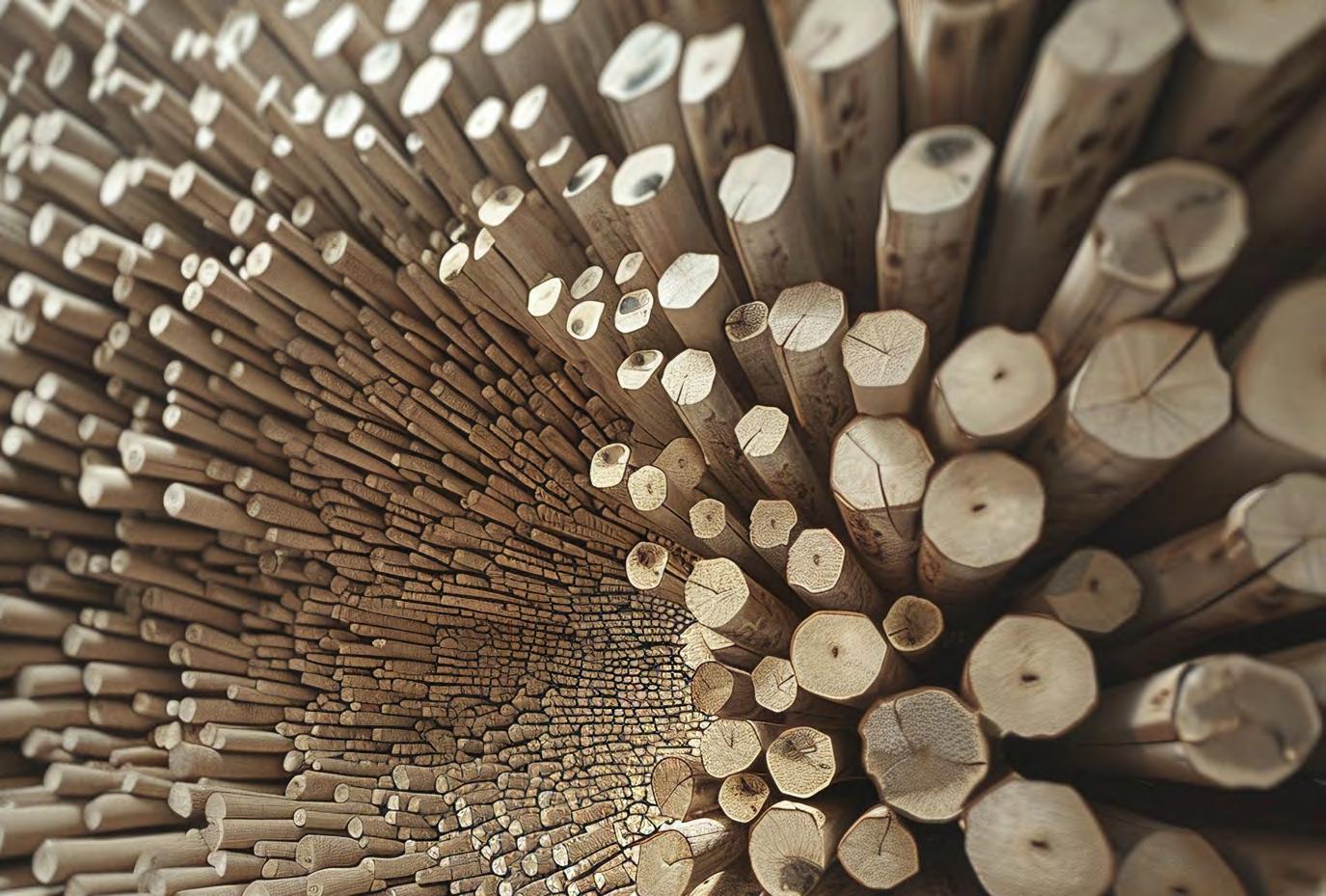
2022 2023 Prec. 2024
1.605 1.284 1.285 Turnover Mln Euros - - 10.200 Employees
- - 2.057 Number of companies
3.005 2.912 3.056 Production (t/000)
231 194 205 Export
657 619 635 Import
3.431 3.337 3.487 Apparent use
Fonte/Source:imballaggio in cifre Istituto Italiano imballaggio
doli particolarmente sensibili, anche più di altre tipologie di packaging, all’andamento dell’industria manifatturiera nel suo insieme.
A seguire le cassette per l’ortofrutta con una rappresentatività del 4,5% e infine i tappi di suOrmai di largo interesse, dato il regolamento europeo di cui si parla tanto, il concetto di imballaggio riutilizzabile, in cui gli imballaggi di legno risultano essere di grande attualità come interpreti del concetto di imballaggio riutilizzabile: secondo i valori elaborati nella Banca Dati dell’Istituto Italiano Imballaggio, l’84% dei pack riutilizzabili in Italia è rappresentato da imballaggi da trasporto; di questi il 65% è realizzato
Cifre, trend e settori di utilizzo
(Fonte: elaborazioni Istituto Italiano Imballaggio
I dati riportati in questo articolo partano dall’analisi del consuntivo 2023 e proseguono con le valutazioni relative al preconsuntivo 2024, ancora in fase di analisi al momento delle presen-
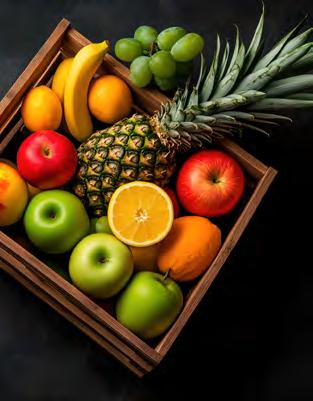
mondo del trasporto e della logistica, renden
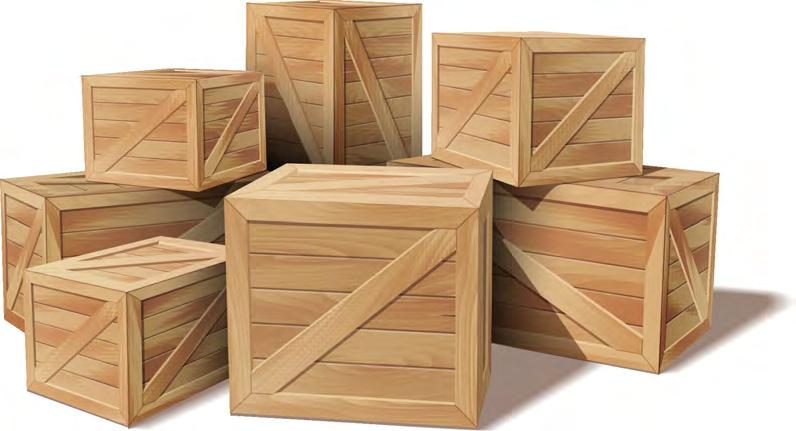
Dopo un 2023 in evidente contrazione - produzione in calo del 3%, import ed export con andamenti negativi rispettivamente del 5,8% e del 16,1% - nel 2024 si dovrebbe assistere a una ripresa del comparto.
Le prime valutazioni riguardanti l’anno 2024 ci mostrano una settore decisamente in ripresa, non tanto per il fatturato che cresce appena dello 0,1%, quanto per i dati espressi in tonnellate.
La produzione dovrebbe infatti chiudere al +5%, con un totale di circa 3.056 t/000. In crescita sia le esportazioni che le importazioni, rispettivamente del +5,4% e del 2,7%. In generale il commercio estero non raggiunge quantitativi elevati rispetto alla produzione e al consumo: le esportazioni rappresentano il 6,7% della produzione, le importazioni il 18,2% del consumo. A influenzare l’andamento della produzione sono sempre i pallet che, da soli, ne rappresentano il 75,8%, e crescono del 4%; ma indubbiamente, nel 2024, anche gli imballaggi industriali hanno influito positivamente sul totale, posizionandosi +12,5%.
Per quanto concerne le quotazioni delle materie prime, dopo il calo registrato nel 2023, nel 2024 i prezzi sono risultatati alquanto stabili: solo una discesa nei mesi estivi, recuperata poi nell’ultimo trimestre dell’anno.
Pallet. In base all’analisi della Banca Dati dell’Istituto Italiano Imballaggio i pallet risultano destinati per il 46,9% al settore alimentare in generale, suddiviso tra bevande e liquidi alimentari (23,3%) e food (23,6%).
Il 24,9% è destinato all’area dei prodotti di largo consumo non alimentare (cosmetico, farmaceutico, detergenza domestica, ecc.), mentre il restante 28,3% serve l’area non-food in generale, di cui il 2,2% al settore chimico.
Imballaggi industriali. Si tratta di casse, perlopiù realizzate su misura, grandi bobine per cavi elettrici, casse per vini, scatole di grandi dimensioni, ecc. Nel 2024 la produzione di imballaggi industriali in legno si assesta intorno alle 528.000 t.
Cassette. Utilizzate nei comparti ortofrutta, ittico e vivaistico, le cassette di legno registrano ormai da diversi anni un lento ma costante calo, sostituite da cassette realizzate con altri materiali: sempre maggiore è l’impiego del cartone ondulato per l’ortofrutta, mentre il settore ittico si sta orientando sull’uso quasi esclusivo di cassette di plastica e polistirolo. Nel 2024 l’andamento segna un -8%.
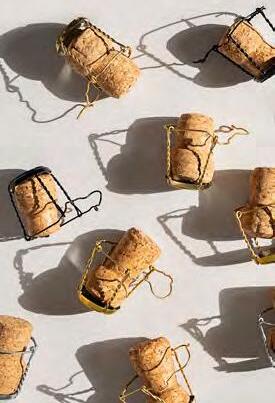
Tabella 2. Produzione della filiera imballaggi in legno. Valori in t/000, previsioni 2024.
Table 2. Production of the wooden packaging supply chain. wData in t/000 with 2024 forecasts.
Imb. industriali Tappi sughwero Cassette Pallet Industrial pack. Cork Stoppers Crates Pallets
Fonte/Source: Imballaggio in cifre Istituto Italiano imballaggio
Tappi in sughero. Si tratta di una nicchia nella “famiglia” degli imballaggi di legno (2,2%) ma di grande importanza, dato che l’Italia è tra i maggiori produttori di sughero. A seguito dell’andamento dei settori di destinazione, nel 2023 si era registrato un calo pari al 17% circa ma, nel 2024, anche per questo segmento si attende un andamento positivo, con una crescita produttiva pari al +13,7%. Saranno però i trend di import ed export a segnare un picco negativo nel comparto: la concorrenza della Cina ha portato le importazioni a calare del 25% e le esportazioni del 180%. Bisogna tuttavia sottolineare che, in generale, la produzione di tappi in sughero in Italia è sempre stata appannaggio del mercato interno.
Barbara Iascone Istituto Italiano Imballaggio
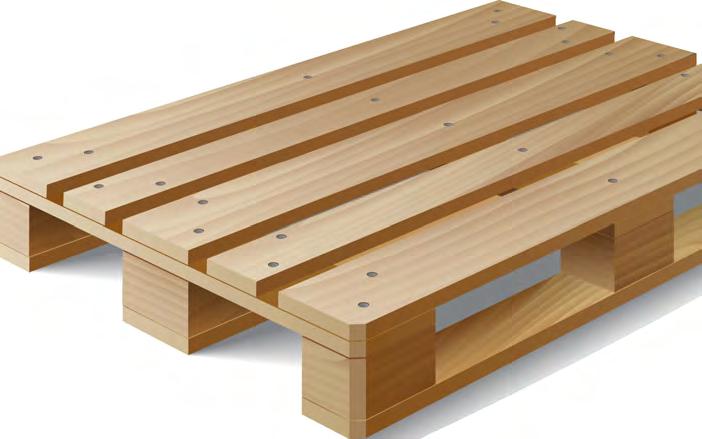

Wooden packaging is one of the oldest forms of containers used for transporting and storing goods. As early as Roman times, wood was used to make crates, barrels and chests for storing and transporting foodstuffs. During the Middle Ages, the use of wood packaging developed further, driven by the growth of long-distance trade. Wooden barrels became essential for transporting goods by ship and wagon.
Snapshot of an industry
Bringing the focus back to the present, the final figures from the 2024 issue of “Packaging in Figures” (the annual economic and statistical report published by the Italian Packaging Institute), indicate that in
Numeri del riciclo
Final figures for various categories of wood packaging: pallets, industrial packaging, crates and corks. Source: Packaging in Figures, 2024.
Barbara Iascone
2023, the wood packaging industry accounted for 17% of Italy’s total packaging production by weight and 3.3% of total turnover for the sector.
According to the classification adopted, the segment includes pallets, industrial packaging, wooden crates and cork stoppers.
Pallets dominate the sector with a 76.1% share, followed by industrial packaging at 17.3%. Together, these two categories account for 93.4% of total wood packaging production and are used almost exclusively in transport and logistics. This makes them particularly sensitive, even more so than other types of packaging, to trends in the manufacturing industry as a whole.
The remaining shares are held by fruit and vegetable crates (4.5%) and cork stoppers (2.2%).
In light of growing interest in the European packaging regulation, the concept of reusable packaging has become increasingly relevant, particularly in relation to wood packaging, which plays a central role in this area. According to data
In base all’ultimo report relativo alla gestione rifiuti derivanti dagli imballaggi in legno messo a punto da RILEGNO, il consorzio che nell’ambito del sistema CONAI si occupa del riciclo e recupero degli imballaggi in legno, risulta che nel 2024 sono stati recuperati il 67,14% degli imballaggi immessi al consumo, vale a dire quegli imballaggi che una volta utilizzati sul territorio nazionale producono un rifiuto. Rientrano in questa classificazione anche gli imballaggi di produzione estera. Le quantità di imballaggi di legno raccolte e riciclate ammontano a circa 1.755 t/000.
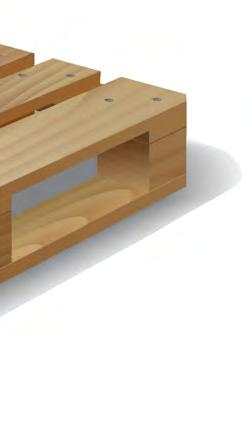
According to the latest report by RILEGNO, the consortium responsible for recycling and recovering wood packaging within the CONAI system, 67.14% of the wood packaging placed on the market in 2024 was recovered. This refers to packaging that, once used in Italy, becomes waste. Packaging of foreign origin is also included in this classification. The total quantity of wood packaging collected and recycled amounted to approximately 1.755 million tonnes.
compiled by the Italian Packaging Institute, 84% of reusable packaging in Italy is used for transport, and of this, 65% is made of wood.
Figures, trends and sectors of use
(Source: Italian Packaging Institute - based on the analysis of ISTAT data)
The data presented in this article begin with the analysis of the final figures for 2023 and continue with preliminary assessments for 2024, which were still under review at the time of these assessments.
Following a clearly negative year in 2023 - when production fell by 3% and imports and exports dropped by 5.8% and 16.1% respectively - the outlook for 2024 points to a recovery in the sector.
Initial estimates for 2024 indicate an upward trend in the sector, particularly in terms of volume, rather than turnover, which grew by just 0.1%.
In fact, production volumes are forecast to rise by 5%, reaching approximately 3,056 thousand tonnes. Both exports and imports saw growth in 2024, increasing by 5.4% and 2.7%, respectively. In general, foreign trade remains limited in scale compared to production and consumption: exports account for 6.7% of production, while imports account for 18.2% of consumption.
Pallets continued to play a key role in shaping production trends, accounting for 75.8%, and recording a 4% increase in 2024. However, industrial packaging also contributed positively, recording a growth of 12.5%.
As for commodity prices, following the decline in 2023, price levels in 2024 remained relatively stable, with a temporary drop during the summer months, followed by a recovery in the final quarter of the year.
Pallets. According to the analysis of the Italian Packaging Institute’s data, 46.9% of pallets are used in the food sector, with the share almost evenly divided between beverages and liquid food (23.3%) and food products (23.6%).
A further 24.9% is allocated to non-food consumer goods (cosmetics, pharmaceuticals, household cleaning products, etc.), while the remaining 28.3% is allocated to the general non-food sector, with 2.2% used in the chemical sector.
Industrial packaging. This category mainly includes custom-made crates, large reels for electric cables, wine cases, large boxes, etc. Production of industrial wood packaging is expected to reach approximately 528,000 tonnes in 2024.
Crates. Used in the fruit and vegetable, fish and nursery sectors, wooden crates have experienced a slow but steady decline in recent years. This is due to the growing use of crates made using alternative materials, such as corrugated cardboard, which is increasingly being used for fruit and vegetables, while the fish industry is moving toward the near-exclusive use of plastic and polystyrene crates. The downward trend continued in 2024, with a decline of 8%.
Cork stoppers. Although representing a niche (2.2%) within the wooden packaging sector, cork stoppers remain highly significant, as Italy is one of the world’s leading producers of cork. Driven by trends in its target sectors, the cork stopper segment declined by about 17% in 2023. However, a positive turnaround is expected in 2024, with production projected to increase by 13.7%. That said, foreign trade figures show a sharp downturn in the industry: imports dropped by 25%, while exports fell by 180%, largely due to intensified competition from China. It is worth noting, however, that the production of cork stoppers in Italy has traditionally been geared toward the domestic market.
AETNA GROUP SPA 71
ALTECH SRL 36
ARCOPLASTICA SRL 95
AUTOMATION ADDRESS SRL 59
CAMA 1 SPA 76
CMI INDUSTRIES SPA 5
COMEK SRL 78
CPR SYSTEM S.C. 100
EIDOS SRL 53
ELESA SPA 67
ETIPACK SPA 3
FB INTERNATIONAL INC 108
GERHARD SCHUBERT GMBH 89
GIFLOR SRL 99
ILIP SRL 73
IMA INDUSTRIA MACCHINE
AUTOMATICHE SPA 13, 35
MAKRO LABELLING SRL 82
MBF Spa II cop.
MINEBEA INTEC ITALY SRL 60
NÜRNBERGMESSE GMBH 49
OPEM SPA 75
PRATI SRL 57
REED TÜYAP FUARCILIK A.Ş. 46 RICREA III Cop.
ROBATECH ITALIA SRL U.S. 90 RONCHI MARIO SPA 6-7
SCHNEIDER ELECTRIC SPA 19 SCHOBERTECHNOLOGIES GMBH 69 SIS.MA SRL 51
SIT SPA STAMPA IMBALLAGGI TRASPARENTI 24-25
TGM - TECNOMACHINES SRL 43
VERIMEC SRL 83
WITTENSTEIN SPA IV Cop.
A. LOACKER SPA 14, 37
A&T SRL 47
ACMA SPA 61
AETNA GROUP SPA 44
AIBO - FCE 79
ALMA MATER STUDIORUM UNI BOLOGNA 91
ALTECH SRL 75
AMMEGA ITALIA SPA 66
AMMERAAL BELTECH SRL 68 ASSOGRAFICI 84
BD-EXPO 8, 70, 91
BOSCH REXROTH SPA 64
BRAFIM MECPLAST SL 14
CAMA 1 SPA 62
CAPSULIT SPA 86
CAVANNA SPA 16
CIAL CONSORZIO IMBALLAGGI ALLUMINIO 104
CMA SRL 47
CMI INDUSTRIES SPA 64
COESIA SPA 61, 72
CONAI - CONSORZIO NAZIONALE IMBALLAGGI 14, 77, 84 104, 109
D.C.M. SRL 42
DUBAI WORLD TRADE CENTRE 64
ETIPACK SPA 74
EUROPEN 9, 58, 79, 84
FERRERO SPA 26
FIERA MILANO SPA 11
FIERA MILANO SPA 20
FINAT - THE ASSOCIATION FOR THE EUROPEAN LABEL INDUSTRY 84
GIFLEX 16
GIFLOR SRL 58 GIPEA 84
GOGLIO SPA 14, 52
GRANTERRE SPA 14
GS1 ITALY 37
HAPPY SRL 14
ICE 10
ILIP SRL 60
IMA INDUSTRIA MACCHINE AUTOMATICHE SPA 12
IMBALL SRL 63
INFOPRO DIGITAL TRADE SHOWS 10
INFORMA EXHIBITIONS PTE LTD 20
IPACK IMA SRL 14, 16, 20 40, 47, 75
ISTITUTO ITALIANO IMBALLAGGIO 14, 16, 26, 31 101, 104, 109
ISTITUTO STAMPA SRL 14
JAKA ROBOTICS 47
KOELN PARMA EXHIBITIONS SRL 12
LAMINAZIONE SOTTILE SPA 79
M.H. MATERIAL HANDLING SPA 68
MARKEM-IMAJE SRL A SOCIO UNICO 74
MAX MARRA 2 MECS SRL 96 MESSE DÜSSELDORF GMBH 10, 91 MESSE FRANKFURT ITALIA SRL 47, 50 MESSE MÜNCHEN GMBH 8 METSÄ BOARD ITALIA SRL






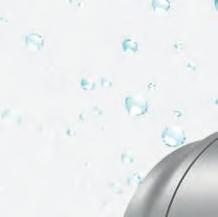








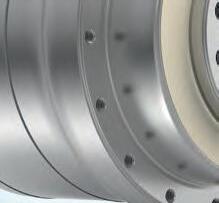











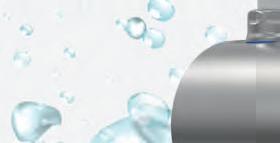

Soluzioni Hygienic Design
· Pulizia efficiente, rapida e sicura


· Classe di protezione IP69K
Produzione igienica e sicura







· Integrazione diretta nel processo (CIP/SIP)
· Design ottimizzato per evitare deposito di impurità
Per maggiori informazioni, consulta il sito: www.wittenstein.it/hygienic-design


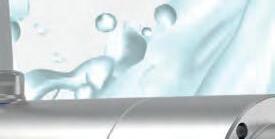
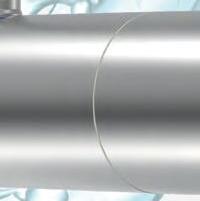



www.wittenstein.it








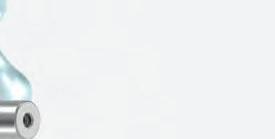
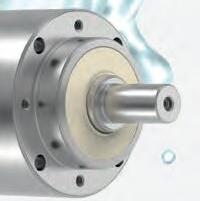









WITTENSTEIN – tutt’uno con il futuro













